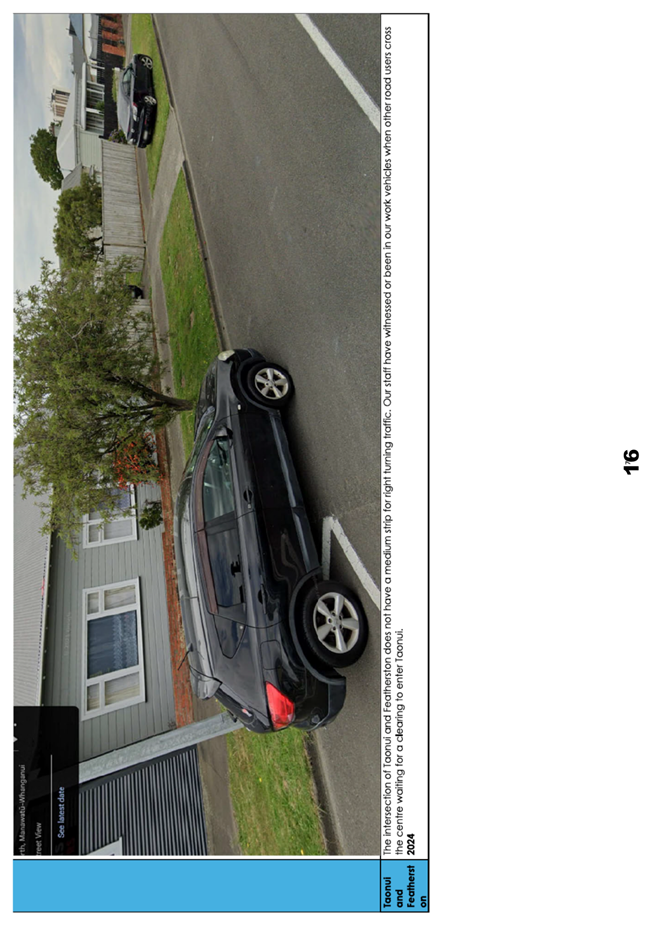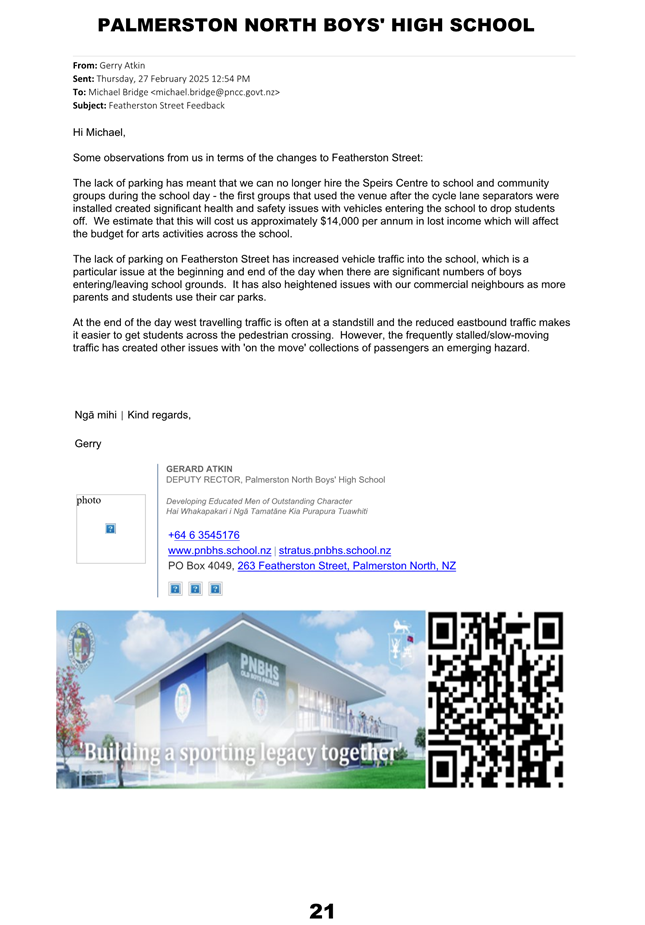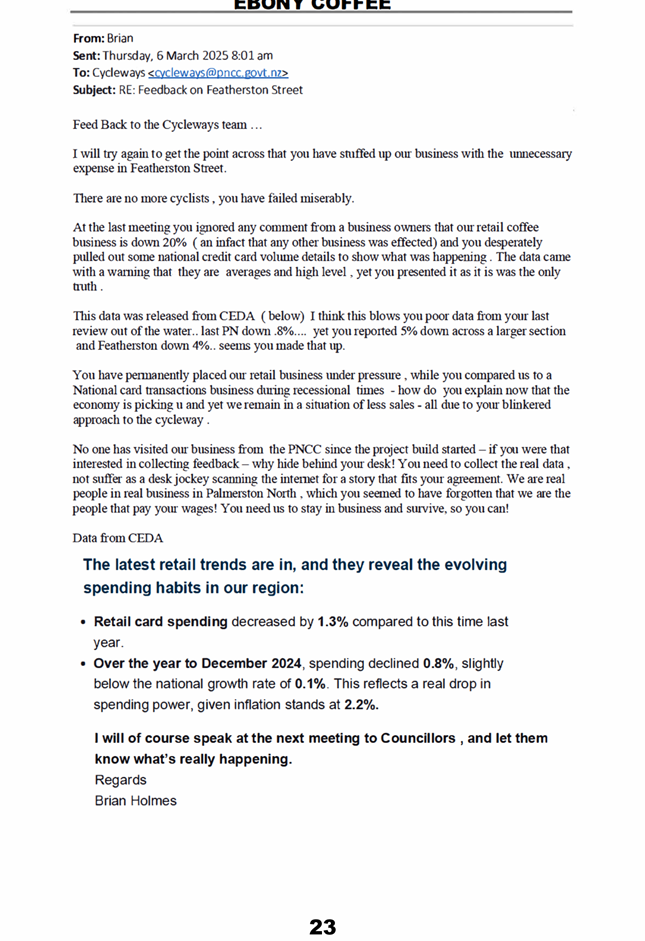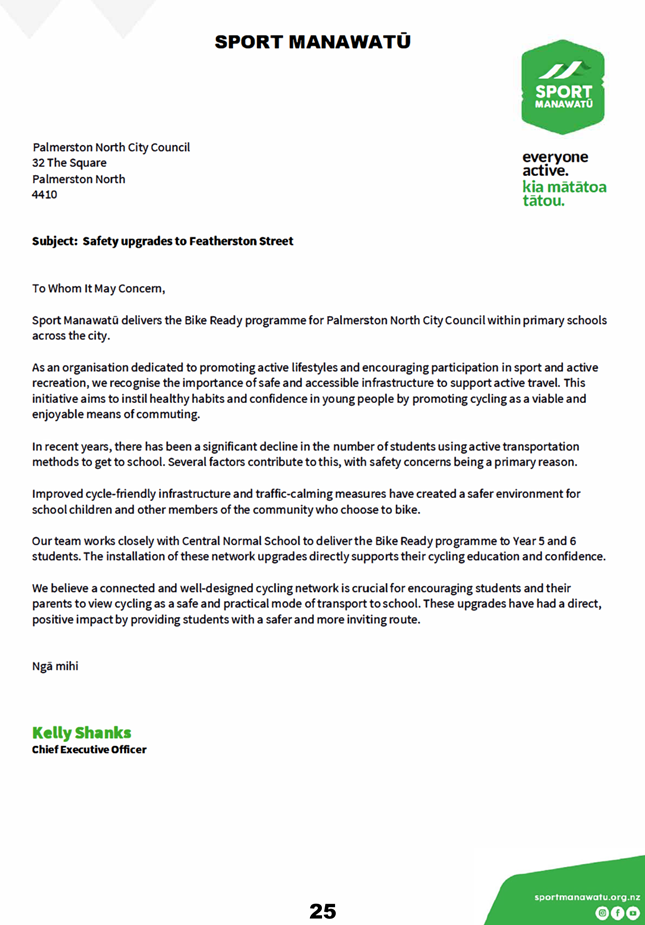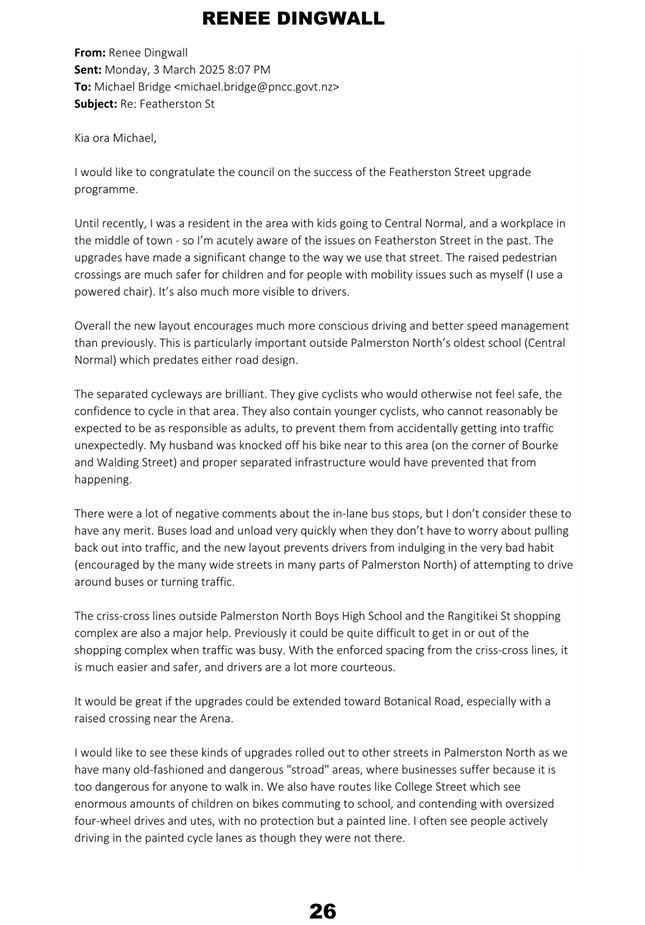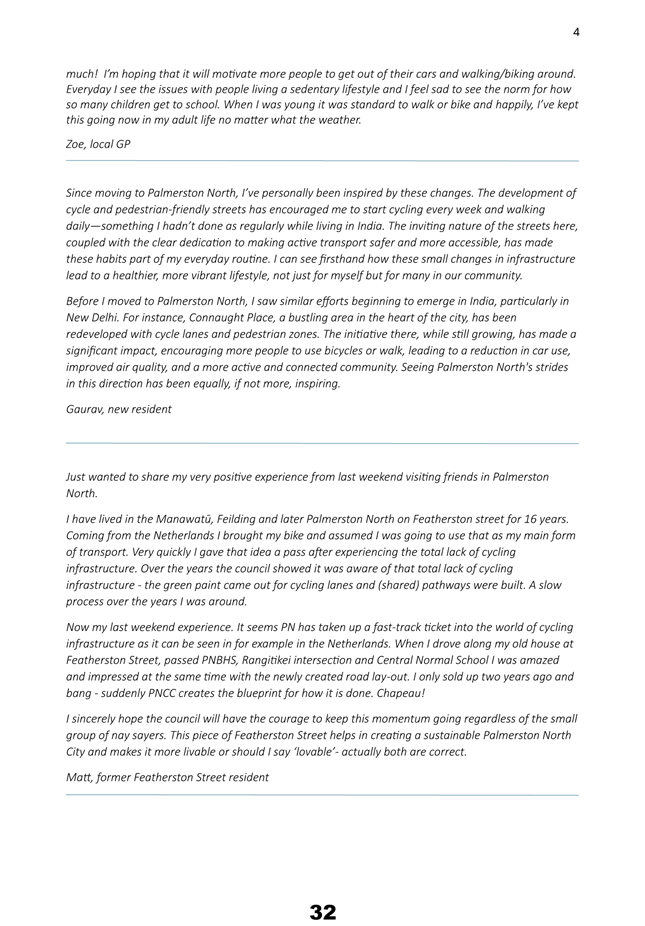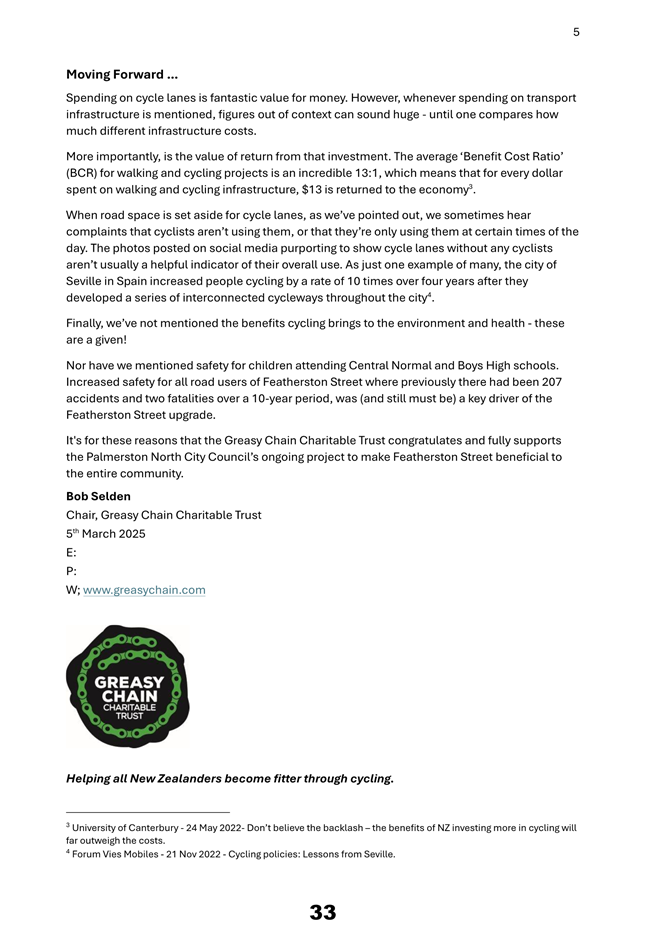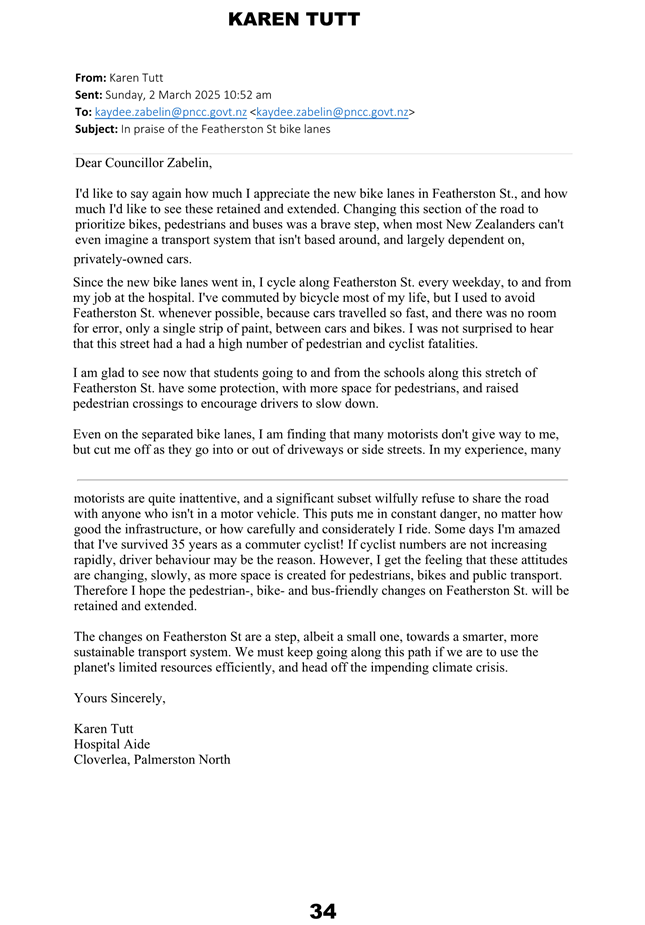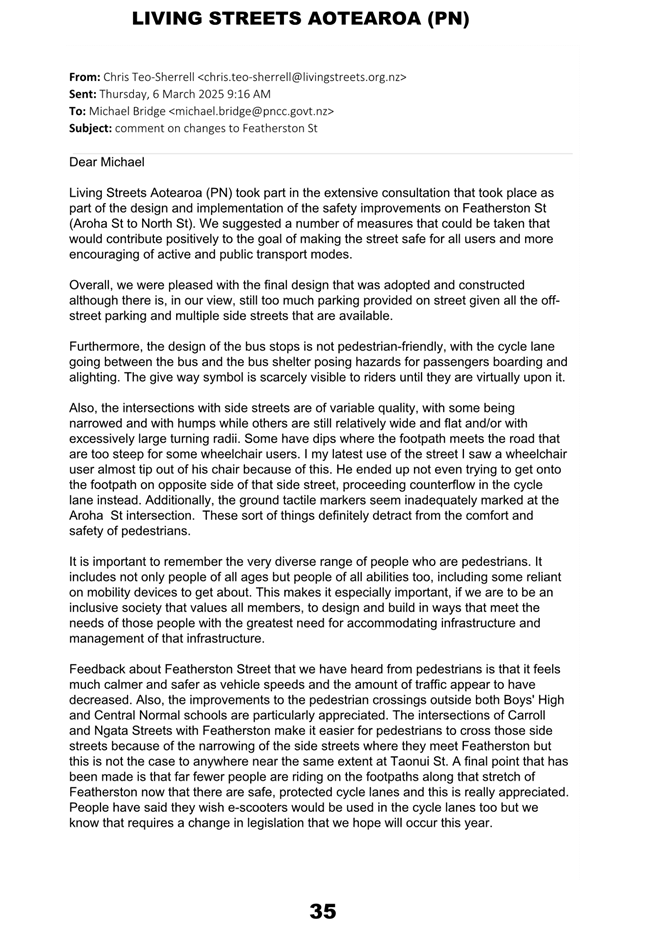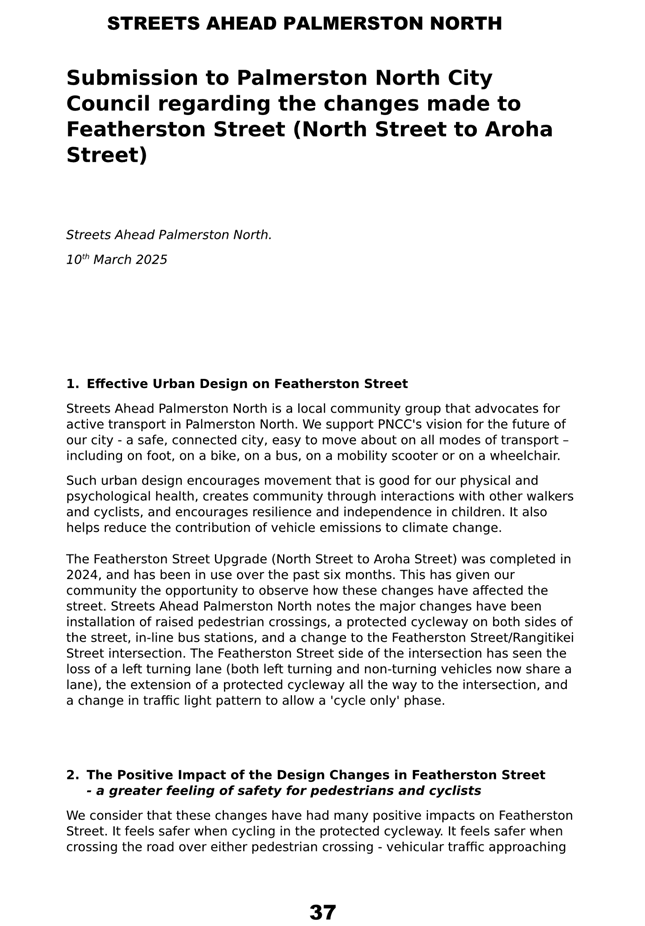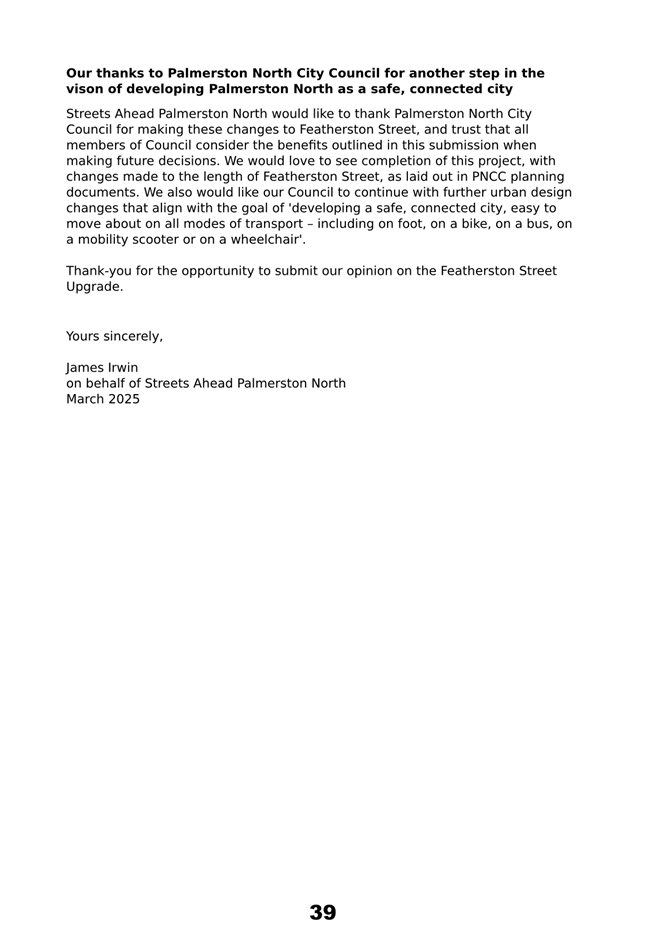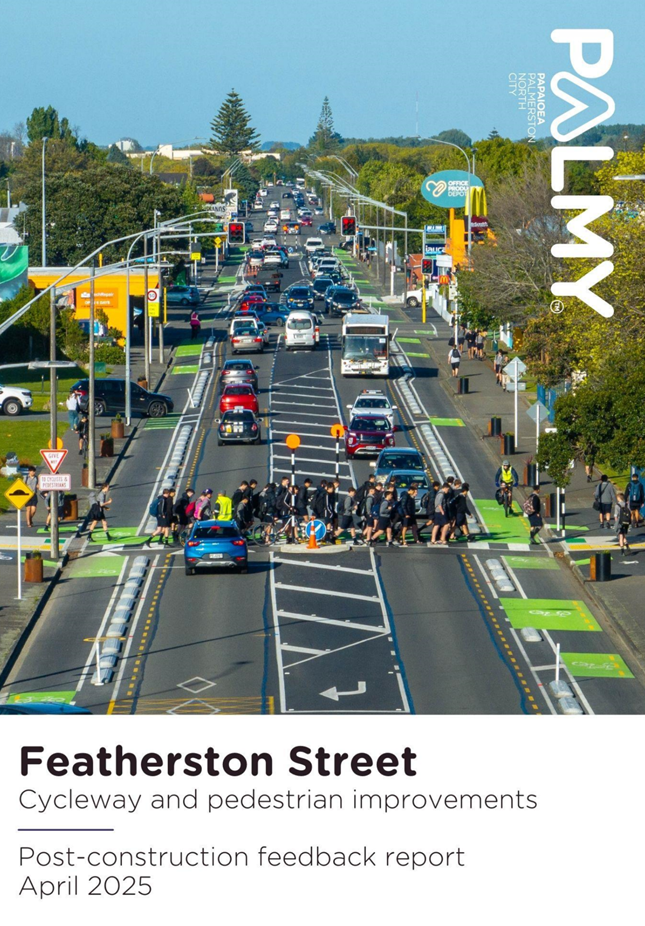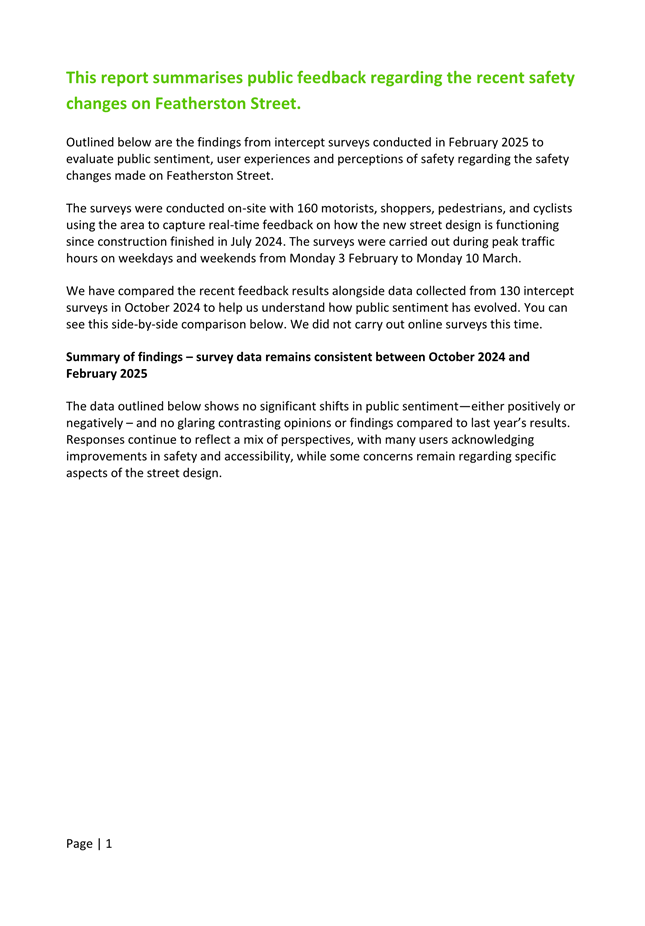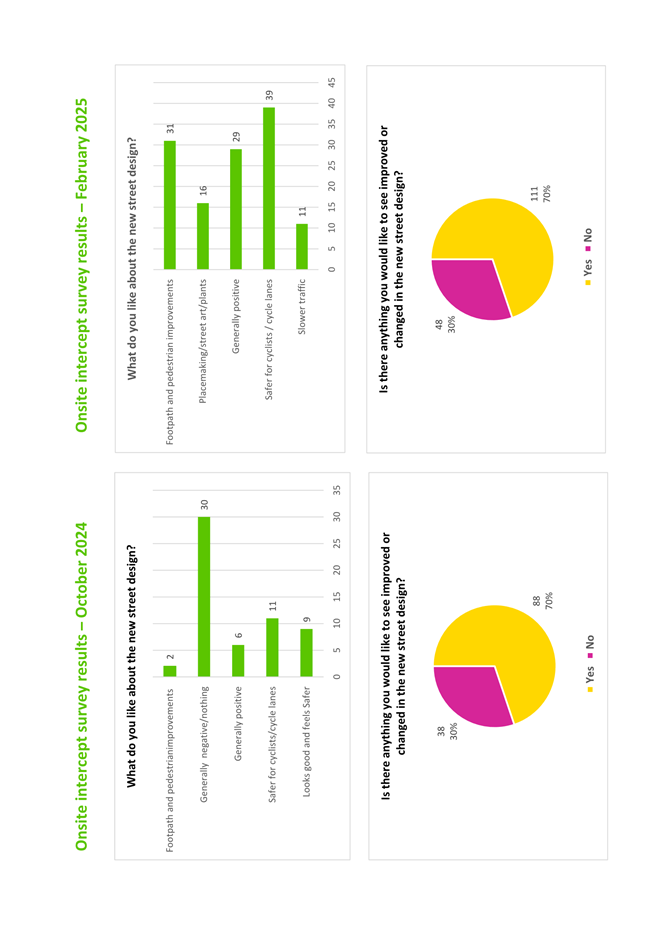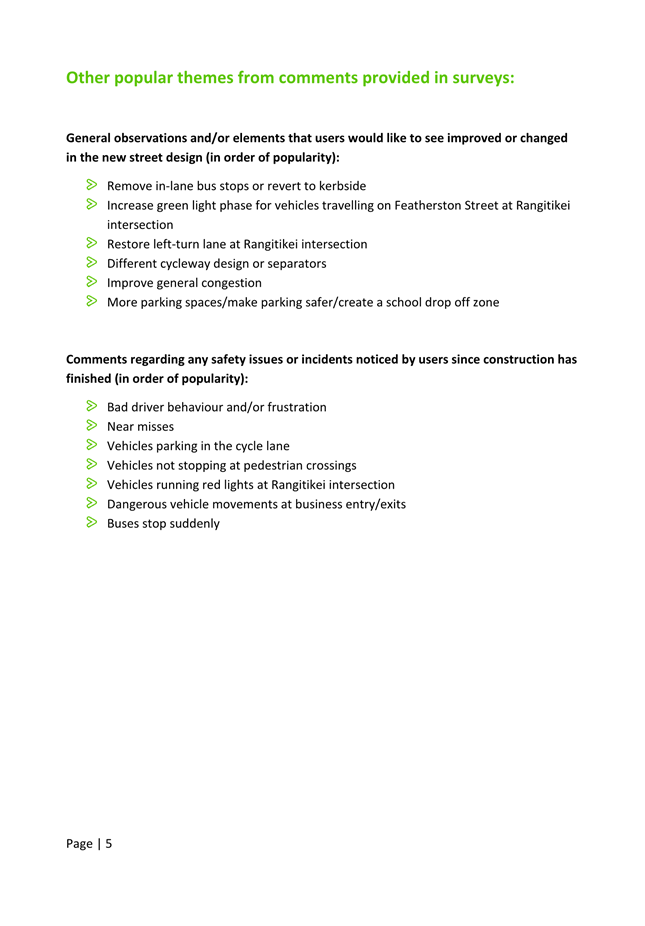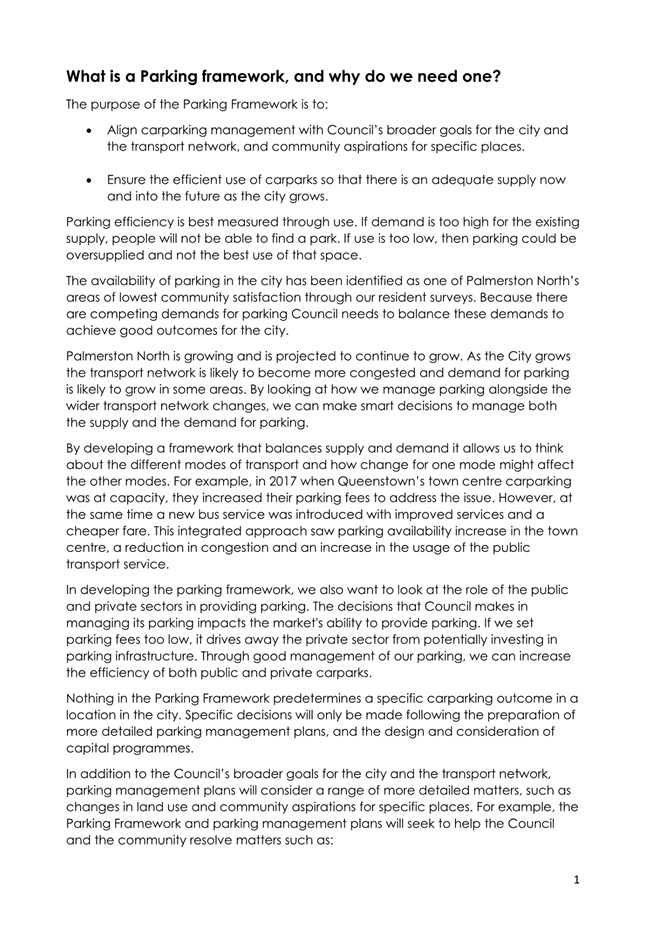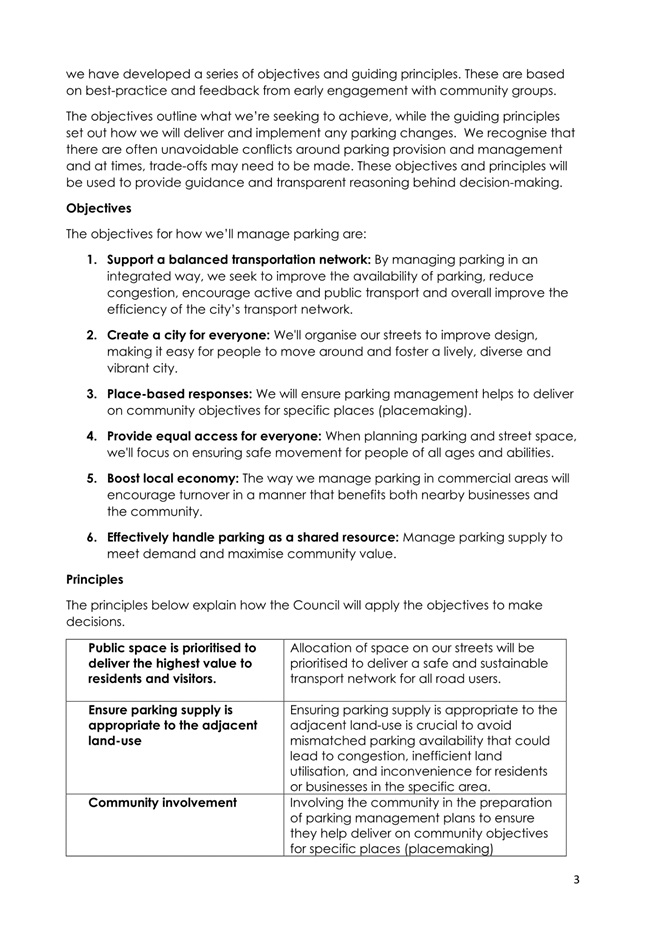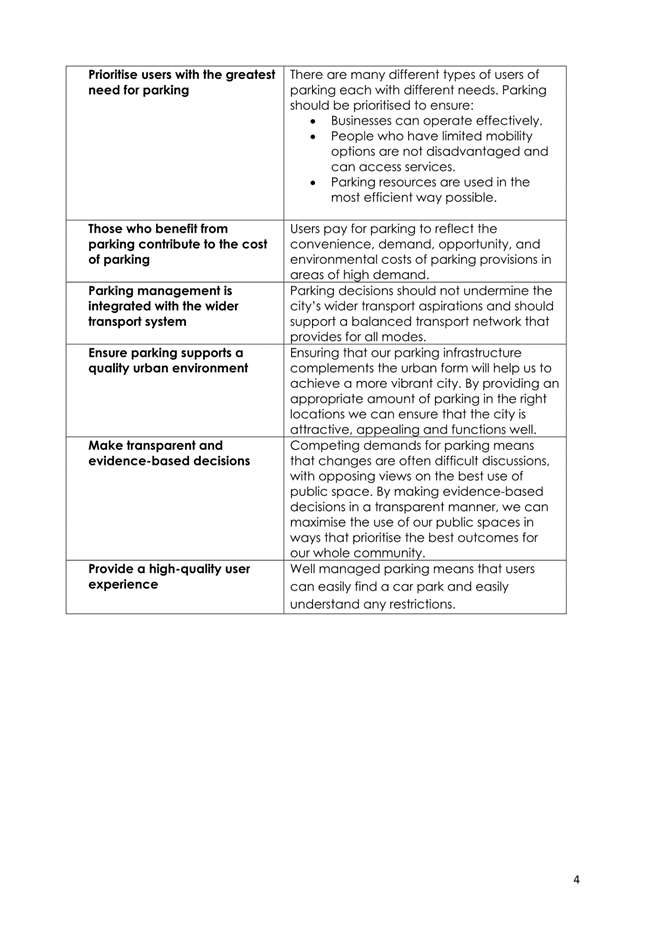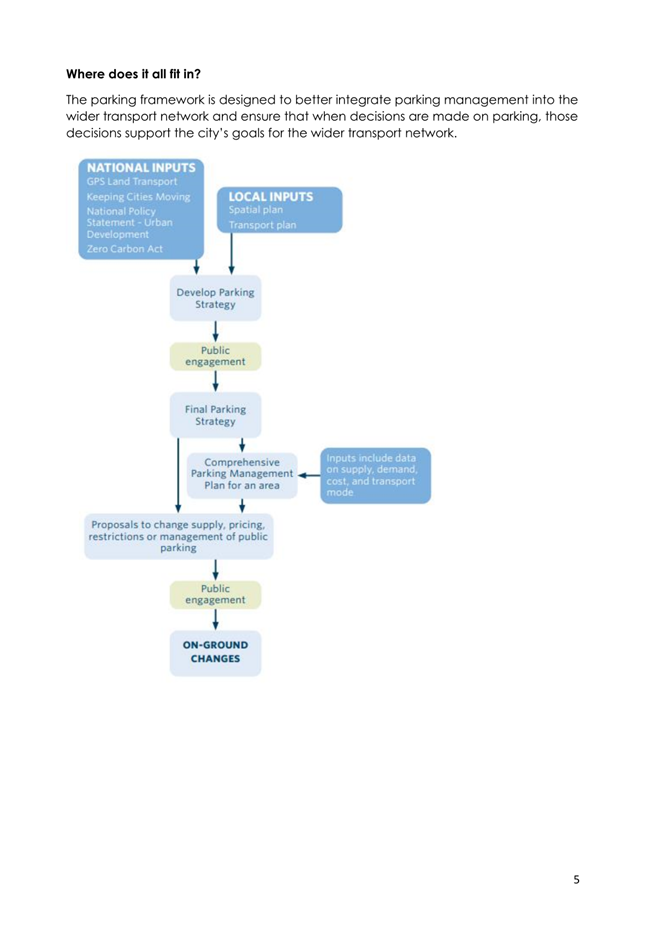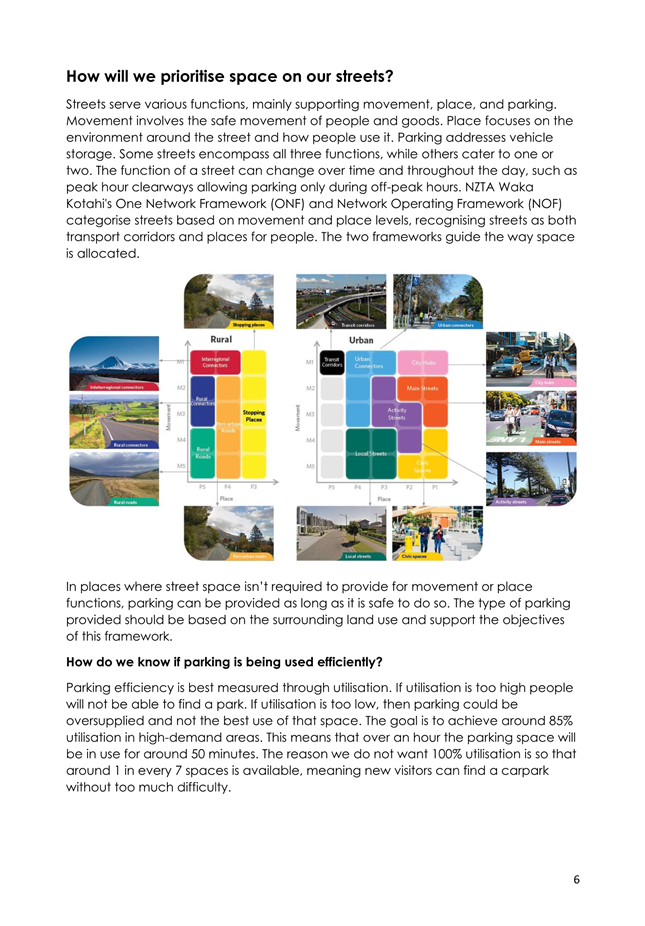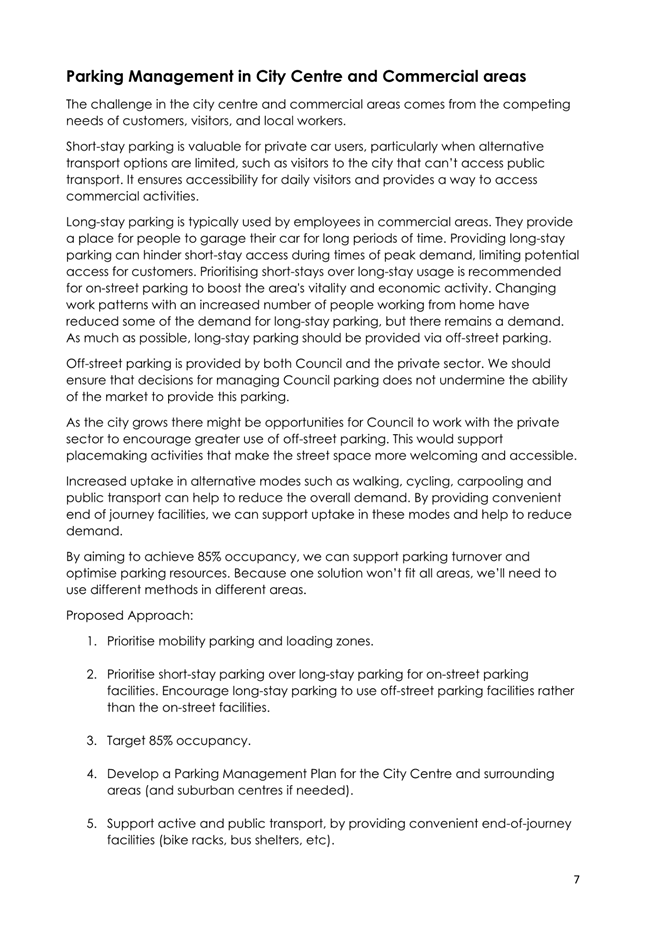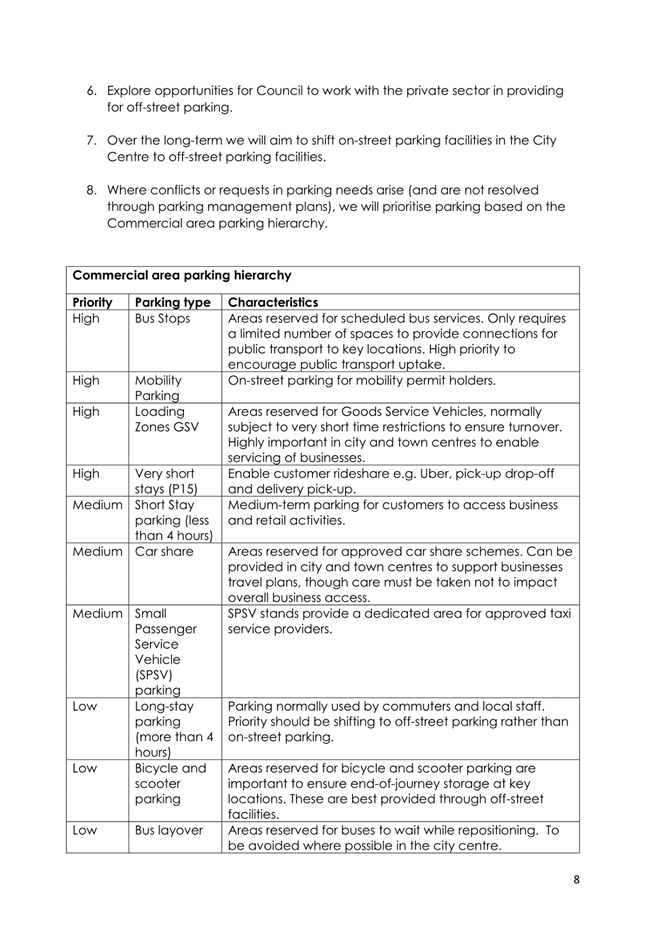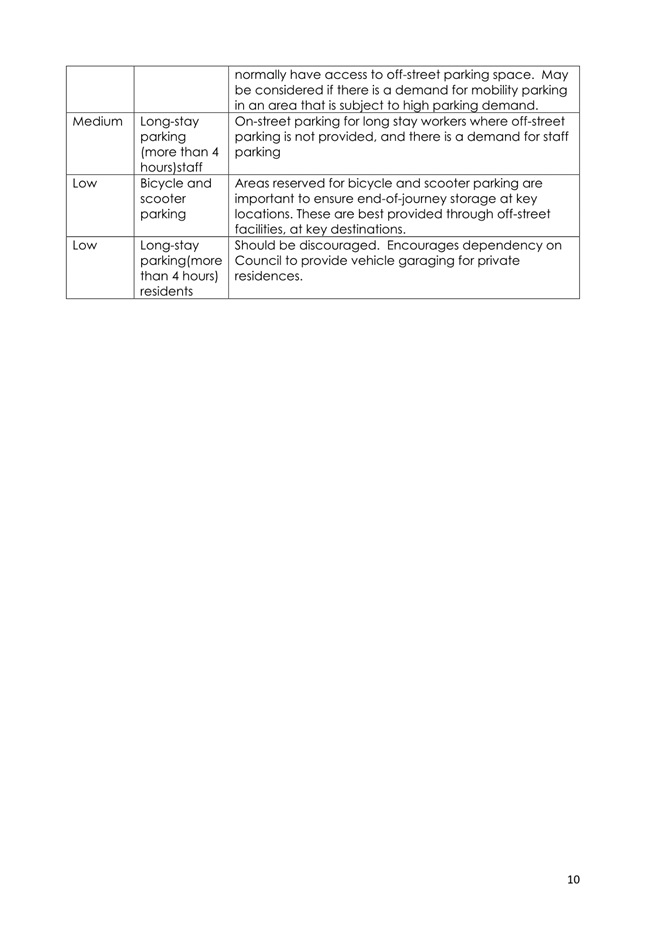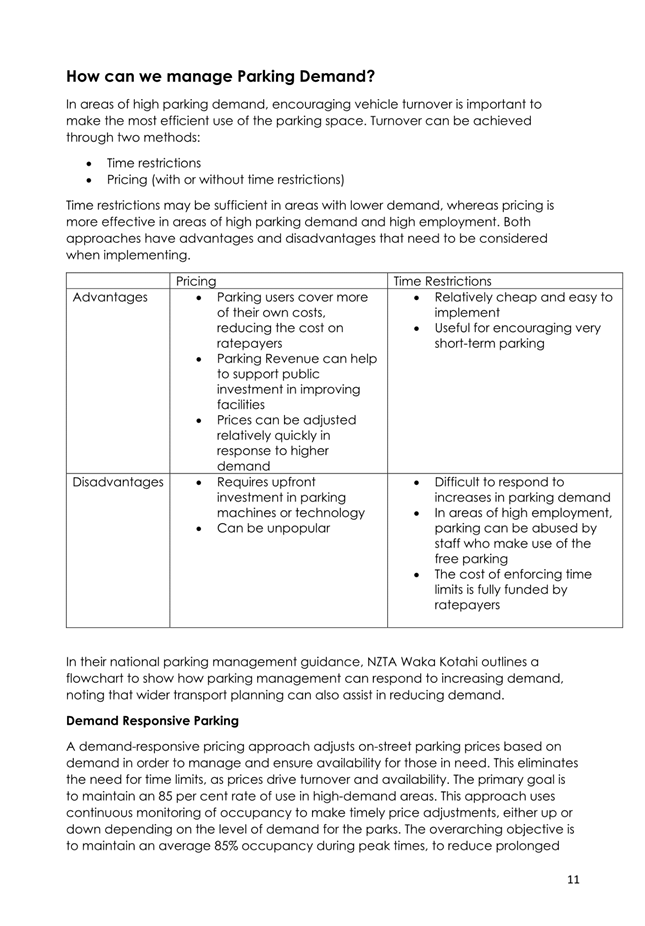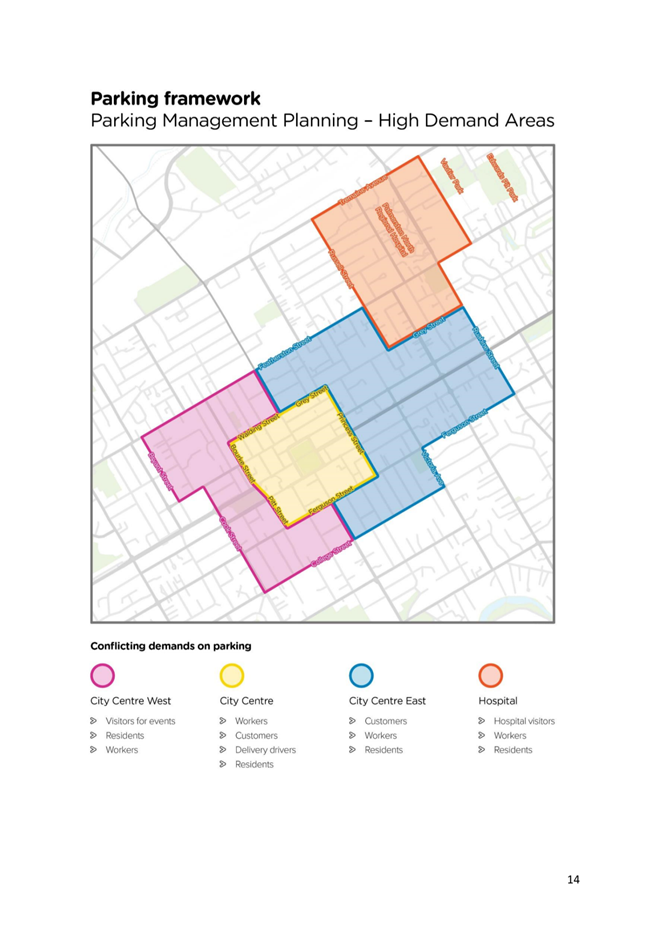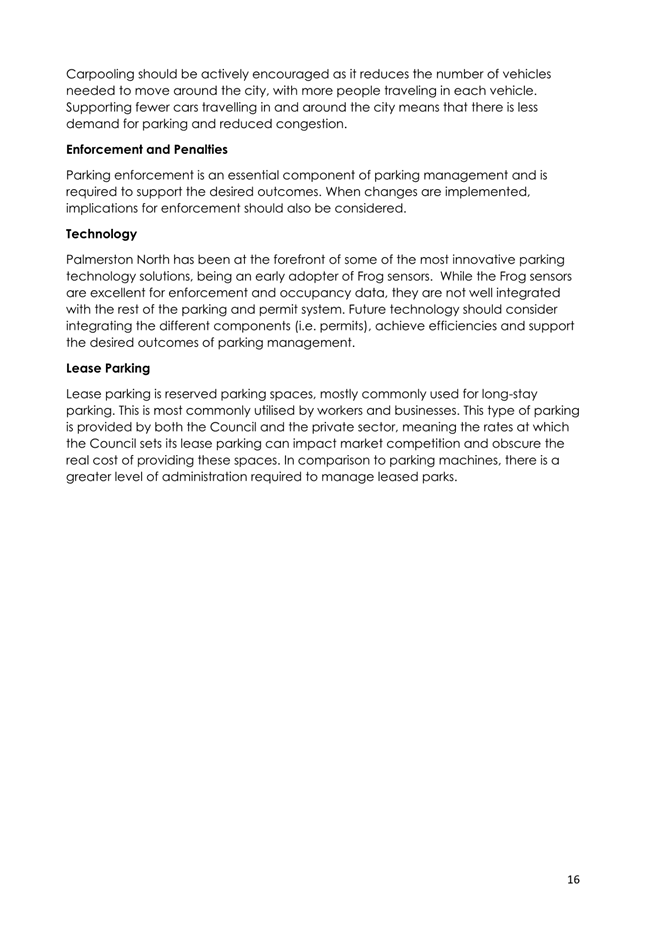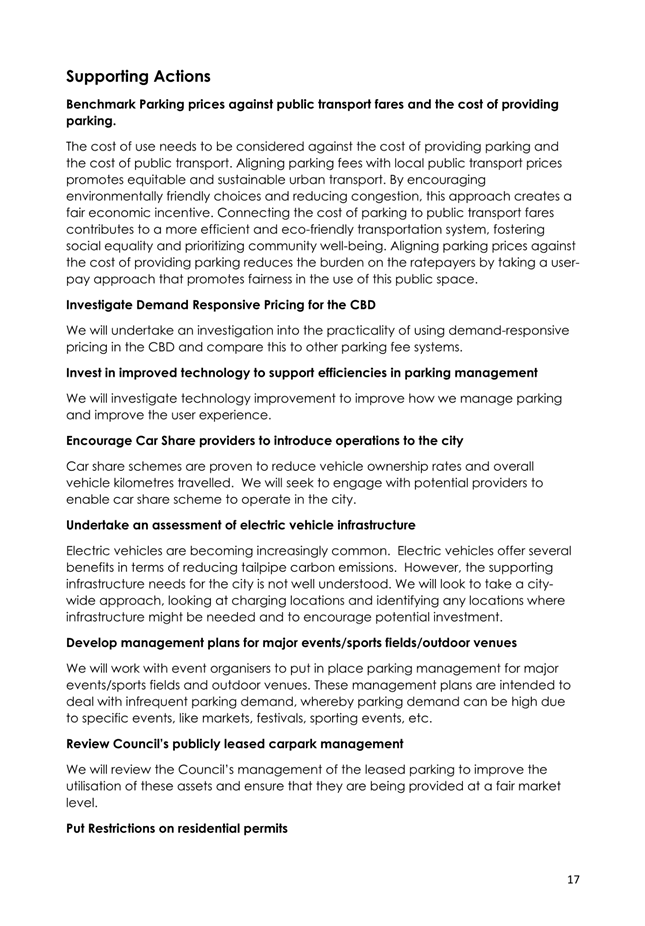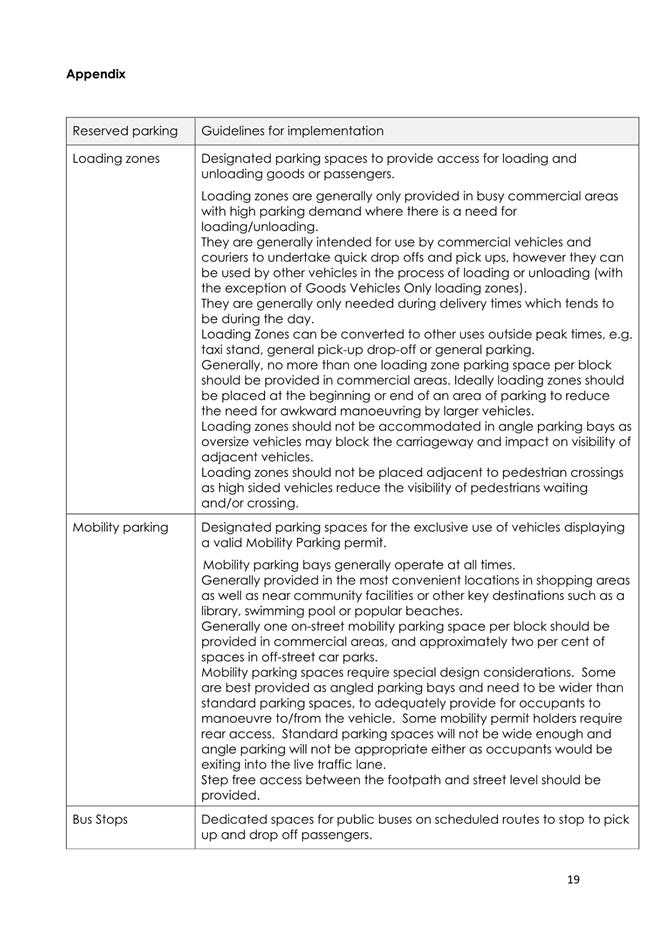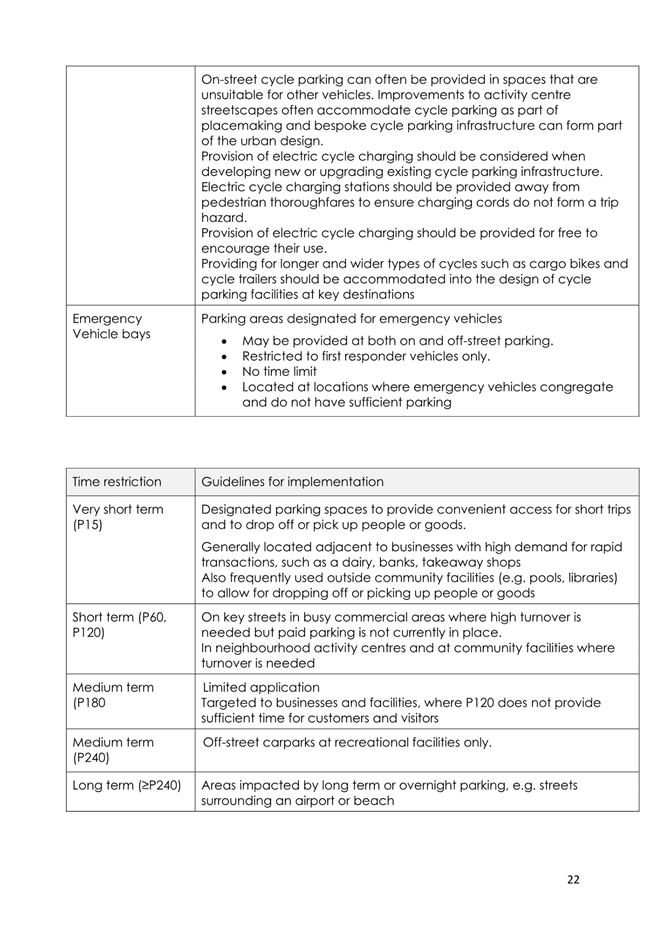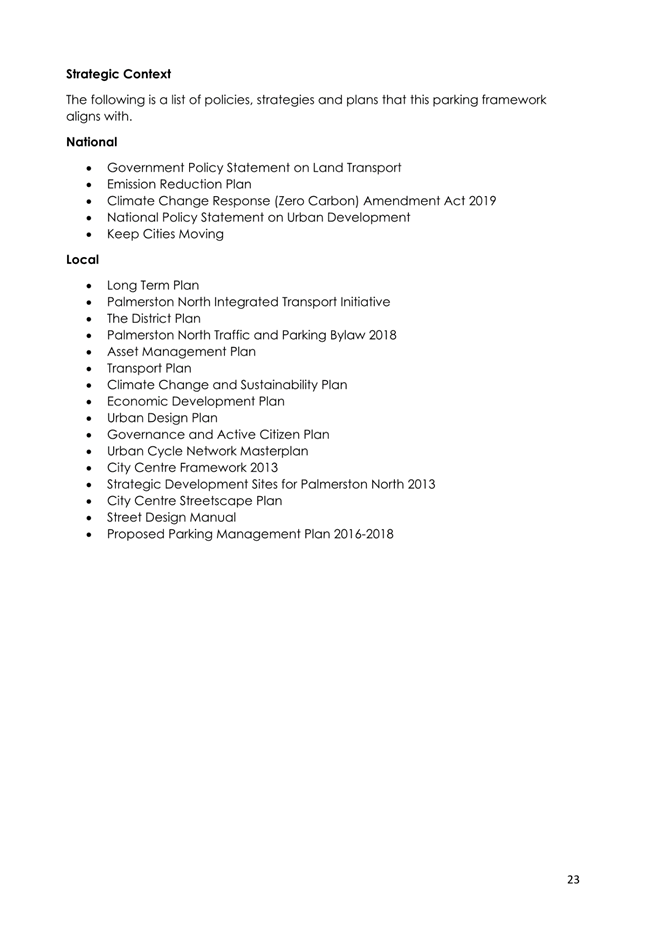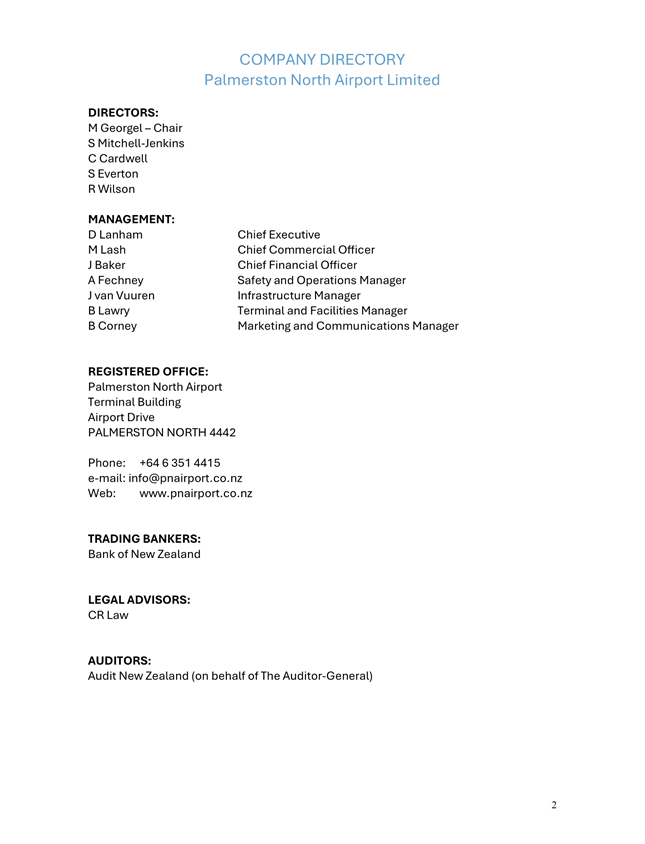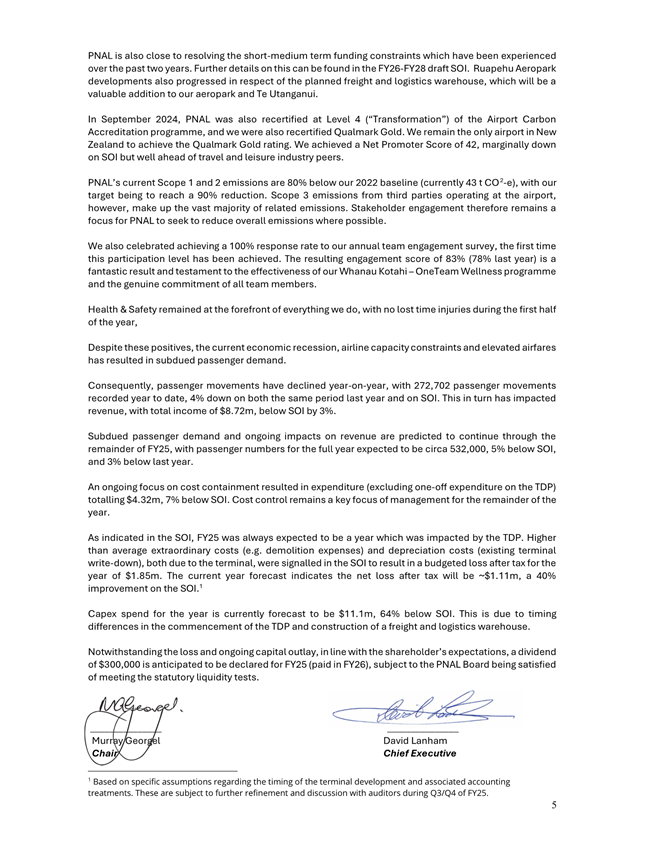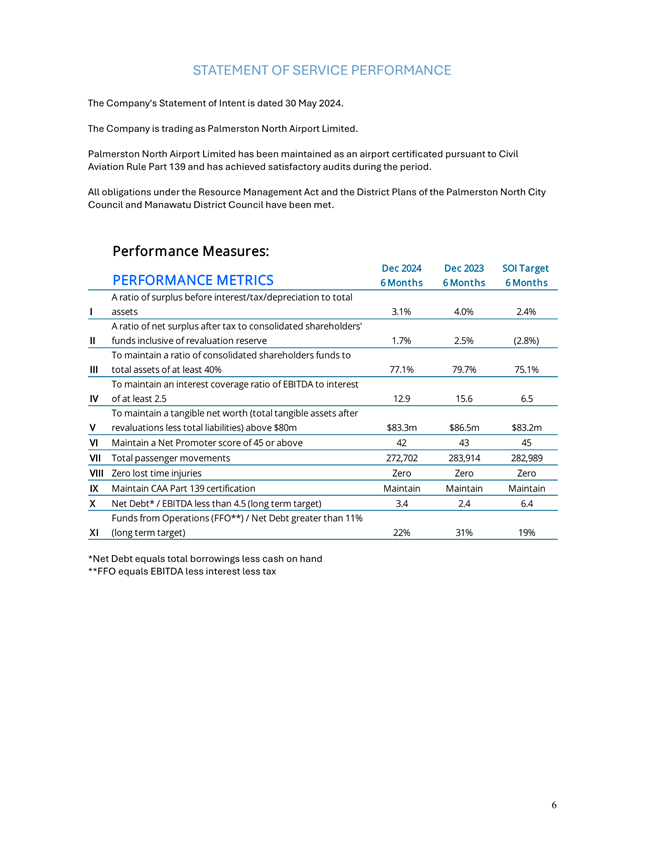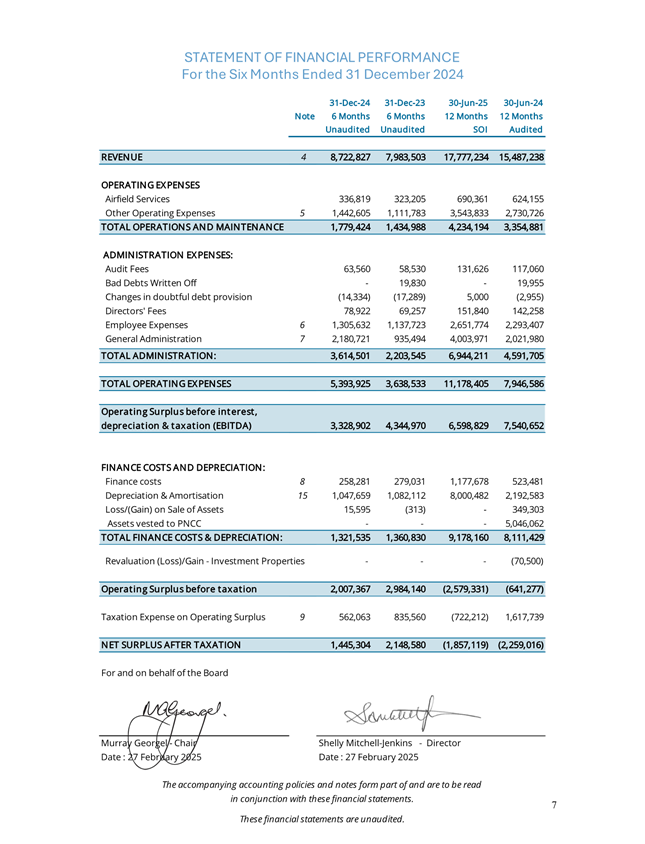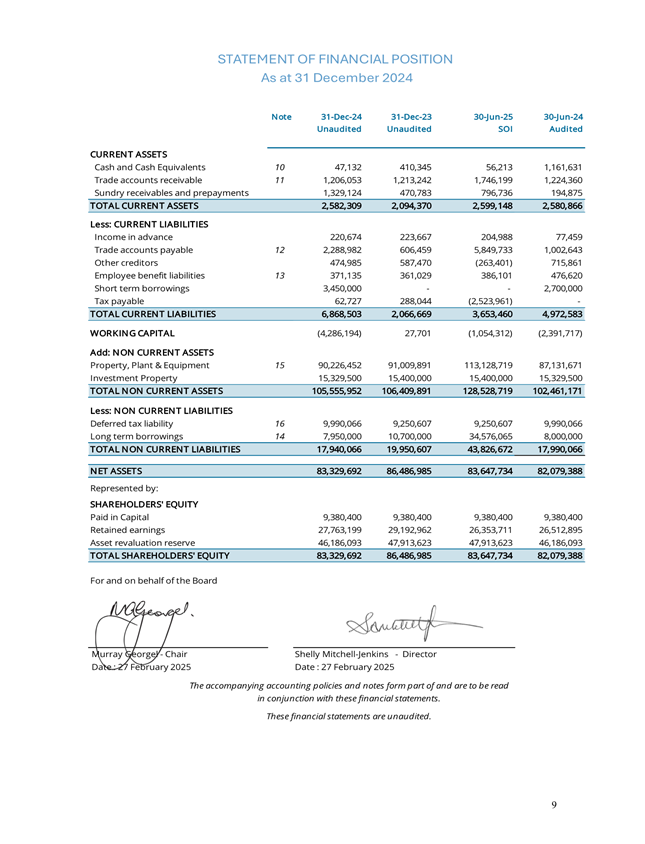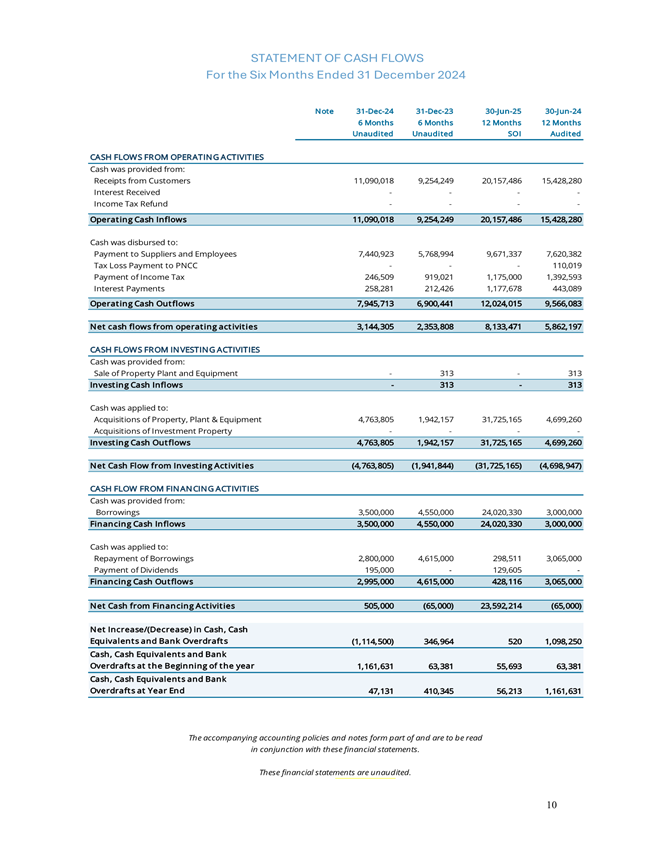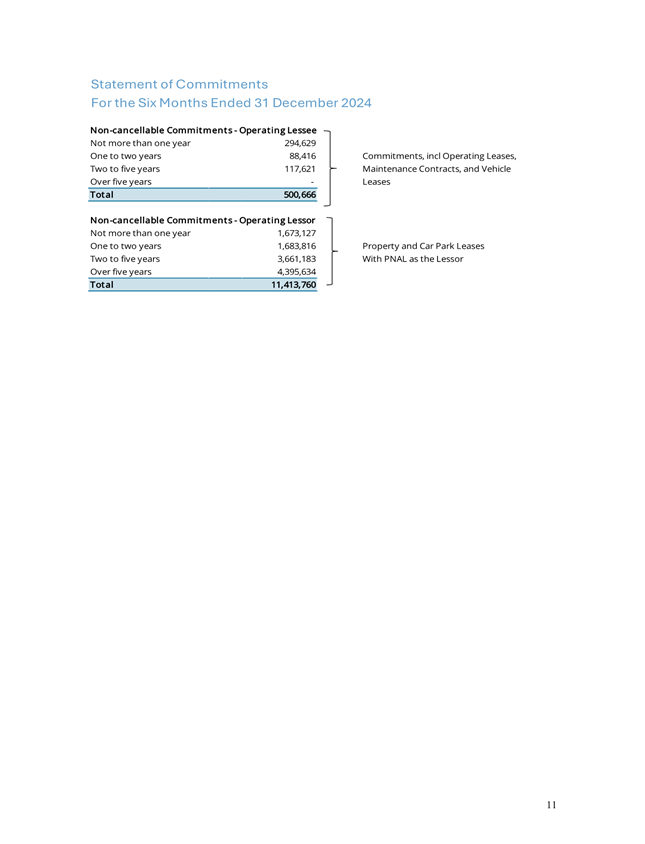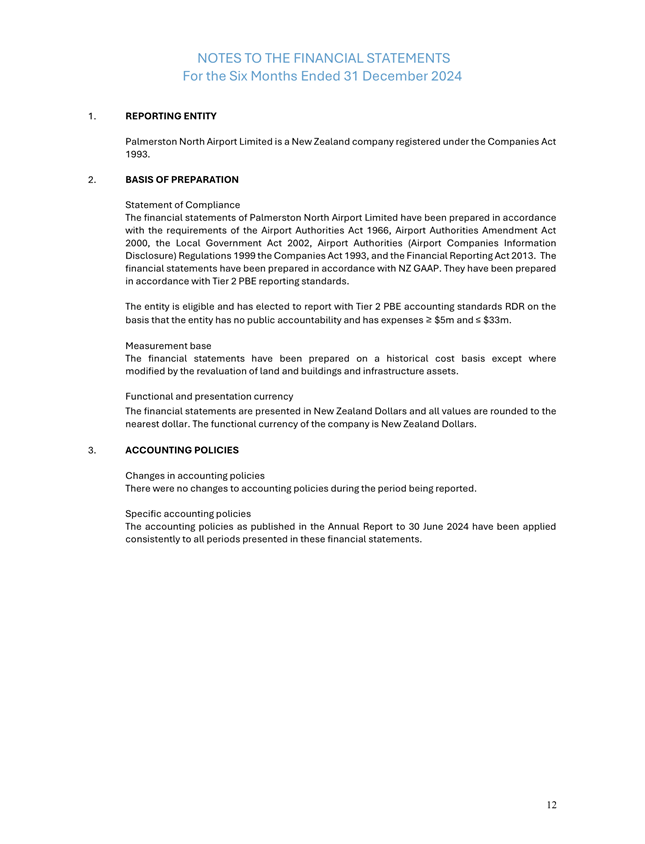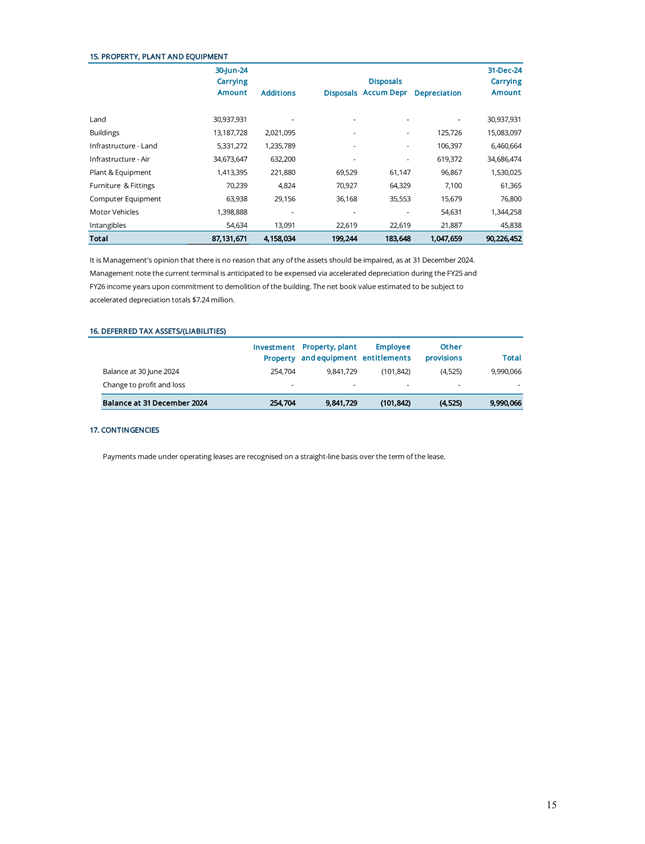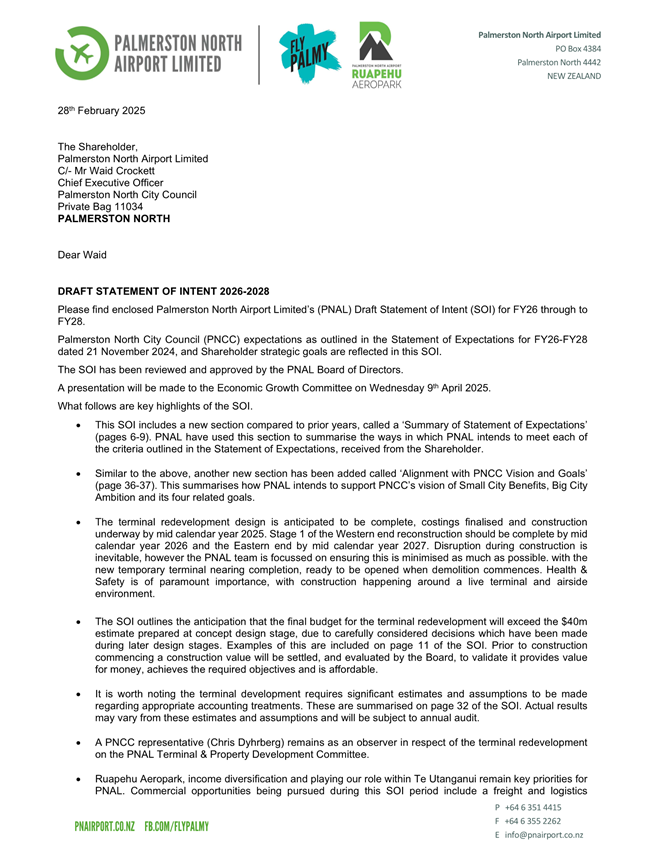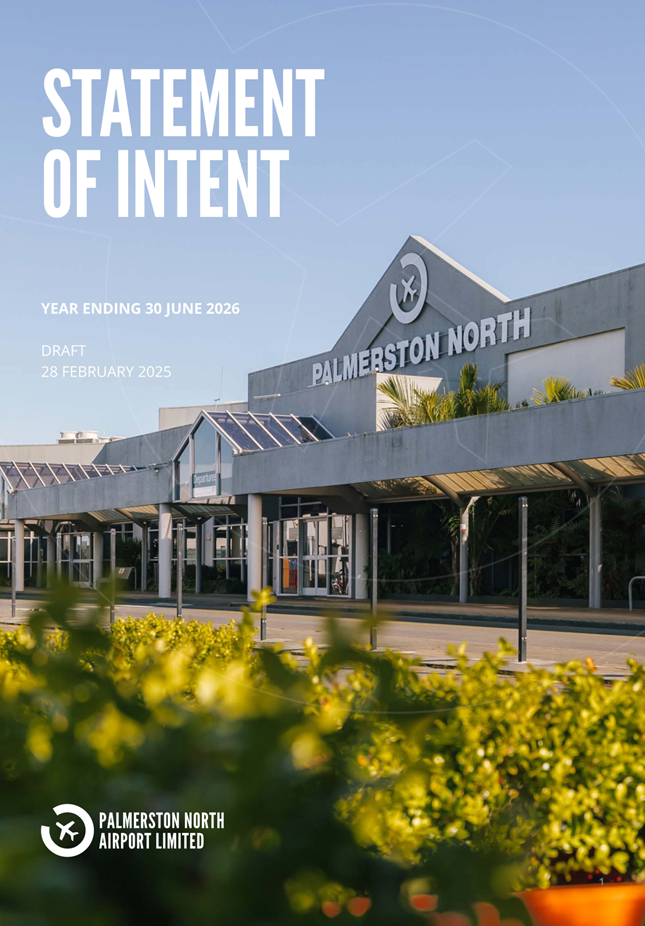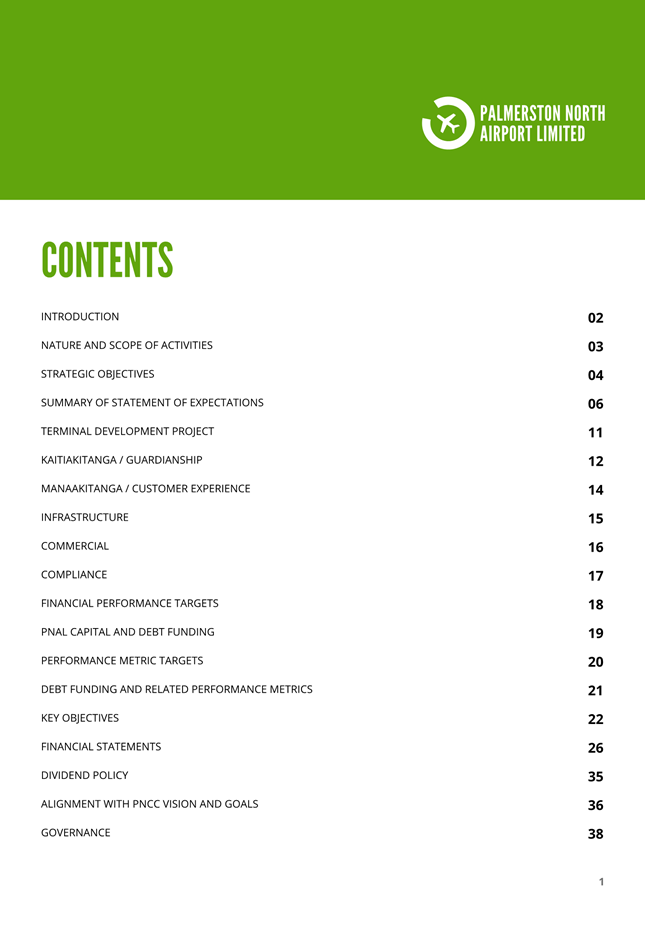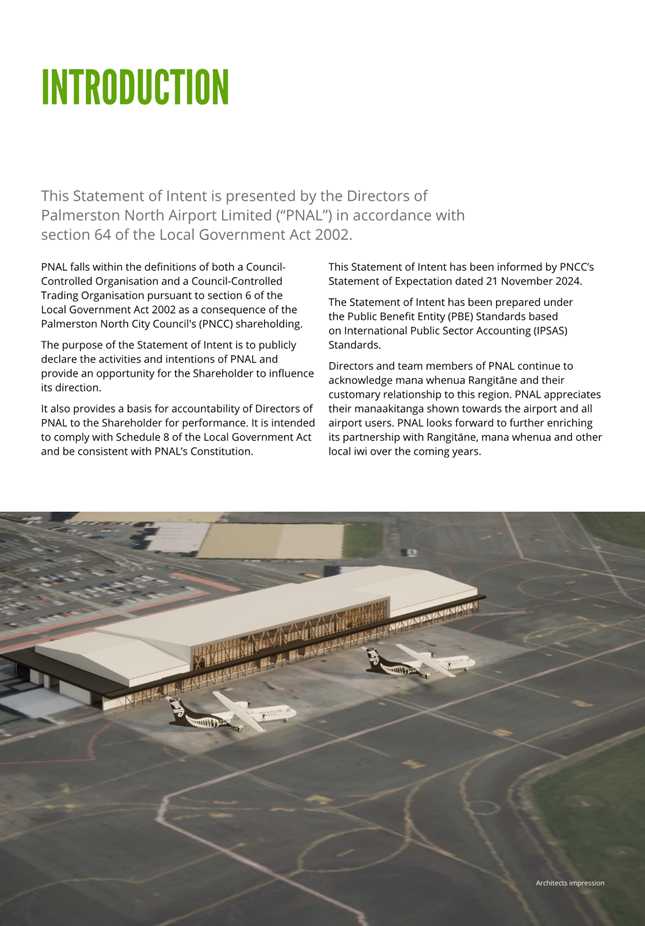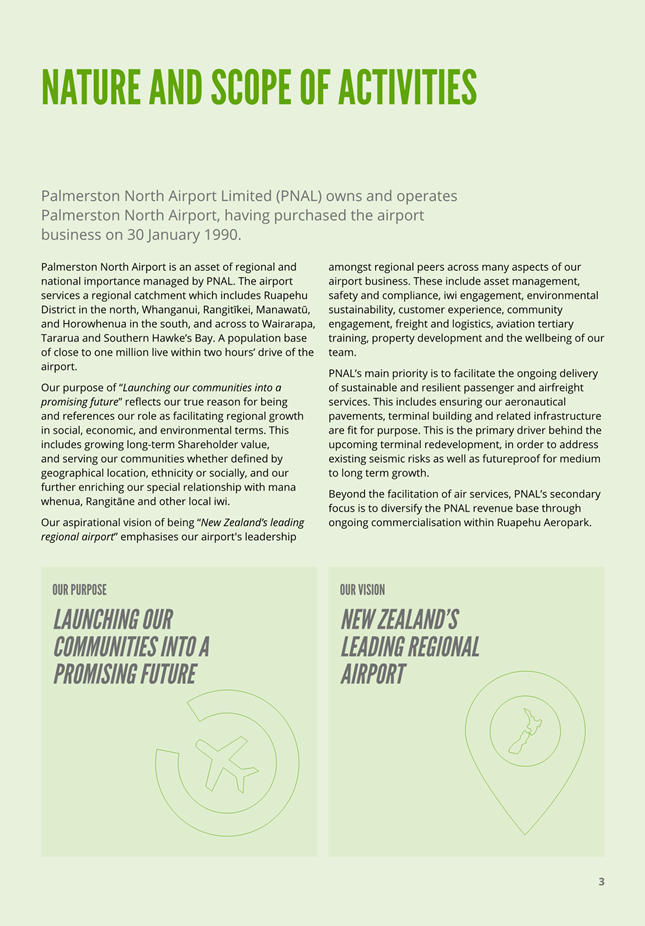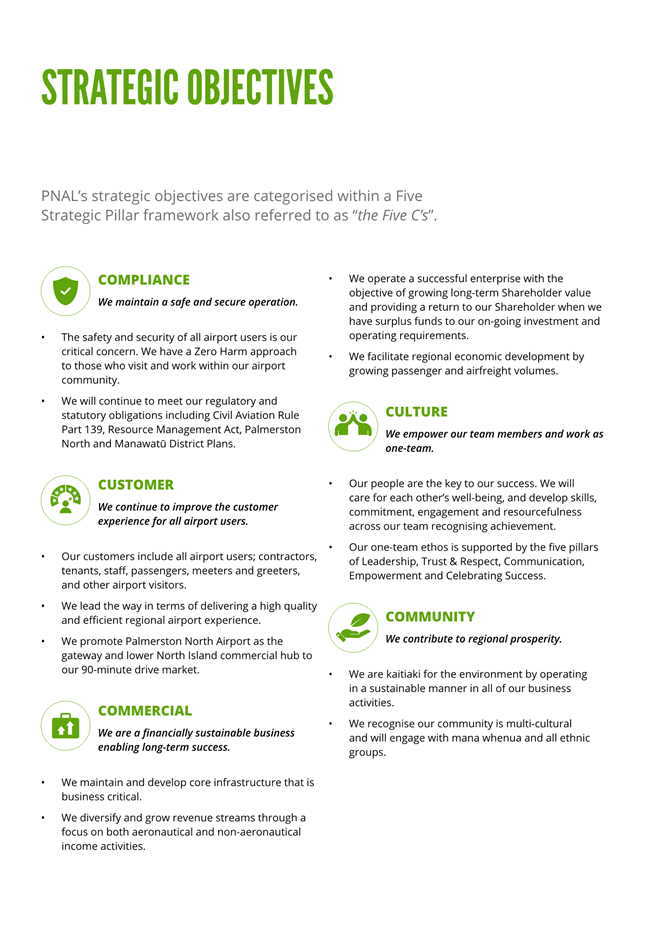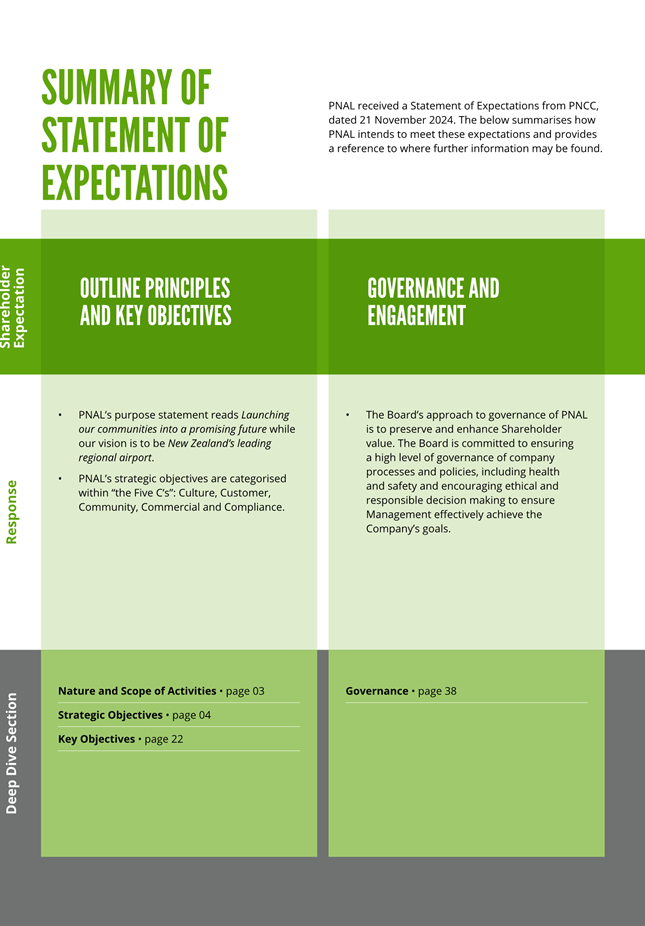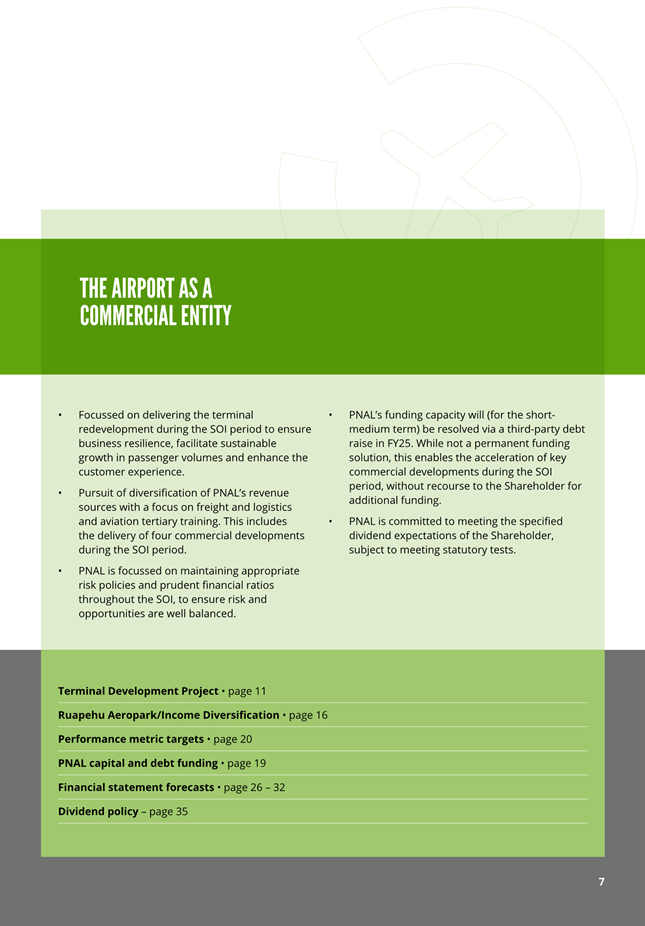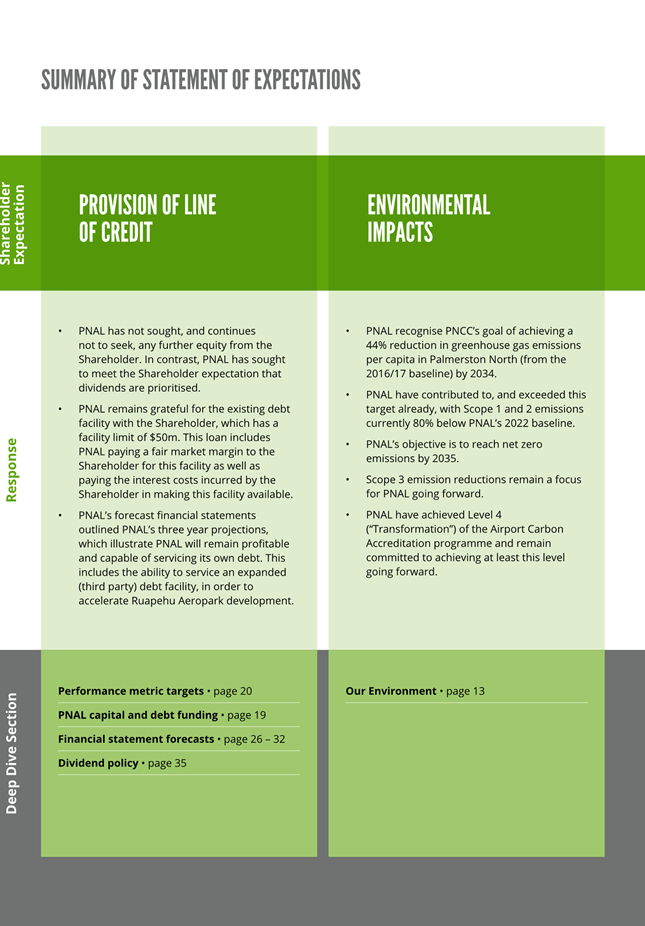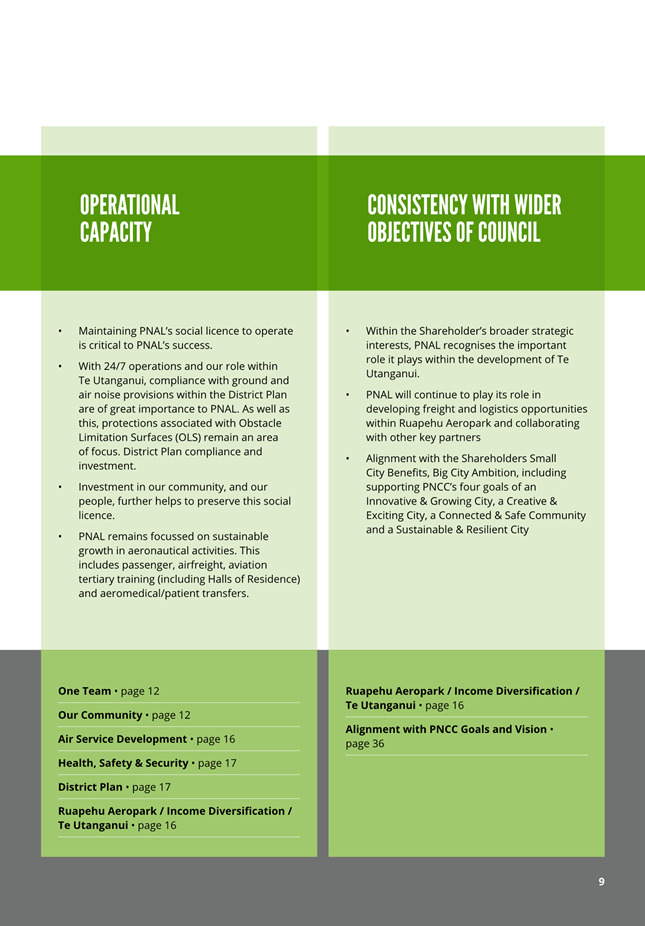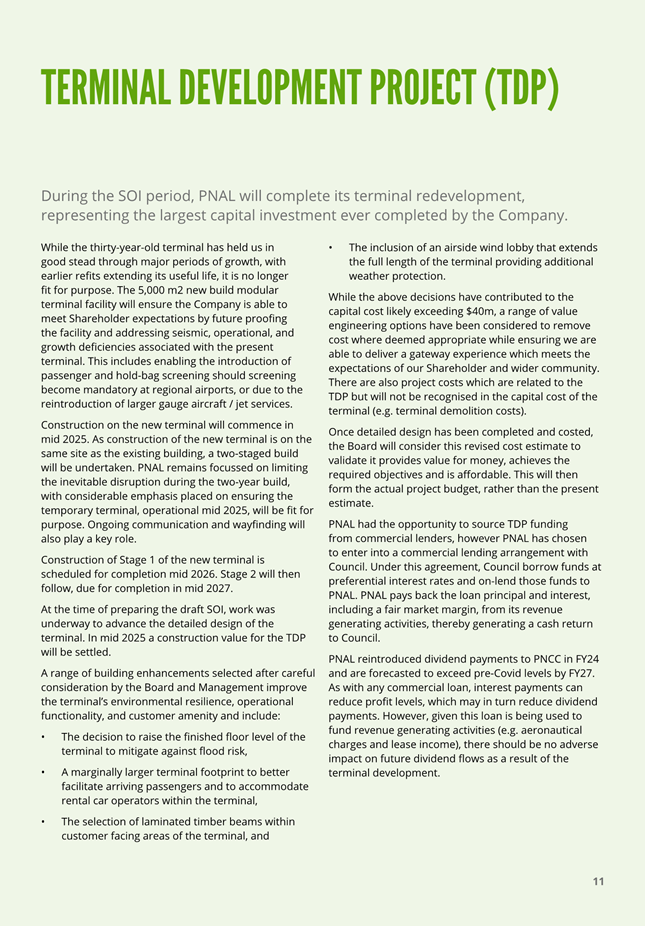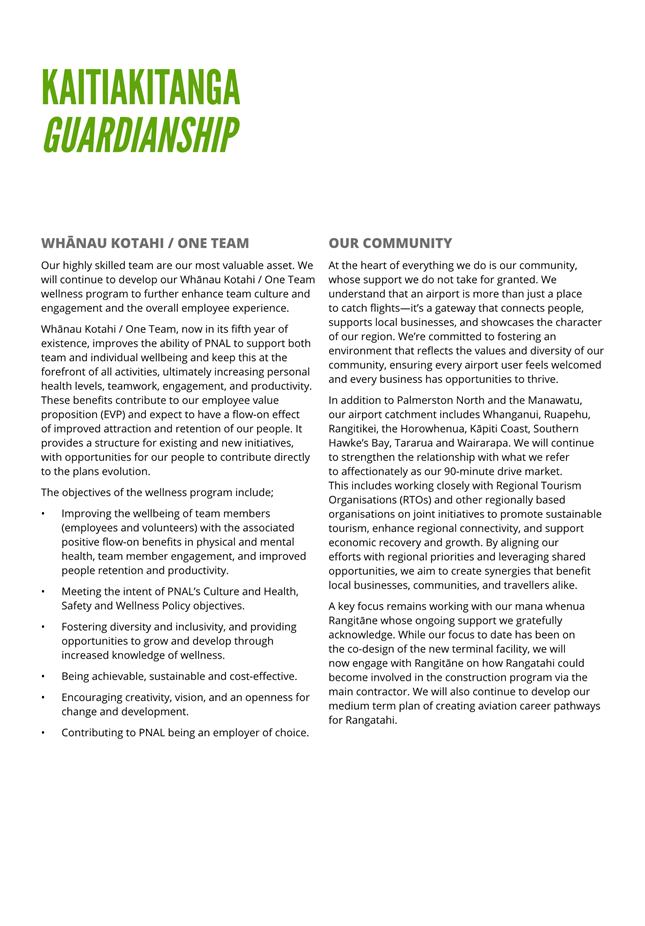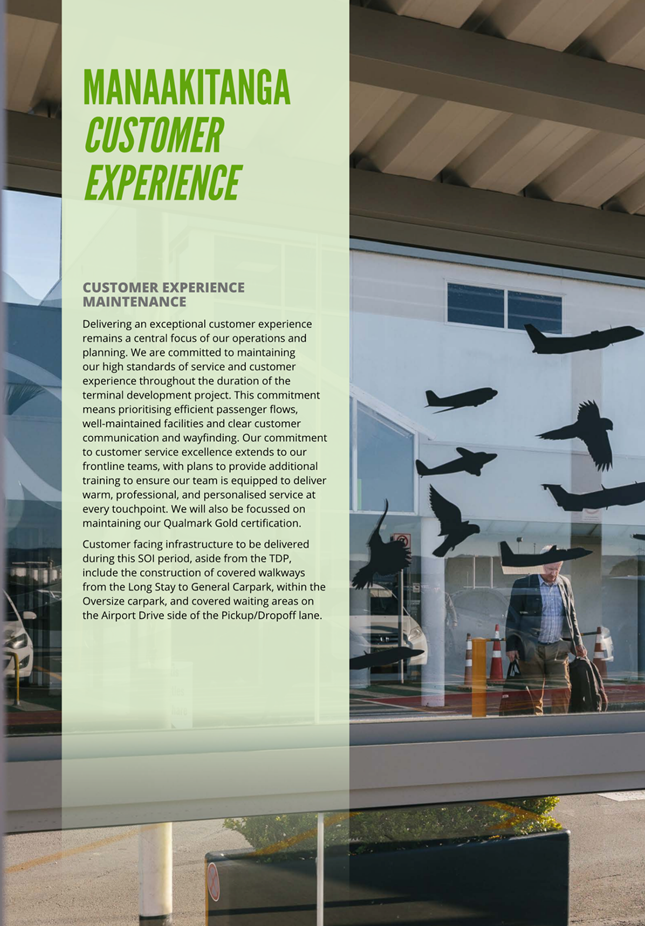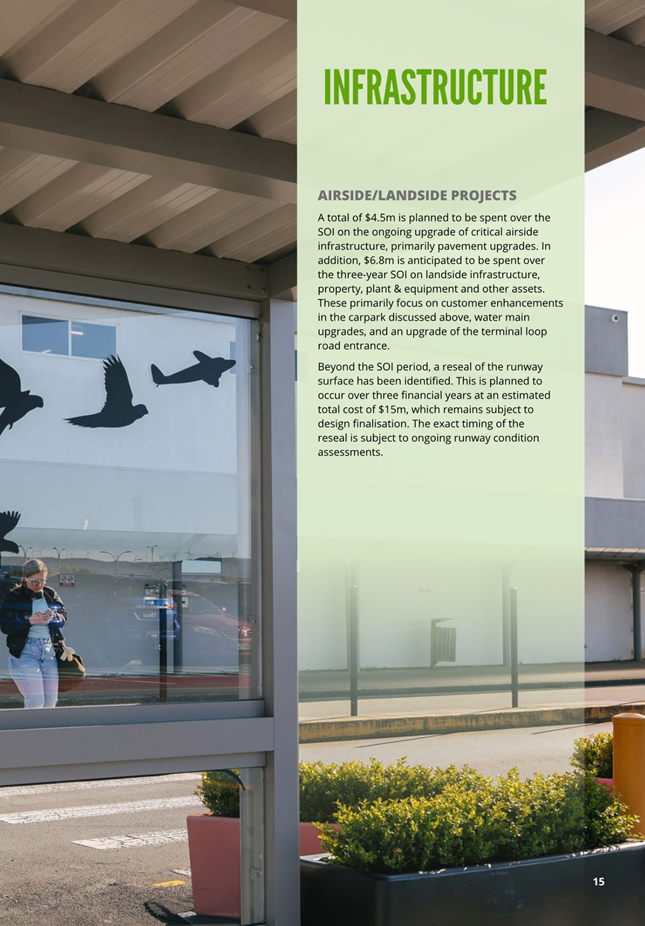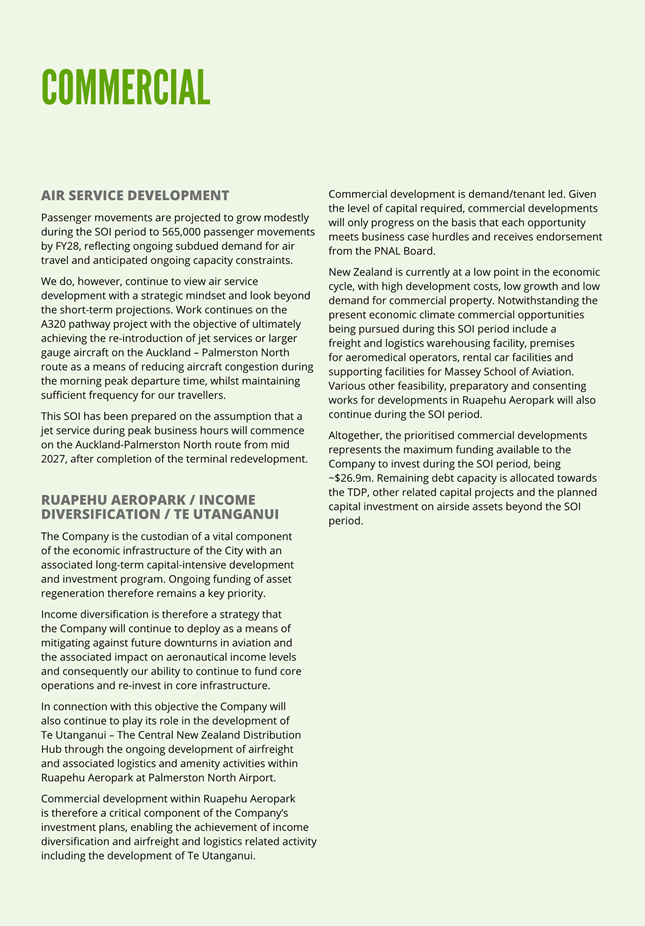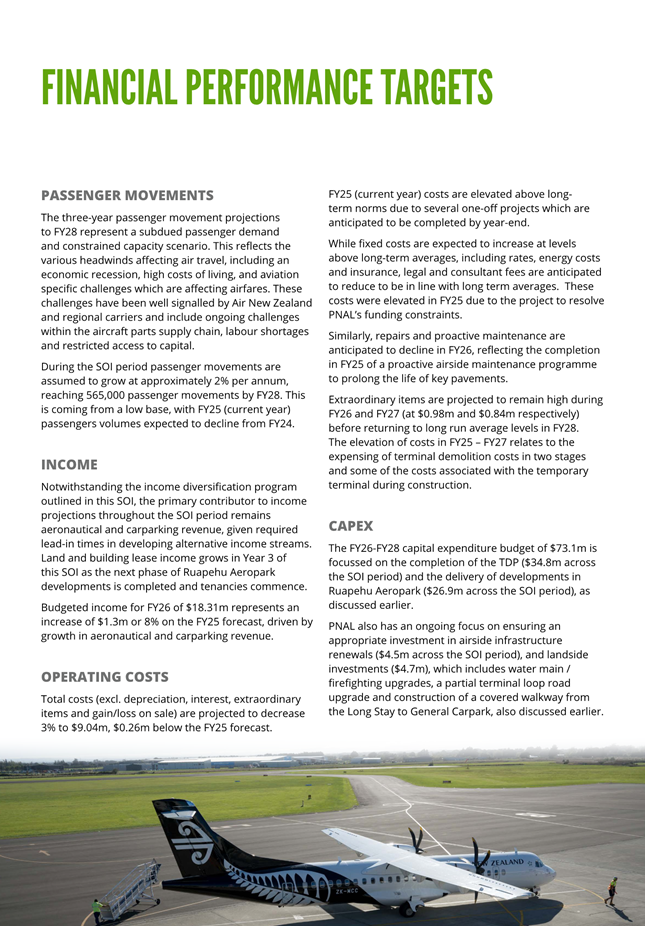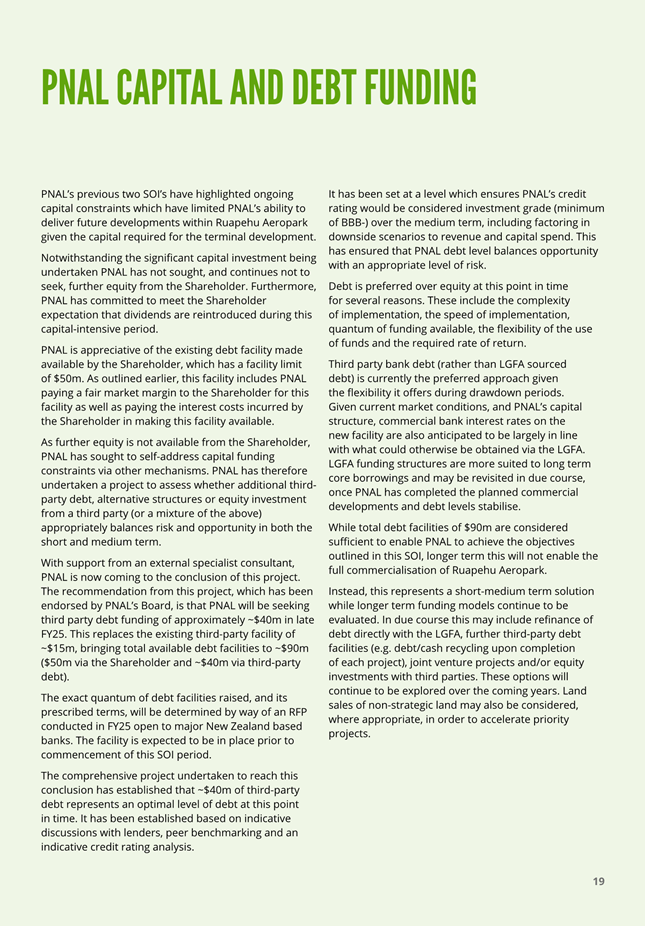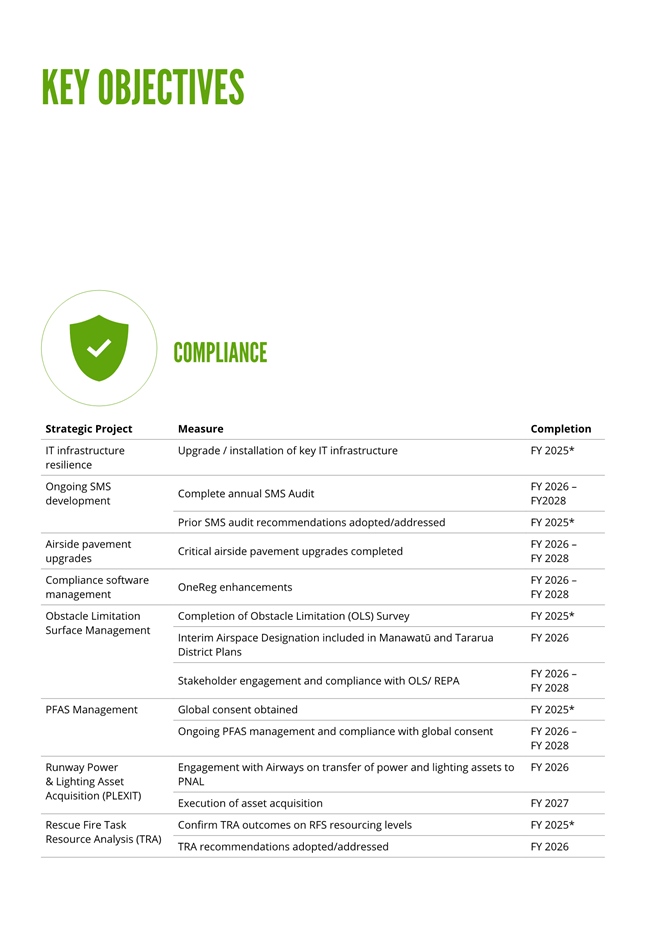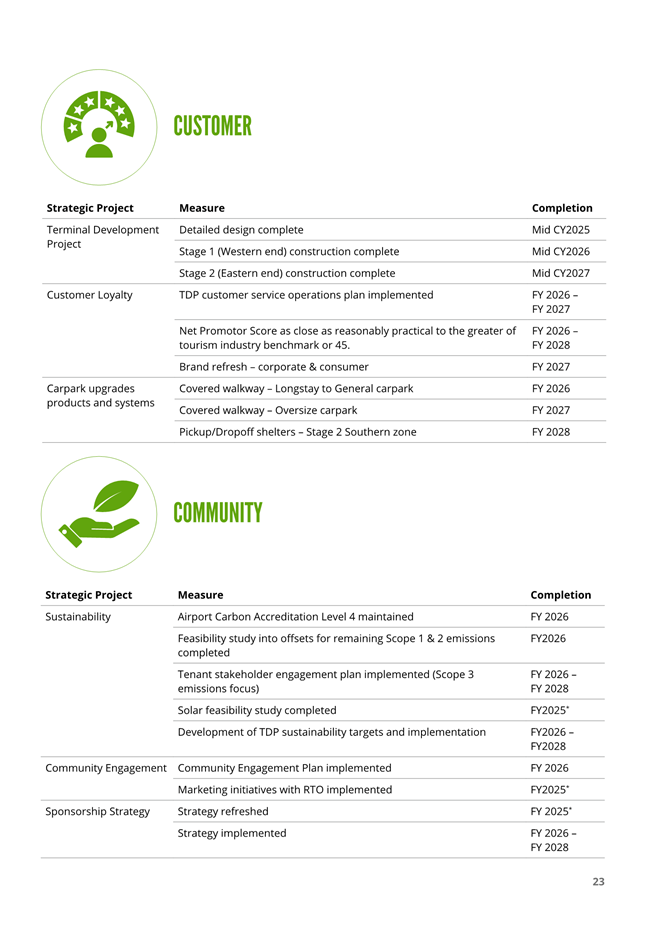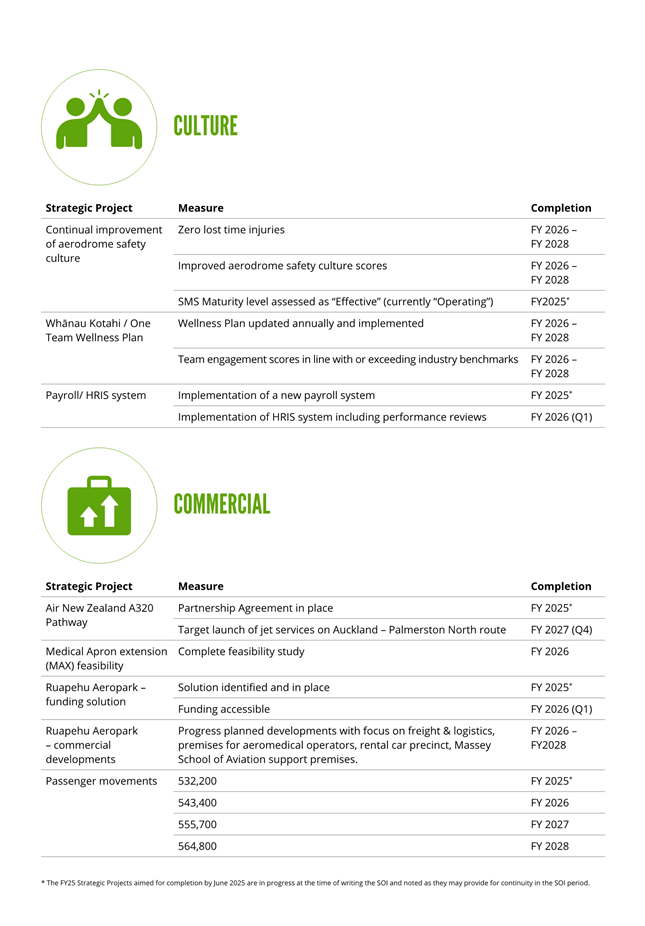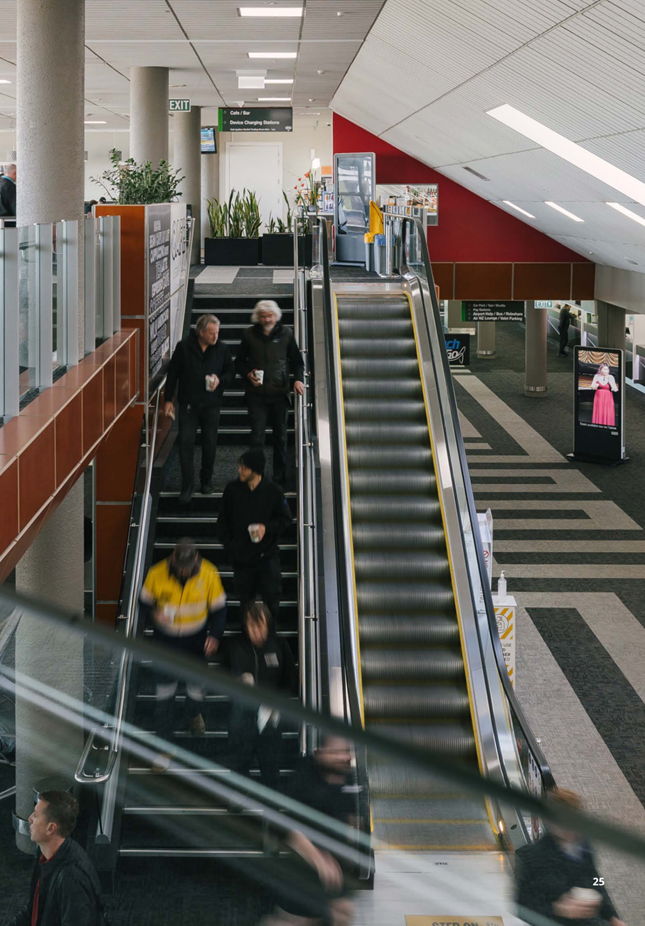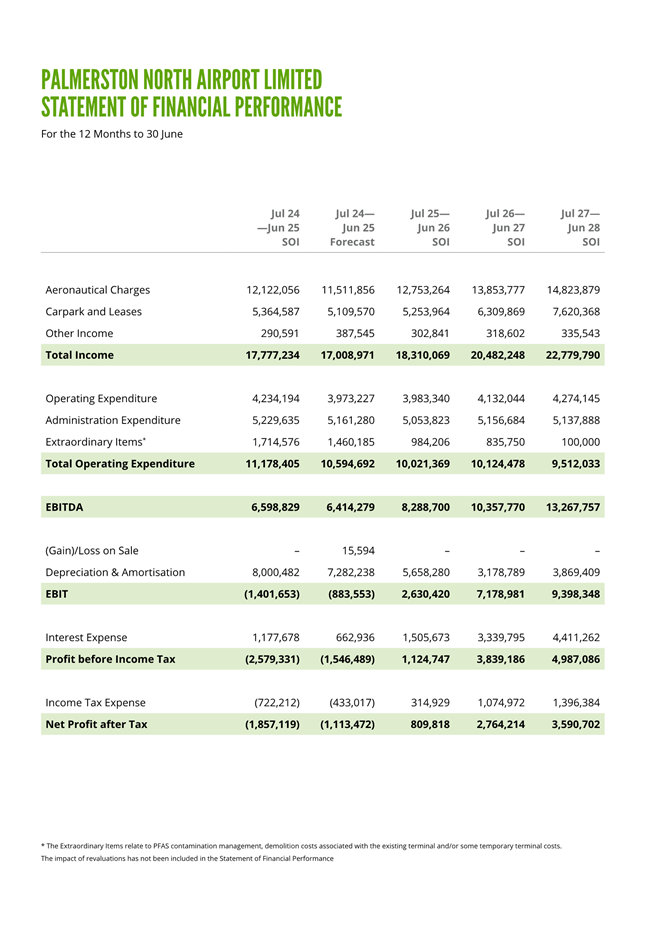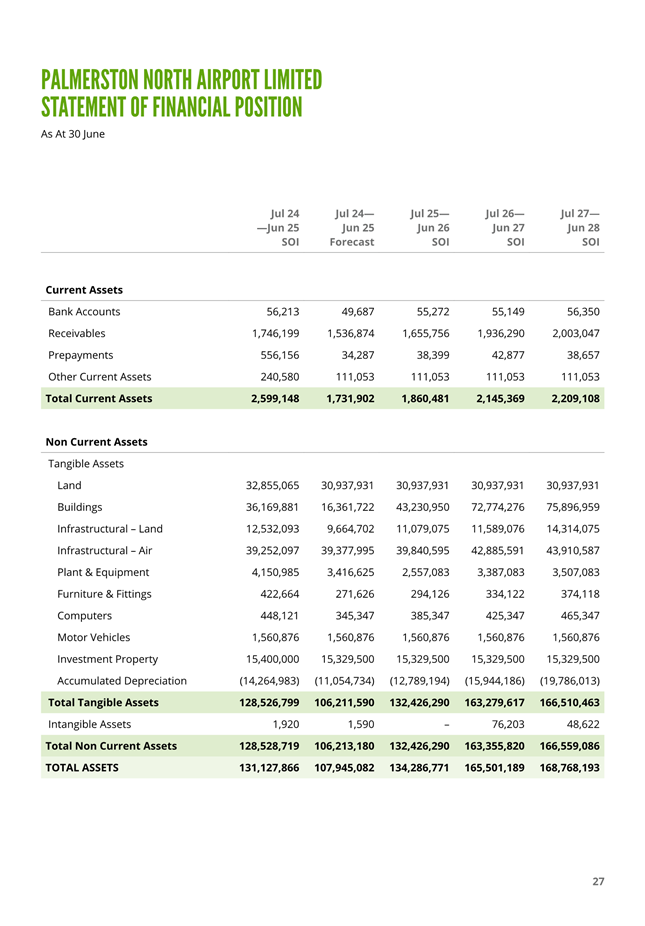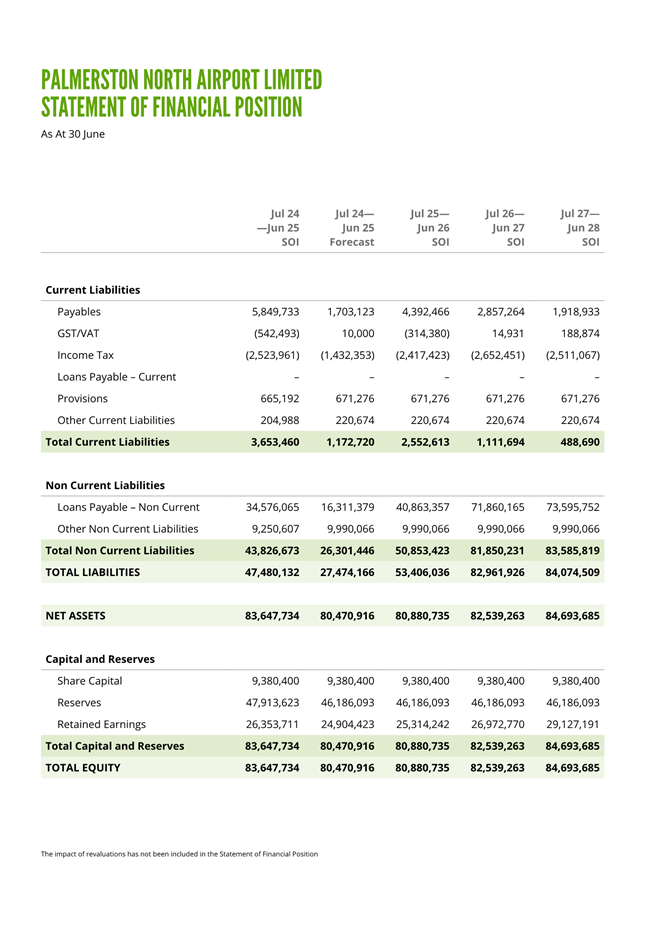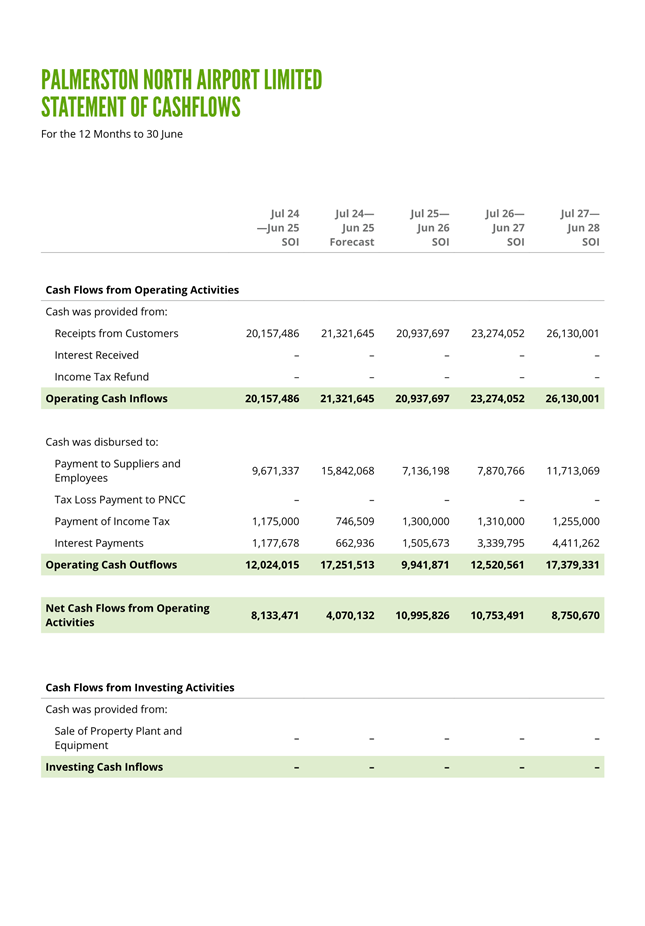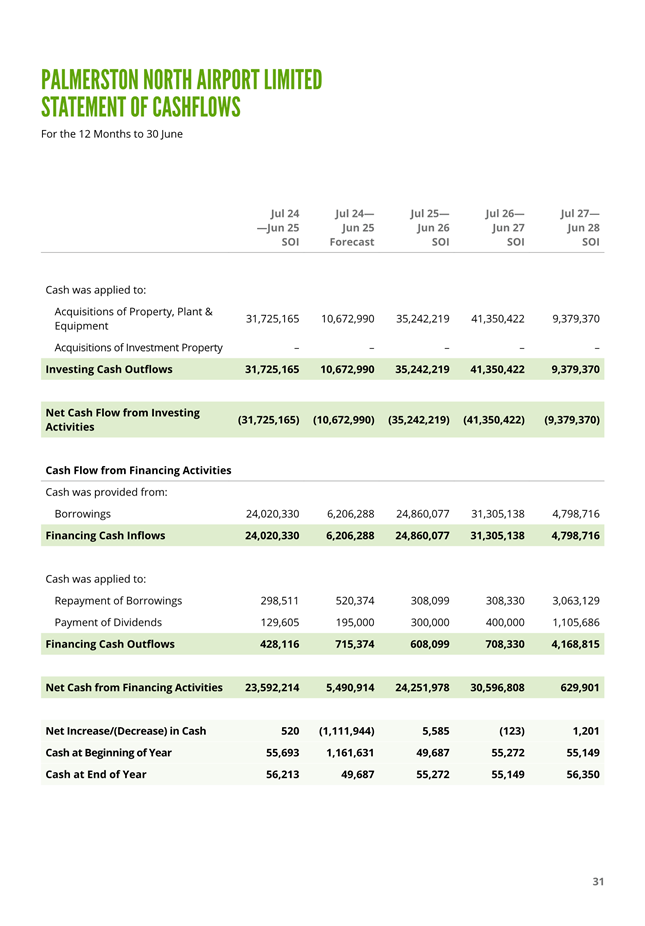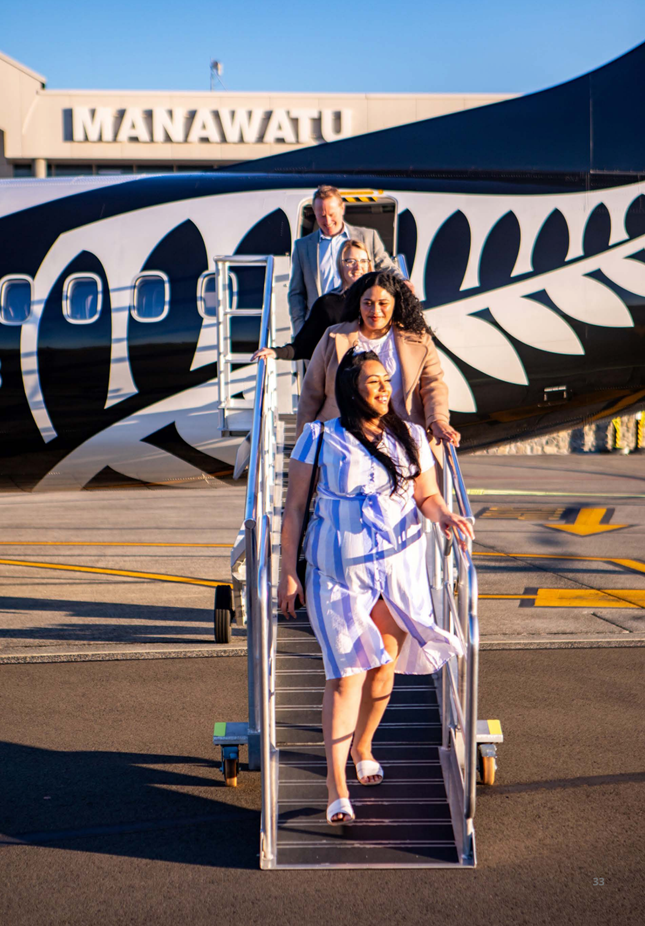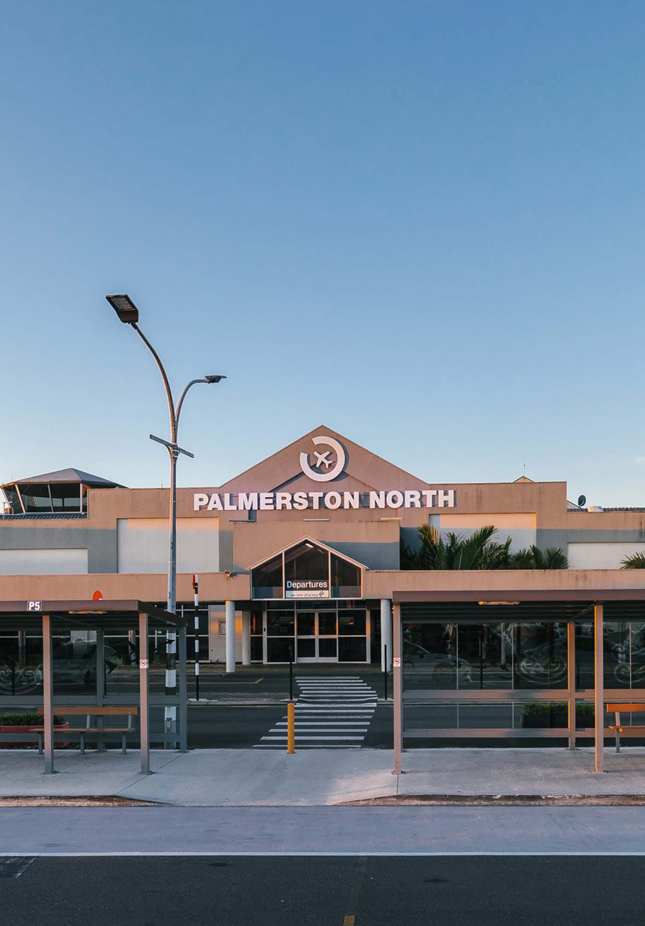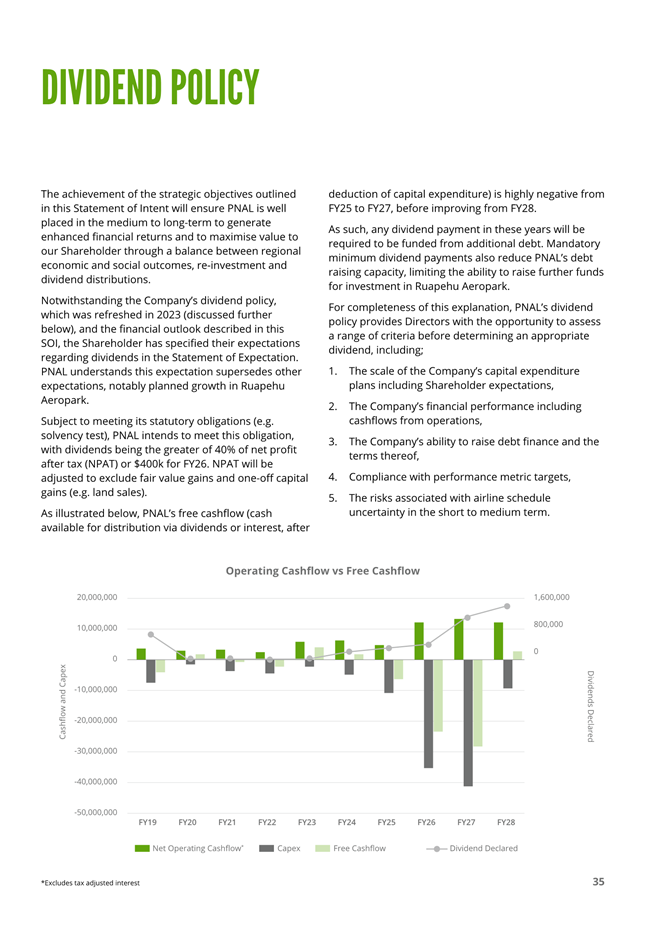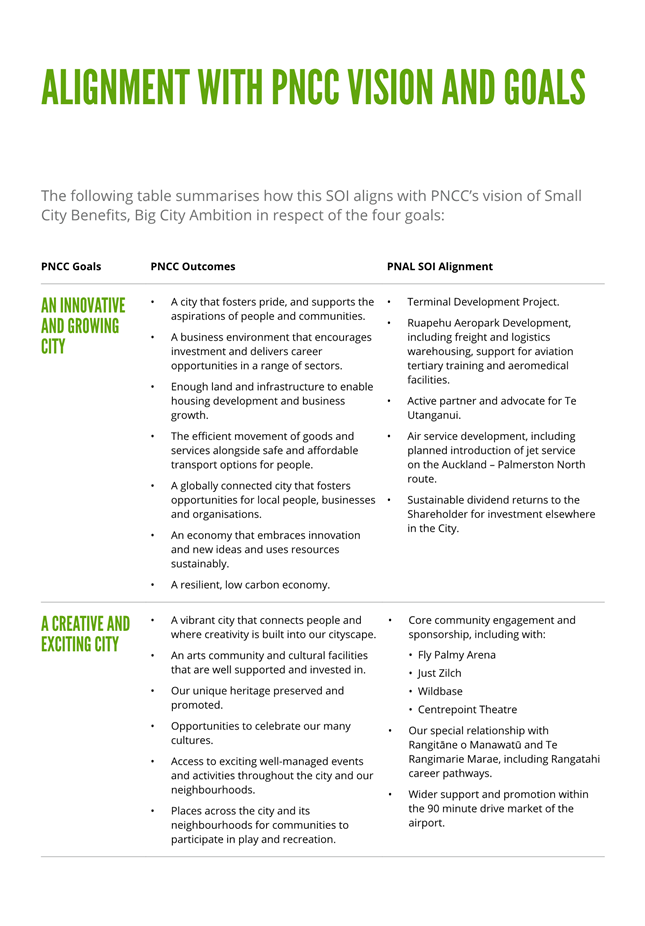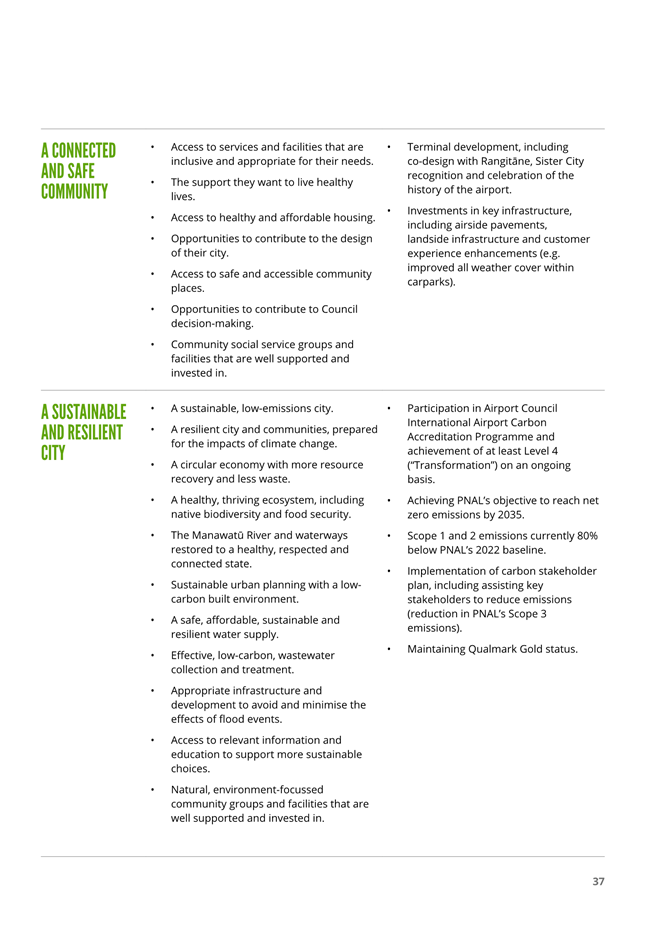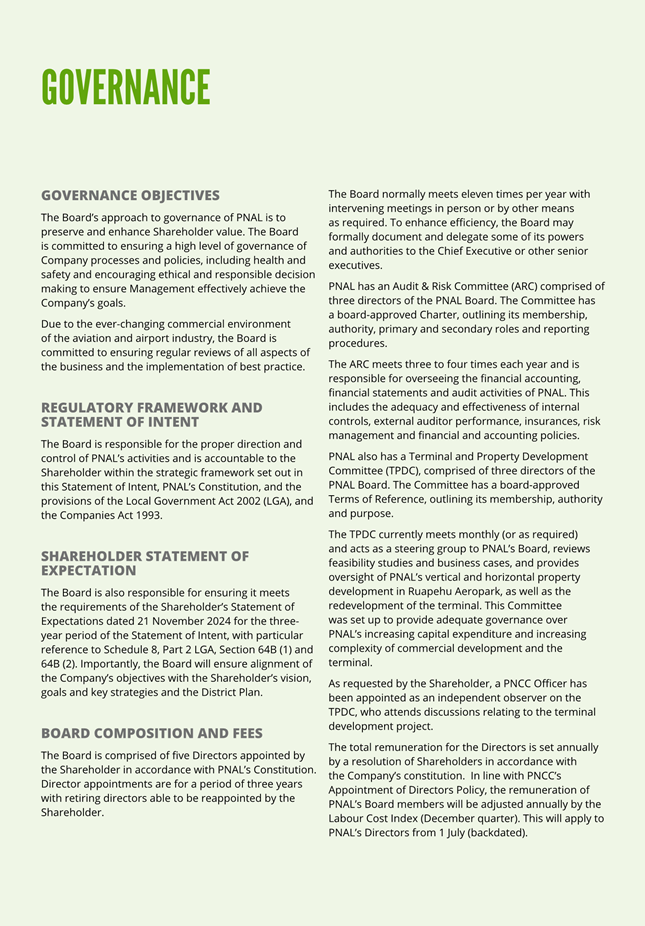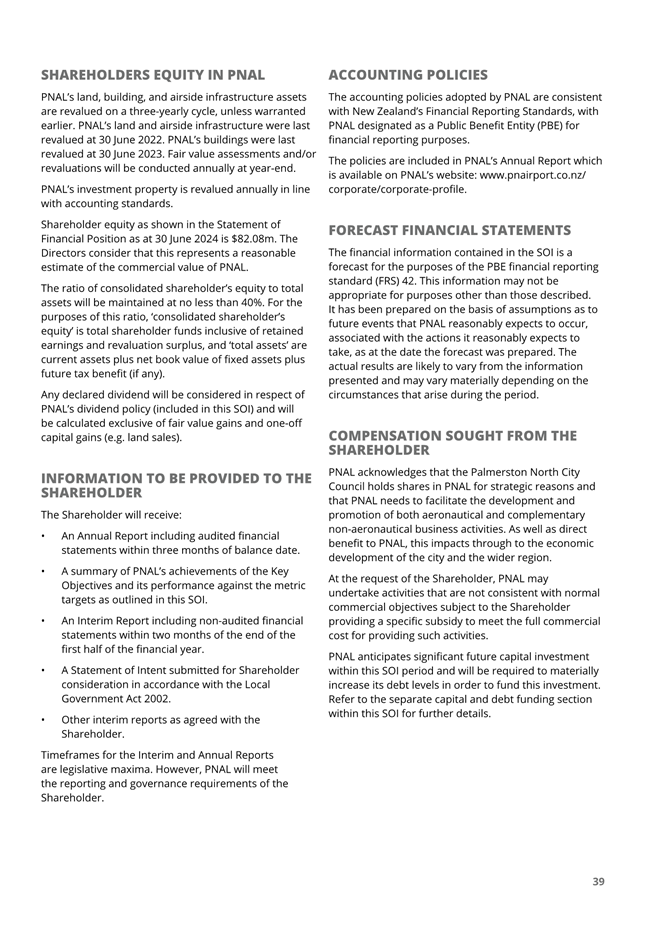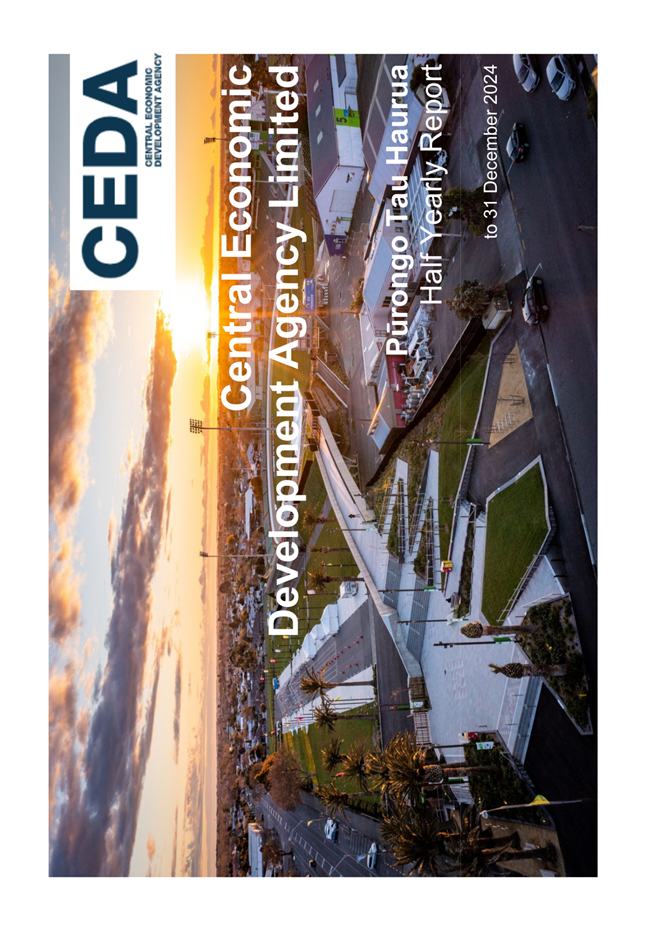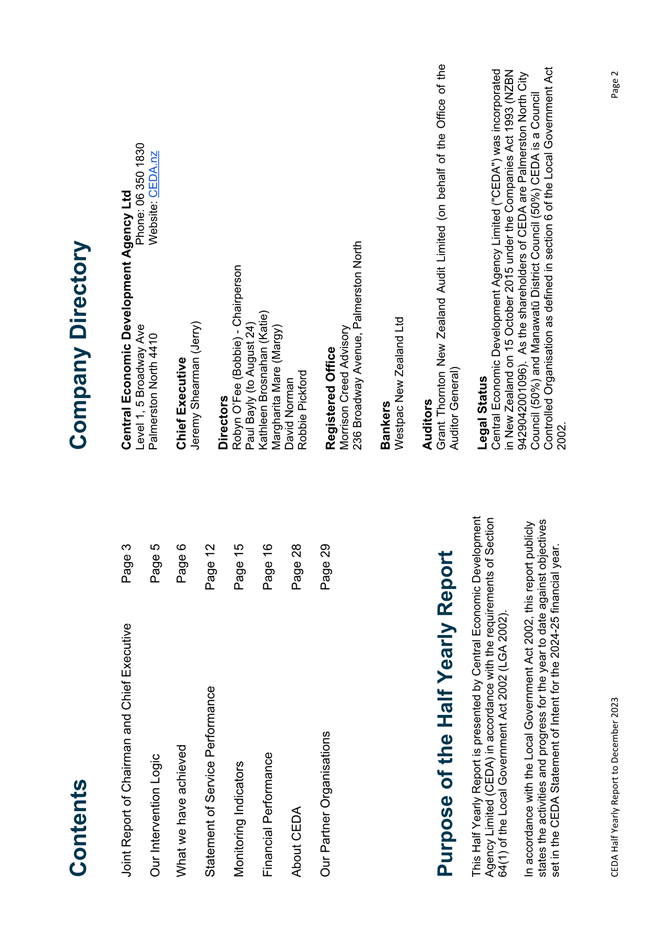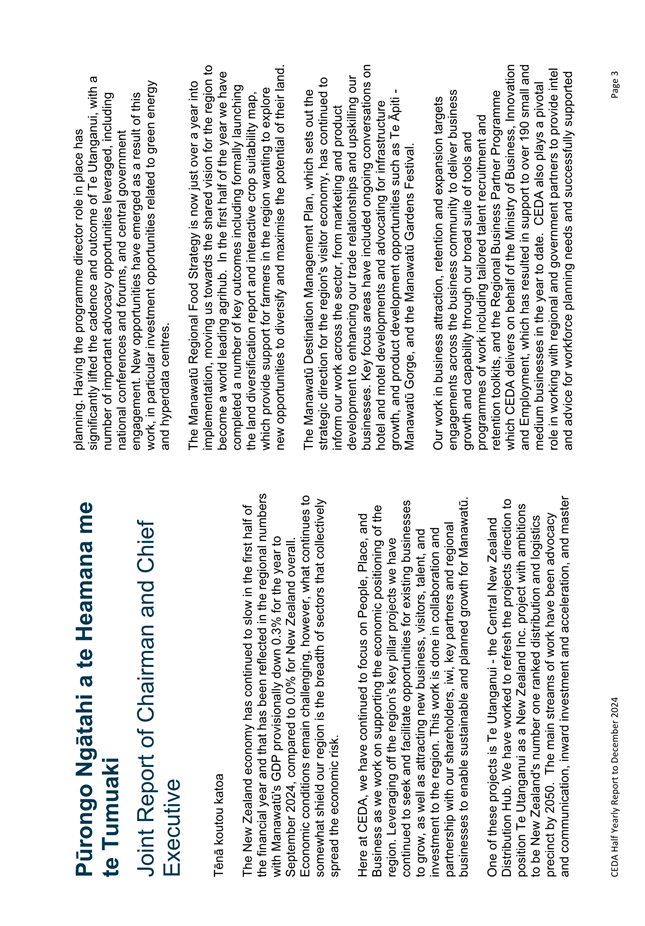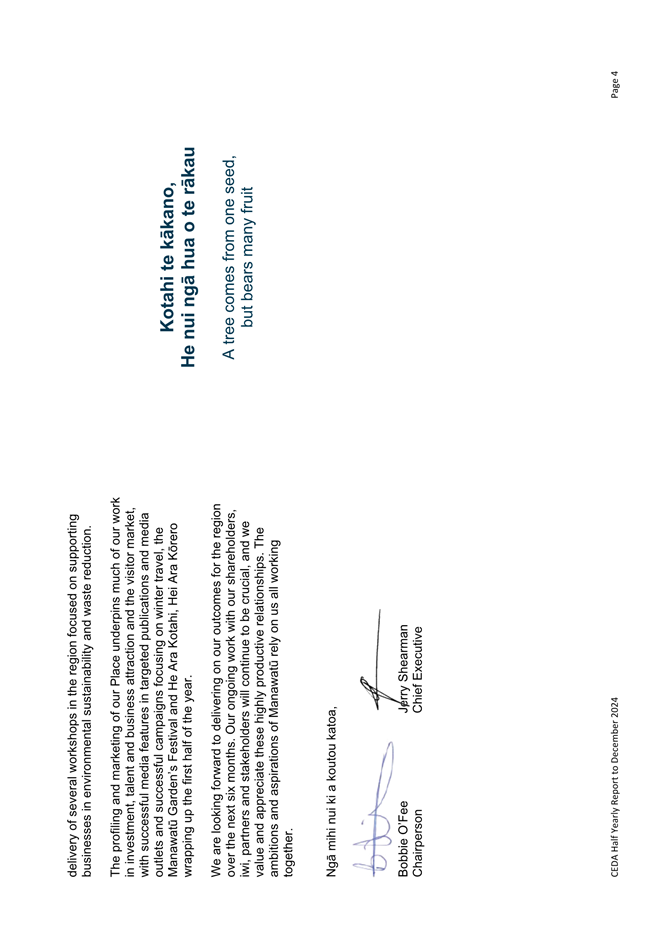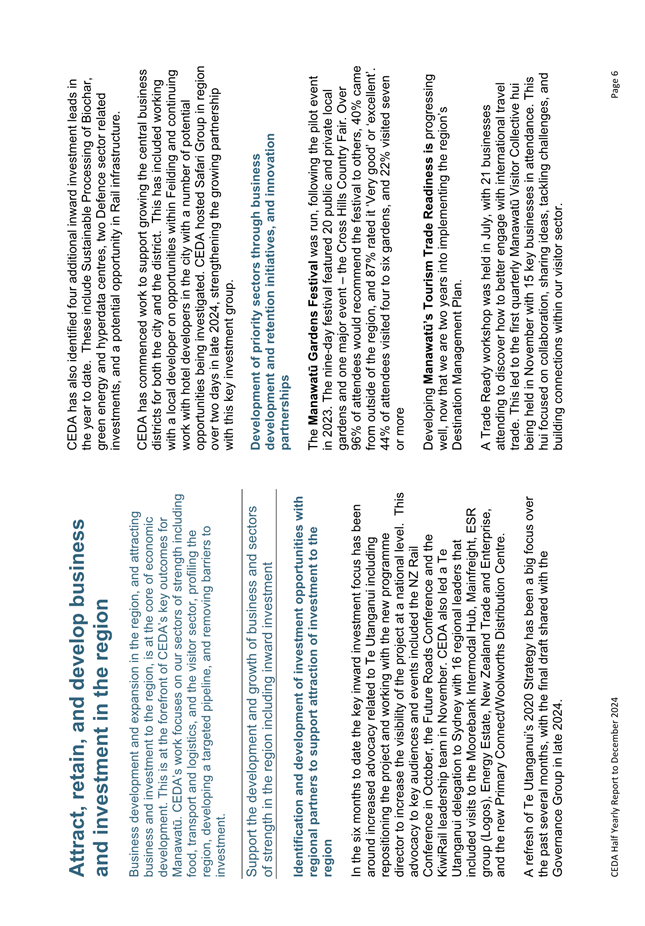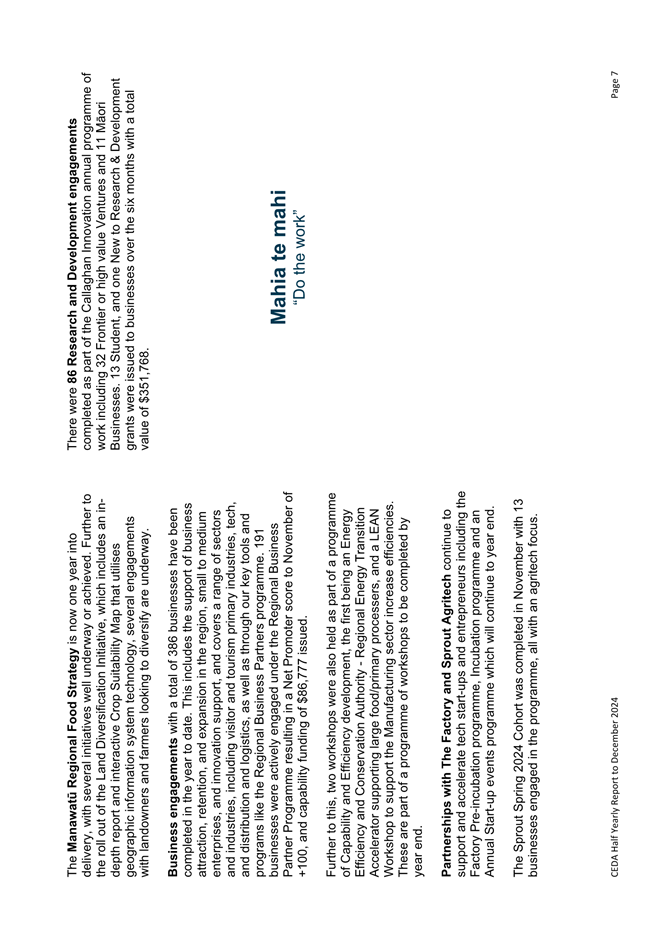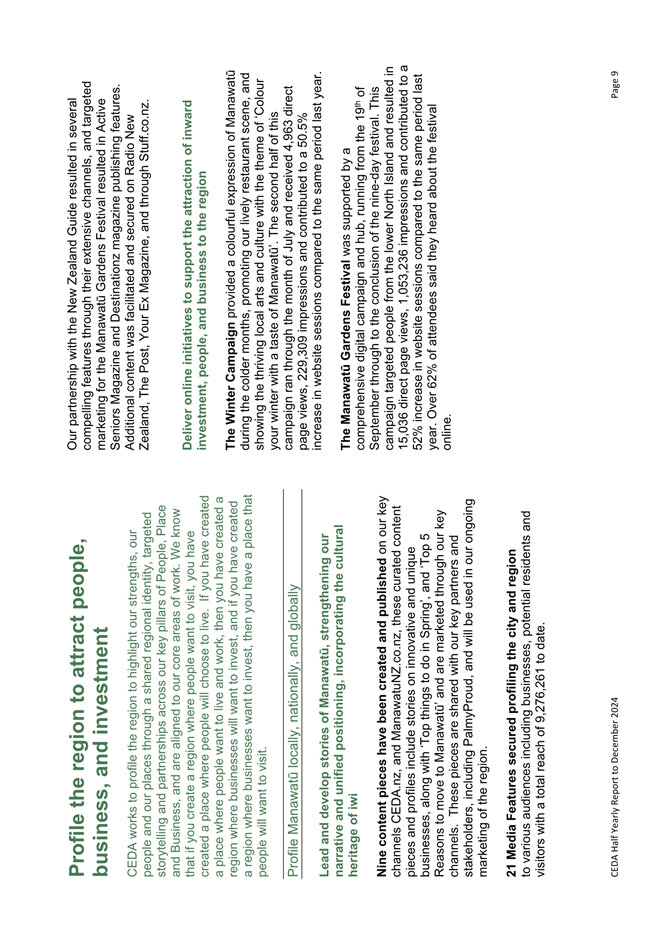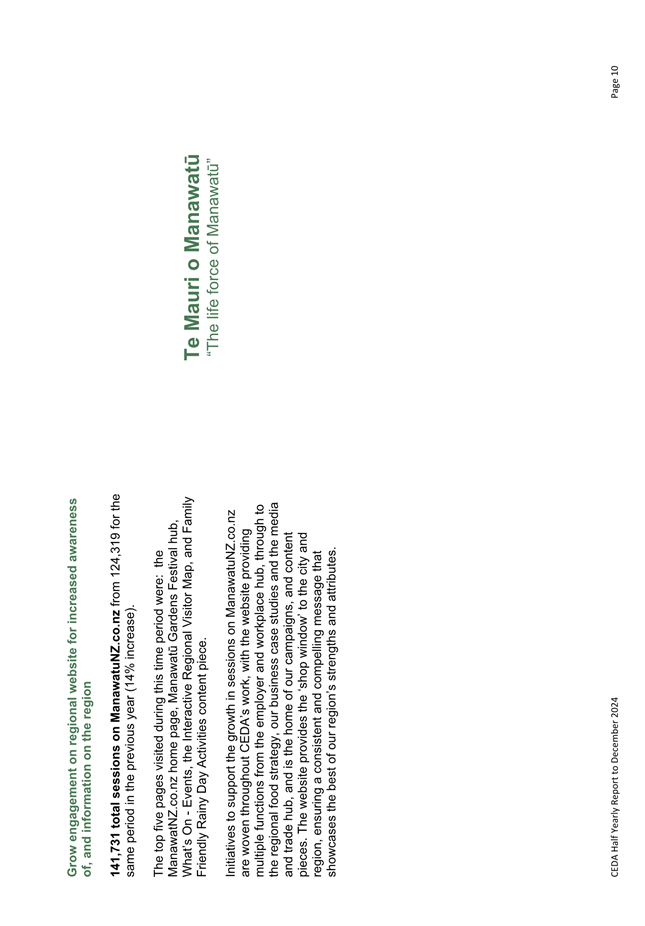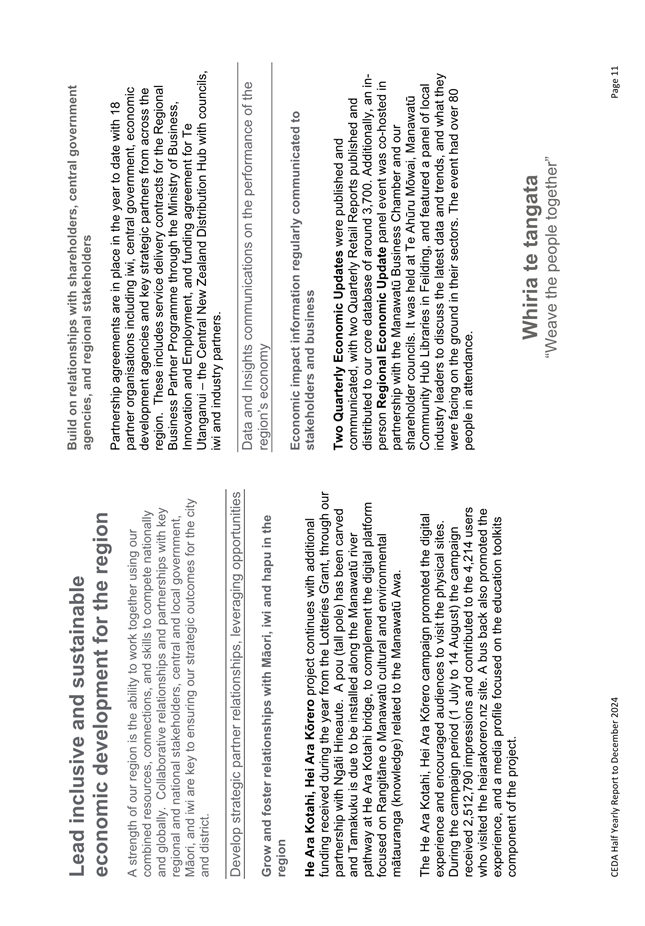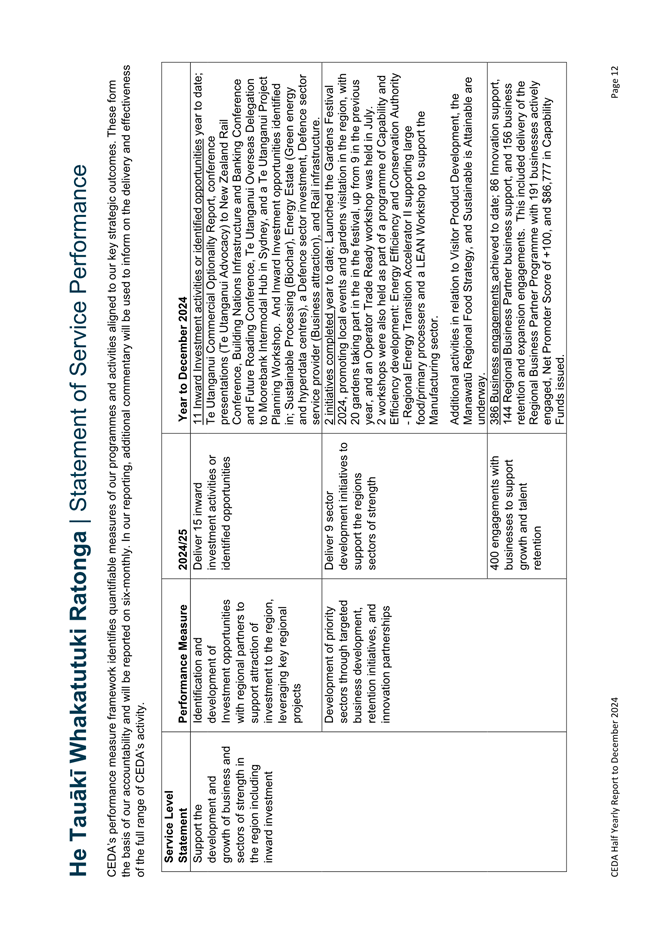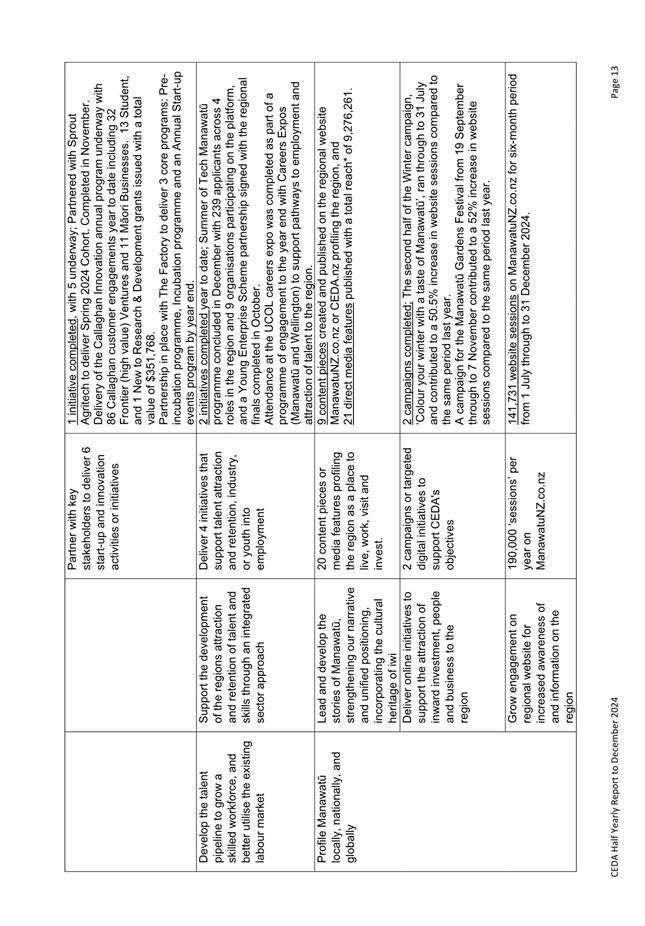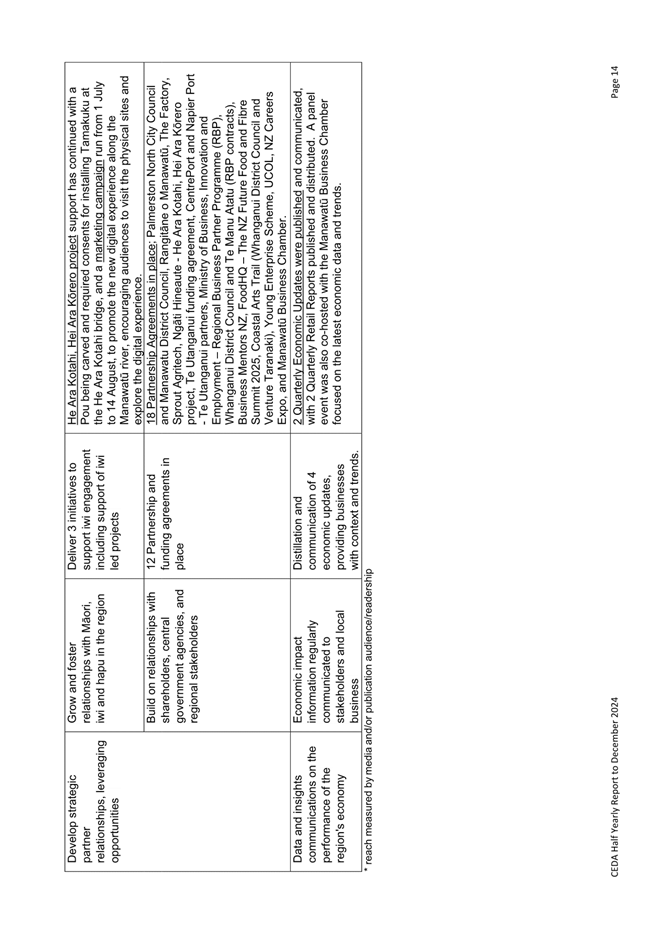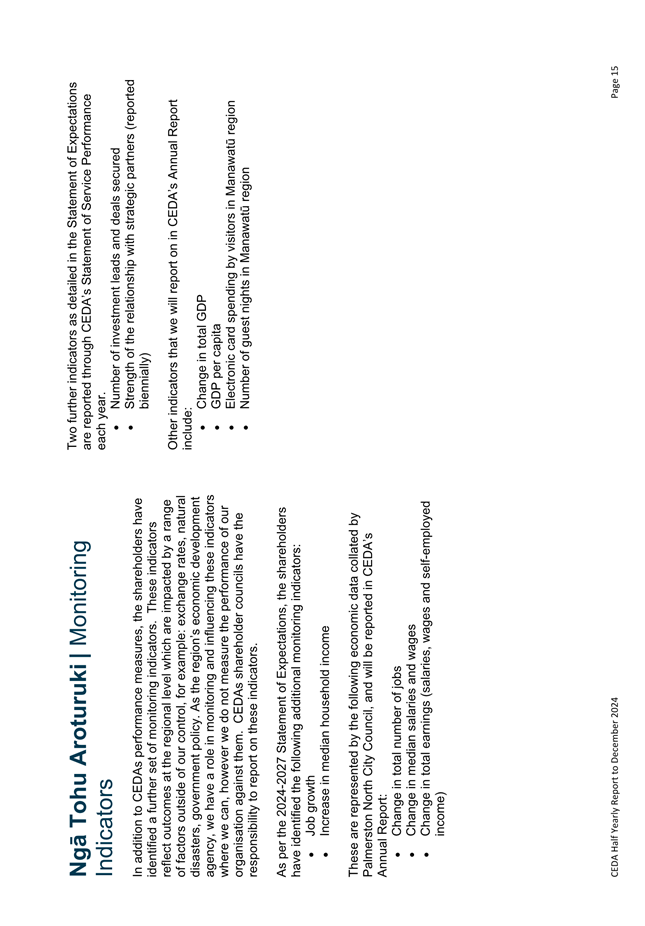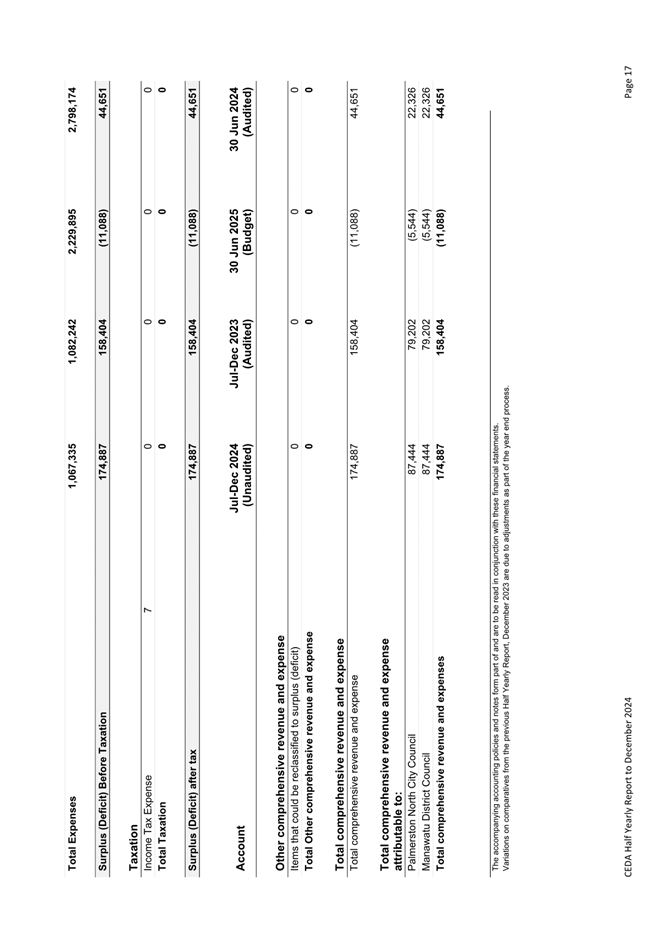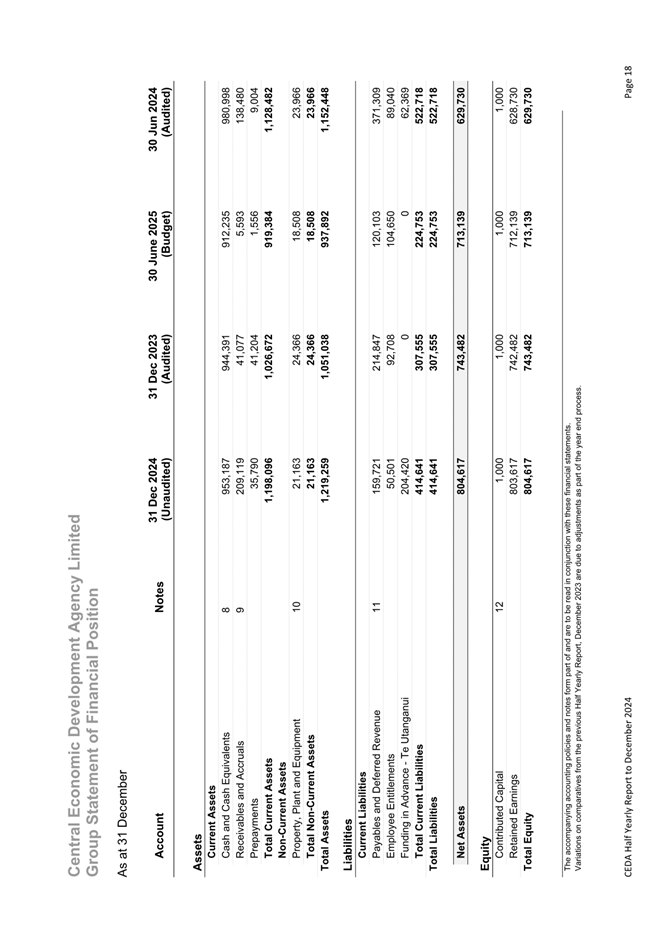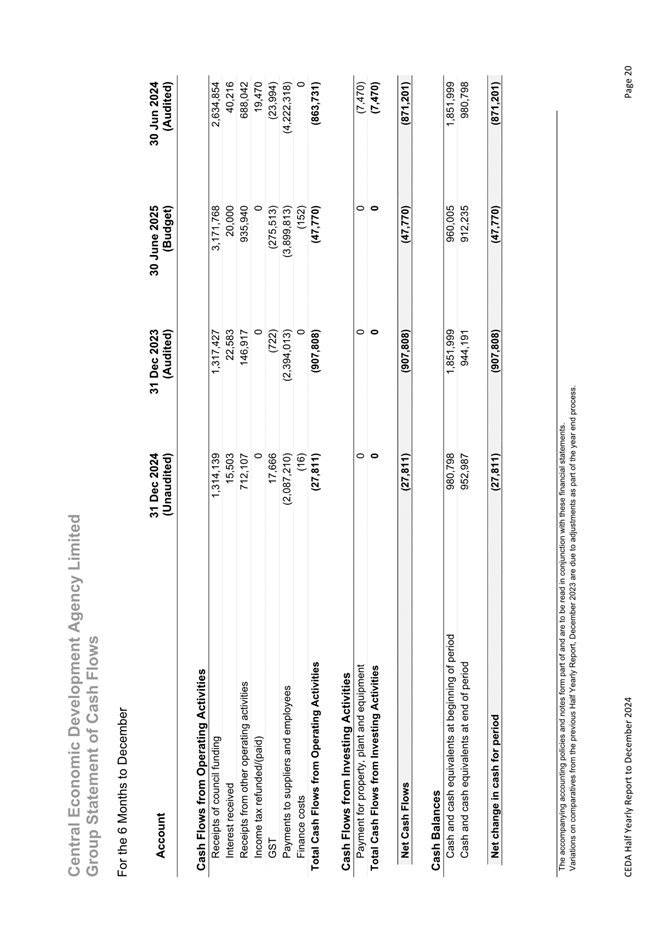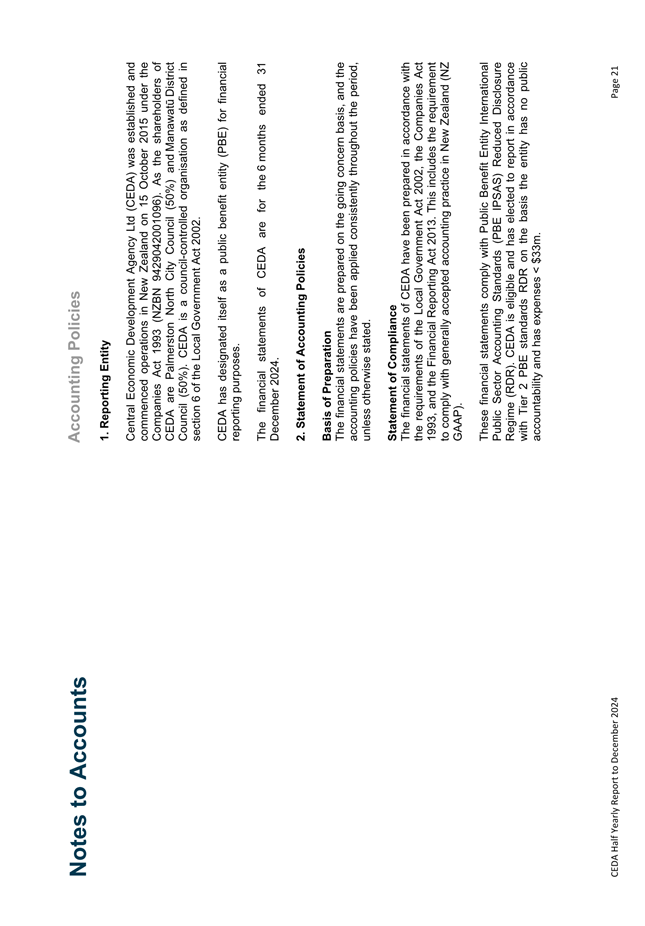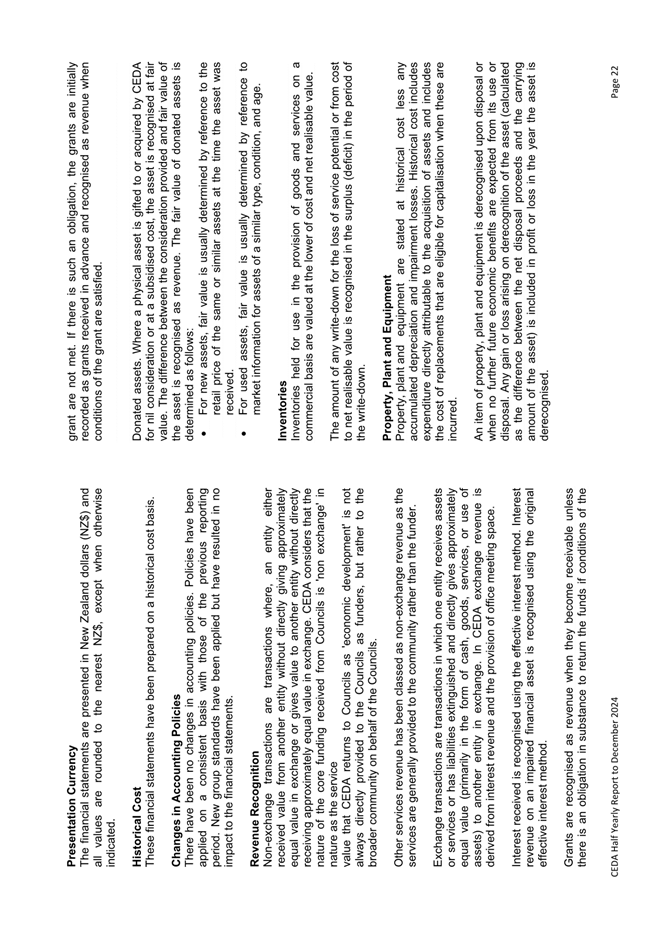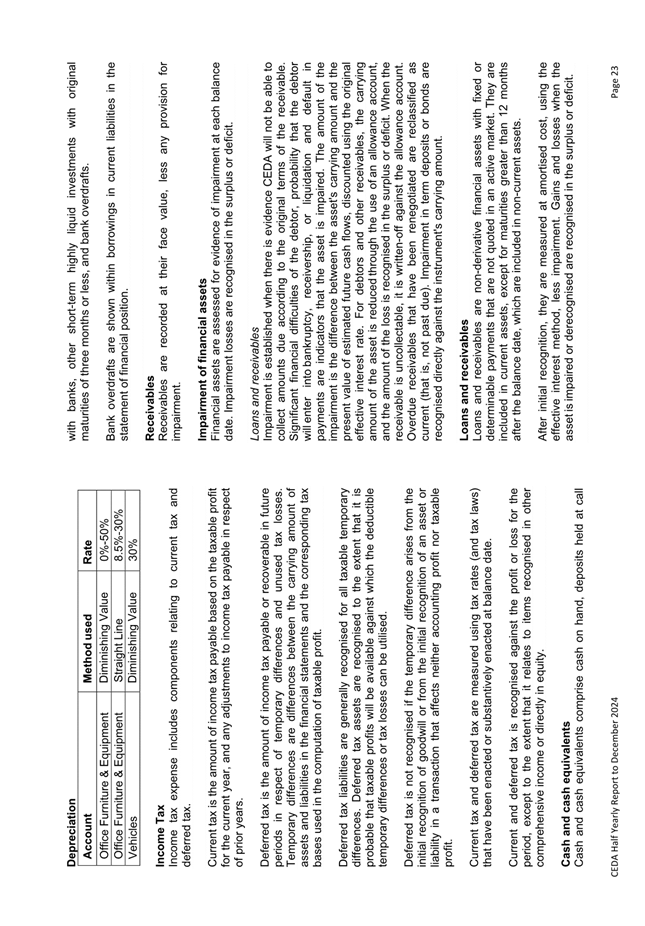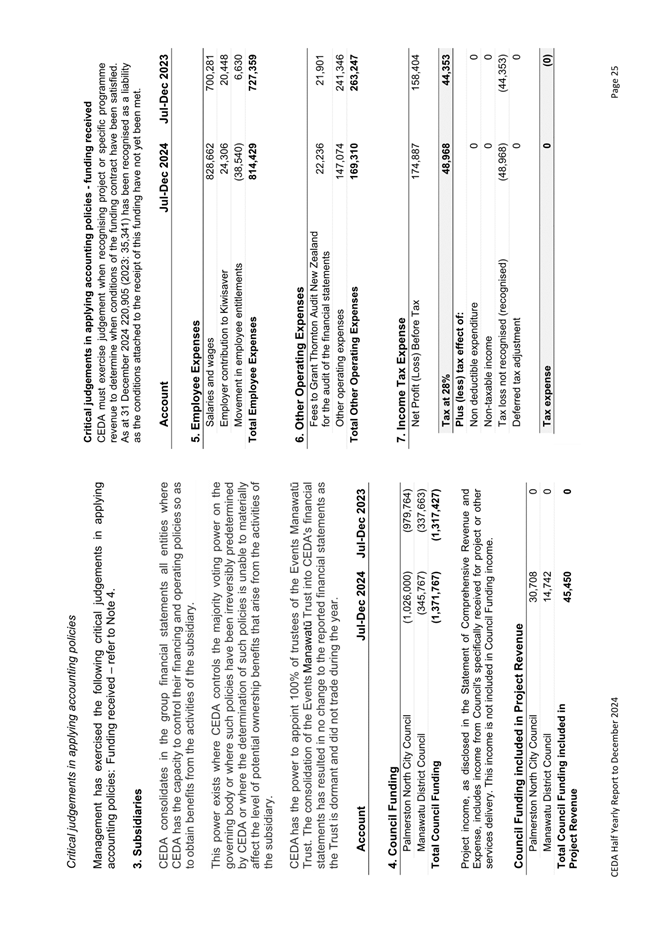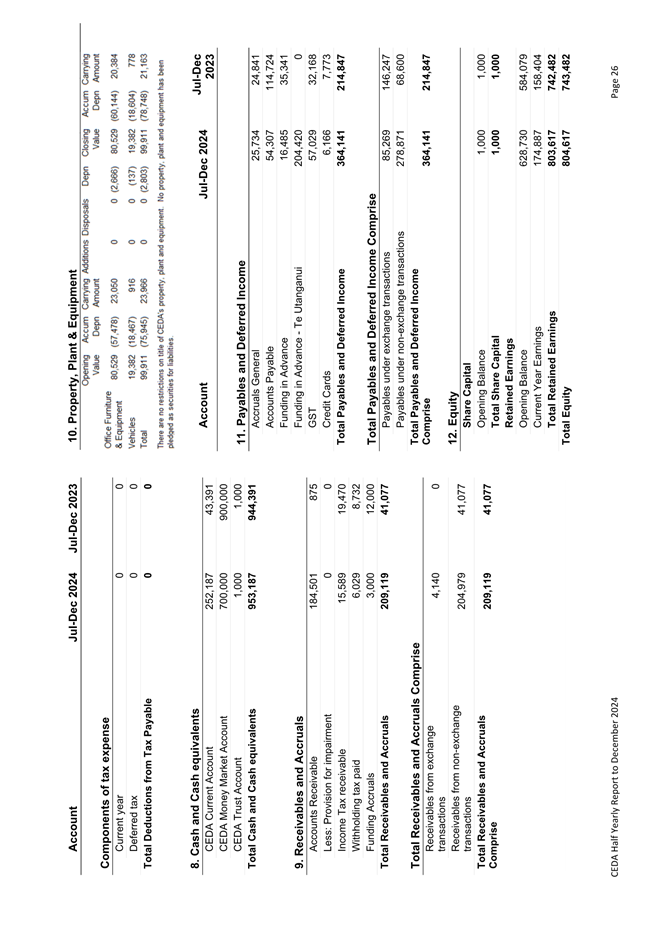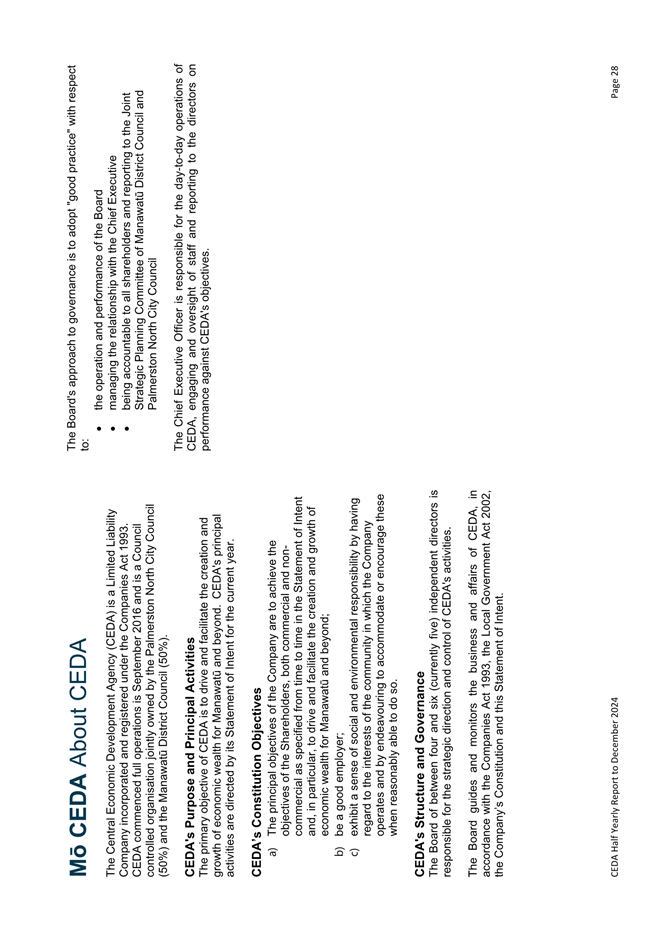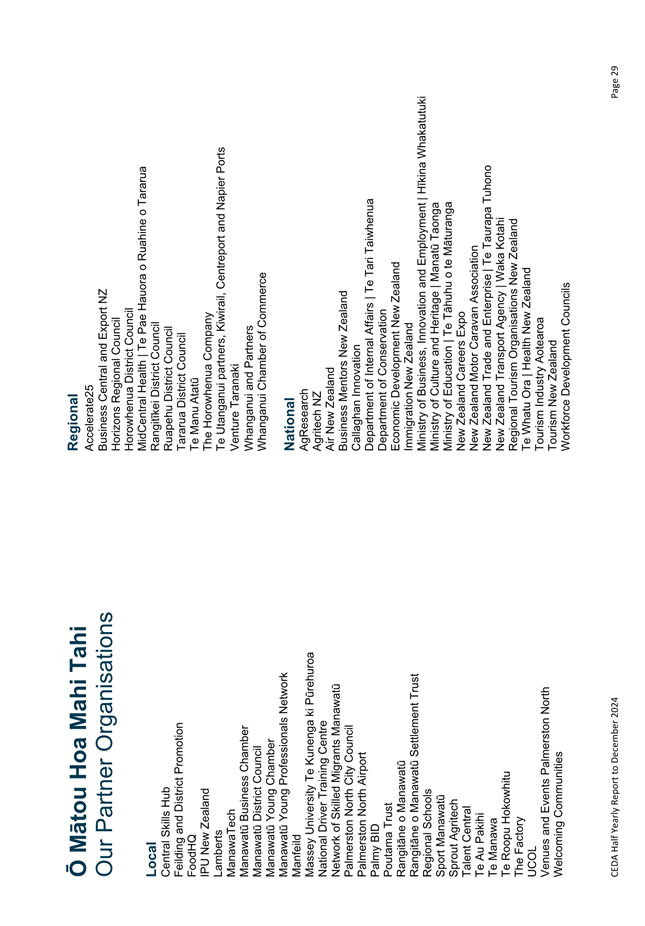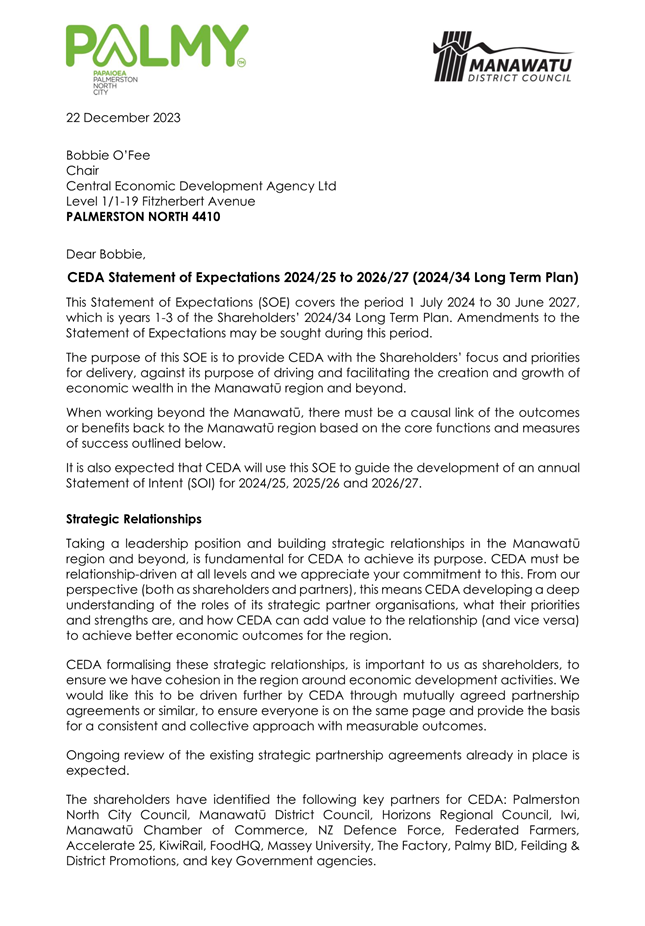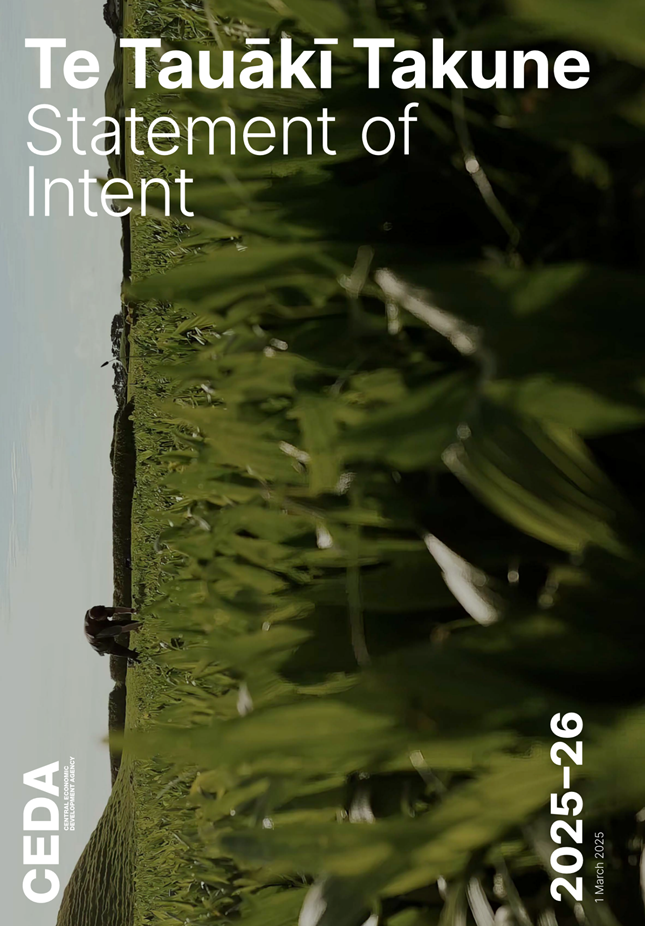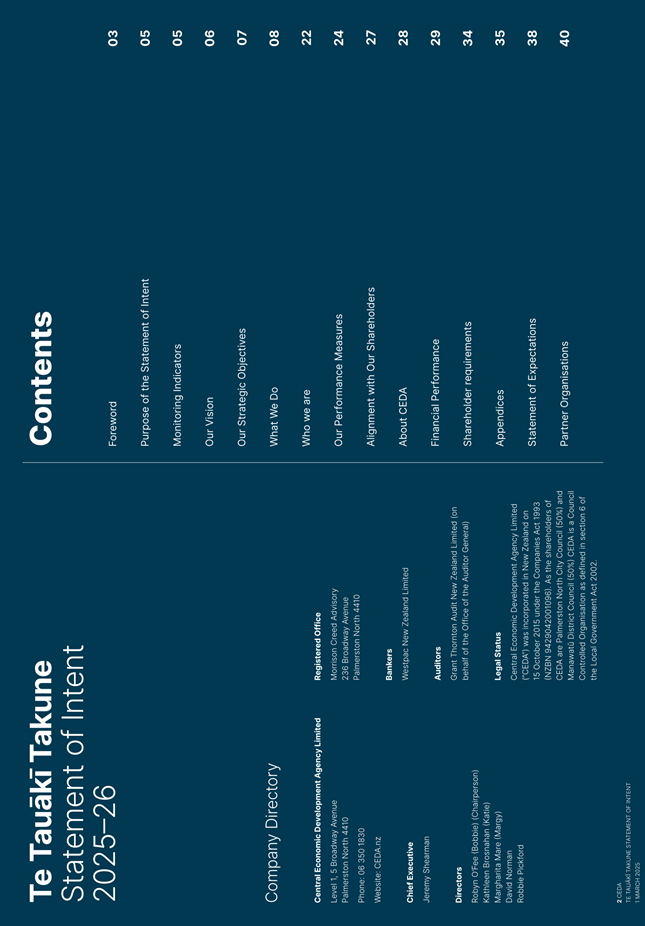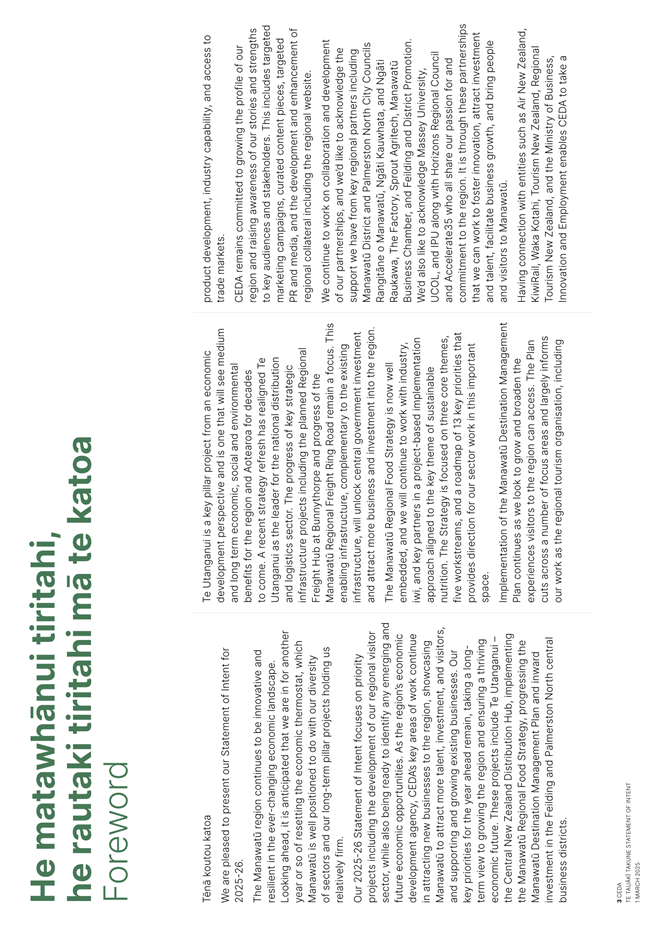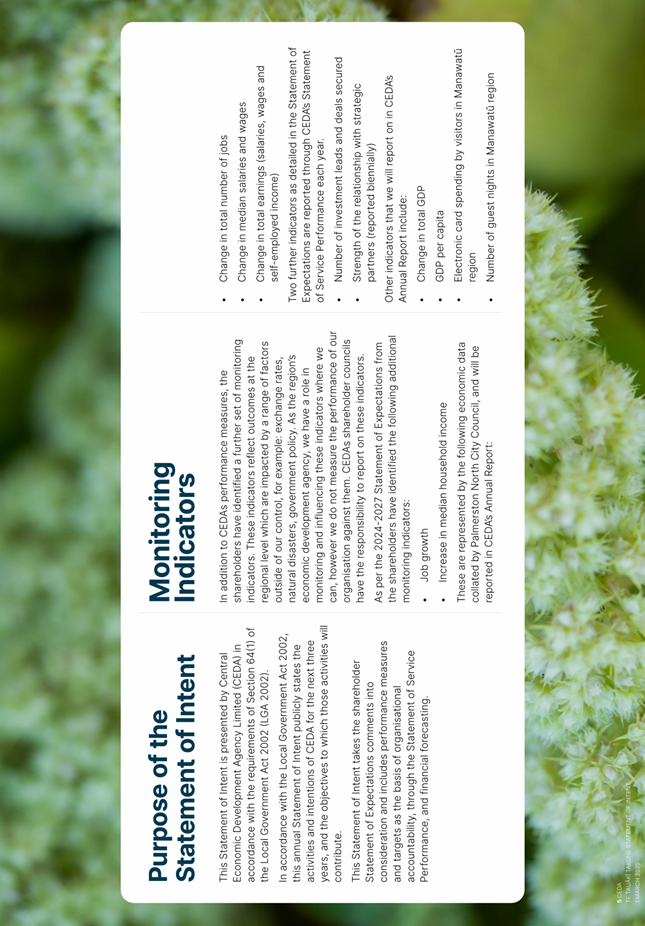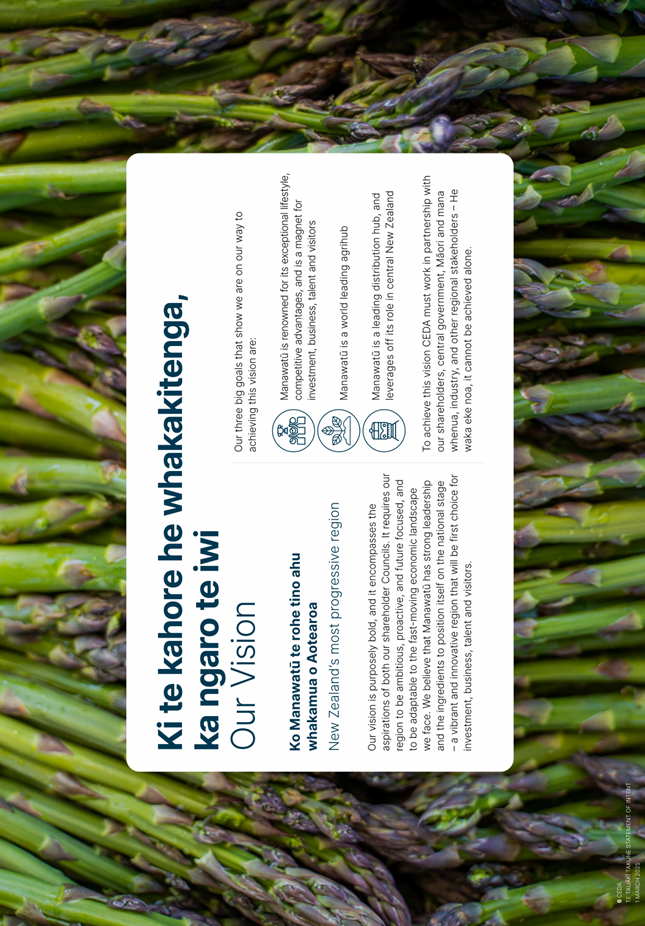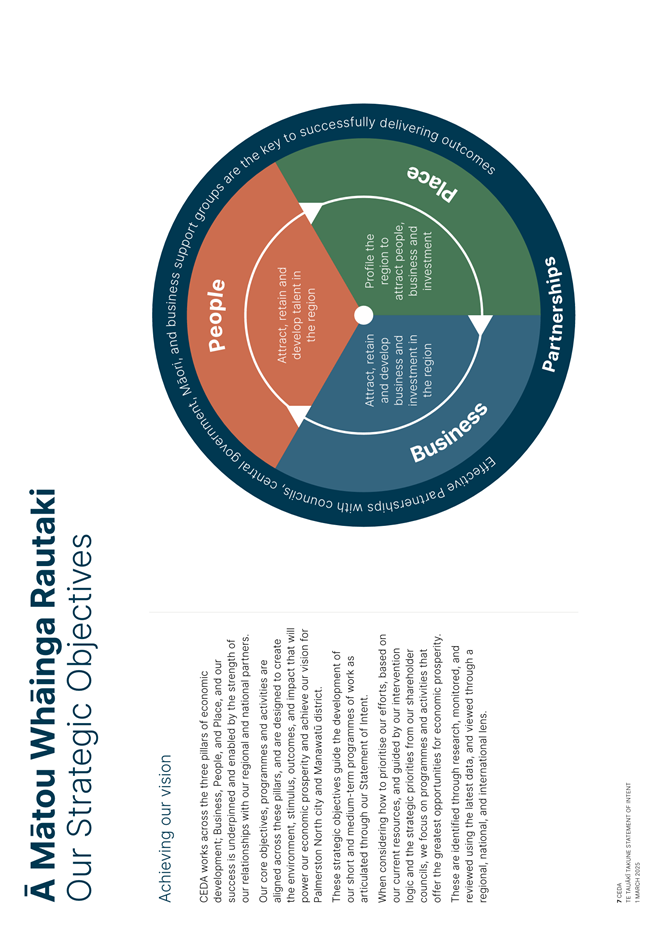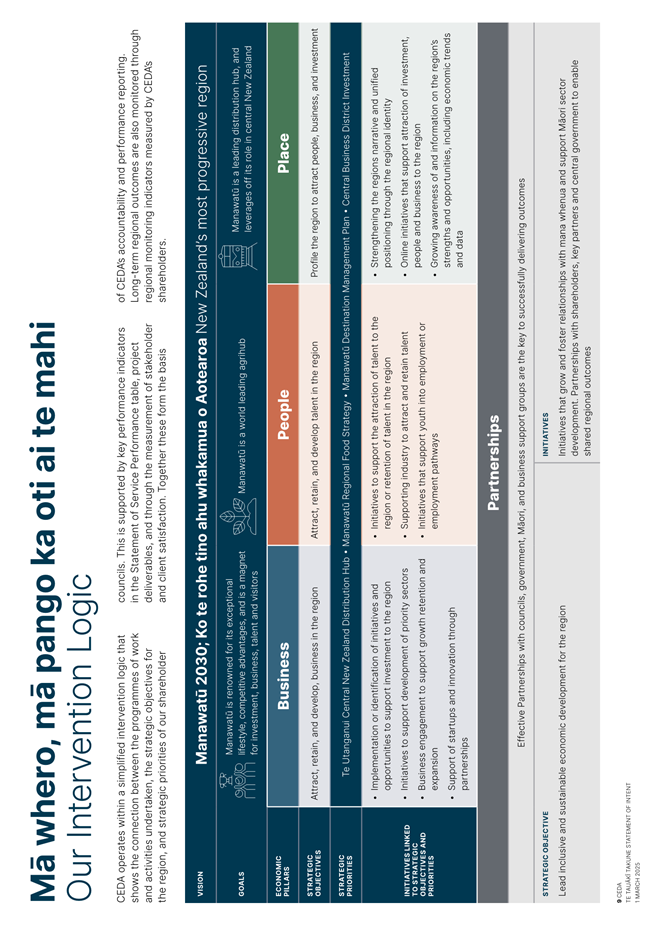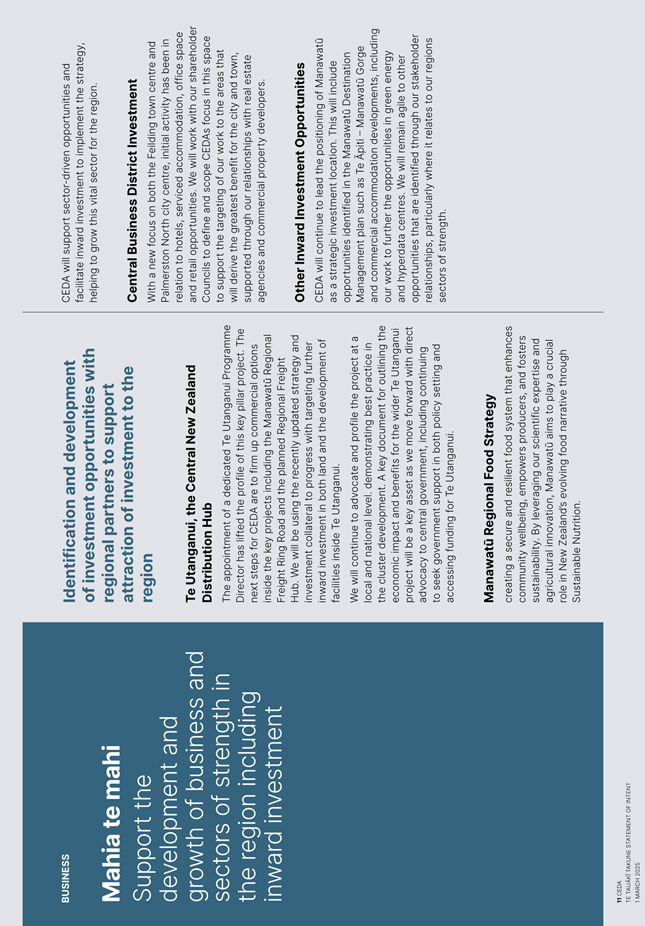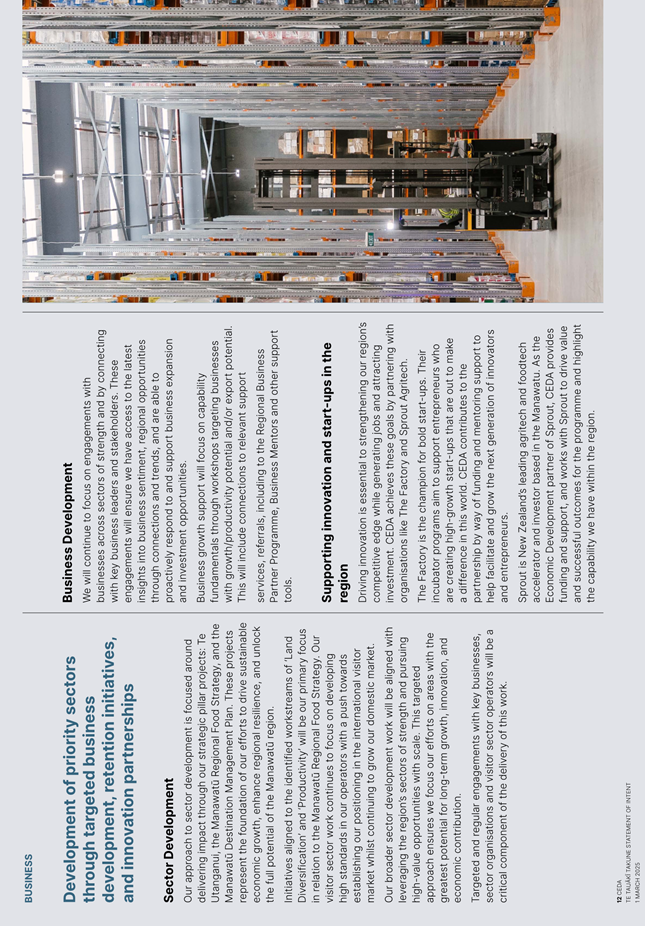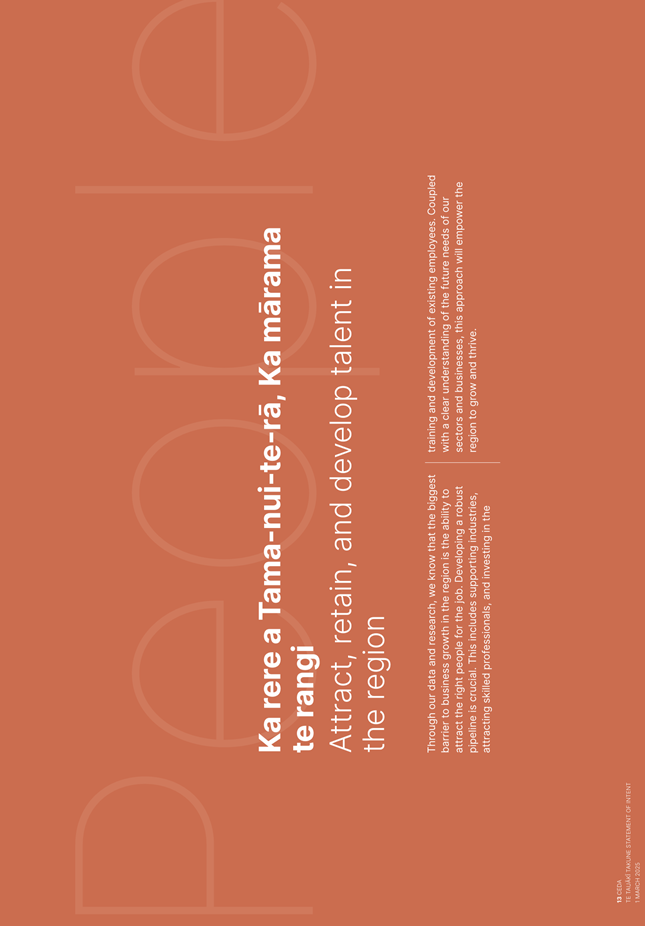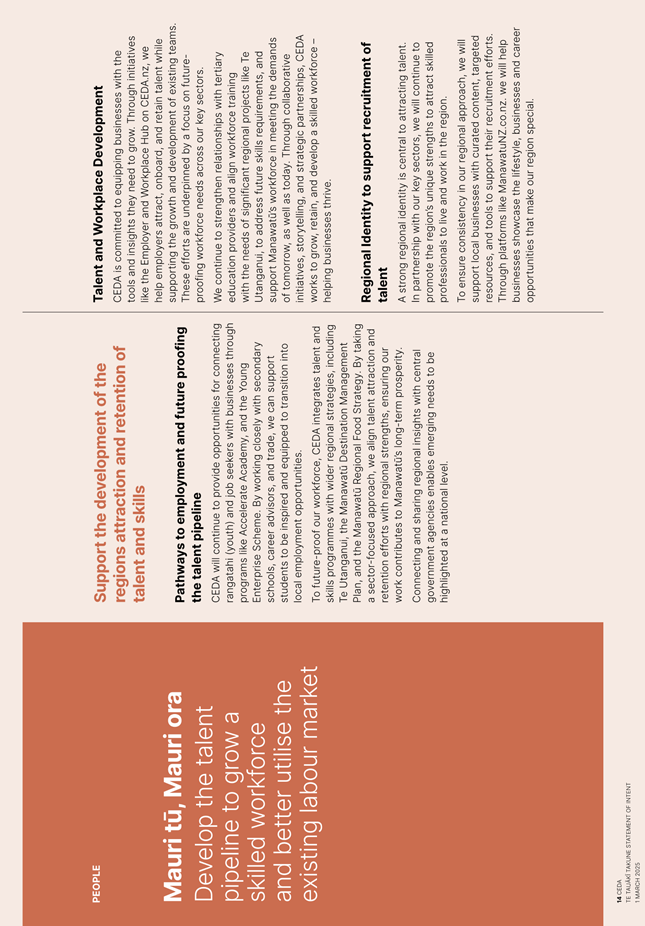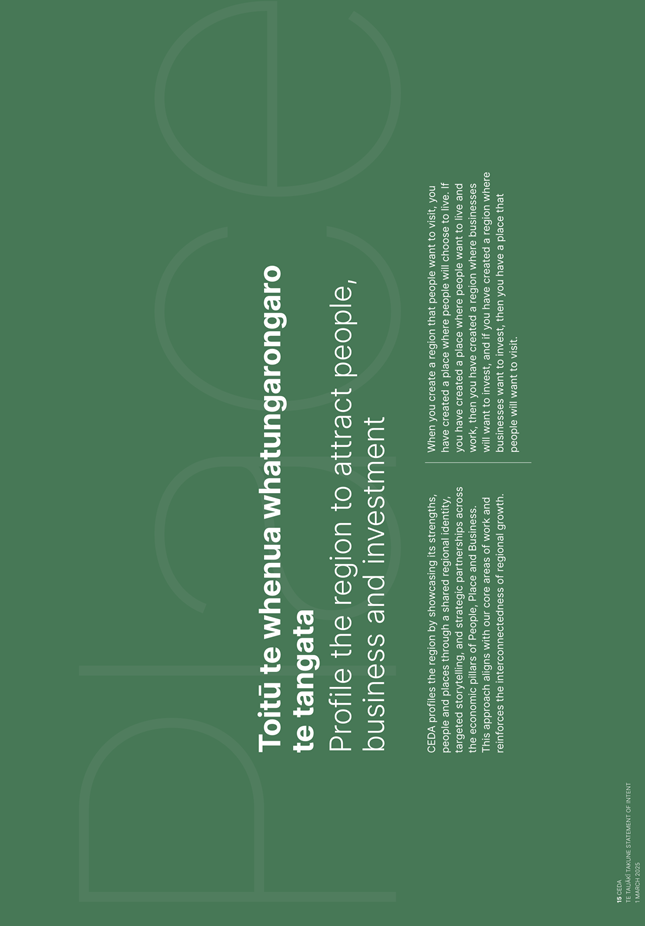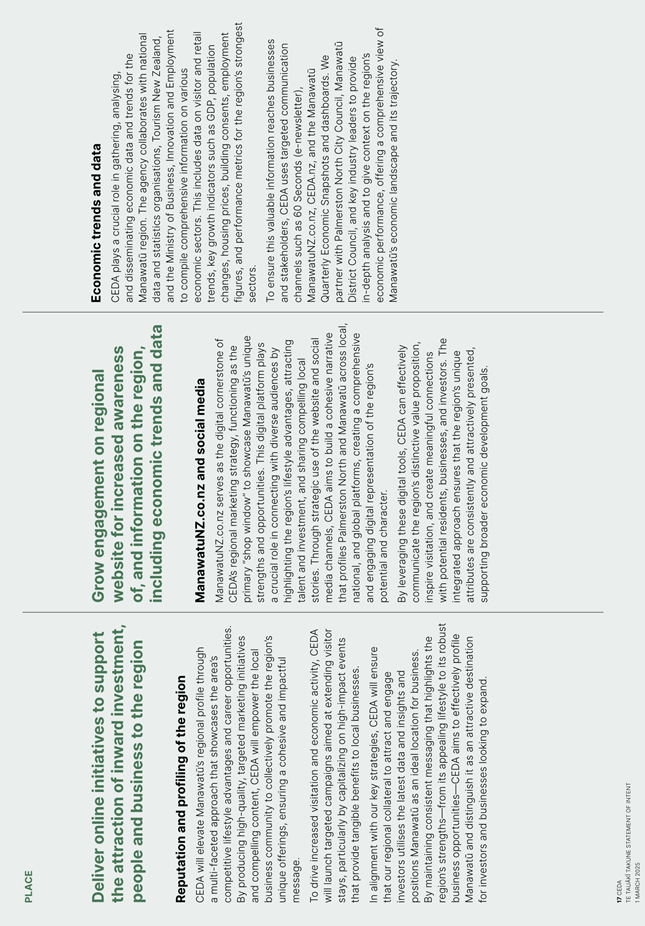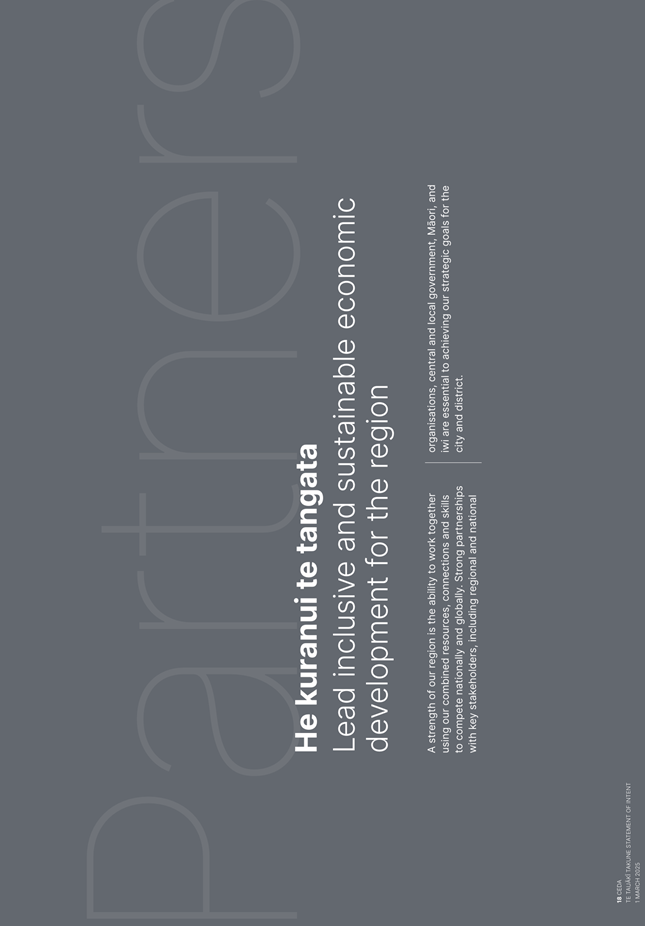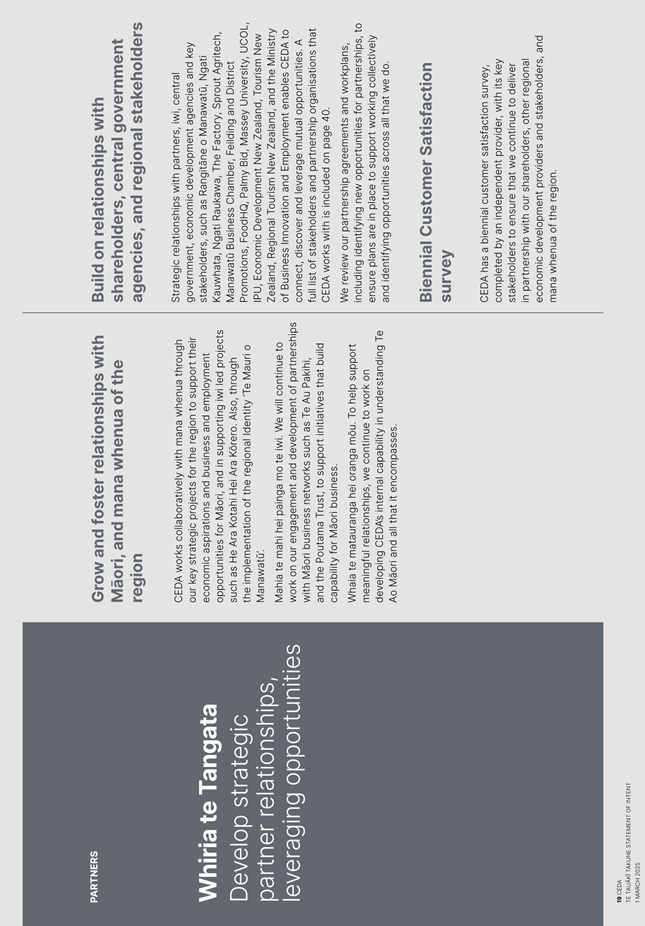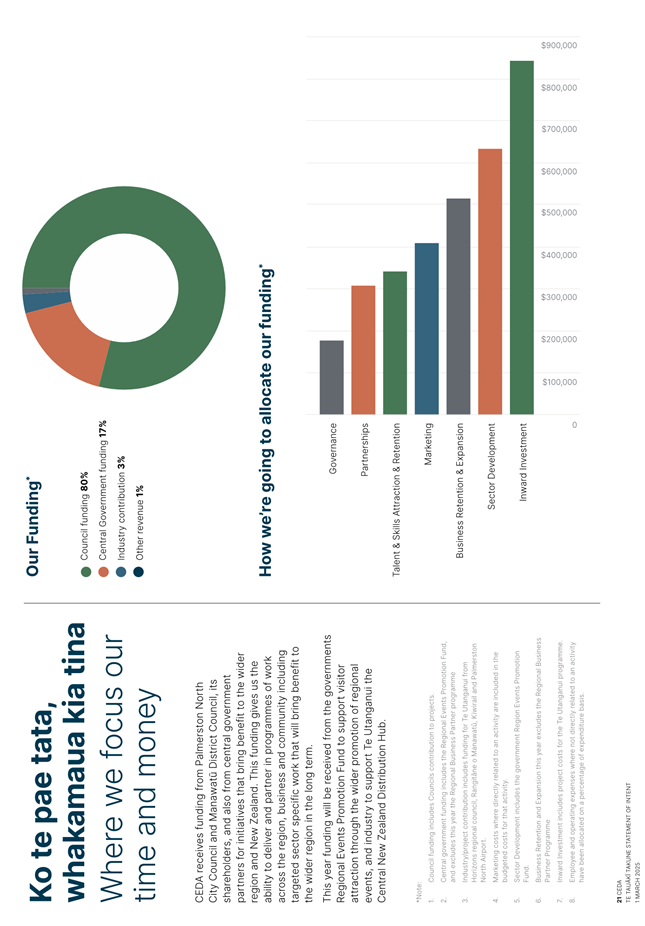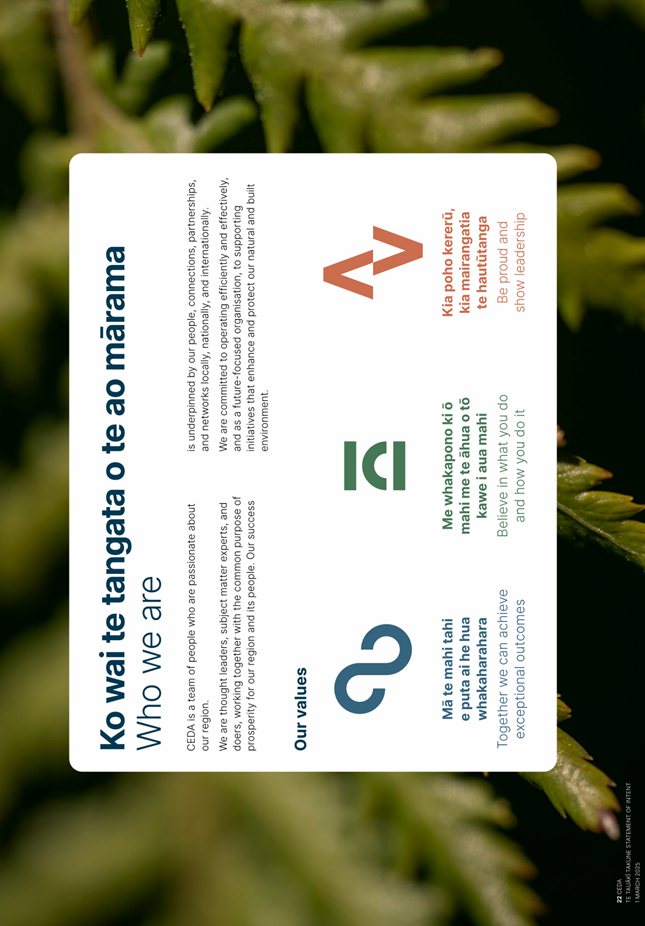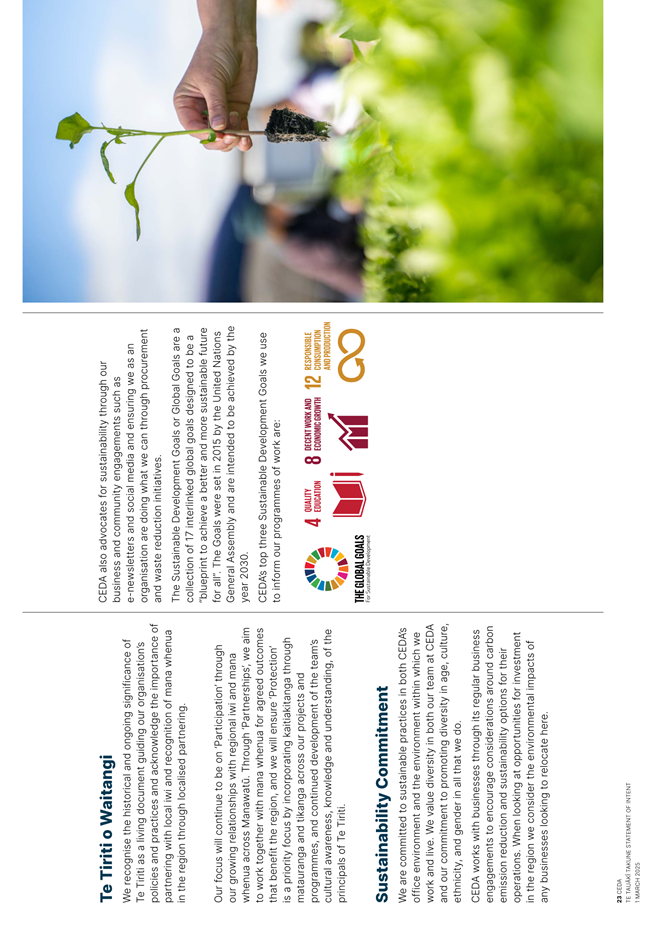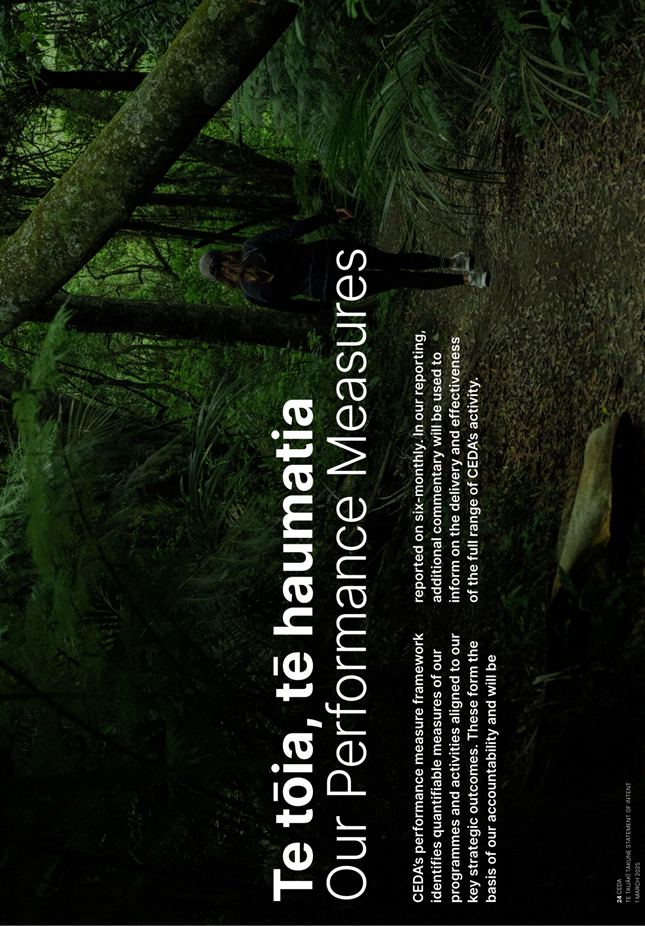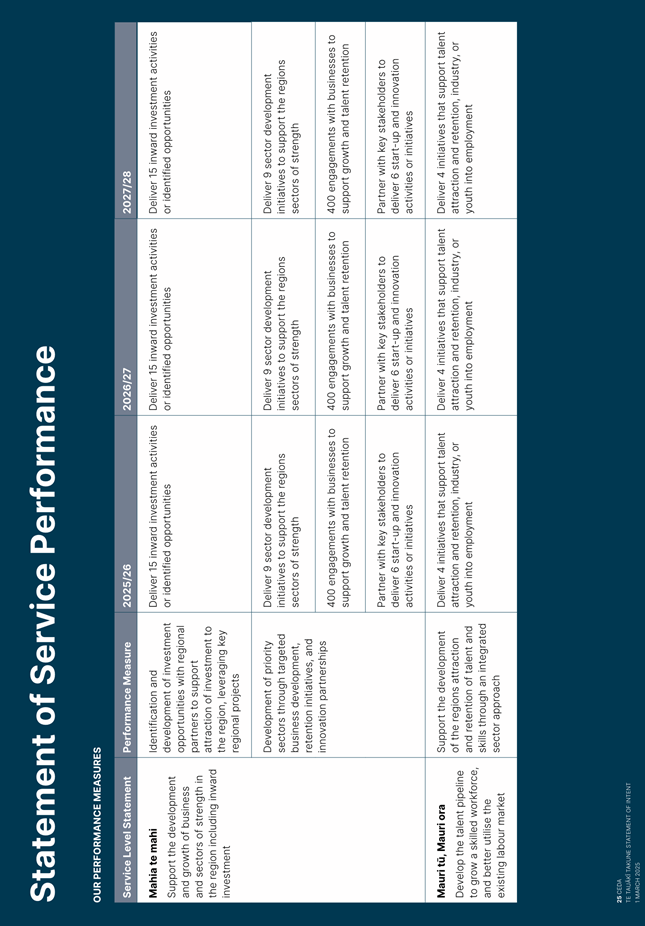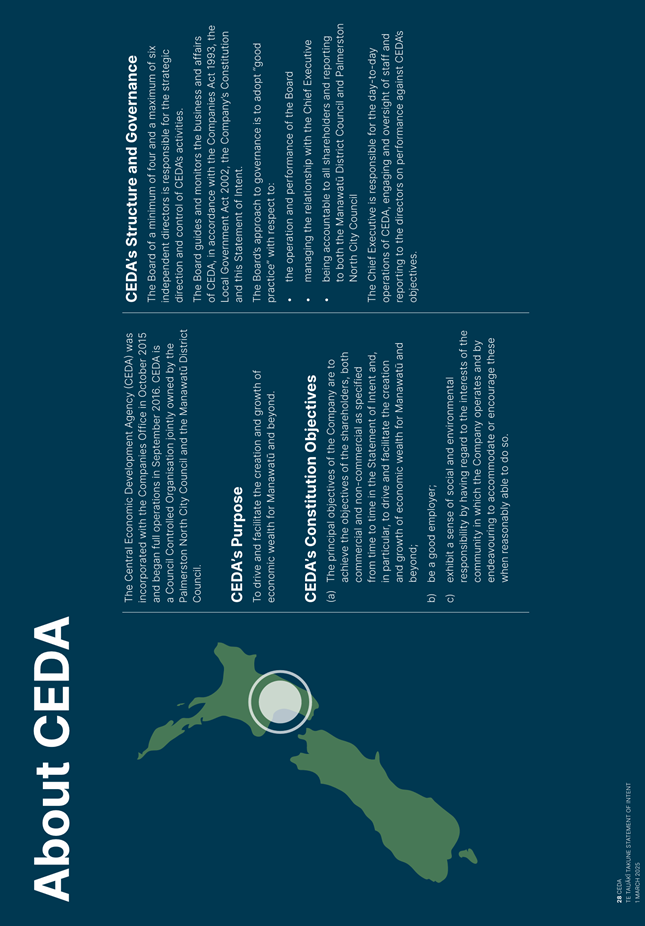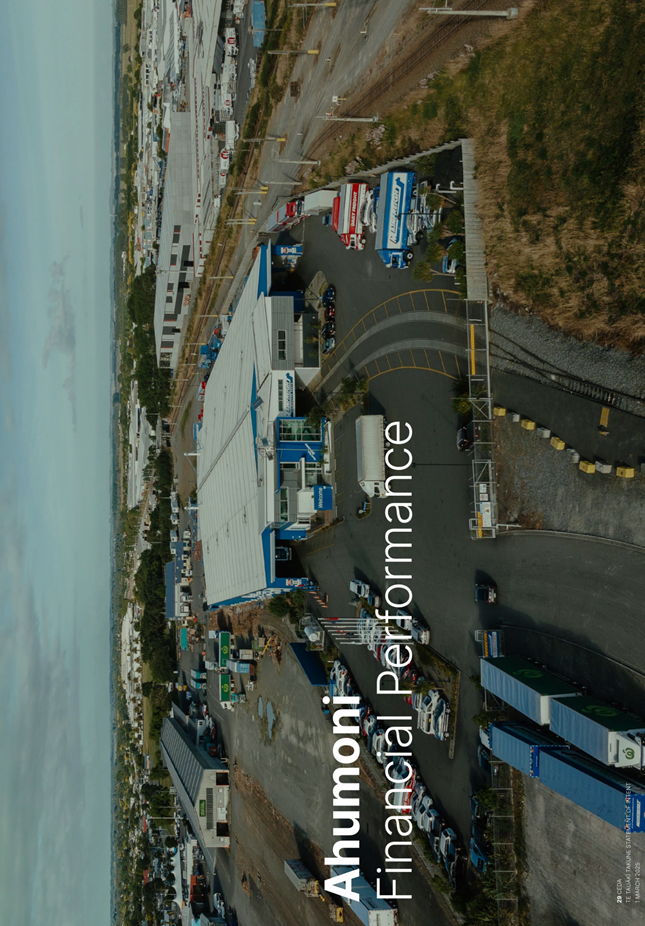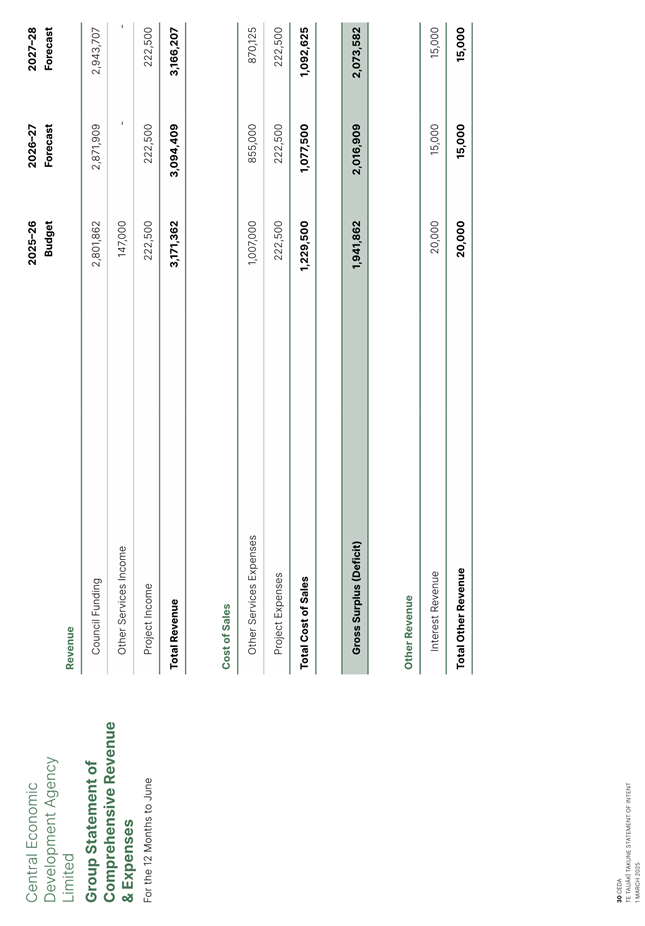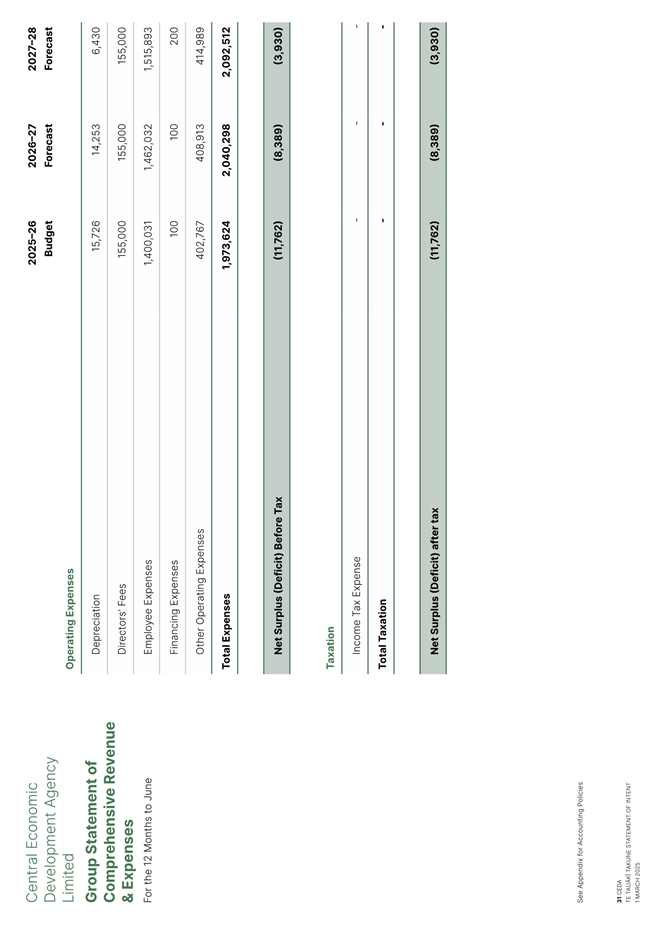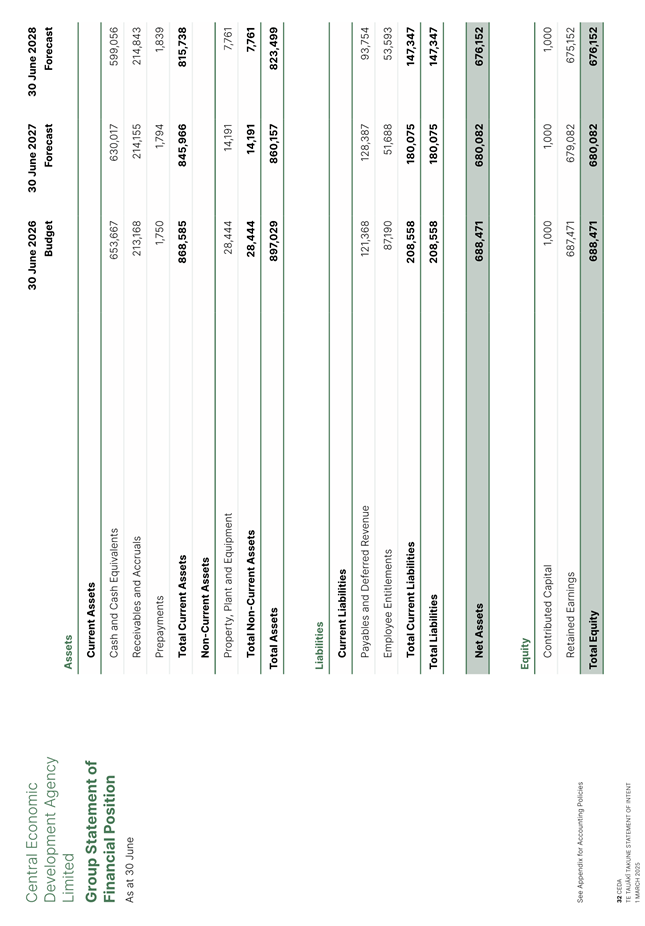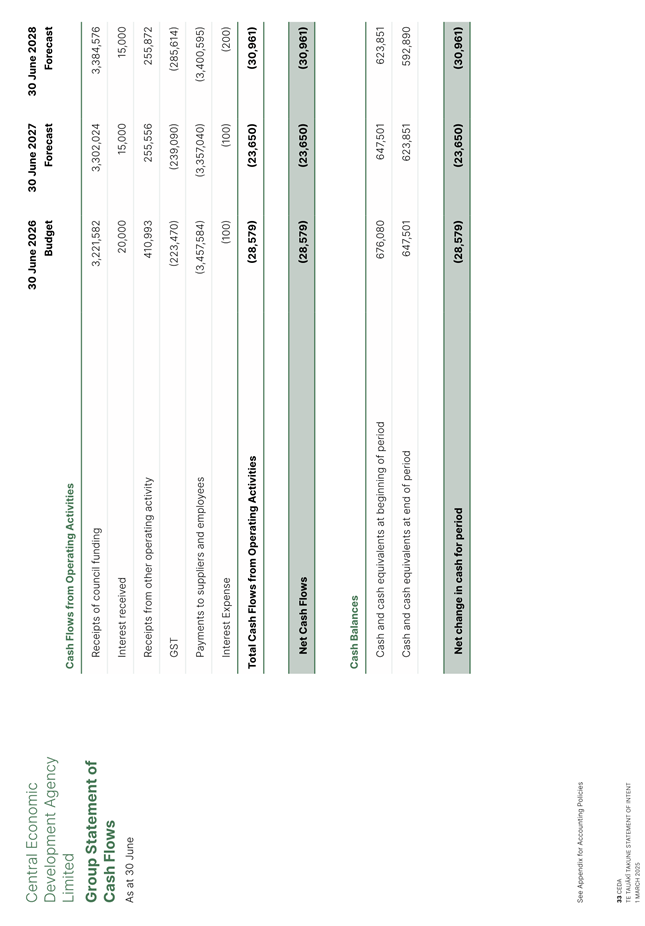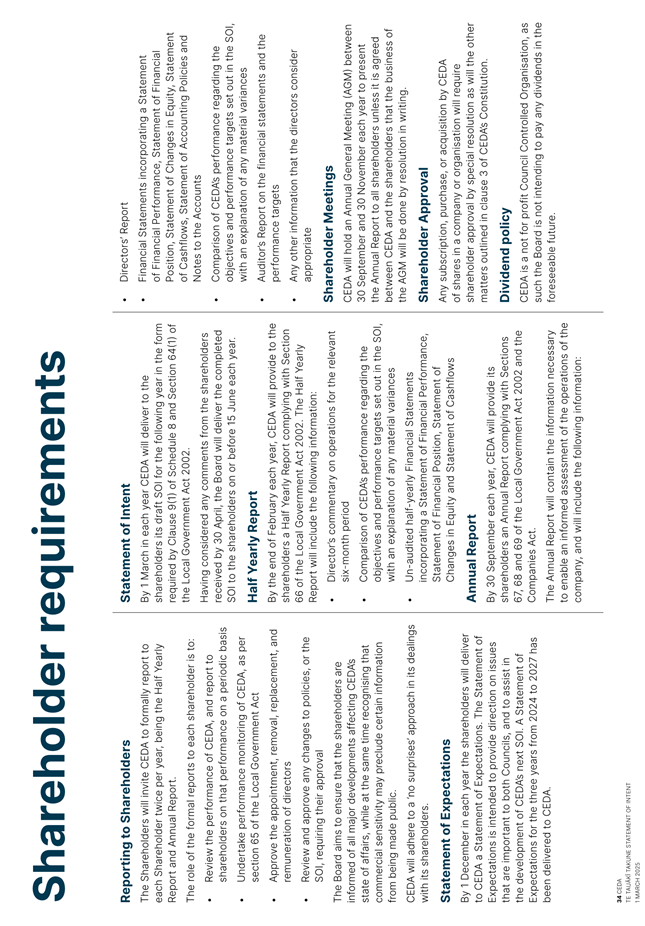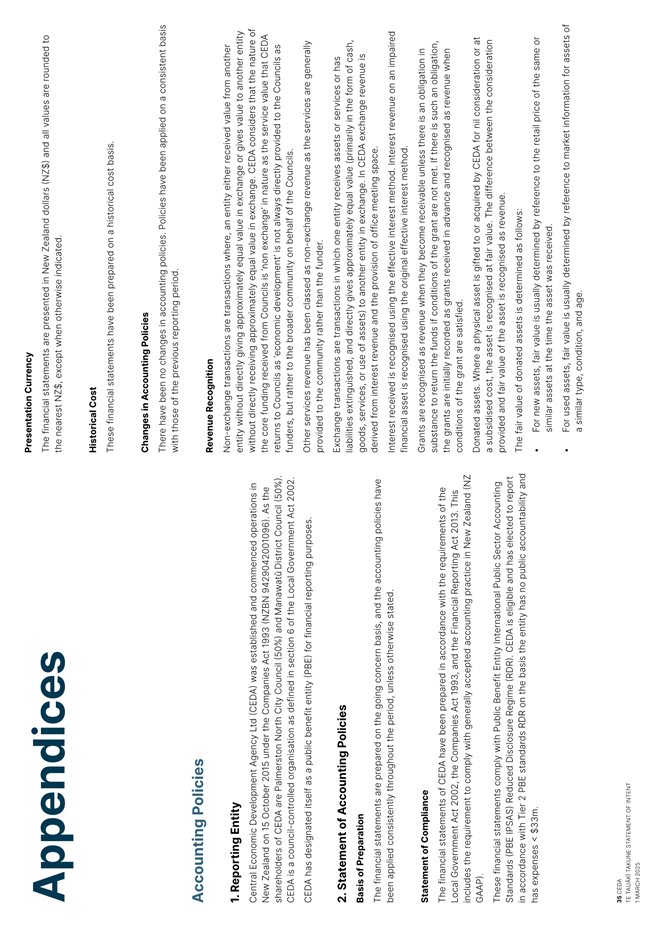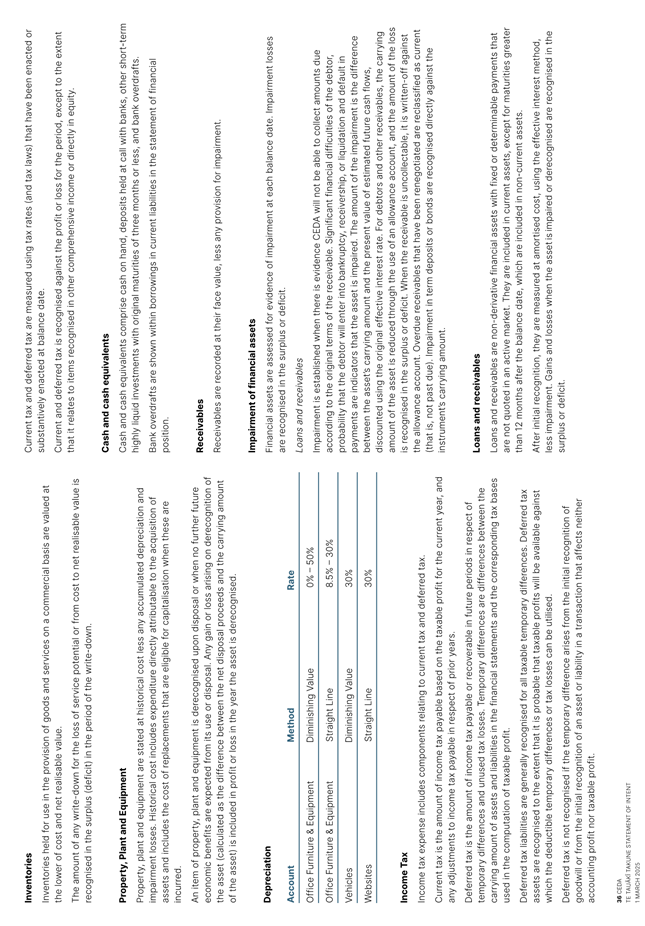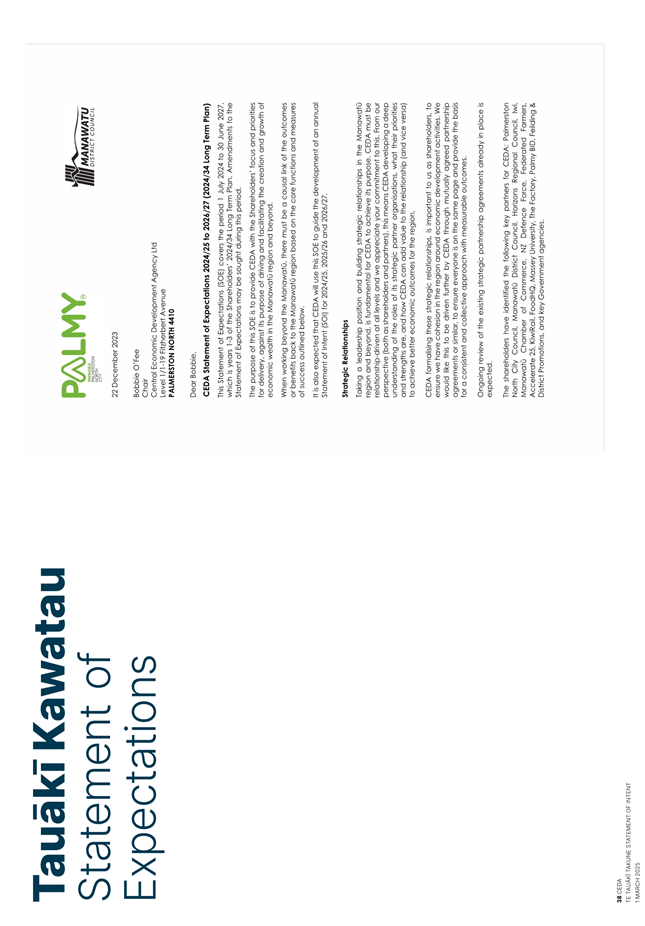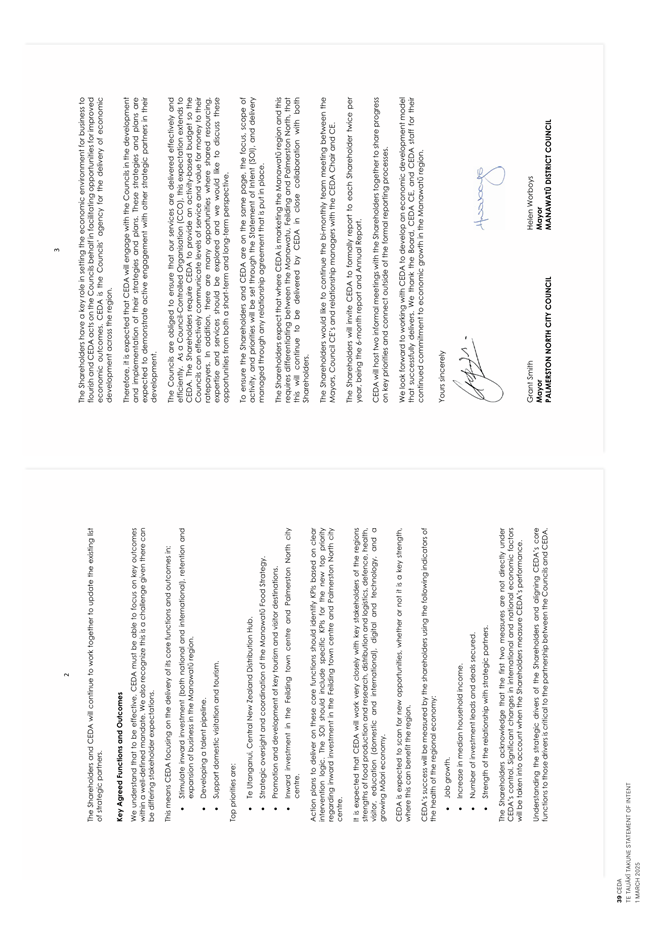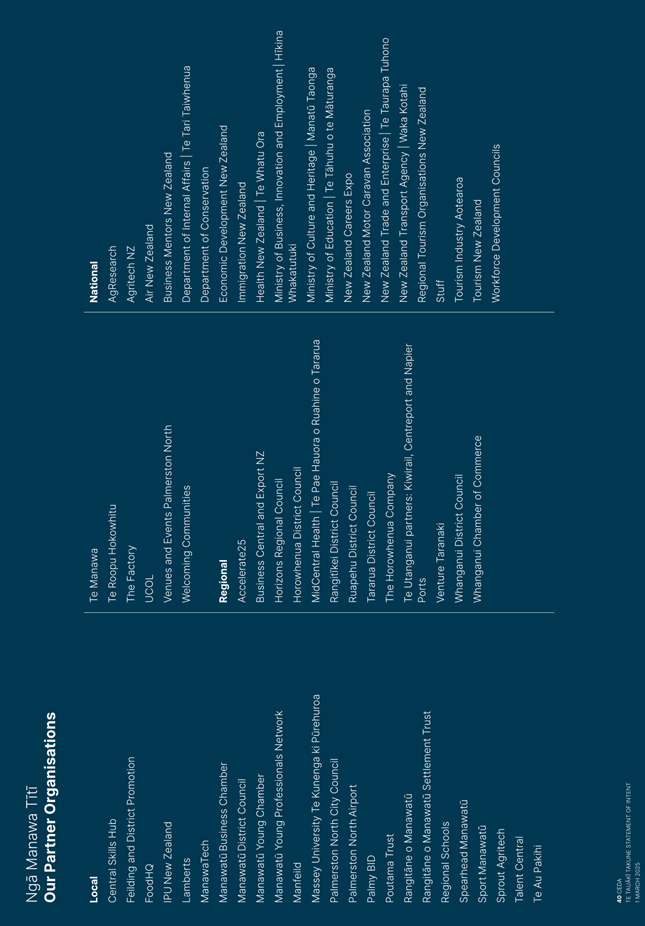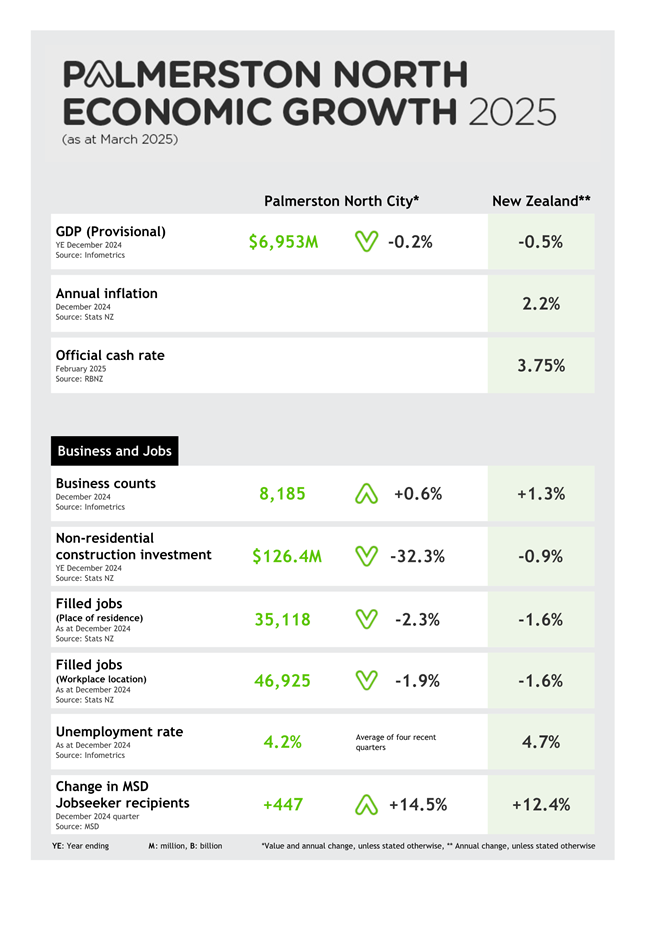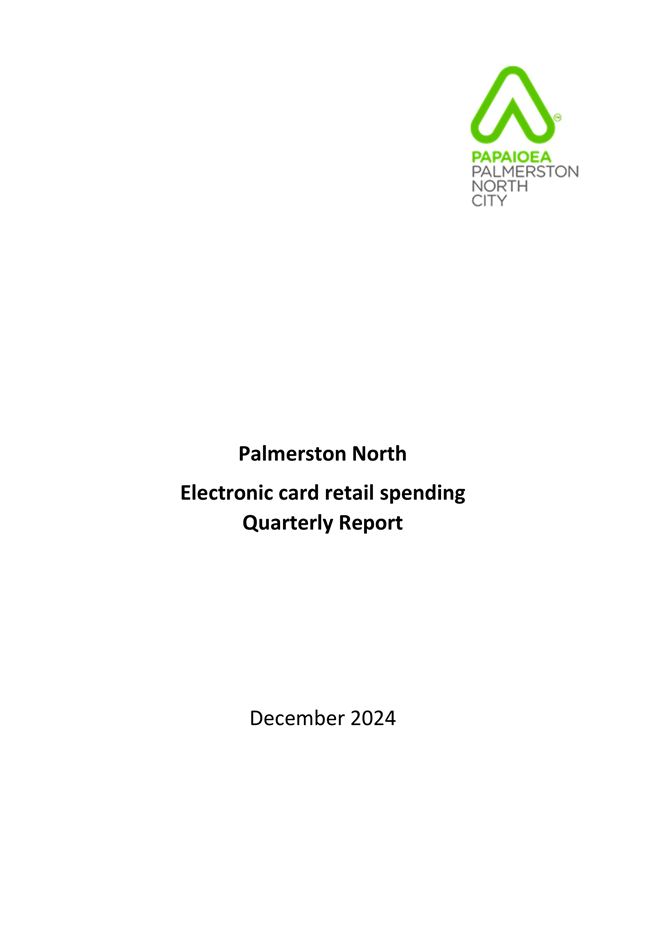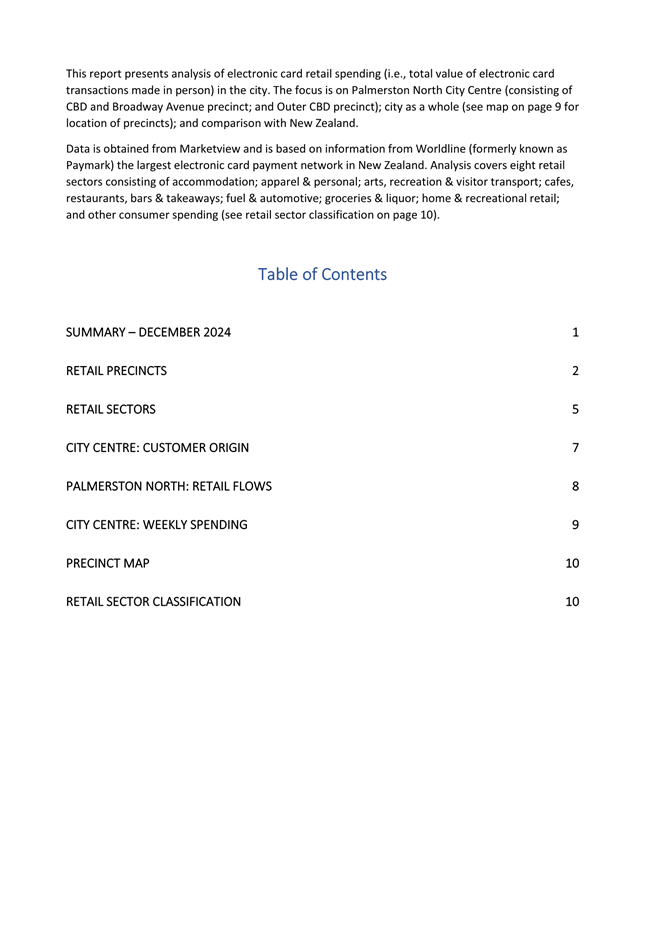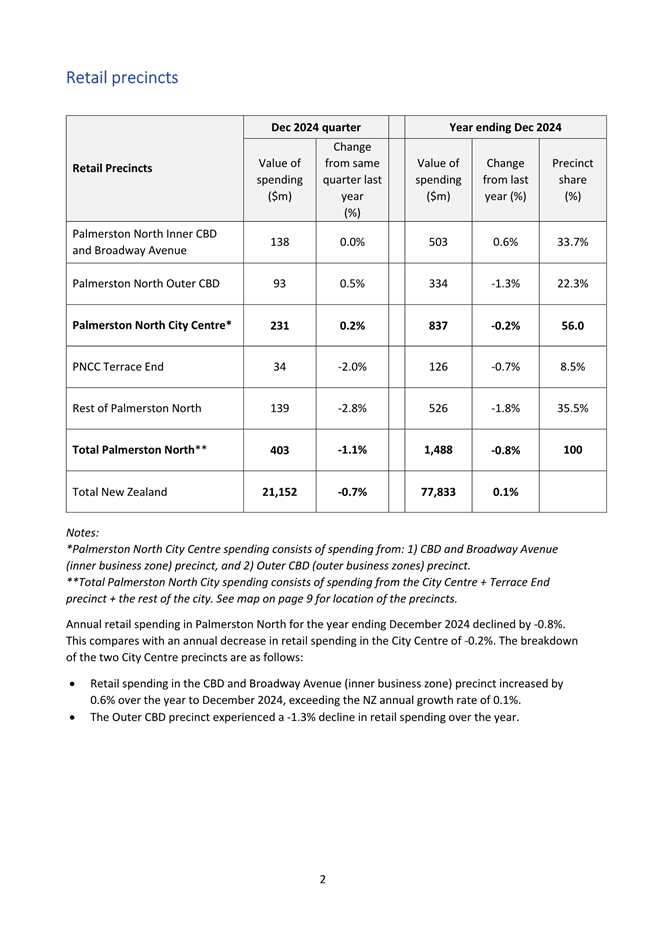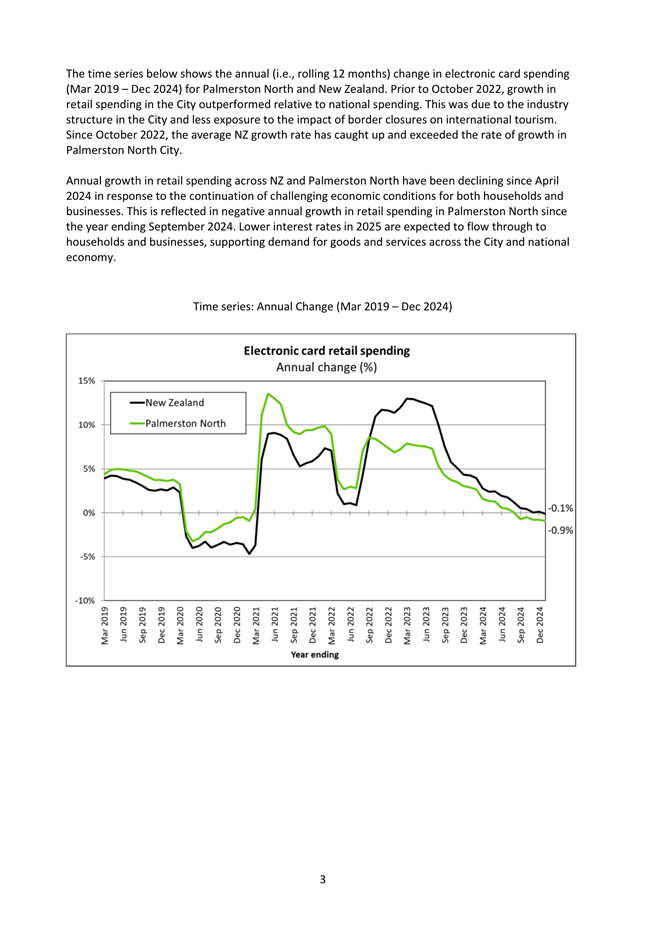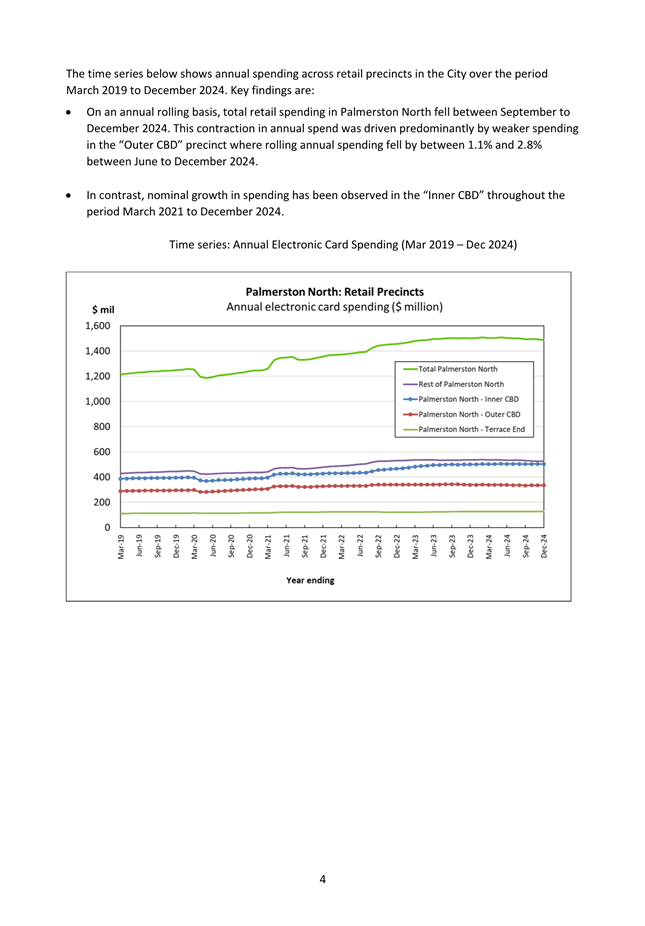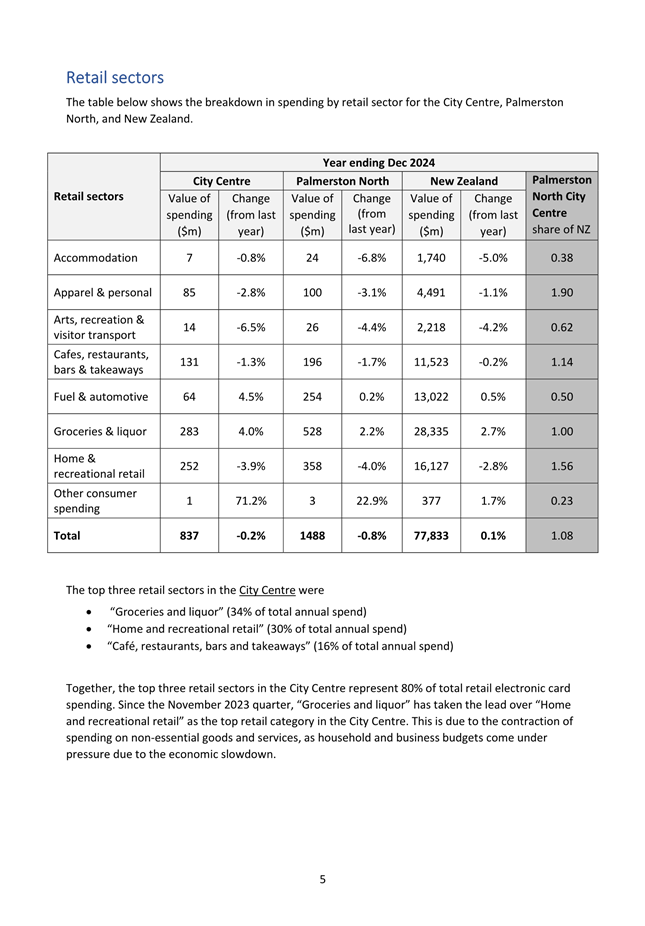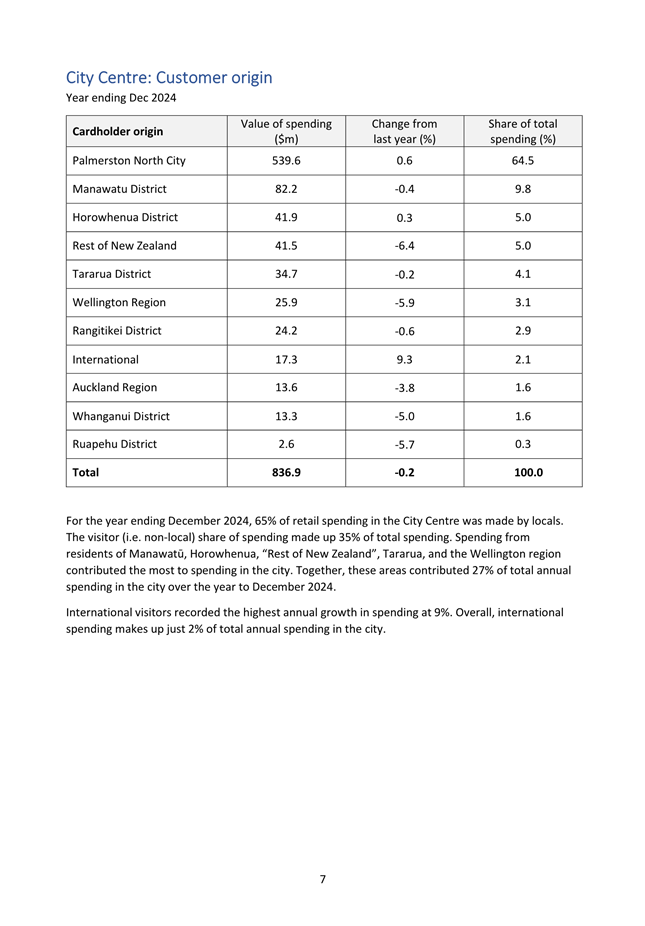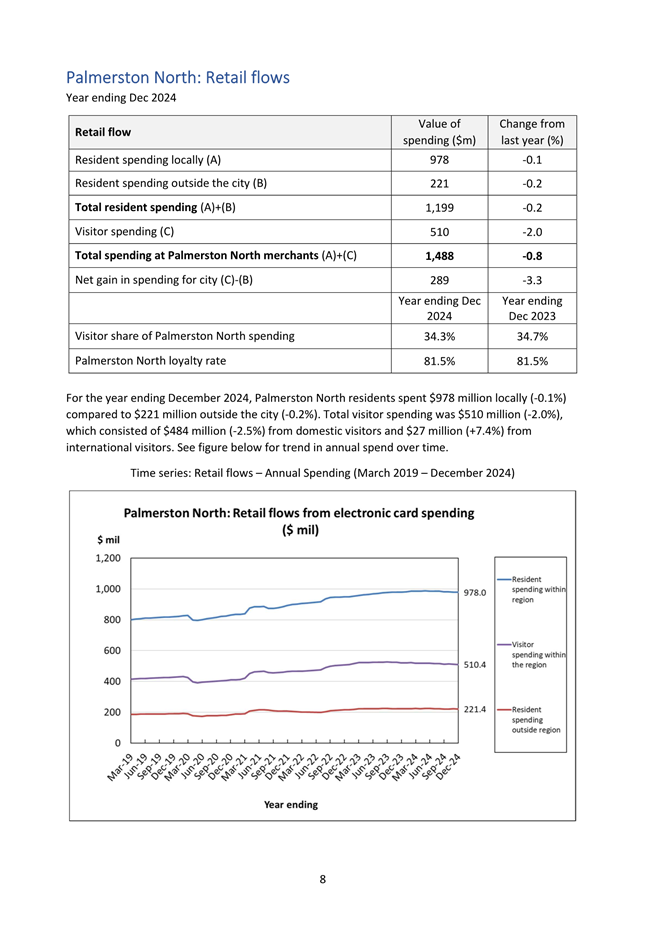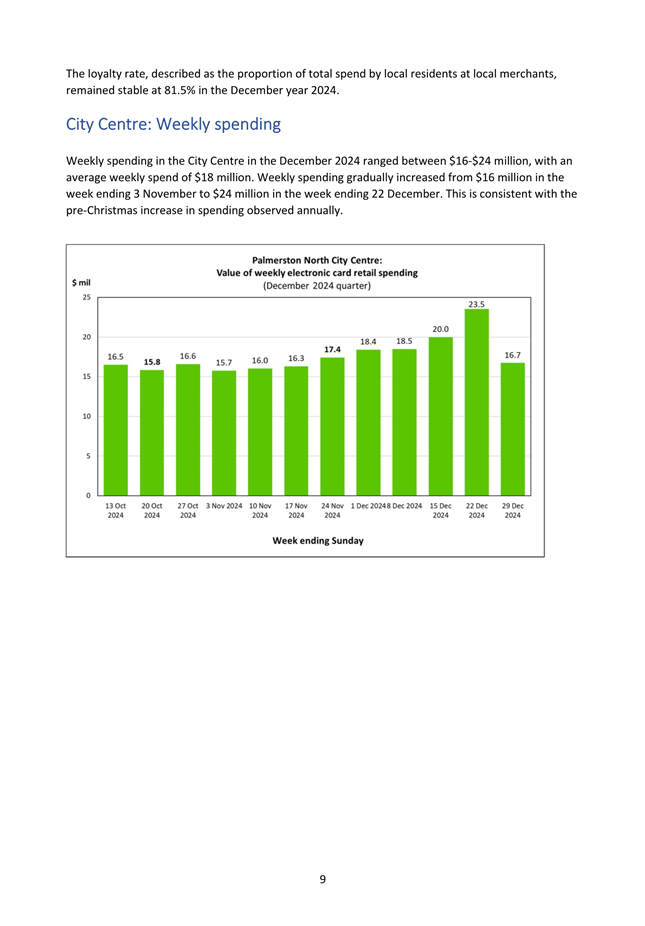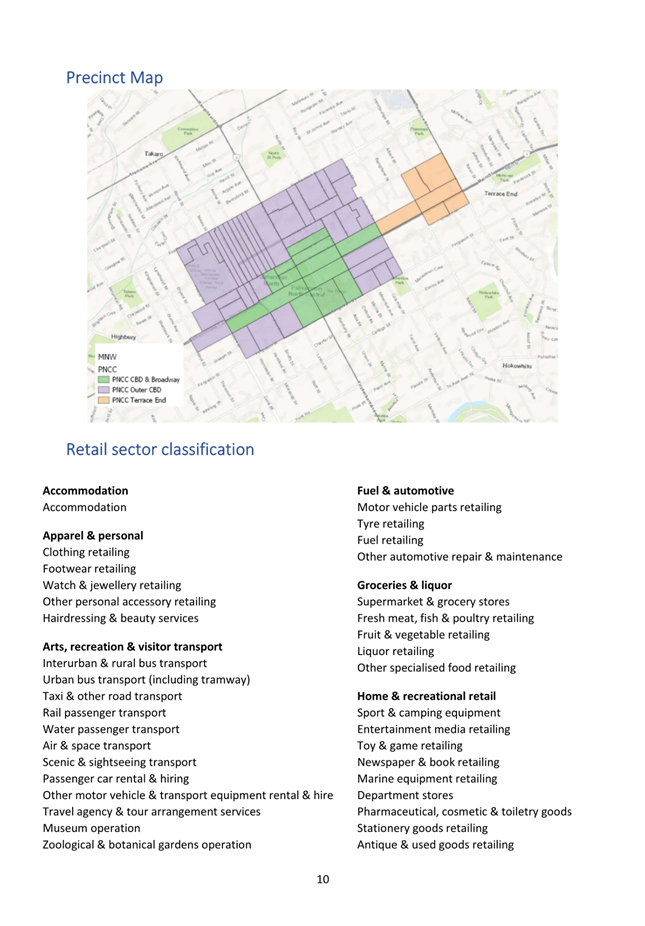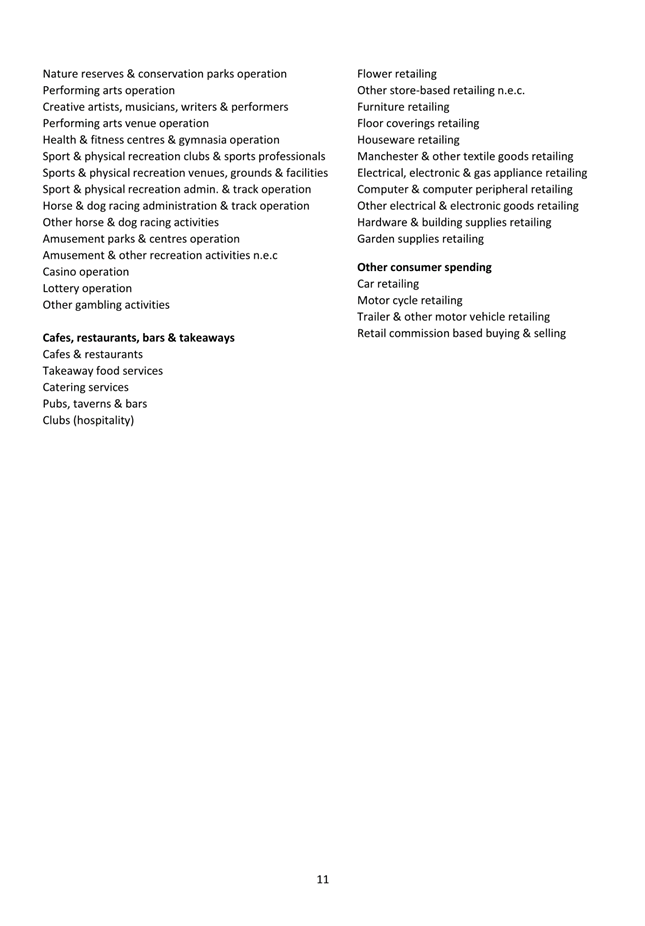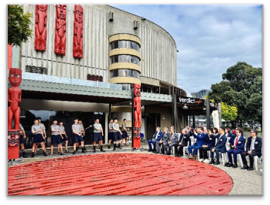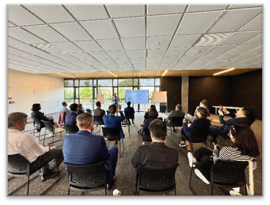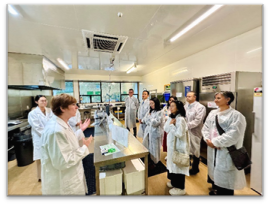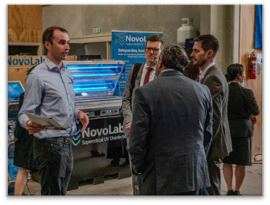Economic Growth Committee
|
Leonie
Hapeta (Chair)
|
|
William
Wood (Deputy Chair)
|
|
Grant
Smith (The Mayor)
|
|
Mark
Arnott
|
Lorna
Johnson
|
|
Brent
Barrett
|
Debi
Marshall-Lobb
|
|
Rachel
Bowen
|
Billy
Meehan
|
|
Vaughan
Dennison
|
Orphée
Mickalad
|
|
Roly
Fitzgerald
|
|
Economic Growth Committee
MEETING
9 April 2025
Order of Business
1. Karakia Timatanga
2. Apologies
3. Notification
of Additional Items
Pursuant to
Sections 46A(7) and 46A(7A) of the Local Government Official Information and
Meetings Act 1987, to receive the Chairperson’s explanation that
specified item(s), which do not appear on the Agenda of this meeting and/or the
meeting to be held with the public excluded, will be discussed.
Any additions
in accordance with Section 46A(7) must be approved by resolution with an
explanation as to why they cannot be delayed until a future meeting.
Any
additions in accordance with Section 46A(7A) may be received or referred to a
subsequent meeting for further discussion. No resolution, decision or
recommendation can be made in respect of a minor item.
4. Declarations
of Interest (if any)
Members are
reminded of their duty to give a general notice of any interest of items to be
considered on this agenda and the need to declare these interests.
5. Public
Comment
To receive
comments from members of the public on matters specified on this Agenda or, if
time permits, on other Committee matters.
6. Confirmation
of Minutes Page 7
That the minutes of the Economic Growth Committee meeting
of 20 November 2024 Part I Public be confirmed as a true and correct record.
Reports
7. Featherston
Street Safety Improvements Project Update Page 17
Memorandum, presented by Glen
O'Connor, Manager Transport and Development and Michael Bridge, Service Manager
Active Transport.
8. Draft
Parking Framework - Approval for Public Consultation Page 95
Report, presented by James Miguel,
Senior Transport Planner.
9. Street
Light Infill Page 127
Memorandum, presented by Glen
O'Connor, Group Manager - Transport and Development.
10. Central
City Transformation - Streets for People Six Monthly Update Page 131
Memorandum, presented by Glen
O'Connor, Group Manager – Transport and Development and James Miguel,
Senior Transport Planner.
11. Road
Maintenance Contract - 6 Monthly Update Page 135
Memorandum, presented by Glen
O'Connor, Manager - Transport and Development.
12. Palmerston
North Airport Limited - Interim Report for 6 months to 31 December 2024 Page 141
Memorandum, presented by Steve
Paterson, Manager - Financial Strategy.
13. Palmerston
North Airport Limited - Draft Statement of Intent for 2025/26 to 2027/28 Page 159
Memorandum, presented by Steve
Paterson, Manager - Financial Strategy.
14. Central
Economic Development Agency (CEDA): 6 month Report 1 July 2024 to 31 December
2024 and Draft Statement of Intent 2025/26 Page 213
Memorandum, presented by David Murphy,
General Manager - Strategic Planning.
15. Manawatū
Regional Freight Ring Road - Update Page 293
Memorandum, presented by James Miguel,
Senior Transport Planner.
16. Palmerston
North Quarterly Economic Update - April 2025 Page 303
Memorandum, presented by Stacey
Andrews, City Economist.
17. 6
month report on International Relations and Education Activities Page 333
Memorandum, presented by Gabrielle
Loga, Manager International Relations and Kate Harridge, International
Relations and Education Advisor.
18. Committee
Work Schedule - April 2025 Page 369
19. Karakia
Whakamutunga
20. Exclusion
of Public
|
|
To be
moved:
That the public be excluded from the following parts
of the proceedings of this meeting listed in the table below.
The general subject of each matter to be considered
while the public is excluded, the reason for passing this resolution in
relation to each matter, and the specific grounds under Section 48(1) of the
Local Government Official Information and Meetings Act 1987 for the passing
of this resolution are as follows:
|
General subject of each matter to be
considered
|
Reason for passing this resolution in
relation to each matter
|
Ground(s) under Section 48(1) for
passing this resolution
|
|
|
|
|
|
|
|
|
|
This resolution is made in reliance on Section
48(1)(a) of the Local Government Official Information and Meetings Act 1987
and the particular interest or interests protected by Section 6 or Section 7
of that Act which would be prejudiced by the holding of the whole or the
relevant part of the proceedings of the meeting in public as stated in the
above table.
Also that the persons listed below be permitted to
remain after the public has been excluded for the reasons stated.
[Add Third Parties], because of their knowledge and ability to assist the
meeting in speaking to their report/s [or other matters as specified] and
answering questions, noting that such person/s will be present at the meeting
only for the items that relate to their respective report/s [or matters as
specified].
|
Palmerston North City Council
Minutes of
the Economic Growth Committee Meeting Part I Public, held in the Council Chamber,
First Floor, Civic Administration Building, 32 The Square, Palmerston North on 20 November 2024,
commencing at 9.03am.
|
Members
Present:
|
Leonie Hapeta (in the Chair), and
Councillors William Wood, Mark Arnott, Brent Barrett, Rachel Bowen, Vaughan Dennison,
Roly Fitzgerald, Debi Marshall-Lobb, Billy Meehan and Orphée Mickalad.
|
|
Non Members:
|
Councillor Lew Findlay, Councillor
Patrick Handcock and Councillor Karen Naylor.
|
|
Apologies:
|
The Mayor (Grant Smith) (on Council
business), Councillor Lorna Johnson (late arrival), Councillor Kaydee Zabelin
(late arrival)
|
Councillor Lorna
Johnson entered the meeting at 9.10am during consideration of clause 57. She
was not present for clauses 55 and 56.
Councillor Kaydee Zabelin entered the meeting
at 9.06am during consideration of clause 57. She was not present when the
meeting resumed, at 11.38am; entering the meeting at 11.41am, after
consideration of clause 62. She left the meeting at 3.51pm after consideration
of clause 66. She was not present for clauses 55, 56, 62, 67 to 70.
Councillor Karen Naylor left the meeting at
12.11pm during consideration of clause 63. She entered the meeting again at
12.40pm during consideration of clause 64. She was not present for clause 63.
Councillor Lew Findlay left the meeting at
4.13pm after consideration of clause 67. He was not present from clauses 68 to
70.
Councillor Billy Meehan left the meeting at
4.29pm before consideration of clause 69. He was not present for clauses 69 and
70.
|
|
Karakia
Timatanga
|
|
|
Councillor
Roly Fitzgerald opened the meeting with karakia.
|
|
55-24
|
Apologies
|
|
|
Moved Leonie Hapeta, seconded William Wood.
The
COMMITTEE RESOLVED
1. That
the Committee receive the apologies.
|
|
|
Clause 55-24 above was carried 13 votes to 0, the voting being as
follows:
For:
Councillors Leonie Hapeta, William Wood, Mark Arnott, Brent Barrett,
Rachel Bowen, Vaughan Dennison, Roly Fitzgerald, Debi Marshall-Lobb, Billy
Meehan, Orphée Mickalad, Lew Findlay, Patrick Handcock and Karen
Naylor.
|
|
56-24
|
Public
Comment
|
|
|
Alice
Williamson, representing The Greasy Chain, made a public comment in
support of Item 17 - Featherston Street Safety Improvements Project Update.
She encouraged the Council to finalise the project and keep extending the
cycleway in the future.
|
|
|
Moved Leonie Hapeta, seconded William Wood.
The
COMMITTEE RESOLVED
1. That the Committee
receive the public comment for information.
|
|
|
Clause 56-24 above was carried 13 votes to 0, the voting being as
follows:
For:
Councillors Leonie Hapeta, William Wood, Mark Arnott, Brent Barrett,
Rachel Bowen, Vaughan Dennison, Roly Fitzgerald, Debi Marshall-Lobb, Billy
Meehan, Orphée Mickalad, Lew Findlay, Patrick Handcock and Karen
Naylor.
|
|
57-24
|
Petition
- Streets Ahead Palmerston North
James Irwin, representative
of Streets Ahead Palmerston North presented to the Committee.
James presented a Petition in
support of Council completing the cycleway on Featherston Street. He
summarised the benefits this project generated for residents who walk, cycle
and use public transport. Street Ahead Palmerston North, requested that
Council finish the cycleway on Featherston Street and continue to install
cycleways in the city.
Councillor
Kaydee Zabelin entered the meeting at 9.06am.
Councillor
Lorna Johnson entered the meeting at 9.10am.
|
|
|
Moved
Leonie Hapeta, seconded William Wood.
The COMMITTEE RESOLVED
1. That the Committee receive the petition for information.
|
|
|
Clause 57-24 above was
carried 15 votes to 0, the voting being as follows:
For:
Councillors Leonie Hapeta,
William Wood, Mark Arnott, Brent Barrett, Rachel Bowen, Vaughan Dennison,
Roly Fitzgerald, Lorna Johnson, Debi Marshall-Lobb, Billy Meehan,
Orphée Mickalad, Lew Findlay, Patrick Handcock, Karen Naylor and
Kaydee Zabelin.
|
|
58-24
|
Presentation
- The Factory
Nick Gains, General Manager
of The Factory presented to the Committee.
He summarised the activities,
and projects worked on during the year, and highlighted several
businesses The Factory had assisted in 2024.
|
|
|
Moved
Leonie Hapeta, seconded William Wood.
The COMMITTEE RESOLVED
1. That the Committee receive the presentation for
information.
|
|
|
Clause 58-24 above was
carried 15 votes to 0, the voting being as follows:
For:
Councillors Leonie Hapeta,
William Wood, Mark Arnott, Brent Barrett, Rachel Bowen, Vaughan Dennison,
Roly Fitzgerald, Lorna Johnson, Debi Marshall-Lobb, Billy Meehan,
Orphée Mickalad, Lew Findlay, Patrick Handcock, Karen Naylor and
Kaydee Zabelin.
|
|
59-24
|
Confirmation
of Minutes
Councillor
Vaughan Dennison asked for his vote to be recorded in favour for clause 49-24.
|
|
|
Moved
Leonie Hapeta, seconded William Wood.
The COMMITTEE RESOLVED
That the minutes of the Economic Growth Committee meeting
of 18 September 2024 Part I Public and Part II Confidential (as amended) be
confirmed as a true and correct record.
|
|
|
Clause 59-24 above was
carried 13 votes to 2, the voting being as follows:
For:
Councillors Leonie Hapeta,
William Wood, Mark Arnott, Brent Barrett, Rachel Bowen, Roly Fitzgerald,
Lorna Johnson, Debi Marshall-Lobb, Orphée Mickalad, Lew Findlay,
Patrick Handcock, Karen Naylor and Kaydee Zabelin.
Against:
Councillors Vaughan
Dennison and Billy Meehan.
|
|
60-24
|
International
Trip to China, April 2024, and International Relations and Education - 6
Monthly Report
Memorandums, presented
by Councillor Debi Marshall-Lobb and Gabrielle Loga, Manager
International Relations.
Items 9 and 10 were taken
together.
|
|
|
Moved
Leonie Hapeta, seconded William Wood.
The COMMITTEE RESOLVED
1. That the
Committee receive the memorandum titled ‘International visit to China,
April 2024’ presented on 20 November 2024.
2.
That the Committee receive the report
titled ‘International Relations and Education – 6 Monthly
Report’ presented on 20 November 2024.
|
|
|
Clause 60-24 above was
carried 14 votes to 1, the voting being as follows:
For:
Councillors Leonie Hapeta,
William Wood, Mark Arnott, Brent Barrett, Rachel Bowen, Vaughan Dennison,
Roly Fitzgerald, Lorna Johnson, Debi Marshall-Lobb, Billy Meehan,
Orphée Mickalad, Lew Findlay, Patrick Handcock and Kaydee Zabelin.
Against:
Councillor Karen Naylor.
|
|
61-24
|
Palmerston
North Quarterly Economic Update - September 2024
Memorandum, presented by
Stacey Andrews, City Economist.
|
|
|
Moved
Leonie Hapeta, seconded William Wood.
The COMMITTEE RESOLVED
1. That the
Committee receive the Palmerston North Quarterly Economic Update –
September 2024, including:
a. Palmerston
North Economic Growth Indicators - September 2024 (Attachment 1), and
b. Palmerston
North Quarterly Economic Card Spending Report - June 2024 (Attachment 2),
presented to the Economic
Growth Committee on 20 November 2024.
|
|
|
Clause 61-24 above was
carried 15 votes to 0, the voting being as follows:
For:
Councillors Leonie Hapeta,
William Wood, Mark Arnott, Brent Barrett, Rachel Bowen, Vaughan Dennison,
Roly Fitzgerald, Lorna Johnson, Debi Marshall-Lobb, Billy Meehan,
Orphée Mickalad, Lew Findlay, Patrick Handcock, Karen Naylor and
Kaydee Zabelin.
|
|
62-24
|
Road
Maintenance Contract - 6 Monthly Update and Street Light Infill
Memorandums, presented by
Glen O'Connor, Manager - Transport and Development.
Items 12 and 13 were taken
together.
Elected Members discussed
referring a street lighting survey to the Annual Budget process. A motion was
moved to refer the Street Lighting survey to the Annual Budget 2025-26
process, as pushing the survey to the 2026-27 year was considered too
much of a delay.
An additional motion was
moved to refer a programme to begin upgrading the streets lighting on the streets
listed in the Report - Progress Update on Programme
1367 (City-wide - Street Light Infill), received by the Economic
Growth Committee on 19 June 2024 to the Annual Budget 2025-26 process.
|
|
|
Moved
Lorna Johnson, seconded Patrick Handcock.
Note:
On
an amendment (to recommendation 2): “That a budget of $120,000 to
support a Street Lighting survey be referred to the Annual Budget 2026-27 2025-26 process.
The
amendment was carried 10 votes to 5,
the voting being as follows
For:
Councillors Leonie Hapeta,
William Wood, Brent Barrett, Rachel Bowen, Vaughan Dennison, Lorna Johnson,
Debi Marshall-Lobb, Billy Meehan, Patrick Handcock and Kaydee Zabelin.
Against:
Councillors Mark Arnott,
Roly Fitzgerald, Orphée Mickalad, Lew Findlay and Karen Naylor.
|
|
|
The meeting was adjourned at 11.19am
The meeting resumed at 11.38am
Councillor Kaydee Zabelin was not present when the
meeting resumed.
|
|
|
Moved Leonie Hapeta, seconded William Wood.
The
COMMITTEE RESOLVED
1. That
the Committee receive the memorandum titled ‘Road Maintenance Contract
- 6 Monthly Update’ presented to the Economic Growth Committee on 20
November 2024.
1. That
the Economic Growth Committee receive the report Street Light Infill
presented on 20 November 2024.
|
|
|
Clause 62-24 above was carried 14 votes to 0, the voting being as
follows:
For:
Councillors Leonie Hapeta, William Wood, Mark Arnott, Brent Barrett,
Rachel Bowen, Vaughan Dennison, Roly Fitzgerald, Lorna Johnson, Debi
Marshall-Lobb, Billy Meehan, Orphée Mickalad, Lew Findlay, Patrick
Handcock and Karen Naylor.
|
|
|
Moved
Lorna Johnson, seconded Patrick Handcock.
The COMMITTEE RESOLVED
2. That a
budget of $120,000 to support a Street Lighting survey be referred to the
Annual Budget 2025-26 process.
|
|
|
Clause 62-24 above was
carried 9 votes to 5, the voting being as follows:
For:
Councillors Leonie Hapeta,
Brent Barrett, Rachel Bowen, Vaughan Dennison, Roly Fitzgerald, Lorna
Johnson, Debi Marshall-Lobb, Billy Meehan and Patrick Handcock.
Against:
Councillors William Wood,
Mark Arnott, Orphée Mickalad, Lew Findlay and Karen Naylor.
|
|
|
Moved
William Wood, seconded Orphée Mickalad.
The COMMITTEE RESOLVED
3. That a
programme to begin upgrading the street lighting on the already identified
streets (listed in the Roading Report to the Economic Growth Committee in
June 2024) be referred to the Annual Budget 2025-2026 process.
|
|
|
Clause 62-24 above was
carried 14 votes to 0, the voting being as follows:
For:
Councillors Leonie Hapeta,
William Wood, Mark Arnott, Brent Barrett, Rachel Bowen, Vaughan Dennison,
Roly Fitzgerald, Lorna Johnson, Debi Marshall-Lobb, Billy Meehan,
Orphée Mickalad, Lew Findlay, Patrick Handcock and Karen Naylor.
|
Councillor Kaydee Zabelin entered the meeting at 11.41am
|
63-24
|
Palmerston
North Airport Limited - Annual report for 12 months ended 30 June 2024 &
Instructions relating to Annual Meeting
Memorandum, presented by David
Lanham, Chief Executive, Shelly Mitchell Jenkins, Chair Audit & Risk
Committee and Jonathon Baker, Chief Financial Officer, Palmerston North
Airport Limited.
Councillor Karen Naylor
left the meeting at 12.11pm.
|
|
|
Moved
Leonie Hapeta, seconded William Wood.
The COMMITTEE RESOLVED
1. That the Committee receive the Annual Report and
Financial Statements of Palmerston North Airport Limited for the year ended
30 June 2024, presented to the Economic Growth Committee on 20 November 2024.
The COMMITTEE RECOMMENDS
2. That the Council shareholder representative be
instructed to support the proposed resolutions (section 2.9) to be considered
at the Annual meeting of Palmerston North Airport Limited to be conducted by
way of resolution in writing.
|
|
|
Clause 63-24 above was
carried 14 votes to 0, the voting being as follows:
For:
Councillors Leonie Hapeta,
William Wood, Mark Arnott, Brent Barrett, Rachel Bowen, Vaughan Dennison,
Roly Fitzgerald, Lorna Johnson, Debi Marshall-Lobb, Billy Meehan,
Orphée Mickalad, Lew Findlay, Patrick Handcock and Kaydee Zabelin.
|
|
64-24
|
Palmerston
North Airport Ltd - Statement of Expectations 2025/26-2027/28
Memorandum, presented by Cameron
McKay, General Manager Corporate Services.
An additional motion was moved to adjust annually the
Council’s dividend in the Statement of Expectations 25/26 –
27/28.
Councillor Karen Naylor entered
the meeting again at 12.40pm.
|
|
|
Moved Brent Barrett, seconded Karen Naylor.
The
COMMITTEE RESOLVED
2. That the PNAL Statement of Expectations for 25/26
– 27/28 include PNCC’s dividend expectation as follows:
· 25/26
no less than 20% of NPAT or $300,000, whichever is greater
· 26/27
no less than 40% of NPAT or $400,000, whichever is greater
· 27/28
no less than 40% or NPAT or $500,000, whichever is greater
|
|
|
Clause 64-24 above was carried 8 votes to 7, the
voting being as follows:
For:
Councillors William Wood,
Mark Arnott, Brent Barrett, Roly Fitzgerald, Debi Marshall-Lobb, Billy
Meehan, Karen Naylor and Kaydee Zabelin.
Against:
Councillors Leonie Hapeta,
Rachel Bowen, Vaughan Dennison, Lorna Johnson, Orphée Mickalad, Lew
Findlay and Patrick Handcock.
|
|
|
Moved
Leonie Hapeta, seconded Lorna Johnson.
The COMMITTEE RESOLVED
1. That the Committee adopt the Statement of
Expectations for Palmerston North Airport Ltd 2025/26-2027/28 (Attachment 1)(as
amended).
|
|
|
Clause 64-24 above was
carried 15 votes to 0, the voting being as follows:
For:
Councillors Leonie Hapeta,
William Wood, Mark Arnott, Brent Barrett, Rachel Bowen, Vaughan Dennison,
Roly Fitzgerald, Lorna Johnson, Debi Marshall-Lobb, Billy Meehan,
Orphée Mickalad, Lew Findlay, Patrick Handcock, Karen Naylor and
Kaydee Zabelin.
|
|
65-24
|
Central
Economic Development Agency (CEDA) Annual Report 2023-24
Memorandum, presented by Jerry
Shearman, Chief Executive, Katie Brosnahan, Board Member and Jacqui
Middleton, Finance and Operation Manager from the Central Economic
Development Agency.
|
|
|
Moved
Leonie Hapeta, seconded Debi Marshall-Lobb.
The COMMITTEE RESOLVED
1. That the
Committee receive the Central Economic Development Agency (CEDA) Annual
Report 2023-34 (Attachment 1).
|
|
|
Clause 65-24 above was
carried 15 votes to 0, the voting being as follows:
For:
Councillors Leonie Hapeta,
William Wood, Mark Arnott, Brent Barrett, Rachel Bowen, Vaughan Dennison,
Roly Fitzgerald, Lorna Johnson, Debi Marshall-Lobb, Billy Meehan,
Orphée Mickalad, Lew Findlay, Patrick Handcock, Karen Naylor and
Kaydee Zabelin.
|
The
meeting adjourned at 1.19pm.
The
meeting resumed at 2.20pm.
|
66-24
|
Featherston
Street Safety Improvements Project Update
Memorandum, presented by Glen
O'Connor, Manager Transport and Development and Michael Bridge, Service
Manager Active Transport.
|
|
|
Moved
Leonie Hapeta, seconded William Wood.
The COMMITTEE RESOLVED
1. That the Committee receive the memorandum titled ‘Featherston Street Safety
Improvements Project Update’ dated 20 November 2024.
|
|
|
Clause 66-24 above was
carried 14 votes to 1, the voting being as follows:
For:
Councillors William Wood,
Mark Arnott, Brent Barrett, Rachel Bowen, Vaughan Dennison, Roly Fitzgerald,
Lorna Johnson, Debi Marshall-Lobb, Billy Meehan, Orphée Mickalad, Lew
Findlay, Patrick Handcock, Karen Naylor and Kaydee Zabelin.
Against:
Councillor Leonie Hapeta.
|
Councillor Kaydee Zabelin left the meeting at 3.51pm
|
67-24
|
Draft
Parking Framework - Approval for Public Consultation
Report, presented by James
Miguel, Senior Transport Planner.
Councillor Bowen moved a
procedural motion to lie the report on the table to allow a workshop on the
Parking Framework to occur. The motion was moved to allow Elected Members
more time to re-consider the framework.
The
meeting adjourn at 4.02pm
The
meeting resumed at 4.08pm.
|
|
|
Moved
Rachel Bowen, seconded Lorna Johnson.
The COMMITTEE RESOLVED
That the report lie on the table
to allow a workshop on the Parking Framework to occur.
|
|
|
Clause 67-24 above was
carried 11 votes to 3, the voting being as follows:
For:
Councillors Mark Arnott,
Brent Barrett, Rachel Bowen, Vaughan Dennison, Roly Fitzgerald, Lorna
Johnson, Debi Marshall-Lobb, Billy Meehan, Orphée Mickalad, Lew
Findlay and Patrick Handcock.
Against:
Councillors Leonie Hapeta,
William Wood and Karen Naylor.
|
Councillor Lew Findlay left the meeting at 4.13pm.
|
68-24
|
Annual
Summary of Economic Impact and Benefits of Council Supported Events
Memorandum, presented by Luke
McIndoe, Head of Events.
|
|
|
Moved
Leonie Hapeta, seconded William Wood.
The COMMITTEE RESOLVED
1. That the
Committee receive the memorandum titled ‘Annual Summary of Economic
Impact and Benefits of Council Supported Events’, dated 20 November
2024.
|
|
|
Clause 68-24 above was
carried 13 votes to 0, the voting being as follows:
For:
Councillors Leonie Hapeta,
William Wood, Mark Arnott, Brent Barrett, Rachel Bowen, Vaughan Dennison,
Roly Fitzgerald, Lorna Johnson, Debi Marshall-Lobb, Billy Meehan,
Orphée Mickalad, Patrick Handcock and Karen Naylor.
|
Councillor Billy Meehan left the meeting at 4.29pm.
|
69-24
|
Tamakuku
Terrace Six Monthly Update
Memorandum, presented by Bill
Carswell, Acting Manager - Property, and Anna Saunders, Capital Projects
Officer.
|
|
|
Moved
Leonie Hapeta, seconded William Wood.
The COMMITTEE RESOLVED
1. That the
Committee receive the memorandum titled ‘Tamakuku Terrace Six Monthly
Update’, presented to the Economic Growth Committee on 20 November
2024.
|
|
|
Clause 69-24 above was
carried 12 votes to 0, the voting being as follows:
For:
Councillors Leonie Hapeta,
William Wood, Mark Arnott, Brent Barrett, Rachel Bowen, Vaughan Dennison,
Roly Fitzgerald, Lorna Johnson, Debi Marshall-Lobb, Orphée Mickalad,
Patrick Handcock and Karen Naylor.
|
|
70-24
|
Committee
Work Schedule - November 2024
|
|
|
Moved
Leonie Hapeta, seconded Patrick Handcock.
The COMMITTEE RESOLVED
1. That the
Economic Growth Committee receive its Work Schedule dated November 2024.
|
|
|
Clause 70-24 above was
carried 12 votes to 0, the voting being as follows:
For:
Councillors Leonie Hapeta,
William Wood, Mark Arnott, Brent Barrett, Rachel Bowen, Vaughan Dennison,
Roly Fitzgerald, Lorna Johnson, Debi Marshall-Lobb, Orphée Mickalad,
Patrick Handcock and Karen Naylor.
|
|
|
Karakia
Whakamutunga
|
|
|
Councillor
Roly Fitzgerald closed the meeting with karakia.
|
The meeting
finished at 4.41pm.
Confirmed 9 April 2025.
Chair
Memorandum
TO: Economic
Growth Committee
MEETING DATE: 9
April 2025
TITLE: Featherston
Street Safety Improvements Project Update
Presented
By: Glen
O'Connor, Manager Transport and Development and Michael Bridge, Service Manager
Active Transport
APPROVED BY: Chris
Dyhrberg, General Manager Infrastructure
RECOMMENDATION TO Economic Growth Committee:
1. That the
Committee receive the memorandum titled ‘Featherston Street Safety
Improvements Project Update’ presented to the Economic Growth Committee
on 9 April 2025.
1. ISSUE
1.1 At
the 5 June 2024 Council meeting, the Chief Executive was directed to monitor and evaluate the functionality of the Featherston
Street safety improvements and report back in November 2024 and again in
April 2025. This is the second of those reports.
1.2 The
purpose of this report is to update Council on the post-construction operation
of the Featherston Street Safety Improvements Project.
1.3 This
memorandum reports on three elements since construction was completed and
Officers last reported in November 2024:
a) The
function of this segment of Featherston Street;
b) The
effect on adjacent businesses; and
c) Feedback
on the completed project.
2. BACKGROUND AND PREVIOUS COUNCIL DECISIONS
2.1 The
Featherston Street Safety Improvements Project, between Palmerston North
Boys’ High School and Central Normal School, has been delivered through
NZTA Waka Kotahi’s Streets for People and Transport Choices programmes. The works
included:
a) Separated
cycleway
b) Raised
crossings
c) In-lane
bus stops
d) Narrowing
and raising side street intersections
e) Placemaking
2.2 The
project objectives are to provide safe, accessible transport options for people
who would like to ride a bike, walk or take the bus and increase participation
in active transport. This aligns with Council’s Strategic Networks, which has Featherston Street
as a priority corridor for public transport and cycling.
2.3 At
the same time as Council made changes on Featherston Street, NZTA Waka Kotahi
made complementary minor improvements to the intersection with Rangitikei
Street, mostly around safety improvements and changes to the signal phasing to
maintain and improve the level of service for traffic on Rangitikei Street.
2.4 Construction
was completed in July 2024.
2.5 Previous
Council decisions regarding Featherston Street:
|
Date
|
Detail
|
|
15 February 2023
|
Council approved the
programme for the wider Featherston Street Safety Improvements Project, which
brought together two NZTA Waka Kotahi funding streams – Streets for
People (90% NZTA Waka Kotahi funding) and Transport Choices (100% NZTA Waka
Kotahi funding).
|
|
April-June 2023
|
Co-design workshops with
stakeholders, businesses and residents; involving some Councillors and senior
Officers.
|
|
28 June 2023
|
Council endorsed the
preferred unidirectional cycleway option. Council also noted trials
would be undertaken and feedback from the trials would be brought back to
Council for consideration.
|
|
August 2023
|
Trials were undertaken of key
elements of the Featherston Street Safety Improvements Project.
|
|
27 September 2023
|
Council endorsed the design
for the Featherston Street Safety Improvements Project. A report on the
August trials were presented to Council.
|
|
December 2023
|
NZTA Waka Kotahi advised
Officers that Transport Choices funding for cycleways was withdrawn.
|
|
February 2024
|
Construction work commenced
on Featherston Street.
|
|
3 April 2024
|
Council agreed to additional
Streets for People funding for capital expenditure on Featherston Street for
additional improvements.
|
|
1 May 2024
|
Council resolved to pause
further work on the Featherston Street Safety Improvements Project, pending a
report on alternative options for the bus stops.
|
|
5 June 2024
|
Council resolved to retain
the existing bus stops and other elements. Council also directed
Officers to report back to Council on the project in November 2024 and again
in April 2025.
|
|
July 2024
|
Construction work was
completed.
|
|
20 November 2024
|
Council received the first of
two reports on the function of Featherston St, as well as effects on adjacent
businesses and public feedback since construction was completed.
Agenda – Agenda of Economic Growth Committee - Wednesday, 20
November 2024
Minutes – Minutes of Economic Growth Committee - Wednesday, 20
November 2024
|
Table 1: Timeline of Council
decisions
3. HOW FEATHERSTON STREET IS FUNCTIONING
3.1 Officers
have monitored and evaluated the function of Featherston Street between North
Street and Aroha Street since construction was completed in July 2024 and since
we last reported in November 2024.
MOTOR VEHICLES
3.2 Two
sets of data have been gathered to measure traffic flow. The two sets
used different methodologies and show contrasting findings. Both are
valid.
3.3 The
latest set of data from WSP (consulting engineers, who are part of Palmerston
North City Council’s Design Panel) was captured between 17 February and 2
March 2025. Measurements were taken by sensors positioned in the vehicle
lanes. These measurements show:
a) The
volume of motor vehicle movements has reduced. The average daily vehicle
movements range from 10,386 to 12,368 (compared with 13,187 to 14,268 measured
pre-construction).
b) The
volume of medium and heavy vehicle movements has reduced: The average
percentage of medium and heavy vehicle movements ranges from 3.1% to 4.0%
(compared with 6.4% to 7.8% measured pre-construction).
c) Traffic
speeds have reduced: The 85th percentile average vehicle speeds
range from 44km/h to 46km/h (compared with 50km/h to 51km/h measured
pre-construction).
d) Traffic queuing
Measurements were taken between
2:30pm and 5:30pm over five weekdays between 17 and 21 February 2025.
These snapshot measurements show:
a) The
time it takes to drive westbound has increased since the November 2024 report,
but is less than measurements taken pre-construction. The weekday mean is
213 seconds for a westbound motor vehicle to get from the back of the traffic
queue through the intersection (compared with 190 seconds reported in November
2024 and 241 seconds measured pre-construction).
b) The
time it takes to drive eastbound has reduced since the November 2024 report and
pre-construction measurements. The weekday mean is 134 seconds for an
eastbound motor vehicle to get from the back of the traffic queue through the
intersection (compared with 146 seconds reported in November 2024 and 142
seconds measured pre-construction).
|
|
Pre-construction
|
Post-construction
|
|
Westbound queue time
|
241 seconds
|
|
|
November 2024 report
|
|
190 seconds
|
|
April 2025 report
|
|
213 seconds
|
|
Eastbound queue time
|
142 seconds
|
|
|
November 2024 report
|
|
146 seconds
|
|
April 2025 report
|
|
134 seconds
|
|
Traffic volumes
|
13,187 to 14,268
|
|
|
November 2024 report
|
|
10,879 to 11,865
|
|
April 2025 report
|
|
10,386 to 12,368
|
|
Medium / heavy vehicles
|
6.4% to 7.8%
|
|
|
November 2024 report
|
|
5.3% to 5.9%
|
|
April 2025 report
|
|
3.1% to 4.0%
|
|
Traffic speeds
|
50km/h to 51km/h
|
|
|
November 2024 report
|
|
46km/h to 51km/h
|
|
April 2025 report
|
|
44Km/h to 46km/h
|
Table 2: Motor vehicle pre and post-construction data
3.4 The
second set of TomTom GPS data has been provided by NZTA Waka Kotahi. This
data, covering 24/7 activity over eight months between July 2024 and February
2025, shows contrasting findings for post-construction travel times for
motorists, compared with the same period in 2023-2024:
a) Median travel times for
westbound traffic has increased by 17 seconds (compared with an increase of 20
seconds, as reported in November 2024) and by 13 seconds for eastbound traffic
(compared with an increase of 14 seconds, as reported in November 2024);
b) Median speeds have reduced
from 37km/h down to 31km/h eastbound (no change compared with the November 2024
report) and from 35km/h down to 29km/h westbound (compared with 36km/h down to
28km/h, as reported in November 2024).
BIKE RIDERS AND PEDESTRIANS
3.5 Four
sets of cameras were used to capture the numbers of bike rider and pedestrian
movements between 17 February and 2 March 2025, along the section of
Featherston Street between Palmerston North Boys’ High School and Central
Normal School. The data shows:
Bike riders
a) The
data shows that there has been an increase in the total and average number of
bike rider movements since the last count reported in November 2024.
b) Across
the four count sites, a total of 3,992 bike rider movements were counted over
ten of the measured days (eight weekdays and two Saturdays), with the majority
around Palmerston North Boys’ High School. This compares with 3,362
bike rider movements counted over a similar period, as reported in November
2024.
c) Individually,
across the four count sites, the average per weekday ranged between 88 and 142
bike rider movements. This compares with an average of 81-118 bike rider
movements counted for the November 2024 report.
Pedestrians
d) The
data shows that there has been an increase in the total and average number of
pedestrian movements since the last count reported in November 2024.
e) Across
the four count sites, a total of 32,983 pedestrian movements were counted over
ten of the measured days (eight weekdays and two Saturdays), with the majority
during the weekday school peak periods. This compares with 29,458
pedestrian movements counted over a similar period, as reported in November
2024.
f) Individually,
across the four count sites, the average per weekday ranged between 464 and
1,312 pedestrian movements. This compares with an average of 396-1,103
pedestrian movements counted for the November 2024 report.
3.6 For
the April 2025 report, we used the same methodology as we used for the November
2024 report, providing an accurate comparison. The bike rider and
pedestrian counts undertaken pre-construction in 2023 (see the Featherston
Street Cycleway Update report to Council on 28 June 2023; specifically,
Attachment ‘Co-design Session 3 Report’) used a
different methodology.
For a breakdown of the latest bike rider and pedestrian
counts, refer to Attachment 1 ‘Featherston Street pedestrian and cycle
counts Feb-March 2025’.
PARKING
3.7 There
are 12 on-street carparks along this segment of Featherston Street, between
Palmerston North Boys’ High School and Central Normal School:
· 6
between Rangitikei Street and North Street.
· 6
between Rangitikei Street and Aroha St.
3.8 Parking
occupancy was captured across four days between 18 and 27 February 2025 (three
weekdays and one Saturday), measuring the peak periods between 10am to 11:30am
and 2:30pm to 4pm (weekdays) and 10am to midday (Saturday).
3.9 The
data shows the average occupancy of the on-street parking during the morning
and afternoon peak was 42%. This compares with 51% reported in November
2024.
3.10 The car
parks that had the highest average weekday occupancy were the five car parks in
front of Ebony Coffee (opposite Central Normal School). The car parks
that had the lowest average weekday occupancy were the three car parks in front
of Troy Howard Motors (opposite Palmerston North Boys’ High School).
BUS SERVICE
3.11 The bus
network on Featherston Street is serviced by four in-lane bus stops, adjacent
to Suzuki, Woolworths, Office Products and Palmerston North Boy’s High
School (PNBHS).
3.12 The bus
services using these four stops are:
· Route
104 (using the stops at Woolworths and Office Products)
· Route
106 (using the stops at PNBHS and Suzuki)
· Route
311 (using the stop at PNBHS)
3.13 At peak,
buses can service these stops every 15 minutes, though in practice buses do not
pick up or drop off passengers at each bus stop on every journey.
3.14 The
following data provided by Horizons is for the 2-week period 17 February to 1
March 2025:
|
Bus stop
|
Dates
|
Total passengers boarding /
alighting / transferring over the 2-week period
|
Percentage of times buses
stopped at this location
|
Average dwell times of buses
when stopped for passengers
|
|
Suzuki
|
|
|
|
|
|
|
4-17 Sept. 2023
(pre-construction)
|
52
|
|
|
|
|
9-22 Sept. 2024
(post-construction)
|
322
|
22%
|
25 seconds
|
|
|
17 Feb. -1 March 2025
|
529
|
35%
|
28 seconds
|
|
Woolworths
|
|
|
|
|
|
|
4-17 Sept. 2023
(pre-construction)
|
183
|
|
|
|
|
9-22 Sept. 2024
(post-construction)
|
198
|
25%
|
18 seconds
|
|
|
17 Feb. -1 March 2025
|
184
|
29%
|
18 seconds
|
|
Office Products
|
|
|
|
|
|
|
4-17 Sept. 2023
(pre-construction)
|
134
|
|
|
|
|
9-22 Sept. 2024
(post-construction)
|
164
|
20%
|
31 seconds
|
|
|
17 Feb. -1 March 2025
|
142
|
44%
|
26 seconds
|
|
PNBHS
|
|
|
|
|
|
|
4-17 Sept. 2023
(pre-construction)
|
137
|
|
|
|
|
9-22 Sept. 2024
(post-construction)
|
393
|
24%
|
21 seconds
|
|
|
17 Feb. -1 March 2025
|
444
|
29%
|
20 seconds
|
Table 3: Bus passenger data
3.15 The
data shows that the in-lane bus stops have a less than minor effect on overall
traffic flow and efficiency. Using the bus stop at Office Products as an
example:
o In
a ‘busiest case scenario’ – with a bus stopping every fifteen
minutes during the peak period – there would be a consequential 4.4
second addition to the total journey time for vehicles using that section of
road during the peak period.
3.16 The data
captured during both 2-week post-construction periods shows that patronage has
more than doubled at these four bus stops, compared with the corresponding
period pre-construction (Further, the total patronage across these four bus
stops has increased by 20% since November’s post-construction reporting
period).
3.17 Horizons
report that patronage across the Palmerston North bus network has increased by
54% since the new services came into effect in March 2024. Over one million
people have used the Palmerston North bus service over the first 12 months of
operation.
CRASHES
3.18 In
the 8-month period between July 2024 and February 2025, since construction was
completed, three crashes have been reported:
· One
minor crash involving a car and motorcyclist at the intersection of Aroha
Street (this crash was included in the November 2024 report);
· One
serious crash involving a young pedestrian crossing Featherston Street near the
intersection of Taonui Street (i.e. away from any of the formal crossings);
· One
non-injury crash at the Rangitikei intersection.
3.19 By
comparison, over the five years between 2019 and 2024, there were 92 reported
crashes on Featherston Street between PNBHS and Central Normal School: 1
serious, 21 minor, 70 non-injury.
DESIGN AND OPERATIONAL ISSUES
3.20 For the
November 2024 report, we reported on some minor design and operational issues
within this segment of Featherston Street and the intersection with Rangitikei
Street, which we have been investigating and seeking to address through existing
programmes, subject to budget capacity:
a) Cycleway:
I. Some
bike riders had been experiencing issues at the intersection, with the detector
loops not picking up their presence.
a. This
issue has been resolved by adjusting the loop sensitivity.
II. Some
drivers continue to park their car in the cycleway, in the gaps between
separators near intersections. This is a safety issue that we can address
with the addition of separators in the gaps.
a. This
issue has yet to be addressed, as there is no budget to install additional
separators.
III. The
addition of the artwork provided by Rangitāne has not yet been added to
the cycleway. This artwork is intended for the approaches to the in-lane
bus stops.
a. The
Rangitāne artwork has not been added, as there is no budget for
improvements.
b) Footpath:
I. The
remaining faults along the original footpath on both sides of Featherston
Street pre-date implementation of the recent improvements. Subject to
budget capacity, these faults will be repaired, and sections of the footpath
will be renewed.
a. Repairs
to this section of footpath have not yet been carried out, as the footpath
maintenance budget is being used to address faults in other priority areas.
II. Some
motor vehicles, including heavy vehicles, are cutting across the footpath build
outs as they turn left into the side streets, which is damaging the new
grass.
a. We
are trialling the use of flexi-posts in the build-outs to discourage motorists
from mounting the curb.
III. Officers
are also considering further improvements proposed by the Disability Reference
Group and Blind Low Vision NZ.
a. These
may be captured in the Accessibility Audit, currently being investigated and
scoped in collaboration with the Disability Reference Group.
c) Public
transport
I. It
can take longer than planned for public buses turning left from Featherston
Street into Rangitikei Street, which is affecting the operator’s ability
to run one of the services to schedule. Officers from PNCC and Horizons
are investigating possible solutions with NZTA Waka Kotahi.
a. Investigations
of possible solutions are ongoing between PNCC, Horizons and NZTA Waka Kotahi.
d) Vehicles
I. Two
affected businesses have proposed minor changes to the road layout, to improve
user safety and access. Officers have considered these changes.
a. Cross
hatching has been added at the Jaycar vehicle crossing;
b. Investigations
are ongoing into queueing safety outside Mitre10, where we are measuring
vehicle volumes and speeds.
3.21 Construction
defects have all been addressed and the certificate of completion has been
issued to the contractor.
4. MARKET ANALYSIS
4.1 A
market analysis was carried out of selected businesses adjacent to the segment
of Featherston Street between North Street and Aroha Street.
4.2 The
market analysis:
a) Compared
the data for the six-month periods between August 2023 to January 2024
(pre-construction) and August 2024 to January 2025 (post-construction);
b) Measured
the number of transactions and value of electronic card spending;
c) Measured
the activity of five large retail businesses and ten smaller businesses.
4.3 The
data was compared with trends in Palmerston North and sub-precincts within the
city, as well as compared with trends nationally.
4.4 The
Featherston Street study area has maintained the same market share in terms of
spending and transactions in relation to Palmerston North:
§ Spending
in the study area represented 4.1% of total spending in Palmerston North over
both analysis periods.
§ Transactions
in the study area represented 4.5% of total transactions in Palmerston North
over both analysis periods.
4.5 For
affected businesses on Featherston Street, the data comparing both six-month
periods shows:
|
|
Change in spending
|
Change in the number of transactions
|
Change in average spend per transaction
|
|
Large businesses
|
-1.3%
|
-0.7%
|
-0.6%
|
|
Small businesses
|
-2.7%
|
-0.7%
|
-2.0%
|
|
Total study area
|
-1.4%
|
-0.7%
|
-0.6%
|
Table
4: Market analysis showing percentage changes
4.6 During
the same six-month periods:
a) Electronic
card spending in Palmerston North fell by -1.6%, compared with -1.3 nationally;
b) Retail
spending in the ‘CBD and Broadway precinct’ increased by 0.1%;
c) Retail spending in the ‘Terrace End
precinct’ fell by -2.2%, with spending in the ‘Outer CBD
precinct’ falling by -1.1%.
4.7 Therefore,
based on comparing both six-month data sets (pre-construction August 2023 to January
2024 and post-construction August 2024 to January 2025):
a) The
reduction in retail spending (-1.4%) in the Featherston Street study area is
slightly better than Palmerston North (-1.6%) and slightly lower than New
Zealand (-1.3%)
b) The
fall in the number of transactions in the study area (-0.7%) is the same as the
fall in Palmerston North (-0.7%), but behind New Zealand’s growth (0.2%)
c) The
fall in spending per transaction in the study area is slightly better
(-0.6%) compared to Palmerston North (-0.9%) and New
Zealand (-1.5%)
4.8 The
analysis indicates that the Featherston Street study area has maintained the
same market share in terms of spending and transactions in relation to
Palmerston North. The downturn in retail spending and transactions
experienced is largely consistent with, and in some cases better, than the
contraction in retail spending observed in comparator areas. Notably,
total spending fell less in the Featherston Street study area than in
Palmerston North overall, while the fall in average spend per transaction in
Featherston Street was less than the decline for both Palmerston North and New
Zealand. Overall, the retail spending trend for the Featherston Street study
area was stable comparing the period August 2023 to January 2024
(pre-construction) with August 2024 to January 2025 (post-construction).
4.9 Trends
over the six-month period show that changes in retail activity in the
Featherston Street study area does not depart from wider observations of retail
activity across the city and New Zealand.
4.10 The
full ‘Featherston Street electronic card retail spending analysis –
August 2024 to January 2025’ is included as Attachment 2.
5. COMMUNITY VIEWS
5.1 We
have been receiving less public feedback through official Council channels
since construction was completed in July 2024 and since NZTA Waka Kotahi
addressed faults with the signals at the intersection with Rangitikei Street /
State Highway 3.
5.2 We
have compiled two sets of community views on the changes to Featherston Street,
since construction was completed:
a) Direct stakeholder and user
feedback
b) Hard copy surveys
Direct User and Stakeholder feedback
o We
invited affected businesses and schools along Featherston Street to comment on
the changes. The feedback received has been compiled into a single
document, along with additional feedback from other stakeholders and users.
o See
Attachment 3 ‘Featherston Street post-construction stakeholder and user
feedback April 2025’.
Hard copy surveys
o A
post-construction survey was carried out between 3 February and 6 March 2025,
with questions about safety across different modes, issues, likes and dislikes.
o Surveys
were carried out during peak hours during weekdays and weekends, outside the
schools and businesses, as well as around the intersection and bus stops.
o Respondents
were a mix of motorists, pedestrians, bus passengers and bike riders.
o The
February results are similar to those we reported in November 2024. They
show that respondents have mixed views about safety and other benefits of each
of the improvements along Featherston Street.
o Responses
continue to reflect a mix of perspectives, with many users acknowledging
improvements in safety and accessibility, while some concerns remain regarding
specific aspects of the street design.
o The
main findings are:
a) There is an even spread of opinions. Around a
third of respondents believe the new street design is safer, around a third
believe it is less safe and around a third believe the level of safety is
unchanged;
b) Most people rate walking and cycling as safer
than before, however opinions on safety are mostly negative regarding driving,
parking and bus stops;
c) The main concerns raised were around parking,
changes to the Rangitikei Street intersection and bus stops.
o Refer
to Attachment 4 ‘Featherston Street post-construction engagement report
April 2025’.
6. CONCLUSION
6.1 Safety
improvements to Featherston Street between Palmerston North Boys’ High
School and Central Normal School were completed in July 2024 and since then
users have been adapting to the changes.
6.2 Both
sets of post-construction data (April 2025 and November 2024) show there has
been a reduction in the volume of private and freight vehicles using
Featherston Street, as well as a reduction in vehicle speeds. Data on
travel times is mixed, however the latest data shows a decrease in travel times
in both directions, compared with pre-construction.
6.3 The
footpaths on both sides of Featherston Street carry an increasing number of
pedestrians at peak times. The cycleway is being well used and bus
patronage has more than doubled.
6.4 The
data shows that it is a safer environment, with proportionally fewer crashes
compared with pre-construction.
6.5 The
Featherston Street Safety Improvements Project covers 750 metres of a
4.5-kilometre road intended to prioritise public transport and cycling.
The changes completed in July 2024 are delivering localised benefits and
affecting some users’ behaviour.
6.6 The
transaction data shows that businesses along this segment of Featherston
Street, while experiencing a reduction in retail spending, performed slightly
better than the rest of the city over a six-month period.
6.7 Public
feedback has reduced since construction was completed. There are mixed
views about the changes, though there is general agreement amongst users that
the environment is safer for people walking and riding bikes.
7. NEXT
STEPS
7.1 We
are continuing to address the remaining minor design and operational issues,
subject to budget capacity.
7.2 No
further Council reports are scheduled for Featherston Street.
7.3 It
would be possible to carry out additional monitoring and evaluation, however
this would require a budget allocation in the Annual Plan.
8. Compliance
and administration
|
Does the Committee have
delegated authority to decide?
|
Yes
|
|
Are the decisions significant?
|
No
|
|
If they are significant do they
affect land or a body of water?
|
No
|
|
Can this decision only be made
through a 10 Year Plan?
|
No
|
|
Does this decision require
consultation through the Special Consultative procedure?
|
No
|
|
Is there funding in the current
Annual Plan for these objectives?
|
Yes
|
|
Are the recommendations
inconsistent with any of Council’s policies or plans?
|
No
|
|
The recommendations contribute
to:
Whāinga 1: He tāone
auaha, he tāone tiputipu
Goal 1: An innovative and
growing city
|
|
The
recommendations contribute to the achievement of objective/objectives
in:
3.
Mahere tūnuku
3. Transport Plan
The objective is: Prioritise transport programmes that
deliver on Council’s goals.
|
|
Contribution to strategic
direction and to social, economic, environmental and cultural well-being
|
NZTA Waka Kotahi’s Streets
for People programme aims to create liveable cities through mode shift and
creation of low carbon transport choices. Our project aims to improve
environmental and social wellbeing for our community.
|
|
|
|
Attachments
|
1.
|
Featherston
Street pedestrian and cycle counts Feb-March 2025 ⇩ 
|
|
|
2.
|
Featherston
Street electronic card retail spending analysis - August 2024 to January 2025
⇩ 
|
|
|
3.
|
Featherston
Street post-construction stakeholder and user feedback April ⇩ 
|
|
|
4.
|
Featherston
Street post-construction engagement report April 2025 ⇩ 
|
|
Report
TO: Economic
Growth Committee
MEETING DATE: 9
April 2025
TITLE: Draft
Parking Framework - Approval for Public Consultation
PRESENTED BY: James
Miguel, Senior Transport Planner
APPROVED BY: David
Murphy, General Manager Strategic Planning
RECOMMENDATION TO Economic Growth Committee
1. That the
Committee approve the draft Parking Framework (Attachment 1) for public
consultation.
Summary of options analysis for
|
Problem
or Opportunity
|
Palmerston North does
not have a strategic plan for how parking is managed in the city. This means
that parking decisions have often been made in isolation and are not
integrated with wider transport planning considerations.
By
developing a framework that provides direction and guidance for managing
parking, the Council can align carparking management with Council’s
broader goals for the City and the transport network, and community
aspirations for specific places.
|
|
OPTION 1:
|
Approve
the draft Parking Framework for public consultation.
This option is
recommended.
|
|
Community Views
|
Community views have been provided in the
early stages of the development of the draft framework. Further community
views on the draft proposal will be sought through formal consultation.
|
|
Benefits
|
The framework will guide future parking
decisions made by the Council, therefore improving transparency and
consistency in decision-making and ensuring progress towards the
Council’s broader goals.
Council can make
changes to the draft Parking Framework prior to adopting it for public
consultation and following submissions.
|
|
Risks
|
Parking management
tends to raise competing views within the community regarding the broader
approach to managing the transport network. There is a risk that the Council
will receive mixed feedback and find it difficult to resolve these tensions.
Parking Framework seeks to manage this risk by improving transparency and
consistency in decision-making.
|
|
Financial
|
Costs are met within current budgets
|
|
OPTION
2:
|
Status Quo - Do not
approve the draft Parking Framework for public consultation
|
|
Community Views
|
Further
community views on a framework will not be sought.
|
|
Benefits
|
Consultation fatigue is
avoided, post local Water Done Well and Annual Budget.
|
|
Risks
|
Parking management will continue to be
managed as per the status quo, with issues being resolved on a somewhat
ad-hoc basis. Parking changes are less likely to align with wider transport
planning objectives. As the parking framework is a part of the Palmerston
North Integrated Transport Initiative (PNITI), there may be a perception by
our funding partners that we are not committed to progressing PNITI.
Stakeholder who have
been involved to date may be disappointed that their time has been wasted.
|
|
Financial
|
No additional costs as work on the parking
framework would cease.
|
Rationale for the recommendations
1. Overview of the problem or opportunity
1.1 The Council manages a significant amount
of on and off-street carparking and there is often competing demands for this
space and how it is utilised.
1.2 Currently Council manages its parking on
an as-needed basis, with changes being made on a case-by-case basis. While this
does allow Council to address specific parking requests, it limits
Council’s ability to align its parking management decisions with wider
Council goals.
1.3 A draft Parking Framework included as
Attachment 1 has been developed in effort to address this issue.
1.4 The
purpose of the Parking Framework is to:
· Align
carparking management with Council’s broader goals for the City and the
transport network, and community aspirations for specific places.
· Ensure
the efficient use of carparks so that there is an adequate supply now and into
the future as the city grows.
1.5 Palmerston
North is growing and is projected to continue to grow. As the City grows the
demand on the transport network is likely to grow as well. By aligning parking
management with wider transport planning, we can mitigate the worst of these
impacts on the transport network. We can ensure that there is
an appropriate supply of parking while enabling development within the
city.
1.6 Nothing
in the Parking Framework predetermines a specific carparking outcome in a
location in the city. Specific decisions will only be made following the
preparation of more detailed parking management plans, and the design and
consideration of capital programmes.
1.7 The draft Parking Framework was developed
with input from a number of community stakeholders. We are now seeking to
consult with the wider community to seek their views on the draft framework.
2. Background and previous council decisions
2.1 In 2021 NZTA Waka Kotahi completed the
Palmerston North Integrated Transport Initiative (PNITI) Network Option Report.
The report put forward a programme of interventions designed to address a
number of safety and amenity issues, while improving the overall access for the
city. The programme comprises over 70 projects, one of which is a review of the
Council’s parking management.
2.2 Work on the Parking Framework began in
October 2021 following the completion of PNITI. The project was initially scheduled
to be completed in 2022. It has been delayed due to resourcing and
budgetary constraints and to avoid consultation overlap with the 2024 Long-Term
Plan.
2.3 The project commenced with a workshop with
the elected members on 10 October 2021. This workshop was where the initial strategic
direction was laid out for the framework. Following this, the project team
commenced development of the framework. A second workshop with elected members
was undertaken in August 2023. At this workshop, elected members provided
feedback on the principles that had been drafted.
2.4 Initial stakeholder engagement was
undertaken in 2022, with key stakeholders providing input into parking
challenges and issues in the city. This helped to formulate the draft Parking Framework.
Further engagement with stakeholders occurred in 2023. The draft framework was
shared with stakeholders to seek further feedback as it was refined and
prepared for consultation.
2.5 On 27 March 2024 officers held a further
workshop with elected members to present a working draft of the Parking
Framework, ahead of presenting the draft to the Economic Growth Committee. As a
consequence of the workshop discussion, consultation was postponed until after
the Long-Term Plan consultation was completed.
2.6 The Parking Framework was also discussed
by elected members on 18 September 2024 as part of a workshop on Transport
Planning priorities (following a briefing from Waka Kotahi NZTA). There were
mixed views on the need for a Parking Framework and the content of the draft
Parking Framework. Elected members sought that the matter was to be resolved
via consideration at the next Economic Growth Committee.
2.7 A
draft parking framework was presented to the Economic Growth Committee on 20
November 2024. Prior to the Committee meeting, an elected member had circulated
an alternative version of the Parking Framework for consideration. A procedural
motion was passed which laid the November report on the table and requested
that a workshop occur in the meantime.
2.8 On
12 February 2025, a workshop was held to discuss the parking framework and the
alternative. Now, in this new report, Officers propose a draft based on the
discussion at the workshop to the Committee.
3. Overview of amendments to draft
3.1 Following the February 2025 workshop,
officers made amendments to the draft framework, to capture the discussion at
the workshop.
3.2 The alternative version of the parking
framework circulated at the 20 November 2024 Economic Growth Committee was also
used to inform the further amendments made to the draft.
3.3 Amendments to the Introduction section:
· Updated second purpose bullet point to
include text around ensuring adequate parking supply as the city grows
· Change
to text around alternative transport modes and mode shift. The updated text
focuses more on integrated transport planning. Have included an example from
Queenstown of aligning parking changes with Public Transport changes.
· Introduced
text to discuss the role of private parking facilities and the relationship
with public parking facilities.
· Removed section ‘Too much parking
can create negative outcomes’.
3.4 Amendments to Objectives and Principles:
· Removed
objectives ‘Promote sustainable transportation’ and ‘Unify
parking for a safe and smooth transportation system;
· Added
new objective ‘Support a balanced transportation network’.
This objective brings together two removed objectives. The new objective better
reflects the general transport outcomes that the city wants to achieve.
· Minor
text change to the principle ‘Ensure parking supports a quality urban
environment’
3.5 Amendments to Parking Management in
City Centre:
· Included wording in the title and the text
to include Commercial areas. The changes mean that this approach would also
look to include the commercial areas surrounding the city centre.
· Added text to think about the interaction
between public car parking and private car parking. Included a proposed
approach seeking to explore opportunities to work with the private sector to
provide off-street parking facilities.
· Changed text around alternative modes to
better reflect the role of end-of-journey facilities.
· Updated the proposed approach to encourage
longer-stay parking to use off-street facilities.
· Included a longer-term direction to shift
more on-street parking to off-street facilities.
· Moved the placement of long-stay parking
up in the parking hierarchy.
3.6 Amendments to Parking Management in
Residential Streets with high demand:
· Changed
position on residential parking permits to impose restrictions in the first
instance, then to phase out if conflicts continue.
· Added
Long stay parking into the parking hierarchy
3.7 Amendments to Supporting Actions:
· Added
action to introduce restrictions to residential parking permits. This replaces
action to phase out residential parking permits
· Added
action to investigate off-street parking opportunities
· Added
action to regularly review/audit Council permit rules and processes
3.8 The
amendments made to the draft have not resulted in any changes to the overall
policy alignment.
4. Description of options
4.1 There are two principal options in this
report. The first is to approve the draft Parking Framework for public
consultation. If the Council chooses this option, then officers will proceed to
consult the community on the draft Parking Framework.
4.2 Council
can make changes to the draft Parking Framework prior to adopting it for public
consultation and following submissions.
4.3 The second option is to not approve the
draft Parking Framework for public consultation. If this option is chosen, we
will not proceed with public consultation and work on the Parking Framework
will stop until officers receive further instructions from elected
members.
5. Analysis of options
5.1 Option 1: Approving the draft Parking
Framework for public consultation – gives the Council the opportunity to test its
approach to parking management with the community. This allows staff to
identify improvements that can be made to the framework and understand the
views of the wider community.
5.2 Option 2: Not approving the draft Parking
Framework for public consultation – would halt progress on the Parking Framework, which
has already been delayed. Council will continue to address parking issues on a
case-by-case basis without there being a clear alignment in the desired
outcome.
6. Conclusion
6.1 Option 1 – approving the draft
Parking Framework for public consultation is the recommended option.
6.2 There are clear benefits to undertaking
consultation and giving the community an opportunity to provide feedback on the
draft Parking Framework, which is an identified action within PNITI.
7. Next actions
7.1 If the recommendation to consult on the
Parking Framework is approved, we will start preparing for public consultation,
as detailed in section 7 of this report.
7.2 The draft Parking Framework will be
developed into a refined document prior to public consultation.
7.3 Hearing of submissions has not yet been
scheduled. Subject to approval to consult, officers will work to confirm the
dates of the hearings. Following the completion of the consultation process,
the Parking Framework will be deliberated on in response to submissions and
then recommended to Council for adoption.
7.4 Once the Parking Framework has been
adopted, officers will commence work on the first parking management
plan.
8. Outline of consultation process
8.1 If the committee approves the draft for
consultation, officers propose to undertake consultation in May.
8.2 Consultation
will be limited to the resources available and involve the following:
· direct contact with identified
stakeholders;
· Public drop-in
sessions at key locations;
· Radio adverts to
target the morning commute;
8.3 In addition to the above methods, a
consultation page on the Council website will host details of the framework,
along with a submission form for people to provide feedback. The framework and
the opportunity to provide feedback will be promoted via our social media
channels. Printed copies of the consultation document and the submission form
will also be made available.
9. Compliance
and administration
|
Does the Committee have delegated
authority to decide?
If Yes quote relevant clause(s)
from Delegations Manual; 4.2 Economic Growth Committee Terms of Reference.
|
Yes
|
|
Are the decisions significant?
|
No
|
|
If they are significant do they
affect land or a body of water?
|
No
|
|
Can this decision only be made
through a 10 Year Plan?
|
No
|
|
Does this decision require
consultation through the Special Consultative procedure?
|
No
|
|
Is there funding in the current
Annual Plan for these actions?
|
Yes
|
|
Are the recommendations
inconsistent with any of Council’s policies or plans?
|
No
|
|
The recommendations contribute
to
Whāinga 1: He tāone
auaha, he tāone tiputipu
Goal 1: An Innovative and Growing City
|
|
The recommendations contribute
to the achievement of action/actions in Transport
The action is: Manage parking in accordance with transport
and urban design objectives
|
|
Contribution to strategic
direction and to social, economic, environmental and cultural well-being
|
The completion of a Parking
Framework to guide decision-making around parking means that decisions can be
made in a coordinated manner that aligns with wider transport strategies and
achieves a more positive outcome for the community.
|
|
|
|
Attachments
|
1.
|
Draft
Parking Framework April 2025 ⇩ 
|
|
Memorandum
TO: Economic
Growth Committee
MEETING DATE: 9
April 2025
TITLE: Street
Light Infill
Presented
By: Glen
O'Connor, Group Manager - Transport and Development
APPROVED BY: Chris
Dyhrberg, General Manager Infrastructure
RECOMMENDATION TO Economic Growth Committee
1. That the
Committee receive the report ‘Street Light Infill’, presented
to the Economic Growth Committee on 9 April 2025.
1. ISSUE
1.1 A
city-wide street light infill programme was included in the 2018-28 Long Term
Plan (LTP), with a total budget of $5.7M spread over seven years. This
funded the upgrading of street lighting across the city.
1.2 The
final infill work package was completed in 2023/24, with no funding for street
light infill included in the 2024-34 LTP.
1.3 At
its meeting on 19 June 2024, the Economic Growth Committee resolved:
That the Chief Executive report back on:
• timing and
cost of a city-wide survey on streetlights;
• timing and
cost on the lighting upgrade of the streets listed in Attachment 1; and
• replacement
of streetlight bulbs and stock.
1.4 At
its meeting of 5 March 2025, Council resolved to include $120,000 for a Street
Light Infill Survey in the Annual Budget (Plan) 2025/26 that was adopted for
consultation.
2. BACKGROUND
2.1 A
city-wide survey (lux mapping) of the performance of the existing street light
lighting levels across our network will be undertaken by a specialist provider
of these services in the 2025/26 financial year. This will then enable a
programme of infill lighting, based on objective data, to be created. The
cost of this survey work will be circa $120,000.
2.2 Upon
completion of this city-wide survey, a programme of street light upgrade
priority works will be developed, including recommended funding for this
programme of works.
2.3 It
is unlikely that during this current funding environment that this work would
receive co-funding from New Zealand Transport Agency.
2.4 The
replacement of street light bulbs and associated stock levels is covered under
Council’s Road Maintenance and Renewals Contract. A separate report
to the Economic Growth Committee on this contract details the replacement of
street light bulbs and associated stock levels.
3. NEXT STEPS
3.1 Upon
confirmation of funding in the 2025/26 Annual Plan, officers will commission
the Street Lighting Infill Survey for the 2025/26 year.
3.2 Upon
completion of this survey, a programme of works will be developed with the
associated costs of upgrades and reported back to Council for consideration.
4. Compliance
and administration
|
Does the Committee have
delegated authority to decide?
|
Yes
|
|
Are the decisions significant?
|
No
|
|
If they are significant do, they
affect land or a body of water?
|
No
|
|
Can this decision only be made
through a 10 Year Plan?
|
No
|
|
Does this decision require
consultation through the Special Consultative procedure?
|
No
|
|
Is there funding in the current
Annual Plan for these actions?
|
No
|
|
Are the recommendations
inconsistent with any of Council’s policies or plans?
|
No
|
|
The recommendations contribute
to:
Whāinga 1: He tāone
auaha, he tāone tiputipu
Goal 1: An innovative and growing city
|
|
The
recommendations contribute to the achievement of objective/objectives
in:
3.
Mahere tūnuku
3. Transport Plan
The action is: Prioritise transport programmes that
deliver on the Council goals, the purpose of this plan and the Government
Policy Statement on Transport.
|
|
Contribution to strategic
direction and to social, economic, environmental, and cultural well-being
|
Continuation of the infill
lighting programme ensures areas of the network where lighting has been
identified as being inadequate are addressed, improving the safety for
night-time users.
|
|
|
|
Attachments
NIL
Memorandum
TO: Economic
Growth Committee
MEETING DATE: 9
April 2025
TITLE: Central
City Transformation - Streets for People Six Monthly Update
Presented
By: Glen
O'Connor, Group Manager - Transport and Development
James Miguel, Senior Transport Planner
APPROVED BY: David
Murphy, General Manager Strategic Planning
Chris Dyhrberg, General Manager Infrastructure
RECOMMENDATIONS TO
ECONOMIC GROWTH COMMITTEE
1. That the
Committee receive the memorandum titled ‘Central City Transformation
– Streets for People Six Monthly Update’ presented to the Economic
Growth Committee on 9 April 2025.
2. That the
Committee note that six-monthly updates will pause until the Central City
Transformation Steering Group is next convened.
1. ISSUE
1.1 The
Economic Growth Committee requested six monthly updates be provided for
Council’s Central City Transformation – Streets for People
Programme.
1.2 This
report provides an update on the programme for the period ending 28 February 2025.
The previous update was presented to the committee on 19 June 2024.
2. BACKGROUND
2.1 The Streets for
People Programme delivers on Council’s City Centre Streetscape
Plan. The objective of the programme is to invest into the public realm,
resulting in the following benefits:
· Improved
vitality in the city centre, more people, more often, more interaction with the
streetscape.
· Slow
traffic speeds and decreased through traffic volumes – with pedestrians
prioritised.
· A
range of population demographics actively using the streets; and
· Improved
multi-mode share for getting to and moving around the streets.
2.2 The
Streets for People Programme aligns with the city’s strategic aspiration
for the road network and is one of the key work activities of the Palmerston
North Integrated Transport Initiative (PNITI).
2.3 A
map of the streets covered by Council’s Central City Transformation-
Streets for People programme is outlined in red dashed lines below: 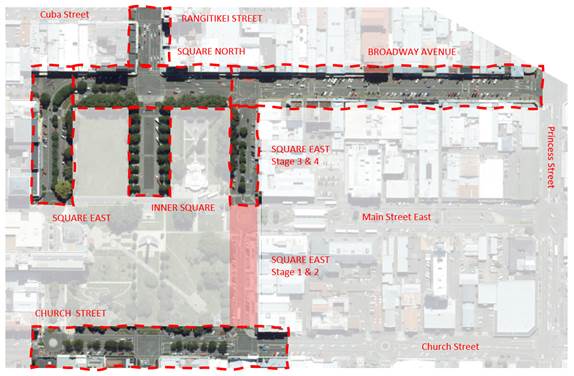
2.4 The
first stages of the programme, as noted in faded red, were completed in June
2020.
2.5 On
21 June 2023, The Committee resolved to establish the Central City
Transformation Project Steering Group. The Steering Group met for the
first time on 29 February 2024.
2.6 As
there was no specific progress to report on Council’s Streets for People
project, the meeting instead focused on the wider City Centre Indicative
Business Case (CCIBC) project and how the CCIBC impacts the functions of the
Steering Group.
2.7 No
follow-up meeting of the Steering Group was scheduled, as the Steering Group is
involved in the CCIBC workshops. The Steering Group will continue to be
involved in the CCIBC until the project is completed.
3. PROJECT
UPDATE
City Centre Indicative Business Case
3.1 The
City Centre Indicative Business Case (CCIBC) is a project that officers are
undertaking to achieve two objectives. The first is to align city centre
projects to a shared vision for the city centre. The second is to help
the Council secure co-funding from NZTA Waka Kotahi for capital projects like
upgrading the central bus hub or Streets for People.
3.2 Since
the previous update on 19 June 2024, the project has progressed with developing
the economic case for the business case. This involved two technical
workshops and another workshop involving the Steering Group.
3.3 Workshop
3 (technical workshop) was held on 12 August 2024. This workshop was
focused on putting the Original Long List of Interventions through NZTA’s
Early Assessment Sifting Tool (EAST) to develop a semi-long list. At this
workshop, an initial 187 interventions were filtered down to 87. The
workshop also provided guidance on a high-level Multi-criteria Analysis (MCA),
which would be used to refine the semi-long list of interventions further.
3.4 Workshop
4 (technical workshop) was held on 28 November 2024. This workshop was
focused on confirming the results of the high-level MCA and providing guidance
on the initial short list programmes and the MCA score to assess them against
each other.
3.5 Workshop
5 was held on 20 February 2025. This workshop was intended to be a final
review and confirmation of the scores developed in workshop 4. There was
a lot of discussion around the 3 programme options that were developed from the
list of interventions that made it through both the EAST and the high-level
MCA. The group was not able to get through the MCA scores in the time
allocated, and it was agreed that this information would be circulated via
email for the attendees to provide feedback.
3.6 At
the time of writing this report, that information has been circulated and
officers have not yet received any feedback from the attendees.
3.7 The
next steps will involve consolidating the feedback on the scores and
identifying a preferred programme. Once a preferred programme is
confirmed, the project team will complete the business case.
3.8 The
project team are aiming to have the business case completed and peer-reviewed
ahead of the June 2025 Economic Growth Committee meeting. At this meeting,
we will be seeking the endorsement of the business case prior to submitting it
to NZTA for endorsement.
4. NEXT
STEPS
4.1 Work
will continue on the City Centre Indicative Business Case. Officers are
working towards the June Economic Growth Committee for completion and
endorsement.
4.2 As
there is no funding for progressing the Streets for People programme, once the
Indicative Business Case is complete, there will be limited work for the
Steering Group to progress. Due to funding constraints and the local
government election, the Steering Group will encounter a natural pause in its
function. We will look to pause all further meetings with the Steering
Group and reconvene the group in 2026 once the Council has reconfirmed its
membership.
5. Compliance
and administration
|
Does the Committee have
delegated authority to decide?
|
Yes
|
|
Are the decisions significant?
|
No
|
|
If they are significant do, they
affect land or a body of water?
|
No
|
|
Can this decision only be made
through a 10 Year Plan?
|
No
|
|
Does this decision require
consultation through the Special Consultative procedure?
|
No
|
|
Is there funding in the current
Annual Plan for these actions?
|
Yes
|
|
Are the recommendations
inconsistent with any of Council’s policies or plans?
|
No
|
|
The recommendations contribute
to
Whāinga 2: He tāone whakaihiihi,
tapatapahi ana
Goal 2: A Creative and Exciting City
|
|
The recommendations contribute
to the achievement of action/actions in City Shaping
The action is:
· The city centre
contributes positively to the perception of Palmerston North.
· Visible public
life and pedestrian counts increase.
The city centre has a series of places with a strong place
identity.
|
|
Contribution to strategic
direction and to social, economic, environmental, and cultural well-being
|
A vibrant city centre will
make Palmerston North even more attractive for work and play, provide more
opportunities for locals and visitors to connect with the city and the people
who live here, and bring significant benefits for the local economy.
Streets for People provides investment in the public space
to ensure our roads are places for people, not just vehicles and encourages
more private investment in the city centre.
|
|
|
|
Attachments
NIL
Memorandum
TO: Economic
Growth Committee
MEETING DATE: 9
April 2025
TITLE: Road
Maintenance Contract - 6 Monthly Update
Presented
By: Glen
O'Connor, Manager - Transport and Development
APPROVED BY: Chris
Dyhrberg, General Manager Infrastructure
RECOMMENDATION TO Economic Growth Committee:
1. That
the Committee receive the memorandum titled ‘Road Maintenance
Contract - 6 Monthly Update’ presented to the Economic Growth Committee
on 9 April 2025.
1. ISSUE
1.1 In
March 2022, the report titled ‘Road Maintenance Contract Update’
was presented to the Infrastructure Committee, where the Committee resolved:
“to receive further six-monthly reports on the
work programme and performance of the road maintenance contract.”
1.2 This
report provides the latest update on the work programme and performance of the
road maintenance contract, using information up to the end of February 2025.
2. BACKGROUND
Road Maintenance Contract
2.1 Council
entered Contract 3938 Road Maintenance, Renewal, and Capital Improvement
Services (Road Maintenance Contract) with Fulton Hogan in March 2021. The
contract commenced on 1 July 2021 with an initial term of three (3) years, with
two (2) right of renewals for three (3) years each.
2.2 In
May 2024, Council approved entering the first three-year renewal term of the
Contract with Fulton Hogan from 1 July 2024 through to 30 June 2027. As
part of this process, Council renewed the street lighting and street sweeping
components of this contract for an initial one-year term. Further
renewals of these two contract components were contingent on Fulton Hogan
meeting key performance indicators around these services.
2.3 In
March 2025, Council approved renewing the street lighting and street sweeping
components of this contract for two further years until 30 June 2027.
Contract Works
2.4 Works
delivered by the road maintenance contract can be split into operations/maintenance
and renewals/capital spend areas, with each funding stream having key
deliverables.
Operations and Maintenance
include:
· Footpaths
· Road surface
repairs
· Drainage channel
maintenance
· Traffic Services
i.e. signals, street lighting, sweeping etc.
Renewals and capital include:
· Pavement reseals
· Pavement
rehabilitations/ replacements
· Drainage
· Footpaths
· Structural –
bridges, large culverts etc.
3. ROAD MAINTENANCE CONTRACT UPDATE
3.1 Below
is an update on the contract deliverable areas.
Operations and Maintenance Work
3.2 Footpaths
· The city-wide
footpath maintenance work continues. The reduced funding from NZTA has
limited the amount of footpath maintenance that can be undertaken.
3.3 Road
Repairs
· The programme of
repairs and reactive maintenance work to the city’s roading network is
ongoing. The extensive periods
of wet weather in August (highest recorded August rainfall in Palmerston North)
and September 2024 has had a negative impact on the condition of our roads and
has accelerated their deterioration.
3.4 Drainage
Road Sweeping and Sump Clearing
· The dry, hot
period in January and February 2025 has caused heavy early leaf fall. The
clearance of this early leaf fall has incurred additional costs, pressuring the
road sweeping budgets earlier in the season than expected.
· Officers continue
to undertake fortnightly audits of completed sweeping areas. No
substantive quality issues were observed on the work undertaken by the
contractors.
3.5 Traffic
Services
Road Markings
· Line marking of
centre lines and stop/give ways markings etc on our roads continues, with
around 80% of our city remarked. While this remarking programme
continues, it is likely that the final 10% or so of our network remark will
need to be held over into July 2025, due to budgets, and marked under the
2025/26-year budgets.
Streetlights
· The initial night
survey of our city to inspect the functioning of our approximately 10,0000
streetlights was undertaken in July 2024. Further streetlight night
audits were undertaken in October 2024 and January 2025. The results of
these audits are consolidated in the table below:
|
Quarterly audit
|
Total Faults
|
Bulb, Fuse and Luminaire faults
|
Network faults
|
Outstanding Faults
|
% of the network lit
|
|
Jan-25
|
97
|
59
|
38
|
30
|
99%
|
|
Oct-24
|
146
|
105
|
41
|
All now resolved
|
98%
|
|
Jul-24
|
235
|
133
|
102
|
All now resolved
|
97%
|
· There are 260
street light luminaires in stock, which will provide stock for approximately
six months. Further stock will be ordered as appropriate to ensure
adequate replacement levels are held.
Powerco
3.6 Officers
are meeting with Powerco, the network power supplier for our streetlights,
regularly to discuss how improvements and efficiencies can be achieved across
the multiple parties involved with the streetlighting assets. This
includes how a quicker resolution to network faults can be achieved.
· These faults
included a variety of repairs from fuse replacements to extensive traffic
management, excavations and repairs of cables.
· Faults between 1
July 2024 and 31 December 2024 were resolved within the following timeframes
(with the 12 period from 1 July 2023 to 30 June 2024 for comparison):
|
Time to Complete
|
Dispatches 1st July 24-
31st Dec 24
|
Percentage (%)
|
Dispatches_ 1st July 23
- 30th June 24
|
Percentage (%)
|
|
Within 1 week
|
41
|
29%
|
91
|
33%
|
|
1 week to 1 month
|
73
|
51%
|
65
|
24%
|
|
1 month to 2 months
|
25
|
17%
|
103
|
38%
|
|
2 months to 3 months
|
4
|
3%
|
13
|
5%
|
|
Total
|
143
|
100%
|
272
|
100%
|
· Officers continue
to work with all parties involved in this process to tighten up the resolution
and reporting timelines.
Capital Works
3.7 Pavement
Reseals
· The 2024/25 chip
sealing resurfacing programme of 35 streets is 90% complete, with some minor
loose chip removal continuing as these chip sealed surfaces bed in.
3.8 Pavement
Rehabilitations
· Sections of
Railway Road, between Tremaine Avenue and the rail overbridge, required a
complete pavement rehabilitation, due to weak underlying soils, poor subgrade
and extensive heavy vehicle traffic. The first stage of this
rehabilitation was completed in May 2024, and the second stage in October
2024. This rehabilitation programme was successfully completed.
· Road
rehabilitation works were undertaken on Newbury Line to strengthen the road
pavement and remove rutted areas. Two new culverts were installed under
the road as part of this work to improved roadside drainage on this very poorly
drained road area.
· Funding for
pavement rehabilitations is very tight and this will need to be reviewed to
ensure that our transport network does not deteriorate further.
3.9 Drainage
· Minor drainage
works near the Fitzherbert Avenue and Ferguson Street area is planned with the
installation of two additional roadside sumps.
· At Millricks Line,
culvert piping under the road was repaired and realigned, as the culvert pipes
had become displaced.
3.10 Bridges
and Large Culverts
· The Park Road
culvert structural headwall is being renewed, as it had cracked. This
work will be completed this financial year.
3.11 Footpaths
· The programme of
renewal work for footpaths throughout the city is 60% completed, with the
remaining works to be completed by the end of the financial year.
4. NEXT STEPS
4.1 Continue
to work with Fulton Hogan to ensure the delivery of the programme of works
covered by this contract.
5. Compliance and administration
|
Does the Committee have
delegated authority to decide?
|
Yes
|
|
Are the decisions significant?
|
No
|
|
If they are significant do, they
affect land or a body of water?
|
No
|
|
Can this decision only be made
through a 10 Year Plan?
|
No
|
|
Does this decision require
consultation through the Special Consultative procedure?
|
No
|
|
Is there funding in the current
Annual Plan for these actions?
|
Yes
|
|
Are the recommendations
inconsistent with any of Council’s policies or plans?
|
No
|
|
The recommendations contribute
to:
Whāinga 1: He tāone
auaha, he tāone tiputipu
Goal 1: An innovative and growing city
|
|
The
recommendations contribute to the achievement of objective/objectives
in:
3.
Mahere tūnuku
3. Transport Plan
The objective is: Develop, maintain, operate, and renew
the active and public transport network to deliver on Council goals, the
purpose of this plan, and the Government Policy Statement on Transport.
|
|
Contribution to strategic
direction and to social, economic, environmental, and cultural well-being.
|
The road maintenance contract
is a key delivery vehicle towards having safer, well maintained, and well
utilised transport network.
|
|
|
|
Attachments
NIL
Memorandum
TO: Economic
Growth Committee
MEETING DATE: 9
April 2025
TITLE: Palmerston
North Airport Limited - Interim Report for 6 months to 31 December 2024
Presented
By: Steve
Paterson, Manager - Financial Strategy
APPROVED BY: Cameron
McKay, General Manager Corporate Services
RECOMMENDATION TO Economic Growth Committee:
1. That
the Committee receive the Interim Report and Financial Statements of
Palmerston North Airport Ltd for the period ended 31 December 2024, presented
to the Economic Growth Committee on 9 April 2025.
1. ISSUE
1.1 Palmerston
North Airport Ltd (PNAL), as a Council-Controlled Organisation, is required to
provide a 6-monthly report to Council. The report for the period ending
31 December 2024 is attached.
2. BACKGROUND
2.1 PNAL
draft Statement of Intent (SOI) for 2024/25 was considered by Council in April
2024 and the final SOI was agreed to by Council in June 2024.
2.2 Performance
for the six-month period to 31 December 2024 is covered in the attached report
by the Chair and Chief Executive.
2.3 The
report describes the results for the half year as being mixed including:
· Subdued
passenger demand (4% down on the same period last year and the SOI) impacting
revenue which is 3% below SOI expectations. These lower levels are
projected to continue for the rest of this financial year.
· Terminal
development final design is progressing though some value engineering being
undertaken in an effort to limit the final project cost though current
expectations are the final budgeted cost will exceed the original $40m
preliminary design assessment. The temporary terminal construction is
underway.
· Progress
with a number of projects including go-live for licence plate recognition
technology in the carpark, an airside pavement upgrade and the opening of the
long stay carpark extension.
· Recertification
at Level 4 of the Airport Carbon Accreditation programme a recertification as
Qualmark Gold.
· Key
performance targets (apart from passenger movements and net promoter score
result) have all been achieved for the six months.
2.4 The
report indicates PNAL is close to resolving the short-medium term funding
constraints experienced in recent years. This is addressed further in the
separate report regarding the forthcoming SOI.
2.5 At
31 December PNAL had drawn a total of $8m ($5m in July 2022 and $3m in August
2023) through the debt facility made available by the Council. Further
sums are planned to be drawn before 30 June 2025.
2.6 As
earlier agreed with Council a dividend of $195,000 has been paid in relation to
the 2023/24 year.
2.7 PNAL
has prepared its draft SOI for the 2025/26 – 2027/28 period and this is
being considered under a separate report.
3. NEXT STEPS
3.1 PNAL
will prepare and forward an annual report after 30 June 2025.
4. Compliance and administration
|
Does the Committee have
delegated authority to decide?
|
Yes
|
|
Are the decisions significant?
|
No
|
|
If they are significant do they
affect land or a body of water?
|
No
|
|
Can this decision only be made
through a 10 Year Plan?
|
No
|
|
Does this decision require
consultation through the Special Consultative procedure?
|
No
|
|
Is there funding in the current Annual
Plan for these actions?
|
Yes
|
|
Are the recommendations
inconsistent with any of Council’s policies or plans?
|
No
|
|
The recommendations contribute
to
Whāinga 1:
He tāone auaha, he tāone tiputipu
Goal 1: An Innovative and Growing City
|
|
The recommendations contribute
to the achievement of action/actions in Transport
The action is: Work with the airport company to ensure the
airport’s strategic intent aligns with the City’s aspirations.
|
|
Contribution to strategic
direction and to social, economic, environmental and cultural well-being
|
This report outlines progress
to date.
|
|
|
|
Attachments
|
1.
|
PNAL
Interim report for 6 months to 31 December 2024 ⇩ 
|
|
Memorandum
TO: Economic
Growth Committee
MEETING DATE: 9
April 2025
TITLE: Palmerston
North Airport Limited - Draft Statement of Intent for 2025/26 to 2027/28
Presented
By: Steve
Paterson, Manager - Financial Strategy
APPROVED BY: Cameron
McKay, General Manager Corporate Services
RECOMMENDATIONS TO
Economic Growth Committee:
1. That
the Committee receive the Palmerston North Airport Limited (PNAL) draft Statement
of Intent for 2025/26 to 2027/28, presented to the Economic Growth Committee on
9 April 2025.
2. That
Palmerston North Airport Limited be advised:
a. Council
supports the proposed direction and implementation strategy;
b. Council
recognises the projected requirement for loans totalling $40.9m by 30 June 2026
and that Palmerston North Airport Limited will be seeking to
utilise the loan facility provided by the Council to fund a significant portion
of this.
1. ISSUE
1.1 To
present and provide comment on the draft Statement of Intent for Palmerston
North Airport Limited (PNAL) for 2025/26 and the following two years.
2. BACKGROUND
2.1 PNAL
is deemed a Council-Controlled Trading Organisation (CCTO) under the Local
Government Act 2002. A CCTO must deliver a draft Statement of Intent
(SOI) to shareholders by 1 March each year and adopt it by 30 June. The
Council must, as soon as possible after a draft SOI is delivered to it, agree
to a CCTO’s SOI or, if it does not agree, take all practicable steps
under clause 6 of Schedule 8 of the Local Government Act 2002 to require the
SOI to be modified. The Board of the CCTO must consider any shareholder
feedback by 1 May 2025.
2.2 The
Council’s reason for its shareholding in PNAL is to ensure that the
capacity and image of the City’s key transportation gateway is consistent
with the Council’s economic development objectives.
2.3 As
a CCTO PNAL is required under the Local Government Act 2002 to have the
following principal objective:
· Achieve the
objectives of its shareholders, both commercial and non-commercial, as
specified in the Statement of Intent; and
· Be a good
employer; and
· Exhibit a sense of
social and environmental responsibility by having regard to the interests of
the community in which it operates and by endeavouring to accommodate or
encourage these when able to do so; and
· Conduct its
affairs in accordance with sound business practice.
2.4 Council’s
shareholding represents 100% of the issued and paid-up capital.
2.5 On
20 November 2024 the Committee adopted a Statement of Expectations for PNAL and
this was provided to PNAL in advance of its development of the draft SOI.
3. Draft Statement Of Intent - Overview
3.1 Attached
is a letter from PNAL to shareholders explaining the enclosed draft SOI and
outlining the key assumptions (Attachment 1).
3.2 The
draft SOI retains the vision from the current year, ‘New Zealand’s
leading regional airport’, and the purpose statement, ‘Launching
our communities into a promising future’, as well as the five strategic
objectives.
3.3 The
SOI addresses all of the matters outlined in Council’s Statement of
Expectations.
3.4 It
has been assumed there will be an approx. 2% p.a. growth in passenger numbers
to 565,000 in 2027/28 off a low base in 2024/25.
3.5 Operating
revenues are budgeted to increase and whilst movements in costs are variable
– the reasons are explained in the covering letter and on page 18 of the
SOI.
3.6 The
three-year budgets assume capital development (totalling $73.1m; including
terminal ($34.8m), Ruapehu Aeropark ($26.9m), airside infrastructure ($4.5m)
and landside infrastructure ($4.7m)) will be able to be accomplished by PNAL
with net additional borrowing ($57.3m) but without the need for additional
share capital.
3.7 The
terminal development project will bring with it significant disruptions to the
customer experience, day to day operations and the financial outcomes.
PNAL indicate that managing disruption and customer communication are key
priorities for them.
3.8 Shareholders’
funds as a percentage of total assets are forecast to reduce to 60% in the
first year and 50% through the rest of the three-year term of the SOI. This is
still well above the expectation that it will remain over 40%.
4. Draft SOI – Performance Targets
4.1 The
following financial performance targets are included in the draft SOI.
The draft SOI outlines the budgeted outcomes for 2026/27 and 2027/28 in
addition to 2025/26 shown below.
|
|
Draft SOI
2025/26
Budget
|
Forecast
2024/25
|
SOI
2024/25
Budget
|
|
NPBIT:
Total assets
|
6%
|
6%
|
5%
|
|
NPAIT:
Shareholders’ funds
|
(1%)
|
1%
|
(2%)
|
|
Shareholders’
funds: Total assets (>40%)
|
60%
|
75%
|
59%
|
|
Interest
cover (>2.5)
|
5.5
|
9.7
|
4.4
|
|
Tangible
Net Worth (>$80m)
|
$80.9m
|
$80.5m
|
$84.1m
|
|
Net
debt
|
$40.8m
|
$16.3m
|
$44.9m
|
|
Total
Debt to Total Debt + Equity ratio
|
34%
|
17%
|
53.4%
|
|
Net
Debt*/EBIDA (long term target < 4.5)
|
4.9
|
2.5
|
6.4
|
|
Funds
from Operations (FFO**)/Net Debt (long term target > 11%)
|
15.9%
|
38.0%
|
13.5%
|
*Net
Debt = total borrowings less cash on hand
**FFO
= EBIDA less interest less tax
4.2 There
are non-financial measures of performance for each of the strategic areas
– compliance, customer, community, culture and commercial.
4.3 Examples
include:
· Various compliance
requirements including CAA part 139 recertification
· Maintaining a
customer satisfaction Net Promoter score as close as reasonably practical to
the greater of the tourism industry benchmark or 45
· Serving 543,400
passengers during the 2025/26 year increasing to 555,700 for the following year
and 564,800 in the June 2028 year
· Zero lost time
injuries to those who work within the airport community
· Maintaining
Airport Carbon Accreditation level 4 and implementing several specific
initiatives
· Completion of
physical works:
o Terminal development with
stage 1 (Western end) complete in mid-2026 and stage 2 (Eastern end) complete
in mid-2027
o Progressively extending the
covered walkways to carparks
o Airside pavement upgrades
o Commercial developments in the
Ruapehu Aeropark focused on freight and logistics, premises for aeronautical
operators, rental car precinct and Massey School of Aviation support premises.
5. Draft SOI – Dividend policy
5.1 Council’s
Statement of Expectations (SOE) outlines the expectation that:
“PNAL
is required to have a commitment to retaining and growing long-term shareholder
value. Council recognizes that shareholder value
accretion occurs through PNAL’s ongoing and significant investment in
critical infrastructure including the terminal redevelopment to improve the
customer experience and to facilitate sustainable growth in passenger and
airfreight volumes, and investment in the development of Ruapehu Business Park
which will provide income diversification and value accretion benefits.
Council
further recognizes that given the magnitude of
the planned capital programme associated with the terminal replacement and
commercial development opportunities PNAL’s ability to preserve cash is
likely to be constrained in the short-term. However as outlined last year
Council has an expectation that a dividend payment will be progressively
re-instated, in line with PNAL’s dividend policy and that the implications
of this will be addressed annually through the SOI.
As
a guide Council has the following dividend expectations:
· the dividend payment for the 2024/25 year
(payable in 2025/26) will be no less than 20% of net profit after tax or
$300,000, whichever is greater,
· the dividend payment for the 2025/26 year
(payable in 2026/27) will be no less than 40% of net profit after tax or
$400,000, whichever is greater,
· the dividend payment for the 2026/27 year
(payable in 2027/28) will be no less than 40% of net profit after tax or
$500,000, whichever is greater.”
5.2 The
draft SOI contains a section relating to its dividend policy. It
acknowledges the Council’s dividend expectations and provides for them at
the levels indicated in the SOE. PNAL provides information about
projected cashflows and it’s ability to fund the payment of
dividends. It notes that although dividend payments are being planned
for, it will need to borrow to make the payments. It also notes as is the
case for the current SOI:
“Directors
will have the opportunity to assess a range of criteria before arriving at an
appropriate dividend, including actual and projected performance. In
establishing a dividend recommendation, the Directors will consider the
following:
· The
scale of the company’s capital expenditure plans including shareholder
expectations,
· The
company’s financial performance including cashflows from operations,
· The
company’s ability to raise debt finance and the term thereof,
· Compliance
with performance metric targets,
· The
risks associated with airline schedule uncertainty in the short to medium
term.”
5.3 In
summary the forecast position is as outlined in the following table:
|
Forecast/Budget
|
Forecast 2024/25
|
SOI 2025/26
|
SOI 2026/27
|
SOI 2027/28
|
|
Net
profit/(loss) after tax
|
$(1.113m)
|
$0.810m
|
$2.764m
|
$3.591m
|
|
Dividend
declaration
|
$0.3m
|
$0.4m (49% of NPAT)
|
$1.106m (40% of NPAT)
|
$1.436m (40% of NPAT)
|
|
Dividend
payment
|
$0.195m
|
$0.3m
|
$0.4m
|
$1.106m
|
5.4 Council’s
Long-term Plan 2024-34 currently assumes there will be a dividend received of
$150k each year and indicates there is a high level of uncertainty regarding
this assumption. Council recognises the dividend in the year of
payment. Council’s proposed annual budget for 2025/26 assumes the
Council will receive a dividend payment of $300k during 2025/26.
5.5 The
matters highlighted by PNAL raise the issue of whether or not it is appropriate
for the Council to expect dividends at a time when cash outgoings for essential
development effectively mean PNAL is being required to borrow to fund the
dividend payment.
5.6 The
situation has not changed since the Council considered this when adopting the
Statement of Expectations containing the dividend expectations.
5.7 Directors
of companies have an obligation to undertake appropriate solvency tests each
year before declaring a dividend. A dividend in any year is therefore
subject to successfully completing this test.
6. Draft SOI – Debt funding
6.1 The
Council and PNAL have entered a $50m loan facility agreement that aims to
reduce the interest expense for PNAL and involves the Council borrowing from
the Local Government Funding Agency then on-lending to PNAL at a market-related
margin to cover Council’s costs and the risks involved. The intention of
the agreement is that the Statement of Intent is a mechanism for determining
the maximum facility agreement in any given year.
6.2 To
date $12m has been raised and on-lent under the terms of the facility. The
draft SOI forecasts term liabilities increasing to $73.6m over the coming three
years (up to $40.9m in year one) and that revenue will be adequate to service
this level of debt. At the present time PNAL has a $15m facility
agreement with its bank and plans to seek proposals from banks to increase this
to $40m. This is further addressed in section 7 below. Whilst some
of the term liabilities will reflect utilisation of PNAL’s facility with
its Bank it is anticipated that a significant portion of the increased debt
will be obtained through the facility provided by the Council.
6.3 The
basis of the loan arrangement is that the PNAL borrowing will not impact on the
Council’s ability to borrow for other Council funded capital
expenditure. This relies on LGFA being prepared to treat the loan advance
from the Council to PNAL as an asset that it will net off against the related
borrowing. It is important PNAL‘s assessment of its ability to
service the debt is robust and it is acknowledged there are many assumptions
involved and there are potential risks.
7. PNAL structure &/or investment
partnerships
7.1 The
previous two SOIs have highlighted capital constraints have limited
PNAL’s ability to deliver developments in the Ruapehu
Aeropark.
7.2 PNAL
and the Council have investigated possible options. Council has expected
PNAL to be the primary driver of this investigation.
7.3 PNAL
advise (on page 19 of the draft SOI), they have concluded the most appropriate
approach for the time being is to finance the development through additional
borrowing. In view of this they plan to seek proposals for a new $40m
line of credit, up from the present $15m facility. Their aim is to have
the new facility in place by 1 July 2025. It is necessary for PNAL to
have a bank facility as this is capable of being structured more flexibly than
is possible through the facility with the Council.
7.4 It
will be sensible for the Council and PNAL to work closely to ensure an
appropriate mix of bank and Council sourced debt each year to achieve the best
outcomes.
7.5 As
outlined in clause 6.3 the Council needs to continue to be assured PNAL is
capable of servicing its total debt without impacting the Council’s
ability to borrow for its own purposes.
7.6 PNAL
recognise this and will assure themselves each investment proposal is
sufficiently robust to be able to be sustained.
8. NEXT STEPS
8.1 Council
can either endorse the SOI as presented or make suggestions for change to a
greater or lesser extent.
9. Compliance and administration
|
Does the Committe have delegated
authority to decide?
|
Yes
|
|
Are the decisions significant?
|
No
|
|
If they are significant do they
affect land or a body of water?
|
No
|
|
Can this decision only be made
through a 10 Year Plan?
|
No
|
|
Does this decision require
consultation through the Special Consultative procedure?
|
No
|
|
Is there funding in the current Annual
Plan for these objectives?
|
Yes
|
|
Are the recommendations
inconsistent with any of Council’s policies or plans?
|
No
|
|
The recommendations contribute
to:
Whāinga 1: He tāone
auaha, he tāone tiputipu
Goal 1: An innovative and growing city
|
|
The
recommendations contribute to the achievement of objective/objectives
in:
2.
Mahere whakawhanake ohaoha
2. Economic Development
Plan
3.
Mahere tūnuku
3. Transport Plan
These relate to having an innovative, resilient &
low-carbon city economy where people, whanau and communities can prosper
& achieve their goals and a city transport system that links people &
opportunities.
|
|
Contribution to strategic
direction and to social, economic, environmental and cultural well-being
|
The airport is a key strategic
gateway to the City. The draft Statement of Intent includes a direction and
specific actions that are designed to continue to improve the airport for
customers and stimulate growth.
|
|
|
|
Attachments
|
1.
|
Covering
letter from PNAL ⇩ 
|
|
|
2.
|
Draft
Satement of Intent ⇩ 
|
|


Memorandum
TO: Economic
Growth Committee
MEETING DATE: 9
April 2025
TITLE: Central
Economic Development Agency (CEDA): 6 month Report 1 July 2024 to 31 December
2024 and Draft Statement of Intent 2025/26
Presented
By: David
Murphy, General Manager - Strategic Planning
APPROVED BY: David
Murphy, General Manager - Strategic Planning
RECOMMENDATIONS TO
Economic Growth Committee
1. That the
Committee receive the Central Economic Development Agency (CEDA) 6 Month Report
1 July 2024 to 31 December 2024 (Attachment 1), presented to the Economic
Growth Committee on 9 April 2025.
2. That the
Committee receive Central Economic Development Agency (CEDA) draft Statement of
Intent 2025-26 (Attachment 3), presented to the Economic Growth Committee on 9
April 2025.
3. That the
Committee approve the comments outlined in the Central Economic Development
Agency (CEDA) draft Statement of Intent 2025–26 (Table 1), presented to
the Economic Growth Committee on 9 April 2025.
1. ISSUE
1.1 The
Central Economic Development Agency (CEDA) has delivered its six-month report 1
July to 31 December 2024 (six-month report) and draft Statement of Intent
2025/26 (SOI 2025/26). This report includes analysis of both documents.
1.2 The
six-month report is included as Attachment 1.
1.3 The
approved Statement of Expectations 2024/25 to 2026/27 (SOE 2024/25 to 2026/27)
and draft SOI 2025/26 are included as Attachment 2 and 3.
1.4 Under
the Local Government Act 2002 (LGA), when preparing the final SOI, a Council
Controlled Organisation (CCO) must consider any comments made on the draft by
the Council prior to delivering a final SOI by 30 June 2025.
1.5 The
Economic Growth Committee has the delegation to receive the 6-month report and
agree the Statement of Intent for CEDA on Council’s behalf.
1.6 The
purpose of this report is to receive the six-month report and provide an
opportunity for Council to give feedback to CEDA on their draft SOI 2025/26.
2. BACKGROUND
2.1 CEDA
is a Council Controlled Organisation (CCO) under the LGA and is jointly owned
by PNCC and MDC. A CCO must deliver a draft SOI to PNCC and MDC and a final SOI
by 30 June 2025.
2.2 The
CEDA Board must consider any feedback from the shareholders before delivering a
final SOI for approval in June 2025.
2.3 The
Council is required by the LGA to regularly undertake performance monitoring of
its CCOs. Council is required to evaluate:
· The
contribution of each CCO to the Council’s objectives for the CCO;
· The
desired results set out in the SOI; and
· The
overall aims and outcomes of the Council based on the six-month reports.
3. SIX-MONTH
REPORT 1 JULY TO 31 DECEMBER 2024
3.1 The
six-month report allows the Committee to track CEDA’s progress against
their SOI 2024/25.
3.2 A
copy of the six-month report is included as Attachment 1.
3.3 From
a contract-manager perspective, we have seen a continued focus from CEDA in the
last 12-months to actively connect with partners and foster inward investment
opportunities that are aligned to the region’s strategic objectives. This
has been particularly evident with regards to the work completed on Te
Utanganui, Central New Zealand Distribution Hub, where projects of this nature
require a commitment to long-term relationships. We have also seen an
increased focus on fostering investment in the city centre, particularly
accommodation / hotels and participation in various city centre planning
processes.
3.4 The
six-month report is based around the following three strategic pillars:
· Business
- Attract, retain, and develop business and investment in the region.
· People
- Attract, retain, and develop talent in the region.
· Place
- Profile the region to attract people, business, and investment.
3.5 Key
focus areas within CEDA’s six-month report include:
Business:
· Te
Utanganui – Central New Zealand Distribution Hub.
· Manawatū
Regional Food Strategy.
· Destination
Management Plan.
· Inward
Investment Framework.
· Integrated
sector development initiatives and business engagement.
· Business
capability funding and support.
· Start-up
and innovation support.
People:
· Pathways
to employment.
· Project
and sector led workforce development.
· Intel
and insights for central government.
· Success
stories and business profiles.
· Distribution
of resources and tools through business engagements.
Place:
· Regional
Identity; featuring the region through media and partnerships.
· ManawatuNZ.co.nz
the region’s ‘shop window’.
· Developing
stories and content of our people, places and businesses.
· Growing
social media engagement.
· Targeted
marketing, pitching the region.
Partnerships:
· Effective
partnerships with councils, government, Māori, and business support
groups.
3.6 CEDA’s
financial performance is detailed on pages 18 to 22 of the six-month report and
includes a $174,887 surplus for the six-months to 31 December 2024 (unaudited).
4. STATEMENT
OF EXPECTATIONS 2024/25 to 2026/27 (2024/34 Long Term Plan)
4.1 A
copy of the Statement Of Expecttaion (SOE) 2024/25 to 2026/27 as approved by Palmerston
North City Council and Manawatū District Council is included as Attachment
2.
4.2 The
SOE 2024/25 to 2026/27 was largely a rollover from previous years and
maintained a focus on developing a talent pipeline (people); inward investment
(business); and domestic visitation (place).
4.3 This
SOE covers the period 1 July 2024 to 30 June 2027, which is years 1-3 of the
Shareholders’ 2024/34 Long Term Plan.
4.4 A
key addition to the SOE 2024/25 to 2026/27 was the inclusion of ‘Inward
investment in the Feilding town centre and Palmerston North city centre’
as a top priority for both councils. We are already seeing CEDA begin to
operate in this space following investment leads for new hotels in both
Feilding and Palmerston North.
5. DRAFT
STATEMENT OF INTENT 2025/26
5.1 A
copy of the draft SOI 2025/26 is included as Attachment 3.
5.2 CEDA
has presented a draft SOI that aligns with the SOE, as outlined in table 1
below.
Table 1: Comparison of CEDA
SOE with the SOI
|
Statement of Expectation
|
CEDA Draft SOI 2024/25
|
Comments
|
|
Taking a leadership position
and building strategic relationships in the Manawatū region and beyond,
is fundamental for CEDA to achieve its purpose.
The shareholders have
identified the following key partners for CEDA: Palmerston North City
Council, Manawatū District Council, Horizons Regional Council, Iwi,
Manawatū Chamber of Commerce, NZ Defence Force, Federated Farmers,
Accelerate 25, KiwiRail, FoodHQ, Massey University, The Factory, Palmy BID,
Feilding & District Promotions, and key Government agencies.
|
CEDA has addressed strategic
partners at page 19 of the SOE and in the performance measures on page 26.
|
No comment. Priorities
addressed.
|
|
Stimulate inward investment (both national and
international), retention and expansion of business in the Manawatū
region.
Developing a talent pipeline.
Support domestic visitation and tourism
|
CEDA has addressed these
outcomes via the three pillars, statement of intent outcomes, projects,
activities and strategies summarised on page 9 and the performance measures
for each are captured on pages 25 and 26.
|
No comment. Priorities
addressed.
|
|
Top priorities are:
Te Utanganui, Central New
Zealand Distribution Hub.
Strategic oversight and
coordination of the Manawatū Food Strategy.
Promotion and development of
key tourism and visitor destinations.
Inward investment in the
Feilding town centre and Palmerston North city centre.
|
CEDA has addressed its work
to support Te Utanganui, Central NZ Distribution Hub at page 11.
Manawatū Regional Food
Strategy is addressed at page 11.
Visitor activity is addressed
via pillar three (place) and the supporting statement of intent outcomes,
projects and activities summarised on page 9.
The focus on Feilding town
centre and Palmerston North city centre is addressed at page 11 under inward
investment opportunities.
|
No comment. Priorities
addressed.
|
|
CEDA’s success will be
measured by the shareholders using the following indicators of the health of
the regional economy:
Job growth.
Increase in median household
income.
Number of investment leads
and deals secured.
Strength of the relationship
with strategic partners.
|
Addressed in the performance
measures (pages 25 and 26).
CEDA’s performance
measure framework identifies quantifiable measures of their programmes and
activities aligned to their key strategic outcomes. These form the basis of
their accountability and will be reported on six-monthly. In CEDA’s
reporting, additional commentary will be used to inform on the delivery and
effectiveness of the full range of CEDA’s activity.
|
No comment.
|
5.3 A
budget for 2025/6 (year 2) and a forecast for 202/27 (year 3) is included in
the financial performance on pages 30 and 31 of the Draft SOI. The Council
funding assumption is based on the figures contained within the PNCC and MDC
Draft 2024/34 Long Term Plans. While CEDA are forecasting a small deficit for
years 2 and 3, this is not considered significant given the Group Statement of
Financial position detailed on page 32.
6. NEXT
STEPS
6.1 Provide
comments on the draft SOI in writing to CEDA, noting that any comments on the
draft SOI agreed by Council will need to be cognisant of what they mean for MDC
as a joint shareholder.
6.2 CEDA
will deliver its final SOI to both councils (shareholders) in June 2025.
|
Does the Committee have delegated
authority to decide?
If Yes quote relevant clause(s)
from Delegations Manual
|
Yes
|
|
Are the decisions significant?
|
No
|
|
If they are significant do they
affect land or a body of water?
|
No
|
|
Can this decision only be made
through a 10 Year Plan?
|
No
|
|
Does this decision require
consultation through the Special Consultative procedure?
|
No
|
|
Is there funding in the current
Annual Plan for these objectives?
|
Yes
|
|
Are the recommendations
inconsistent with any of Council’s policies or plans?
|
No
|
|
The
recommendations contribute to: Whāinga 1: He tāone
auaha, he tāone tiputipu
Goal
1: An innovative and growing city
Whāinga
2: He tāone whakaihiihi, tapatapahi ana
Goal
2: A creative and exciting city
|
|
The recommendations contribute to this plan:
2. Economic Development
Plan
The objective is:
· Provide
opportunities and infrastructure to accommodate business growth
· Support
sustainable business activity and labour market development
· Promote
the city
|
|
Contribution to strategic direction
and to social, economic, environmental and cultural well-being
|
Our city’s economic wellbeing depends on
opportunities to improve our standard of living and reduce economic
disadvantage. A profitable business sector, knowledge and skills, work, health,
environmental amenity, and housing, all contribute to living standards.
We will partner with agencies
and organisations to improve wellbeing. We will focus on delivering the
conditions needed to support economic activity in the city, now and into the
future
|
|
|
|
Attachments
|
1.
|
CEDA
6 Month Report December 2024 ⇩ 
|
|
|
2.
|
CEDA
Statement of Expectations 2024/25 - 2026/27 ⇩ 
|
|
|
3.
|
Draft
CEDA Statement of Intent 2025/26 ⇩ 
|
|


Memorandum
TO: Economic
Growth Committee
MEETING DATE: 9
April 2025
TITLE: Manawatū
Regional Freight Ring Road - Update
Presented
By: James
Miguel, Senior Transport Planner
APPROVED BY: David
Murphy, General Manager Strategic Planning
RECOMMENDATION TO Economic Growth Committee
1. That the
Committee receive the memorandum titled ‘Manawatū Regional Freight
Ring Road – Update’ presented to the Economic Growth Committee on 9
April 2025.
1. ISSUE
1.1 The
Manawatū Regional Freight Ring Road (‘the Ring Road’) is a
significant strategic project for the city. It is a key part of the Palmerston
North Integrated Transport Initiative (PNITI) and a catalyst project for Te
Utanganui, Central New Zealand Distribution Hub.
2. BACKGROUND
2.1 PNITI
is a programme business case that has been endorsed by the New Zealand
Transport Authority (NZTA) board. It includes over 70 different projects. A
spatial summary of PNITI is provided further below.
2.2 PNITI
was specifically designed to be able to accommodate changes in Government
direction regarding transport priorities. Following the confirmation of the
current Government Policy Statement on Transport, the Council has shifted its
focus and budgets to advancing the Ring Road project. Alongside this, officers
have been completing PNITI projects initiated under the previous Government
Policy Statement, e.g. the City Centre Business Case.
2.3 Overall,
the PNITI programme aims to;
· Reduce
freight movements on residential and place-based streets by up to 50%
· Support
and enable Urban Cycling Masterplan initiatives and investment by flow
reductions through the city centre, rural villages/townships and key
places/routes, increasing the attractiveness of active modes across the city.
· Reduce
the number of congested intersections by 50% and improve journey times on key
freight routes by up to 10 minutes
· Reduce
deaths and serious injuries by 35-40% across the rural freight network
· Support
economic development such as the KiwiRail Freight Hub and North East Industrial
Zone which enables positive land use changes within the city
· Improves
safety and access for new housing developments at Whakarongo, Aokautere and
City West
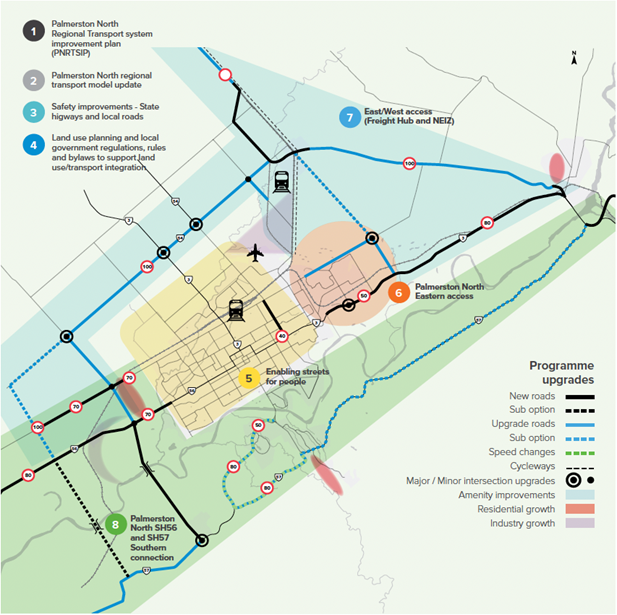
2.4 The
Ring Road will support these aims by creating a priority freight route around
the city. This will enable heavy vehicles to move around the city to access key
destinations such as Te Utanganui and reduce the number of heavy vehicles
travelling through the city.
2.5 Under
the programme Palmerston North City Council (PNCC), Horizons Regional Council
(Horizons), NZTA, and Manawatū District Council (MDC) all have different
projects that they contribute to the overall programme. The four organisations
have an ongoing working relationship to oversee the delivery of the programme.
2.6 Prior
to commencing the Ring Road project, the PNITI programme required PNCC to
complete an update of its Area Traffic Model (now known as the Strategic Transport
Model). The model would be required to model potential options in future
business cases. PNCC completed this updated in August 2024.
2.7 With
the model now completed, PNCC can now progress with the next stage, which is to
undertake an Indicative Business Case. The purpose of the Indicative Business
Case is to confirm the route of the Ring Road.
2.8 With
the route confirmed, we will be able to develop a high-level delivery plan and
start to implement improvements to support the Ring Road. Some improvements
will require more detailed business case work, such as the future second bridge
crossing. Other components can be delivered as a part of the council's road
improvements programme.
3. Overview of the Business Case Process
3.1 Under
the NZTA business case approach there are four different types of business
cases. These aim to identify an option that represent the best value for money
to resolve a problem (the case for change). The different type of business
cases are;
· Programme
Business Case – Identifies a combination of activities (a programme)
that represent the best value for money options for responding to response to
the case for change. Programme Business Cases typically have a five- to 30-year
horizon and take six to 12 months to develop.
· Indicative
Business Case – Identifies a preferred option to address the case for
change for an individual activity. Indicative Business Cases can be undertaken
as a part of a Programme Business Case. Indicative Business Cases are typically
initiated when an investment will be delivered within a 10-year horizon and
take six to 12 months to develop.
· Detailed
Business Case – Seeks to build a complete understanding of acceptable
risks, uncertainties and the benefits associated with the investment, so that a
final decision can be made on whether to implement it. Detailed Business Cases
are typically initiated when an investment will be delivered within a five-year
horizon.
· Single
Stage Business Case – merges the option identification of the
Indicative and the detailed analysis of the Detailed cases into one. Single
Stage Business Cases are typically initiated when an investment will be
delivered within a five-year horizon. The Single Stage Business Case Lite is a
pared-back version for non-complex activities where the whole-of-life cost is
less than $15 million.
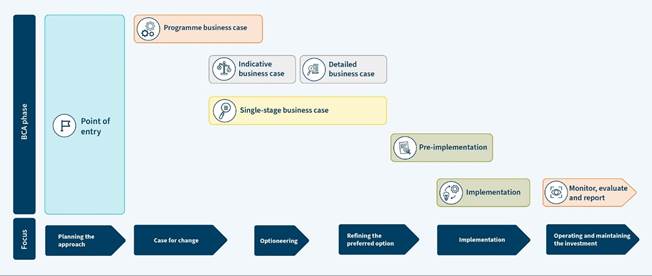
3.2 While
each business case has a different scale and timeframe, they all follow the
same structure. All business cases are broken up into 5 sections;
· Strategic
Case – This is where the case for change is laid out. The problem/s
and the Benefits to solving the problem/s are explained with supporting
evidence.
· Economic
Case – This is where the options for responding to the case for
change are identified and assessed. In this section, options are assessed to
find which one offers the best value for money.
· Commercial
Case – This is where the preferred option is demonstrated to have
commercial viability.
· Financial
Case – This is where the business case determines the affordability
of the preferred option.
· Management
Case – This is where the business case puts into place the
appropriate arrangements to ensure the preferred option can be successfully
delivered.
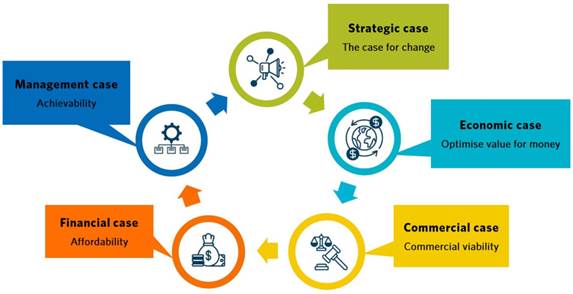
3.3 During
an Indicative Business Case, the bigger focus for the business case is on the
Strategic Case and the Economic case. The Commercial, Financial and Management
cases are provided as a high-level overview. Overall the Case should be able to
tell a coherent investment story, that can be clearly understood. It should
point to a reason for investment and clearly demonstrate why the preferred
option is the best option for addressing the problem.
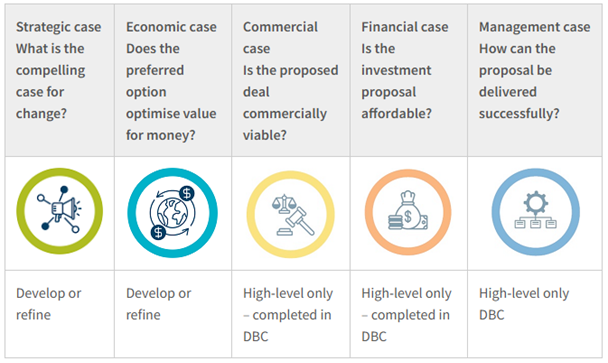
4. Starting the Manawatū Regional Freight
Ring Road Indicative Business Case
4.1 Because
of the specialist skills required and the amount work that goes into developing
a business case, the work to develop the Indicative Business Case will need to
be outsourced. PNCC is currently out to tender to find a suitable consultant to
undertake this work.
4.2 To
ensure that PNCC was clear to the market with want we want to achieve, Officers
have spent time developing the initial scope. Alongside officers from NZTA,
MDC, Horizons and CEDA, officers developed a draft set of problem statements
that we believe best make the case for change. Building on the work done in
PNITI, we have developed three problem statements based around Access, Safety,
and Increased Maintenance and Resilience.
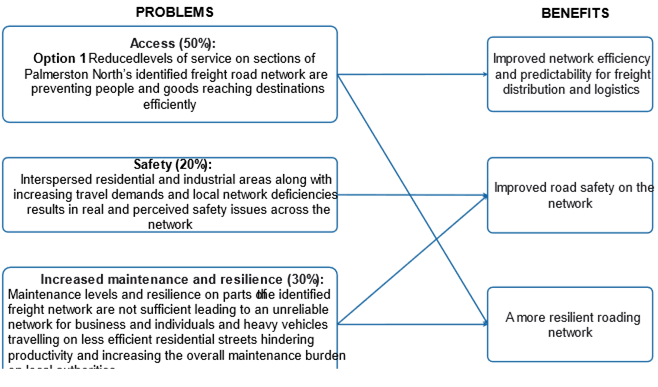
4.3 Officers
have provided potential consultants with this information and what we think
will be the key information/data required to support these problem statements.
4.4 This
information will be explored in more detail in the Strategic Case.
4.5 The
geographic scope of the business case looks at four areas;
· Ashhurst
to Bunnythorpe
· Bunnythorpe
to Kairanga
· Kairanga
to SH57
· SH57
between the new river crossing and Summerhill Drive
4.6 Officers
identified that the preference for this scope was to build on the work already
done in PNITI. For example, PNITI already ruled out the option of an upstream
bridge, so we wanted to make sure it was not relitigated through this
Indicative Business Case process. Doing this saves time and money and allows
the project to progress with a lot more ease.
4.7 The
options will be explored through the Economic Case.
4.8 The
final three sections of the business case will need to be more high level and
provide us with an outline of the next steps for progressing with the
Ring road
5. partner and Stakeholder EnGagement on the
Manawatū Ring ROad Indicative Business Case
5.1 At
this point we are still in a tender process, and we will not confirm our
process for engaging with our partner and stakeholders until we have selected a
consultant. Different groups will have differing levels of engagement
throughout the process.
5.2 PNCC
is currently working with NZTA, MDC, Horizons and CEDA through the PNITI
Management Group. This group manages the PNITI programme and works together at
an officer level to oversee the delivery of the programme's various projects.
5.3 At
the Governance level, these organisations are joined by Rangitāne,
Ngāti Kauwhata, Kiwirail and Palmerston North Airport Limited through the
Te Utanganui and PNITI Governance Group. This groups provide governance
oversight for Te Utanganui and PNITI.
5.4 Both
groups will have a key role in overseeing the project as we progress through
the various stages of the business case.
5.5 Alongside
the two groups above, the project will seek to engage with the following
throughout the project:
· PNCC
elected members
· MDC
elected members
· New
Zealand Defence Force (Linton Military Camp)
· Ministry
of Justice (Palmerston North Prison)
· Freight
and Logistics sector
· Automobile
Association
· Transpower
& Powerco
· Directly
Impacted Communities (Ashhurst, Bunnythorpe, Kairanga, Longburn, Linton)
5.6 This
is not a complete list, and we will need to refine this list as we progress
with the project.
6. Project Overview
6.1 Procurement
for a consultant is anticipated to finish in June 2025. Work on the Indicative
Business Case is expected to commence on 1 July 2025. This timing is based on
the availability of funding for the project.
6.2 We
are allowing 18 months for the business case to be completed. This is due to
the budget for the project being spread across years 2 and 3 of the Long- Term
Plan.
6.3 The
PNCC project manager will seek to provide two updates to the Economic Growth
Committee, one as close to 6 months into the project and one as close to 12
months into the project. Alongside this the officers will seek to provide
Elected Member updates at key milestones in the project.
6.4 Once
completed, the business case will be presented to the Economic Growth Committee
prior to submitting it to NZTA.
7. NEXT STEPS
7.1 Officers
to complete the procurement process. The procurement recommendation report is
to go to the Chief Executive for endorsement.
7.2 Officers
to provide Elected Member update with the outcome of the tender process.
7.3 Following
the signing of the contract, project kick-off meetings to commence.
8. Compliance and administration
|
Does the Committee have
delegated authority to decide?
|
Yes
|
|
Are the decisions significant?
|
No
|
|
If they are significant do they
affect land or a body of water?
|
No
|
|
Can this decision only be made
through a 10 Year Plan?
|
No
|
|
Does this decision require
consultation through the Special Consultative procedure?
|
No
|
|
Is there funding in the current
Annual Plan for these objectives?
|
No
|
|
Are the recommendations
inconsistent with any of Council’s policies or plans?
|
No
|
|
The recommendations contribute to:
Whāinga 1: He
tāone auaha, he tāone tiputipu
Goal 1: An innovative and growing city
Whāinga 4: He
tāone toitū, he tāone manawaroa
Goal 4: A sustainable and resilient city
|
|
The recommendations contribute to this
plan:
3.
Mahere tūnuku
3. Transport Plan
The objective is: Provide a safe, low-carbon, integrated
and multi-modal transport network
|
|
Contribution to strategic
direction and to social, economic, environmental and cultural well-being
|
The Manawatū Regional
Freight Ring Road will support the efficient movement of freight outside of
the city. This will allows the council to make the urban road network safer
and more accessible for all modes.
|
|
|
|
Attachments
Nil
Memorandum
TO: Economic
Growth Committee
MEETING DATE: 9
April 2025
TITLE: Palmerston
North Quarterly Economic Update - April 2025
Presented
By: Stacey
Andrews, City Economist
APPROVED BY: David
Murphy, General Manager Strategic Planning
RECOMMENDATION TO
COMMITTEE
1. That Committee
receive the Palmerston North Quarterly Economic Update – April 2025,
including:
a. Palmerston North
Economic Growth Indicators - April 2025 (Attachment 1), and
b. Palmerston North
Quarterly Economic Card Spending Report – December 2024 (Attachment 2),
presented to the Committee meeting
on 9 April 2025.
1. introduction
and purpose
1.1 This
memorandum presents a summary of the key themes in the Palmerston North
Quarterly Economic Update to April 2025, and the Palmerston North City Centre
Quarterly electronic card spending (retail and selected tourism sectors) for
the December quarter 2024.
1.2 The
quarterly economic update is prepared in-house, using data from a range of
sources to provide the most up-to-date information available on the city
economy. This includes national and global data where appropriate, to
inform us of broader conditions that are impacting on local economic
conditions.
1.3 The
quarterly economic update is organised under the categories of ‘Gross
Domestic Product (GDP) and national indicators’, ‘business and
jobs’, ‘earnings and income’, ‘spending’, and
‘housing’. National data that influences the city economy,
such as the Consumer Price Index (CPI) and the Official Cash Rate (OCR), are
also included in the quarterly economic update. This update is attached
as Appendix 1.
1.4 The
Palmerston North City Centre Quarterly electronic card spending report is
prepared in-house and provided as a resource to the city retail sector. This
report includes information on retail spending across the city and by precinct,
as well as data on retail flows, customer loyalty, and the origin of customers
who are spending in Palmerston North. The electronic card spending report
for the city is included as Appendix 2.
1.5 Section
2 of this report includes a high-level summary of economic outcomes for the
city to April 2025. A more in-depth analysis of economic performance,
including the economic outlook for the city, is included within sections 3 to 5
of this report.
2. Economic
summary
2.1 Economic
activity is showing some early signs of recovery as inflation remains subdued,
housing market indicators improve, commercial vehicle investment starts to
recover, elevated returns to the agricultural sector continue, and business
confidence remains relatively positive.
2.2 While
an improvement in economic activity is signalled in the latest data, there is
still considerable pressure on the New Zealand economy. Consumer confidence
remains downbeat, weakness in construction activity continues, job numbers are
down, and concerns over the global growth outlook are hindering confidence.
These factors are weighing on consumer demand for goods and services and
placing businesses under pressure. Falling interest rates and repricing
from higher onto lower mortgage rates throughout 2025, are expected to support
spending across the economy and support business activity. It will take
time however, for lower interest rates to flow through to demand, with the
Reserve Bank of New Zealand (RBNZ) anticipating that positive economic impacts
will be felt in the second half of 2025.
2.3 The
New Zealand economy is expected to continue to strengthen throughout 2025 as
lower interest rates flow through to businesses and households, and elevated
commodity prices and strong demand for New Zealand exports, boost the economic
performance of regional New Zealand. Increasing trade barriers and the
potential impacts on global economic growth, however, pose a risk to the pace
of economic recovery here in New Zealand. At the time of writing the detail of
trade tariffs, and how they may impact on the New Zealand economy, is unclear.
Recent events would imply that U.S. trade tariffs may not be as onerous as
previously signalled by the Trump administration, but much uncertainty remains.
Events are being watched closely by the economics team, to understand impacts
on the city, regional, and national economy.
2.4 The
December quarter 2024 returned the New Zealand economy to positive growth after
two consecutive quarters of negative growth, with national GDP rising +0.7%
compared with the September quarter 2024. This was a welcome surprise,
with forecasters estimating quarter on quarter growth of between +0.3% and
+0.5%. Unsurprisingly, growth was particularly strong in the
‘Agriculture, forestry and fishing’ sector, rising by +1.4%
year-on-year.
2.5 On
an annual basis, national GDP remained in contraction, down -0.5% compared with
the year ended December 2023. In the city, GDP fell a relatively positive
-0.2%. The ‘relative strength’ of the Palmerston North
economy, has been driven, in-part, by our position at the heart of a strong
rural economy.
2.6 Business
numbers increased +0.6% in Palmerston North over the year to December, with an
additional 47 businesses established. This was lower than national growth
of +1.3%. At the same time, 903 jobs were lost in Palmerston North over
the year (-1.9%). This compares with a -1.6% decrease in jobs,
nationally. The unemployment rate in Palmerston North remains stable at
4.2% due, in part, to some people leaving the labour force in response to
weaker labour market conditions. Increasing Jobseeker beneficiary numbers
reflect the current labour market weakness with recipients in Palmerston North
up +14.5% alongside a +12.4% increase in Jobseeker benefits,
nationally.
2.7 Annual
earnings growth has eased as expected in response to these weaker labour market
conditions. Total earnings from salaries and wages increased 4.0% in the
city over the year, compared with 4.5% growth nationally. These earnings
figures exclude income from self-employment.
2.8 Tourism
and consumer spending remains soft, with the exception of new commercial
vehicle registrations which increased by +9.0% in Palmerston North over the
December 2024 year. This compares with +4.4% growth nationally, over the
same timeframe.
2.9 The
housing market is showing signs of strengthening, with sales in the city up
10.6% over the year to February 2025 compared to an increase of 10.4%
nationally. At the same time, house prices remain flat with the average
price easing -0.7% over the year to a value of $637,895. This compares
with a -1.4% decrease in house prices nationally to an average value of
$912,904. Housing continues to be far more affordable in Palmerston North
than at the national level, with the average property in the city equal to 5.0
times the average city income. This compares with the average house price
of 6.7 times the average household income, nationally.
2.10 Weekly
rental prices increased by +3.2% in the city over the year to January 2025, to
an average price of $482 per week. This compares with an average weekly
price of $596 nationally. There were 141 fewer properties rented in
Palmerston North in January 2025 compared with January 2024. This may
reflect spare capacity to cater for incoming demand for the academic year, an
increase in houses sold as reflected in the annual house sales data for the
city, and/or a decrease in demand. Further months of data will provide
greater insight into rental property supply and demand
conditions.
2.11 New
dwelling consents increased +8.0% over the year to December 2024, to a total of
458. This compares to a -9.8% decline in dwelling consents, nationally.
Of these 458 consents, a net 356 dwellings are expected to be added to the
dwelling stock (77.7%). In contrast, non-residential consent values declined
by -32.3% over the year as several large-scale public projects were completed
in the city. Of note, construction values for ‘hotels, motels and
other short-term accommodation’ increased to $5.6 million over the year,
with investment in social, cultural and religious buildings’ and
‘storage buildings’ also increasing substantially over the
year.
2.12 Section 2
of this report includes a high-level summary of economic outcomes for the city
to December 2024. A more in-depth analysis of economic performance, including
the economic outlook for the city, is included within sections 3 to 5 of this
report.
3. Quarterly
economic Update
Gross
Domestic product and national indicators
3.1 Infometrics
reports that Palmerston North GDP fell by -0.2% over the year to December 2024
as economic activity remained subdued due to the lingering impacts of
restrictive monetary and fiscal policy. This compares with a -0.5%
contraction in the New Zealand economy over the same timeframe.
3.2 More
recently, Statistics New Zealand has released the latest national GDP figures,
revealing that GDP grew above expectation at +0.7% between the September
quarter and the December quarter 2024. This
result was a welcome surprise, with commentators estimating quarterly growth of
between +0.3% and +0.5%. Unsurprisingly, growth was particularly strong
in the ‘Agriculture, forestry and fishing’ sector, increasing +1.4%
over the year. GDP growth was also supported by a lift in activity in
distribution and logistics, health care and social assistance, and tourism
related sectors. Despite the stronger than expected result in the
December quarter, national GDP still contracted by -0.5% in the 2024 calendar
year, compared with 2023.
3.3 The
‘relative’ strength of the city economy has been driven in-part, by
our position at the heart of a strong rural economy. Commodity prices for
goods produced in the wider region have increased strongly over the past
12-months while, at the same time, interest rate pressures have eased.
Elevated returns for agricultural products alongside easing interest rates, are
contributing to profitability in the agriculture sector and supporting the
economic recovery of the regions.
 Figure
1: Manawatū-Whanganui export goods and values (2024)
Figure
1: Manawatū-Whanganui export goods and values (2024)
Source: Infometrics, Regional Economic Profile,
2024
3.4 The
latest ASB commodity price index reflects the rate of increase in prices for
goods produced in our region, with dairy prices rising 13.5% over the year and
sheep and beef prices up +20.7%. Supporting New Zealand Inc., fruit
prices have also been well supported, rising by +16.8%, while forestry prices
continue to come under pressure, down -7.4% over the year. Strong global
demand and elevated pricing is benefiting our largest agricultural producers,
supporting economic activity in the region amidst wider economic
challenges. These favourable conditions are reflected in the latest
Rabobank farmer confidence survey, with sentiment at its highest level since
2017.
3.5 Risks
to global economic activity remain elevated as uncertainty from shifting United
States (U.S.) policy, looks set to continue. How this will play out in
reality is uncertain. On the one-hand, actual and threatened tariffs
could redirect international demand to New Zealand products, boosting export
returns to our producers. On the other hand, tariffs placed on our
trading partners could slow economic growth within these countries, reducing
incomes and weighing on demand for New Zealand products. More directly,
if tariffs are placed on agricultural goods coming into the U.S., this would
directly affect our producers with lower U.S. demand the likely outcome.
It is worth noting that the U.S. is New Zealand’s second largest export market,
with a total of $9.2 billion in exports to the U.S. over the year to January
2025. Beef is our largest export to the U.S., worth over $1.9 billion in
value over the year. This is approximately 40% of the total value of New
Zealand’s annual beef exports. The U.S. is also a substantial
market for our wine producers with around 36% of total export values earned
from exports to the US in the year to January 2025.
Figure 2: New Zealand
exports into the United States (YE January 2025)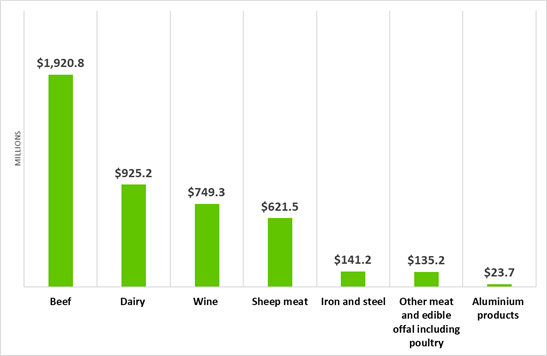 Source: Statistics New Zealand, harmonised trade
exports, January 2025
Source: Statistics New Zealand, harmonised trade
exports, January 2025
3.6 Tariff
concerns are also front of mind for central banks as they grapple with the
potential for lower growth amidst higher inflation. The endgame for
global interest rates is uncertain. Initial fears are that the added cost
of tariffs to importers would be passed on to businesses and consumers,
fuelling inflation and pushing up global interest rates. As risks have
continued to elevate, concerns have shifted toward fears of lower global growth
and higher unemployment alongside elevated inflation, as tariffs weigh on
global confidence and economic activity. Amidst the increasing risk of
weaker global growth, lower interest rates also become a possibility should
suppressed demand and investment sufficiently weaken the global economy and
inflation. This would require central banks to reduce interest rates to
stimulate economic activity supporting the recovery of the global
economy. The risk of lower global growth, as a result of U.S. tariffs, is
reflected in the latest OECD interim global growth report, which has revised
expectations of global growth down from 3.3% to 3.1% in 2025, and 3.3% to 3.0%
in 2026.
3.7 What all this means for the New Zealand economy is
unclear. One thing is for sure, uncertainty is never positive for
investment and economic activity. New Zealand businesses exposed to these
risks may sit on planned investment awaiting greater certainty while volatility
in currency, equity and bond markets, are weighing on investment across the
wider global economy and pushing up debt servicing costs for both governments
and the private sector.
3.8 On
the upside, back at home annual inflation (as measured by the Consumer Price
Index) remained at 2.2% for the second consecutive quarter in December 2024,
falling from its peak of 7.3% in the June quarter 2022. Declining prices
for goods we import into the country has been driving much of the annual
decrease in consumer inflation, with imported (tradeable) inflation falling by
-1.1% over the 2024 calendar year. In contrast, domestic inflation
has remained elevated, with prices for domestically produced goods and services
rising 4.5% over the year. The largest contributors to the increase in
domestic inflation were rental prices, followed by local authority rates, and
prices for cigarettes and tobacco. The first two are set to ease pressure
on domestic inflation in 2025.
3.9 In
response to weaker than expected economic activity and lower inflation, the
RBNZ has continued to cut the OCR, with an additional 50bp drop at the most
recent monetary policy review in February 2025. At the time of writing,
the OCR sits at 3.75% with the next rate review scheduled for 9 April.
Further rate reductions are expected this year with a 25 basis points drop forecast
for the April review. The OCR is currently forecast to fall to 3.1% in
the first quarter of 2026.
Business and jobs
3.10 There were
8,185 businesses in Palmerston North in December 2024; an increase of 47
businesses from the previous year. This is an increase of +0.6% over the
year, compared with +1.3% growth in business counts, nationally.
3.11 The
three-year business survival rate highlights the percentage of businesses that
continue to operate after three-years, as an indicator of business resilience.
The latest data to February 2024, indicates that 56.8% of businesses in
operation in February 2021 continued to operate in February 2024. This is
a slight increase in the percentage compared with the 2023 year, where 55.6% of
businesses remained in operation after three-years. The previous
five-years have been a period of elevated economic volatility, with survival
rates ranging between 55.5% to 58.5% in the city over this period.
National business survival rates have exceeded survival rates in the city since
2020.
 Figure
3: Three-year business survival rate – Palmerston North (2021-2024)
Figure
3: Three-year business survival rate – Palmerston North (2021-2024)
Source: Statistics New Zealand, Business Demography
3.12 Non-residential
consents totalled $126.4m in the city in the 2024 calendar year, a decline in
value of -32.3% compared with 2023. This compares with a -0.9% decline in
non-residential consent values, nationally. The decline in
non-residential consent values in the city was driven by the completion of a
number of large-scale public infrastructure projects, with
‘education’ and ‘healthcare’ construction values
falling by -78.7% and -96.0% respectively over the year. In contrast, construction
values for ‘hotels, motels and other short term accommodation’
increased by 138.2% to $5.6 million over the year. Strong growth in
consent values for ‘social, cultural and religious buildings’ and
‘factories, industrial and storage buildings’ was also recorded in
the city over the year, rising by 190.4% and 39.2%
respectively.
3.13 The
Seek Employment report for January 2025 showed a slight improvement in labour
market conditions in the Manawatū Region in January 2025, with the number
of jobs advertised increasing by +5% compared with the previous year.
This compares with a +4% increase in jobs advertised nationally over the same
time period. This improving trend follows a challenging year, where the
number of jobs advertised fell by -29% in the region, compared with a -17% fall
nationally. Nationally, ‘banking and financial services’,
‘mining resources and energy’ and ‘government and
defence’ were the only three sectors where job ads increased
year-on-year. Applications per job advertisement increased the most across
‘education and training’ (+18%), ‘customer service’
(+14%) and ‘construction’ (+12%) roles.
3.14 Excluding
self-employment, there was a total of 46,925 jobs located in Palmerston North
in December 2024. This is 903 fewer jobs than December 2023, down -1.9%
from the previous year. This compares with a -1.6% decline in the number
of jobs nationally over the same period. Filled jobs by place of place of
residence followed a similar trend with people in employment in the city
falling by -815 (-2.3%) to 35,118 over the year. This compares with a decrease
in people employed nationally of 1.6%.
3.15 The annual
average unemployment rate in the city remained at 4.2%, for the second
consecutive quarter, falling from 4.4% in the first two quarters of 2024. This
compares with an annual average unemployment rate of 4.7% nationally. For
the December quarter, the unemployment rate in the city was 4.6% compared with
a national unemployment rate of 5.0%. Statistics New Zealand estimated a
national unemployment rate of 5.1% in the December quarter, with a total of
156,000 people unemployed.
3.16 The number
of MSD jobseeker beneficiaries in Palmerston North increased by 447 over the
year to September, to a total of 3,534. This is a +14.5% increase (+447)
on the previous year, compared with a +12.4% increase, nationally. Of this
increase, 312 people were receiving the benefit due to health conditions and
disability, compared with an increase in work-ready jobseekers of 135 over the
year.
3.17 The number
of jobseekers increased across all age groups both in the city and nationally,
in the 2024 calendar year. Jobseeker beneficiaries aged 18-24 increased
by 138 in the city over the year (+18%), compared with a +19.6% increase
nationally. Over the same period, Palmerston
North Jobseekers aged 25-39 rose by 141 (+13.3%) compared with a +12.0%
increase nationally, with Jobseekers aged 40-54 rising by 87 (+11.1%) in the
city, compared with a +9.4% increase nationally. Palmerston North
Jobseekers aged 55-64 increased by 87 (+18.5%), compared with a +9.6% increase
nationally.
Earnings and income
3.18 Following
high earnings growth over the period 2021 to early 2024, wage inflation is
starting to ease with annual earnings growth falling back to 4.0% in the city
in 2024. This compares with 4.5% growth in annual earnings,
nationally. This period of high earnings growth coincided with public
sector pay agreements and tight labour market conditions from 2021 to early
2024, where competition for labour was elevated, and wages were bid up to
attract appropriately skilled workers.
3.19 Statistics
New Zealand Linked Employer-Employee Data (LEED) measures median earnings from
wages and salaries, including incomes from self-employment. This data has
a twelve month lag and therefore estimates median earnings growth to December
2023; a period characterised by elevated wage growth due to pay agreements and
higher wages being paid to attract scarce labour. Reflecting this
elevated wage growth, median earnings in Palmerston North city increased by
+8.3% over the year to December 2023 to a total of $67,700. This compares with
a +6.0% increase nationally to a median salary of $68,590. The rate
of growth in median incomes is expected to have eased in 2024, reflecting the
more recent weakness in economic and labour market conditions.
3.20 Easing
wage growth is reflected in the Quarterly Economic Survey (QES) for ordinary
time hourly earnings, and the Labour Cost Index (LCI) for the December 2024
year. These measures of wage growth indicate that ordinary time hourly earnings
increased by +4.2% over the 2024 calendar year, compared with a +6.9% increase
in 2023. The LCI also reflects the easing of wage inflation with the
increase in labour costs falling to 3.0% in 2024, compared with a 3.9% increase
the previous year.
Spending
3.21 Retail spending
fell -1.8% in the city over the year to February 2025, to a total of $1,480m
($1.48b). This compares with a -1.1% decrease in retail spending
nationally. It is worth noting that 2024 was a leap year, therefore
February 2024 comprised of 29 days in comparison to 28 days in February
2025. Retail spending is also in dollar value and does not account for
the impact of inflation on the purchasing power of consumers.
3.22 As
discussed, the annual rate of inflation in 2024 was 2.2% with an increase in average
household living costs of 3.0% over the year. The annual rate of spending
growth continues to come in well below the rate of annual inflation, reflecting
a decline in real spending across the economy. The contraction of demand
driven by higher interest rates and fiscal policy has successfully driven down
inflation, but it has delivered challenges to the New Zealand economy, driving
job losses and higher unemployment. Further relief from lower interest
rates is expected to support an increase in spending across the national
economy through 2025, but the recovery is expected to be gradual.
3.23 The
pressure on household budgets is further reflected in the decrease in spending
on discretionary items. ‘Home and recreational retail’
spending in the city fell by -13.9% over the year to February 2024, with
spending on ‘Arts, recreation and visitor transport’ down -16.5%
over the same period.
3.24 New car
registrations in Palmerston North fell by -10.0% over the year to December
2024, compared with a -17.6% decrease nationally. Reflecting improving
business confidence, the number of new commercial vehicle registrations
increased by +9.0% in 2024 compared with the previous year. This compares
with a +4.4% increase nationally. This uplift in expenditure on
commercial vehicles in the city, is likely to have been supported by renewed
confidence of our agriculture sector.
3.25 Annual
tourism spending fell by -2.7% in Palmerston North in the year to January 2025,
compared with the previous year. This compares with a +1.5% increase in
tourism spending nationally. Tourism spending continues to be weighed
down by a pullback in spending by domestic travellers, with domestic tourism
spending falling by -3.5% over the year to January 2025 to a total of
$270.9m. This compares with a -2.3% fall nationally. International
tourism spending continued to strengthen in the January 2025 year, with
spending in the city up +6.5% and a 14.2% increase in national
spending.
3.26 The annual
change in guest nights is also a useful indicator of tourism activity.
Over the year to January 2025, guest nights in the city fell by -3.1% to a
total of 422,500. This compares with a +0.5% Increase nationally.
Reflecting the downturn in domestic tourism, guest nights from domestic
travellers fell by -3.1% in
Palmerston North over the same period, compared with a -2.5% decrease
nationally. Guest nights from international travellers to the city fell
by -4.2%, compared with a +6.9% increase nationally.
Housing
3.27 According
to QV, house prices in Palmerston North fell by -0.7% over the year to February
2025 to an average price of $637,895. This compares with a -1.4% fall
nationally to $912,904. The volume of houses sold in Palmerston North
over the year reflects strengthening demand, with the number of houses sold up
+10.6% over the year to a total of 1,278. This compares with a +10.4%
increase in house sales, nationally. The February 2025 RBNZ Monetary
Policy Statement reflects the expectation of a moderate strengthening of
housing market conditions this year, with prices expected to increase by +3.8%
in 2025, and a further +4.7% in 2026.
3.28 Total New
Zealand mortgage lending increased to $77.0 billion in the year to January
2025, compared with $62.8 billion the previous year. This represents a
+22.6% increase in mortgage lending in the January 2025 year. Mortgage
lending to owner-occupiers and investors increased the most, up $7.9 billion
(+21.8%) and $4.8 billion (+45.2%) respectively. Lending to first home
buyers lifted by $1.3 billion (+8.9%) over the same period.
3.29 Home
ownership continues to be far more affordable in the city than nationally, with
the average house price equal to 5.0 times the average annual household
income. This compares with the average house price of 6.7 times the
average household income, nationally.
3.30 Rental
prices increased 3.2% in the city over the year to January 2025, to an average
price of $482 per week. This compares with a +1.9% increase nationally,
to $596 per week. Over the same period, the number of properties rented
in the city fell by -1.8% with 141 fewer properties rented in the city in
January 2025 compared with January 2024. This compares with a +2.2%
increase in rental properties nationally, over the same period. The fall in
rented properties in the city in January, is possibly due to this data
preceding the start of the academic year. Rental market conditions will be
tracked closely to understand any changes to supply and demand
conditions.
3.31 Renting a
home in Palmerston North remains more affordable than across much of New
Zealand, with annual average rent making up an estimated 19.8% of annual
household income, compared with 22.0% nationally. Renting in the city is more
affordable than both the Manawatū District and the wider
Manawatū-Whanganui region, with average annual rent taking up 21.1% and
21.7% of the average household income, respectively.
3.32 The number
of households on the public housing register in Palmerston North fell by -129
(-20.6%) over the year to December 2024. This compares with a -20.0% fall
nationally. The number of families on the transfer register in Palmerston
North sat at 147 in the December quarter 2024, down from 177 a year ago
(-16.9%) compared with a 9.5% fall nationally.
3.33 Households
in emergency housing in Palmerston North fell to 6 in December 2024, down from
63 in December 2023. The number of families in emergency housing,
nationally, fell from 2,931 in December 2023 to 945 in December 2024. Some of
the decrease in the number of families accessing housing support will be
explained by the increased level of evidence required to prove housing
need. Insights from MSD in the city also highlight an increase in
tenancies available and stabilising rental prices in the
city.
3.34 There were
458 consents for new dwellings issued in Palmerston North over the year to
December 2024, an increase of 34 (+8.0%) compared with the previous year. This
compares with a -9.8% decrease in new dwelling consents nationally. New
dwelling consents have been trending down since the peak of the market in the
city over the 2021 calendar year. Economic recovery and improving
financial market conditions are expected to support levels of residential
investment from 2026.
3.35 Provisional
data estimates that a total of 356 of the 458 dwellings consented over the 2024
Calendar will add to the housing stock of Palmerston North. This series
removes ‘relocates’ moved outside the city, adds in
‘relocates’ coming into the city from other parts of New Zealand,
and removes uplifted dwellings. This estimate compares with the housing
demand forecast in the 2024-34 LTP of 328 dwellings per year from 2024-2027,
with 399 dwellings per year on average over the 10-years to 2034[1].
4. Palmerston
North electronic card spending report – December 2024
4.1 Total
electronic card spending fell -1.1% in the December quarter 2024 compared to
the December quarter 2023, to a total value of $403m. This compares with
a -0.7% decrease in spending nationally over the same period.
4.2 Over
the year to December 2024, electronic card spending in Palmerston North fell by
-0.8% to $1.488 billion. This compares with a +0.1% increase in retail
spending nationally over the same period. Of this total, 56.1% continues
to be spent in the city centre.
4.3 In
the city centre, spending in the December quarter 2024 increased by 0.2%
compared with the December quarter 2023, to a total value of $231 million. This
compares with a -0.7% fall in retail spending, nationally.
4.4 Over
the December 2024 year, electronic retail card spending in the city centre fell
-0.2% compared to the previous year, to a total value of $837 million.
This compares with an increase in retail spending of 0.1%, nationally.
4.5 Discretionary
spending has been most affected by the pullback in consumer demand with
‘home & recreational retail’ spending down -3.9% and
‘arts, recreation & visitor transport’ spending falling -6.5%
in the city centre over the year. Spending on ‘home & recreational
retail’ and ‘arts, recreation & visitor transport’ was
down -4.0% and -4.4% respectively, in Palmerston North over the same
timeframe. Nationally, spending on ‘home & recreational
retail’ and ‘arts, recreation & visitor transport’ fell
by -2.8%, and -4.2% over the year.
4.6 Spending
on essential items continued to increase as households and businesses reduced
spending on discretionary items. Spending on ‘groceries and
liquor’ was the highest growth sector in Palmerston North, up +2.2%
compared with the previous year. The trend for grocery spending was
similar for the city centre and New Zealand, up by +4.0% and +2.7% respectively
over the year.
4.7 Spending
on ‘cafes, restaurants, and bars’ fell further over the December
year, down -1.7% across the city and -1.3% in the city centre. This
compares with a -0.2% fall in spending, nationally. Increasing demand for
non-essential spending is expected to flow through to the city and national
economy later in 2025, as relief from lower interest rates and improving
business and consumer confidence boosts spending across the economy.
4.8 ‘Other
consumer spending’ continues to rebound in the city with spending in the
sector increasing +71.2% in the city centre and +22.9% across Palmerston North
over the year. This compares with a +1.7% increase nationally over the
same period. While ‘Other consumer spending’ makes up just
+0.1% of total spending in the city, the increase in spending on these
non-essential items implies an improving appetite for discretionary
spending.
4.9 Palmerston
North consumers remain relatively loyal to local merchants. The loyalty
rate, explained as the percentage of spending by Palmerston North residents at
local retailers, was 81.5% over the year to December 2024. Across the
Manawatū Region, the loyalty rate increases to 82.9% as consumers from the
Manawatū District contribute to spending in the city.
4.10 The
Quarterly Economic Card Spending Report for December 2024 is attached as
Appendix 2.
5. Economic outlook
5.1 The latest round of
economic data reflects some early and tentative signs of recovery in both the
New Zealand and city economy, with annual GDP growth becoming less negative and
business sentiment improving across key sectors such as agriculture. Palmerston
North’s position at the heart of a strong rural economy, was central to
the stronger economic performance of the city, with elevated returns to
agricultural production boosting the outlook for regional economies, relative
to our larger metropolitan counterparts. Economic growth is expected to
be positive as we progress through 2025.
5.2 The data also reflects the challenges that remain across
our economy. Job losses and higher unemployment remains, and households
continue to be hampered by the high cost of living and concerns over job and
income security. While interest rates have been falling since August
2024, it is taking time for these lower rates to flow through and deliver
relief to households and businesses. Combined with risk aversion from increasing
job insecurity, and concerns over levels of demand by businesses, consumption
has understandably been slow to respond to the easing interest rate
environment.
5.3 Westpac estimates
around half of all mortgages will come up for re-fixing in the next six-months,
with the majority of these coming off higher interest rates onto lower
rates. This is expected to boost disposable incomes in the second half of
2025, stimulating demand for goods and services across the New Zealand
economy. This is expected to positively impact on demand for goods and
services, and it follows, levels of employment across the country, with the
number of people employed forecast to rise by 80,000 between March 2025 and
December 2026. The unemployment rate is forecast to peak at 5.2% in the
March and June quarters this year falling back to 4.5% by the end of
2026. New Zealand is in the early stages of economic recovery, but there
is some way to go.
5.4 While projections
reflect the expectation of strengthening economic conditions in 2025, there are
external factors which may pose a risk to the economic recovery of the New
Zealand economy. The potential impact of U.S. tariffs on economic growth
is discussed in sections 3.5 to 3.7 of this report. The government is proactively
strengthening relationships with countries where the mutual benefits of
increased trade, are high. These efforts are reflected in recent Free
Trade Agreements (FTAs) with the United Arab Emirates (UAE) and Vietnam, with
FTA discussions currently underway with India. Building strong and
mutually beneficial trade and security relationships with global partners, is
critical to building the resilience of the New Zealand economy, in the face of
mounting international challenges.
5.5 Assuming impacts on
the New Zealand economy from trade tariffs are limited, pricing for commodities
produced in our region such as dairy, are expected to remain elevated for the
next two seasons, supporting the economic recovery of the city and the
region. The repricing of the majority of mortgages from higher onto lower
rates throughout 2025, will also support spending across the economy, and flow
through to business investment and labour demand in time. The completion
of large scale infrastructure projects such as Te Ahu a Turanga (the
Manawatū Tararua Highway) will further support the regional economy,
reducing transport costs and relieving travel times for businesses and
residents.
5.6 The wellbeing of
our people is also fundamental to achieving the economic objectives of our
nation and our region, with a healthy, housed, and skilled workforce central to
economic growth and prosperity.
5.7 Economic conditions
remain challenging, but the New Zealand economy is moving in the right
direction with inflation well back in range, interest rates falling and
business confidence strengthening in 2025. Uncertainty from external
factors look set to continue, with the impacts on the New Zealand and city
economy, unclear. Factors that impact on the city, regional and national
economy will be watched closely and reported back to Committee throughout 2025.
6. Compliance
and administration
|
Does the Committee have
delegated authority to decide?
|
Yes
|
|
Are the decisions significant?
|
No
|
|
If they are significant do they
affect land or a body of water?
|
No
|
|
Can this decision only be made
through a 10 Year Plan?
|
No
|
|
Does this decision require
consultation through the Special Consultative procedure?
|
No
|
|
Is there funding in the current
Annual Plan for these objectives?
|
Yes
|
|
Are the recommendations
inconsistent with any of Council’s policies or plans?
|
No
|
|
The
recommendations contribute to: Whāinga 1: He tāone
auaha, he tāone tiputipu
Goal
1: An innovative and growing city
|
|
The recommendations contribute to this
plan:
2.
Mahere whakawhanake ohaoha
2. Economic Development Plan
The objective is: Support sustainable business activity
and labour market development, in particular, providing information and
education resources to city businesses.
|
|
Contribution to strategic
direction and to social, economic, environmental and cultural well-being
|
Reporting on economic trends
in the city and the longer-term outlook for growth, is important for
encouraging local business to invest, growing their business and attracting
new businesses to the city. It is also important to support businesses
to make informed decisions under the current economic conditions.
|
|
|
|
Attachments
|
1.
|
Palmerston
North Economic Growth Indicators - April 2025 ⇩ 
|
|
|
2.
|
Palmerston
North Retail Electronic Card Spending Report - December 2024 ⇩ 
|
|
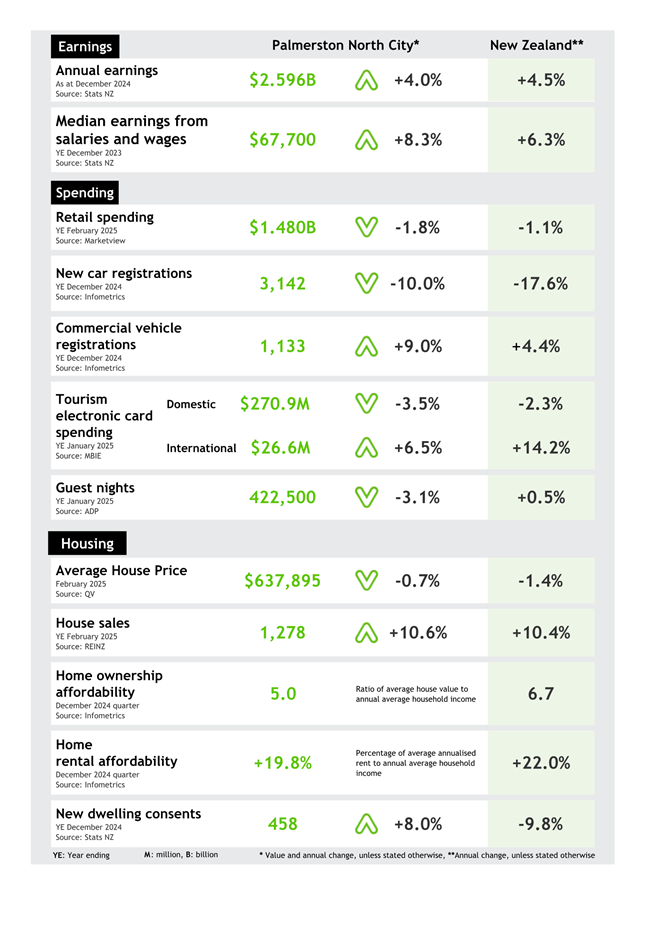
Memorandum
TO: Economic
Growth Committee
MEETING DATE: 9
April 2025
TITLE: 6
month report on International Relations and Education Activities
Presented
By: Gabrielle
Loga, Manager International Relations
Kate Harridge, International Relations and Education Advisor
APPROVED BY: David
Murphy, General Manager Strategic Planning
RECOMMENDATION TO Economic Growth Committee
1. That the
Committee receive the ‘6 month report on International Relations and
Education Activities’, presented to the Economic Growth Committee on 9
April 2025.
1. ISSUE
1.1 The
purpose of this memorandum is to update the Economic Growth Committee on the
development of Palmerston North’s key international relations and
education activities over the past six months and their contribution to the
relevant goal, strategy and plan.
2. BACKGROUND
2.1 On
5 June 2024, Council accepted the following goals set for the city’s
international relations and education in 2024-2025:
· Increase
international exchange & cooperation to strengthen local economies and
preparedness for future challenges.
· Increase
promotion of the city and engagement with international partners to enhance the
city’s attractiveness as a tourism as well as a preferred study
destination.
· Foster
economic diversification and growth by facilitating new connections for local
businesses, supporting emerging industries, and promoting innovation and
entrepreneurship.
· Build
up cultural competence, expertise and experience in international affairs
across Council and within the city, with a focus on engaging the youth for the
sustainability of Council’s international connections.
2.2 This
report outlines the key international relations and education activities since
October 2024 and measures them against the agreed goals. It also provides an
updated activity schedule from the International Relations and Education Annual
Plan 2024-2025.
INTERNATIONAL RELATIONS
3. Highlights
of the global/national context
50th Anniversary of New Zealand and ASEAN
Relations
3.1 New
Zealand formalised its relationship with the Association of Southeast Asian
Nations, or ASEAN in 1975. In 2025, New Zealand will celebrate 50 years of
dialogue relations with ASEAN.
3.2 ASEAN
is New Zealand’s fourth largest trading partner with total trade value at
$27.02 billion, ahead of the United States and behind China and Australia.
ASEAN’s economic outlook remains positive with regional real GDP growth
of 4.7% in 2024 and 4.8% forecast for 2025, outperforming the global average.
With its commitment to sustainable agriculture and enhancement of cooperation
in agricultural sector, ASEAN continues to be a critical trading partner of New
Zealand. (Source: New Zealand Ministry of Foreign Affairs and Trade, 2024)
3.3 Within
ASEAN, Viet Nam is the fastest growing and stable economy with a projected GDP
growth of 6.5% for 2025. With few trade barriers, a population of over
100 million people and a growing middle class, Viet Nam has been identified as one of the top
export growth opportunities for New Zealand.
New Zealand’s
top exports to Viet Nam
are education, dairy, timber and horticulture. (Source: New Zealand Ministry
of Foreign Affairs and Trade, 2024)
3.4 Prime
Minister Luxon’s recent visit to Viet Nam saw an accession to the
Comprehensive Strategic Partnership between the two countries and the
announcement of a new direct flight between Auckland and Ho Chi Minh City for
four times a week by VietJet. There is an expectation of increasing tourists
and international students from Vietnam to New Zealand. (Source: https://www.stuff.co.nz/travel/360596326/new-zealands-new-low-cost-flight-standout-vietnam-great-news)
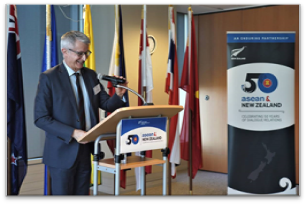
Figure
1 - Secretary of Foreign Affairs and Trade Bede Corry at the launch of 50th
anniversary commemorations. (Source: MFAT website)

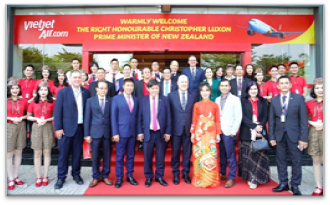
Figure 2 - Prime Minister Luxon visited
Vietnam in Feb 2025 and attended the announcement of VietJet's direct flights
between Auckland and Ho Chi Minh City
U.S Imposed Tariffs on Canada, Mexico And China -
Implications for New Zealand
3.5 The
United States is New Zealand’s third largest trading partner with a total
trade value of $28.06 billion, after China and Australia. It is a significant
source of foreign direct investment, education, tourism, and innovation.
Despite New Zealand’s strong focus on free trade and its pursuit of Free
Trade Agreements, there is no agreement between New Zealand and United States.
However, the two countries have had a Trade and Investment Framework Agreement
in place since 1992. Commercial ties between New Zealand and the United States
are robust and growing. (Source: New Zealand Ministry of Foreign Affairs and
Trade, 2024 and U.S. Department of States, 2025)
3.6 The
United States has imposed tariffs on imports from America’s three biggest
trading partners, 25% taxes on Mexican and Canadian imports and 20% on Chinese
products. This action has drawn immediate retaliation from Beijing with tariffs
of up to 15% on U.S. farm exports and from Canada with 25% tariffs on $20.7
billion USD worth of U.S imports. Both Canada and Mexico are negotiating with
the United States in hope to work out a partial resolution; while China is
hitting back promptly and strategically to each set of tariffs. (Source: The
Associated Press News, 2025)
3.7 The
ongoing tariff war can impact New Zealand in various ways. Demand for New
Zealand goods may drop due to global economic slowdown. New Zealand might face
higher import costs due to disruptive supply chains. Global trade tensions
weaken investor confidence, causing currency volatility, affecting export
revenues.
3.8 However,
it also presents opportunities for New Zealand goods as these markets pivots
away from U.S. imports including agricultural products, technology, fish and
aquaculture, etc.
Navigating Stagnated European Economies
3.9 New
Zealand maintains strong trade and innovation partnerships with European
countries, with a total trade valued at $5.02 billion. A new Free Trade
Agreement, which came into effect in May 2024, further strengthens these ties.
While New Zealand imports more from Europe than it exports, resulting in a
trade balance of -$1.95 billion in 2024, European nations remain key partners
in science and innovation. Over half of New Zealand’s researchers
actively collaborate with European counterparts, highlighting the depth of this
relationship beyond trade. (Source: New Zealand Ministry of Foreign Affairs
and Trade, 2024)
3.10 Eurozone
GDP stagnated in 2024 with Germany and France experiencing
sharper-than-expected contractions. The downturn in the bloc’s two
largest economies has heightened concerns about persistent economic weakness in
the region. (Source: New Zealand Ministry of Foreign Affairs and Trade,
2024)
3.11 The
economic stagnation of Europe could dampen demand for New Zealand exports,
weaken investor confidence, and reduce European tourism. If economic
uncertainty persists, it would put the trade balance further in the negative.
3.12 While New
Zealand maintains strong science and innovation partnerships with Europe, its
diversified trade and deep ties with Asia-Pacific markets may help offset
potential economic impacts. At city level, a proactive approach is
essential to strengthening trade and investment links, fostering innovation and
R&D, and supporting local business in diversifying into Asia-Pacific
markets to enhance resilience and growth.
4. activitiy OutCome Report
Visit from The
Beijing’s Shijingshan District
4.1 On
17 October 2024, Palmerston North hosted a delegation of 8 officials from
Shijingshan District, one of the main urban areas of Beijing, China.
Shijingshan District is home to half a million people, developing into a
high-tech hub, particularly with Beijing Financial Street extension and other
innovation-driven projects.
4.2 During
the visit, the delegation received a presentation from Mr Nick Gain, Chief
Executive of The Factory, on Palmerston North-Manawatū
being a thriving start up and innovation hub, especially for agritech and food.
There was a further discussion on how both cities could share knowledge,
explore ways to collaborate in innovation and technology, and attract
investment into start-ups and innovation.
4.3 As
a result, the Mayor visited Beijing’s ZGC Science Fiction Industry
Innovation Centre after attending the China’s International Friendship
Cities Conference in November 2024. The visit provided insights into
China’s policies and funding for Science Fiction as a national innovation
driver, the collaboration between tech companies, universities and start-ups as
well as plans for global collaboration in research and technology.
4.4 The
Mayor’s visit to Beijing was reported in two Chinese media channels, which
increased visibility of the city in this key market. Upon his return, the Mayor
discussed with The Factory and ManawaTech on potential collaboration for
research and networking.


Figure
3- The delegation visit to Palmerston North by Beijing's Shijingshan District
in Oct 2024 resulted in the Mayor's visit to the ZGC Science Fiction Industry
Innovation Centre (science fiction, AI, and 5G technology) in Beijing in Nov
2024.
Visit from the European Delegation’s
Ambassador
4.5 The
EU Ambassador Lawrence Meredith attended Palmerston North’s Festival of
Cultures in February 2024 after just one month being posted to New Zealand. He
was impressed by the city tour showcasing the AgriTech sector on 23 February
2024 and returned for a bespoke visit on 17 October 2024.
4.6 During
this visit, Ambassador Meredith and two trade officers visited Novolabs, C-Dax
Agricultural Solutions, AgResearch and the New Zealand Ruminant Methane Measurement
Centre. The wider AgriTech stakeholders including New Zealand Plant and Food
Research, FoodHQ, Grassmere Dairy, Fonterra R&D Centre, and Massey
University joined the Ambassador for a networking lunch. The success of the day
in promoting the city as a research and innovation hub for AgriTech and Food
was a collective effort of multiple stakeholders in collaboration with the
Council.
4.7 Throughout
the course of the day, Ambassador Meredith shared his insights into Horizon
Europe, the next EU Research and Innovation Programme worth approximately
€95.5 billion of funding over seven years (2021 – 2027). He also
answered questioned from the sector about the funding application process and
criteria among other related topics.
4.8 Since
the Horizon Europe roadshow took place in Auckland, Hamilton, Wellington and
Christchurch, this visit provided Palmerston North’s local stakeholders
with a first-hand opportunity to learn how the funding could benefit them and
more importantly, how to successfully apply for it.
4.9 Social
media coverage of the visit, shared on LinkedIn by the Palmerston North City
Council and the European Delegation, garnered 754 impressions and over 120
reactions, further amplifying engagement and visibility.


Figure 4- EU Ambassador Meredith visited
Novolabs and shared insights on Horizon Europe Funding Programme
Visit from the Can Tho City Delegation
4.10 The
Chairman of the City People’s Council of Can Tho City from Vietnam led a
delegation to visit Palmerston North on 22 October 2024. Can Tho City with its
deep interest in expanding cooperation with New Zealand met with Deputy Mayor
Debi Marshall-Lobb, Councillor Roly Fitzgerald and Manager International
Relations to discuss the possibility of cooperation in various areas including
agriculture, education, and climate change.
4.11 The visit
was organised and supported by local Vietnamese business and community in
Palmerston North. It was an opportunity to promote and better understand both
cities.
4.12 Upon
returning to Vietnam, the delegation followed up with a letter, confirming
their interest in collaborating with Palmerston North in scientific research
and technology transfer on waste treatment, environmental protection, and
effective use of resources, responding to climate change.
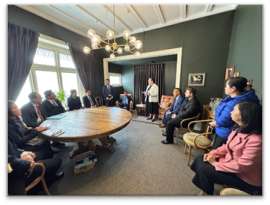
Figure 5- Deputy Mayor delivered a
welcome speech to the Can Tho City Delegation
Attending the Global Cities New Zealand North Island
Forum
4.13 The
International Relations and Education Advisor attended the Global Cities New
Zealand (GCNZ) North Island Forum in Cambridge on 8 November 2024. The event
provided a platform to engage with key stakeholders and advance Council’s
strategic goal of strengthening the city’s international profile and fostering
partnerships that support local community development.
4.14 With over
40 participants, including three Mayors, council officers, and community
leaders from regions such as Waikato, Auckland, Gisborne, Bay of Plenty, Hawkes
Bay, and Manawatū, the Forum covered topics such as engaging iwi and
expat communities, internationalisation, global trade, and the future of
managing global partnerships. The International Relations and Education Advisor
contributed as a panellist on a session discussing the evolution of global city
partnerships.
4.15 The Forum
highlighted Palmerston North’s approach to managing international
partnerships and their local impact. Key discussions included modernising
outdated partnerships, bridging cultural differences, and balancing community and
council involvement in global initiatives.
4.16 The
session reinforced the importance of aligning local and international
objectives in an increasingly complex and globalised world. Palmerston
North’s partnership management was viewed as a model for other councils.
Participation in the forum strengthened connections with other local
authorities and raised Palmerston North’s profile as a leader in global
city relations.
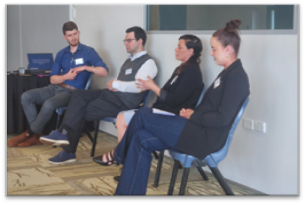
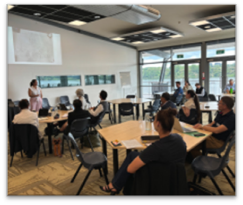
Figures 6 & 7 - Panel discussion and
interactive sessions at the GCNZ North Island Forum on 8 Nov 2024
Visit from the Dutch Innovation Delegation
4.17 Another
visit resulting from the success of the AgriTech city tour during the 2024
Festival of Cultures was the visit from the Dutch Innovation Delegation on 19
November 2024. It was organised by the Embassy of the Kingdom of the
Netherlands in collaboration with AgriTech New Zealand, supported by Palmerston
North City Council.
4.18 The
delegation, led by Dr Richard Harrison from Wageningen University &
Research, consisted of specialists in orchard monitoring, precision spraying,
autonomous robotics, CO2 capture solutions, Rabobank, Wageningen University
& Research, as well as government agencies. Their mission was to explore
collaboration in horticultural research, innovation, and business with New
Zealand, taking advantage of funding mechanism like Horizon Europe for joint
research and development.
4.19 Local
stakeholders including the Central Economic Development Agency (CEDA), Massey
Ventures, Novolabs, C-Dax, FoodHQ, and the Factory were invited to a networking
lunch with the delegates. There were in-depth discussions, seeking mutual
understanding of each other’s offers and capability for partnerships.
4.20 In
addition to individual follow-ups by local stakeholders, Council has been
discussing with the International Innovation – AgriFood division of the
Netherlands Enterprise Agency to explore joint thematic priorities and a
potential matchmaking session to connect Dutch and NZ organisations for the
Horizon Europe funding opportunity. The Netherlands Enterprise Agency is part
of the Dutch Ministry of Economic Affairs, supporting entrepreneurs, NGOs, knowledge
institutes, policy makers, and organisations through funding and
networks.
4.21 The
potential matchmaking event would be a collaboration between the Embassy of the
Kingdom of the Netherlands, the Netherlands Enterprise Agency, and Palmerston
North City Council. If it were to happen in 2025, it would also be in time to
commemorate the 60th anniversary of diplomatic relations between New
Zealand and the Netherlands.
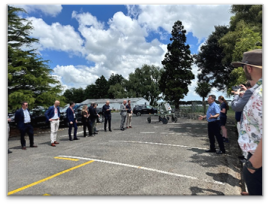
Figure 8 - AgResearch showcased the Map
and Zap system to the visiting Dutch Innovation delegation
Visit from the Ambassador of Switzerland
4.22 The
Council hosted Ambassador Viktor Vavricka of Switzerland and Deputy Head of
Mission Zita Ballaman for a full day visit on 28 November 2024. During the
visit, the Ambassador explored Switzerland’s longstanding connections
with Palmerston North, including decades-old investments in Norwood Group and
DKSH, as well as Noske Rail, whose major clients include the prestigious Swiss
railway manufacturer, Stadler Rail. The Ambassador also engaged with UCOL to
discuss potential collaboration in vocational education and delivered a keynote
presentation at the event Small Advanced Economies’ Success Factors:
Insights from Switzerland, organized by the Palmerston North branch of the
New Zealand Institute of International Affairs.
4.23 This visit
provided local businesses with a valuable opportunity for publicity and
association with a high-profile diplomatic figure, enhancing their credibility
and brand prestige. It also reinforced ties between Switzerland and Palmerston
North, fostering business growth and opening doors to potential international
partnerships.
4.24 Coverage
of the visit on LinkedIn, shared by both the Ambassador and local stakeholders,
generated nearly 1,000 impressions. This exposure elevated Palmerston
North’s profile strengthened confidence in international business
opportunities and highlighted the city's potential to attract increased inward
investment.
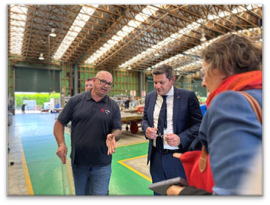

Figure 9 - Factory tour of Noske
Rail Figure
10 - Meeting with DKSH
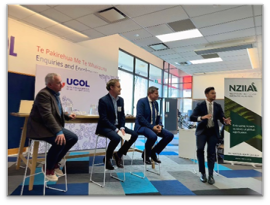
Figure 11 - Participated in panel
discussion during NZIIA event
Attending the Fuzhou International Friendship City
Festival
4.25 At the
invitation of the Fuzhou Foreign Affairs Office, Palmerston North’s
Deputy Mayor Debi Marshall-Lobb and Manager International Relations represented
the city at the Fuzhou International Friendship Cities Tourism and Culture
Festival from 4 December until 8 December 2024. It was part of the 2024
Maritime Silk Road International Tourism Festival, well-attended by nearly a
thousand government officials, representatives of UN Tourism and the World
Tourism Alliance, and delegates from 41 countries and regions including Brazil,
Cambodia, Croatia, Maldives, Nepal, the United States, etc.
4.26 During her
short stay in Fuzhou, the Deputy Mayor visited the Fuzhou No.4 High School
Juyuanzhou campus which has over 3000 students and has been awarded many
outstanding awards in primary and secondary education. The school expressed
strong interest in establishing a partnership with a local school in Palmerston
North. After gauging enthusiasm through engagement with local schools, Council
and the Fuzhou Foreign Affairs Office facilitated an online introductory
meeting between Queen Elizabeth College and No.4 High School Juyuanzhou campus
on 10 March 2025. As a result, the schools are now exploring the possibility of
a 20-student group study tour to Palmerston North this July.
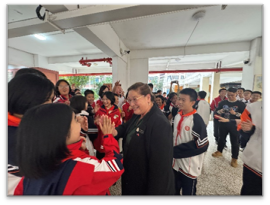
Figure 12 - Visit to Fuzhou No.4 High
School Juyuanzhou Campus
4.27 The Deputy
Mayor and International Relations Manager also took the opportunity to network
with colleagues from around the globe. They had in-depth conversations about
potential collaboration between Palmerston North/Manawatū and Campinas,
Brazil’s thriving hub for innovation and start-ups. Upon return, the two
cities have had virtual meetings to discuss engagement strategies with industry
stakeholders. While this is an ongoing discussion, an agribusiness
environmental consultant from AgFirst from Feilding will be meeting with
Campinas’ Director of International Cooperation and Foreign Trade in June
2025. If circumstances allow, the Manawatū consultant
will visit Campinas to network and explore synergies with key agribusinesses,
start-ups, research institutions and other industry leaders there. The visit
will be supported by Campinas City Council.

Figure 13 - Making connections with
Campinas, Brazil's capital for AgriTech and Food Innovation
4.28 During the
festival in Fuzhou, Palmerston North was prominently showcased on a large
display wall in the event hall, reaching and promoting itself to tens of
thousands of attendees. The Deputy Mayor delivered addresses at the Opening
Ceremony and the Mayors’ Tea & Talk seminar. On behalf of Palmerston
North, she also signed a Letter of Intent for future collaboration in education
and beyond with Fuzhou.
4.29 The
activities received extensive coverage across social media platforms, Chinese
television channels, and various national and local news outlets including
CCTV, China Daily, FZNews, and Shandong Radio and Television. The Fuzhou
International Friendship Cities Tourism and Culture Festival was an excellent
opportunity to promote Palmerston North to not only the Chinese audience, but
to the world as a great place to visit, study, and do business.
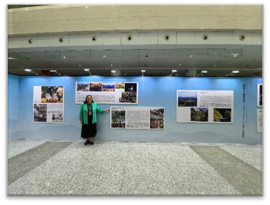

Figure 14 - Deputy Mayor at the city's
exhibition and being interviewed by Chinese media
Visit from Grand Tag, Kunshan to the Factory, Palmerston
North
4.30 On 17 June
2024, Council facilitated the signing of the Memorandum of Understanding for
Collaboration between FoodHQ and the East China Agricultural Science and
Technology Centre of our thirty-year-old partner city, Kunshan. As a result of
this new partnership, The Grand Tag group, an established provider of RFID tags
for livestock animal management, food traceability management, and brand
protection management, visited Palmerston North on 16 December 2024.
4.31 Council
facilitated an in-depth discussion between The Factory and Grand Tag, exploring
opportunities to feature Palmerston North’s local products on Grand
Tag’s new online trading platform for high-end food products. The
conversation also expanded to include the potential for Grand Tag to invest in
the city’s start-up and innovation ecosystem.
4.32 Since
then, both parties have held follow-up meetings to discuss specific export
opportunities and the possibility of a subsequent in-person visit.
Symposium on Strategic Subnational Diplomacy in
Washington, D.C, USA
4.33 Sponsored
by the U.S. Department of State and in partnership with the Truman Centre and
Melbourne Centre for Cities, Meridian International Centre hosted the inaugural
Symposium on Strategic Subnational Diplomacy in Washington, D.C. from 15-17
January 2025. The symposium brought together municipal and regional leaders
from the U.S. and eight allied nations to strengthen coordinated strategies for
international subnational engagement, counter malign influence, uphold
democratic values, and drive economic prosperity.
4.34 This fully
funded programme provided a valuable opportunity to enhance cities' ability to
develop evidence-based international strategies, conduct due diligence on
political, economic, and financial risks, and negotiate from a position of
strength in global partnerships.
4.35 Forty-eight
participants from the United States, Australia, Canada, France, Germany, Italy,
Japan, New Zealand, and the United Kingdom were carefully selected and
personally invited based on their unique expertise and perspectives. Among
them, Palmerston North’s Manager International Relations attended
alongside representatives from Auckland, Christchurch, and Global Cities New
Zealand, which also represented Whakatāne.
4.36 The
programme featured intensive training and workshops on key topics, including
combating disinformation at the subnational level, identifying vulnerabilities
and countering foreign interference, navigating local-national dynamics in
global affairs, strengthening subnational diplomacy, and engaging effectively
in multilateral forums. It also fostered deeper connections among cities and
regions with shared priorities and challenges.
4.37 The
symposium facilitated in-depth discussions on economic development,
educational, scientific, and technical exchanges, foreign direct investment,
migration, and more. Palmerston North led the conversation on private sector
collaboration, showcasing the city’s initiatives in AgriTech, start-ups,
and innovation - highlighting efforts to drive economic growth and
entrepreneurship.
4.38 As a result,
Nancy, a city in the North-eastern region of France, has shown strong interest
in learning more about New Zealand’s AgriTech and Food Innovation sector,
whilst also exploring potential collaboration opportunities with Palmerston
North. Nancy is also home to the Food Innovation Days, a major event in
the Grand Est region that brings together industry leaders, researchers, and
innovators. The event addresses critical topics such as water and raw materials
management, climate challenges, agricultural constraints, emerging food
resources (e.g., beans, algae, insects), and the carbon footprint of food
products. Additionally, it explores European consumer expectations, organic
food trends, health foods, and regulatory developments in the food industry.
Organised by FoodTech® Grand Est, Agria Grand Est, and other
key stakeholders, the event aims to drive innovation and collaboration among
start-ups, food companies, and researchers to promote sustainable and
responsible food solutions.
4.39 The
respective Manager International Relations at Palmerston North and Nancy have
organised a virtual introductory meeting for key stakeholders in the AgriTech
and Food Innovation sectors of both cities on 11 April 2025. Participants from
Palmerston North will include representatives from Massey Ventures, New Zealand
Plant & Food Research, Food HQ, Sprout AgriTech, and The Factory.
4.40 As a world
leader in AgriTech and FoodTech, France offers significant opportunities for
collaboration. Strengthening ties with Nancy - particularly through initiatives
like their Food Innovation Days - could enhance the visibility and impact of
New Zealand and Palmerston North's innovative solutions while also providing
greater access to European markets for local businesses and
organisations."
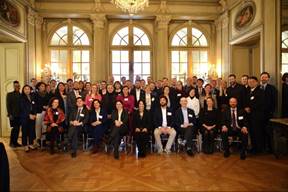
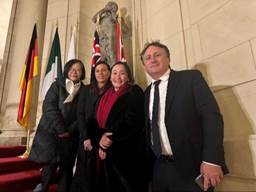
Figure 15 - New Zealand delegates and
other participants from 8 other ally nations at the symposium in Washington,
D.C
Dunhuang Cultural Exhibition
4.41 In
celebration of Lunar New Year 2025, Council and the Embassy of the People's
Republic of China offered residents a rare and immersive experience of the
breath-taking treasures of the ancient Silk Road. The Dunhuang Cultural
Exhibition, showcasing the wonders of the Mogao Caves - one of China’s
most renowned UNESCO World Heritage Sites - was open to the public free of
charge from 27 January to 5 February 2025.
4.42 The
Dunhuang Cultural Exhibition was met with great enthusiasm from the community,
drawing hundreds of visitors to Caccia Birch. Among the attendees was Dr Viv
Smith, Director of Research Operations at Massey University. She shared her
insights into the symbolism in the paintings with fellow visitors during the
exhibition and expressed her willingness to be contacted for similar events in
the future.
4.43 The
Dunhuang Cultural Exhibition enriched the community with a unique culture
experience that deepened local understanding of the Silk Road and the Mogao
Caves. The event attracted hundreds of visitors to Caccia Birch, including some
from out of town, contributing to the boost of tourism and benefiting local
businesses. It also strengthened international ties between Palmerston North
and China, fostering future opportunities for cultural exchanges. The
exhibition promoted community engagement and increased visibility for
Palmerston North as a centre for cultural and academic collaboration.


Figure 16 - Chinese Deputy Head of
Mission Mr Xie welcomed by the Mayor and Rangitāne Chief Wiremu Te Awe Awe
Guiyang’s “All Friends in a Shared Community
Network” Online Conference
4.44 In order
to deepen the understanding and communication with its global partner cities,
Guiyang hosted an online conference featuring “All Friends in a Shared
Community Network” on 14 February 2025. The conference provided a
platform for Guiyang’s partner cities in the Asia Pacific to share their
development achievements in 2024 and plans for practical cooperation in 2025.
4.45 The
conference drew participation of 12 representatives from South Korea, Cambodia,
Laos, Thailand, Malaysia, the Philippines and New Zealand.
4.46 Palmerston
North shared its achievements in building relationships with China as part of
the broader goal to advance the city’s business interests through
international connections.
Festival of Cultures: Showcasing Palmerston North as a
Centre for Solutions
4.47 Palmerston
North once again came alive with the 2025 Festival of Cultures, a vibrant
celebration of the city’s diverse and multicultural community. Over three
days, from 21 to 23 February, the festival transformed the city centre into a
dynamic showcase of international music, dance, cuisine, and cultural exchange.
4.48 A
highlight of this year’s festival was the participation of over 30
members of the diplomatic corps, representing more than 20 nations. The
delegation embarked on a curated city tour on 21 February 2025, showcasing
Palmerston North’s role as a Centre for Solutions, visiting key
innovation and business hubs such as Novolabs, the Australian Defence Apparel
logistics hub in Te Utanganui, and New Zealand Plant and Food Research.
4.49 Hosting
the diplomatic delegation underscored Palmerston North’s commitment to
fostering international partnerships and leveraging its strengths in agritech,
food innovation, logistics, and sustainability. The visit provided a platform
for meaningful connections, reinforcing the city’s potential as a
destination for global collaboration and investment.
4.50 Following
the event, the Council invited members of the diplomatic corps to act as
ambassadors for Palmerston North, serving as a bridge between the city and
businesses in their respective countries.
4.51 Businesses
and organisations that hosted the diplomatic delegation during the city tour
have since received international interest. For example, Thailand, India, the
Netherlands, the United States, and the United Kingdom have all reached out to
Novolabs to explore further collaboration.
INTERNATIONAL
EDUCATION
5. Overview
of the global, national AND LOCAL context
Global
5.1 The
global international education landscape is undergoing major shifts post
COVID-19, with evolving mobility trends, visa policies, and financial pressures
reshaping student flows.
5.2 The
pandemic caused a sharp decline in student mobility during 2020-2021, with
recovery varying by region. UNESCO reports that global mobility rebounded more
strongly in Europe and Canada, where quicker pandemic recovery and flexible
visa policies were implemented, compared to the United States and Australia.
5.3 Hybrid
learning models, combining remote and in-person components, are reshaping
global education. Driven by technological advances and changing student
preferences, these models will continue to influence international education
dynamics. (Source: OECD, 2025)
5.4 The
United States remains a key player in international education, but political
shifts under the new administration pose challenges for international students
and researchers. “Extreme vetting” policies and extensive
background checks for visa applicants, rising tuition rates, and policies
limiting academic freedom are raising concerns about the United States’
stability as a hub for higher education. (Source: NAFSA, 2025)
5.5 In
contrast, countries like Canada, the United Kingdom, and New Zealand have
leveraged open visa policies to become attractive alternative study
destinations to the United States. Canada’s welcoming approach, the
United Kingdom’s post-Brexit focus on student growth, and New
Zealand’s reputation for safety is driving increased international
enrolments.
5.6 The
global state of international education remains fluid as countries adapt to
post-pandemic realities, increasing competition among nations, and shifts in
visa policies. As nations reimagine their roles in the international education
space, fostering global partnerships and creating welcoming environments for
students will remain crucial to sustaining the benefits of cultural exchange
and academic collaboration.
National
5.7 New
Zealand’s international education sector had demonstrated significant
growth and resilience in recent years. In 2023, the country recorded 69,135
international student enrolments, marking a 67% increase compared to 2022 and
reaching 60% of the enrolment numbers seen in 2019. This positive trend aligns
with projections from a report commissioned by Education New Zealand which
suggests that the sector’s contribution to the national economy has the
potential to return to pre-pandemic levels by 2030. (Source: Education New
Zealand, 2023 and 2024)
5.8 The
following Education New Zealand dashboard (Figure 21) provides a breakdown of
total enrolments across sub-sectors in New Zealand from 2013 to 2024. This
includes students who are on exchange, studying in New Zealand, and studying
outside New Zealand.
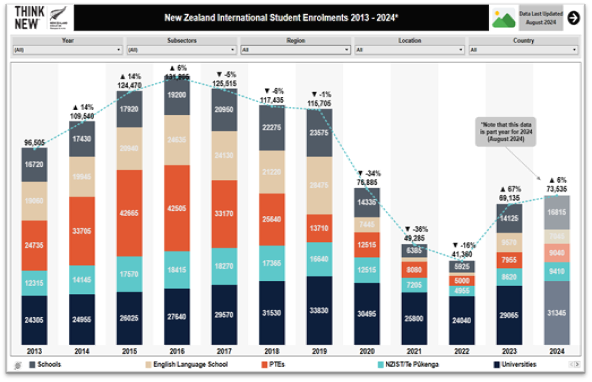
Figure 21 - New Zealand International
Student Enrolments 2013-2024 (Source: ENZ)
5.9 The
New Zealand government has actively worked to strengthen educational ties with
key international partners. In February 2025, Prime Minister Luxon visited
Vietnam, where he and Vietnamese Prime Minister Pham Minh Chinh agreed to
establish a comprehensive strategic partnership, including enhanced cooperation
in education. This highlights New Zealand’s readiness to welcome more
Vietnamese students, scientists, and researchers.
5.10 At the
time of writing this report, Prime Minister Luxon is in India to enhance
bilateral ties, including in education. Notable developments include the
signing of an Education Cooperation Agreement, which focuses on educational
exchanges, institutional collaborations, and dual-degree programmes.
Discussions also involve the establishment of New Zealand university campuses
in India and joint research initiatives. This visit is expected to increase
Indian student mobility to New Zealand and further strengthen New
Zealand’s presence in India’s growing education market. (Source:
Ministry of External Affairs - Government of India, 2025; Press Information
Bureau - New Delhi, 2025)
5.11 International
education is New Zealand’s fifth-largest export industry, generating
approximately $5.0 billion in 2023. The sector not only supports GDP but also
creates jobs in hospitality, retail, and transport, driving economic recovery
post COVID-19. (Source: Education New Zealand, 2024)
5.12 International
students contributed significantly to New Zealand’s economy in 2015/16,
generating an estimated $3.8 billion in foreign exchange earnings and a total
GDP impact of $4.0 billion when accounting for direct, indirect, and induced
effects. The sector supported 32,000 jobs, with tuition revenue alone amounting
to $1.03 billion. On average, each student spent $25,600 on living expenses,
including accommodation and transport. Auckland was the key hub, hosting 66% of
international students and generating $2.2 billion in foreign exchange
earnings. The majority of students came from China, India, South Korea and
Japan, with Chinese students alone contributing $1.3 billion. (Source:
Education New Zealand and Infometrics, 2016)
5.13 International
students provide significant economic, social and cultural benefits to New
Zealand. Each year, Education New Zealand conducts an International Student
Experience Survey to assess their experiences. In 2024, 86% of the 6,423
respondents (aged 14 and above) rated their overall experience in New Zealand
positively. The survey also evaluates key aspects of student life, including
social connections, education quality, study arrangements, arrival and
orientation, living conditions, value for money, and work opportunities.
5.14 International
education supports a range of ancillary industries, benefitting both urban and
regional economies. The long-term impact is also seen in alumni who contribute
to New Zealand’s economy as business leaders, professionals, and
ambassadors for the country’s education institutions. (Source:
Education New Zealand, 2024)
Local
5.15 The Manawatū-Whanganui region plays an active role in
international education, offering a diverse array of opportunities across
primary to tertiary levels. In 2023, the region recorded 2,335 international
student enrolments, marking a 35% increase compared to 2022 and reaching 69% of
pre-pandemic levels. (Source: Education New Zealand, 2024)
5.16 The
following Education New Zealand dashboard (Figure 22) provides a breakdown of
total enrolments across sub-sectors in the Manawatū-Whanganui
region from 2013 to 2024. This includes students who are on exchange,
studying in New Zealand, and studying outside New Zealand.
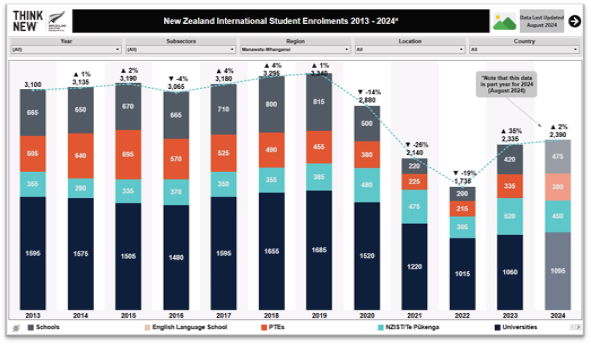
Figure 22 - Manawatū-Whanganui
International Student Enrolments 2013-2024 (Source: ENZ)
5.17 Immigration
New Zealand provides monthly data for valid international student visa holders
- including those engaged in English language studies, exchange programmes,
full-fee paying students, pathway students, and scholarship recipients -
studying in the Manawatū-Whanganui region. This data (Figure 23) is
limited to the regional level and does not provide a breakdown by territorial
authority or institution.
5.18 Student
numbers can fluctuate due to new arrivals, departures upon programme
completion, or changes in visa status (e.g. dependants of student visa holders
transitioning to domestic status). As a result, accurately tracking a
consistent headcount proves challenging.
|
Valid international student visa holders who are studying
in Manawatū-Whanganui
|
|
|
4 Mar 2024
|
1 Apr 2024
|
2 Jun 2024
|
1 Jul 2024
|
4 Aug 2024
|
1 Sep 2024
|
6 Oct 2024
|
3 Nov 2024
|
1 Dec 2024
|
5 Jan 2025
|
2 Feb 2025
|
3 Mar 2025
|
|
Polytechs
|
125
|
119
|
111
|
110
|
115
|
124
|
130
|
128
|
125
|
124
|
145
|
182
|
|
PTEs
|
209
|
193
|
216
|
213
|
195
|
236
|
239
|
246
|
237
|
205
|
241
|
237
|
|
Schools
|
236
|
232
|
236
|
207
|
212
|
214
|
198
|
207
|
123
|
43
|
153
|
255
|
|
Universities
|
740
|
730
|
701
|
543
|
741
|
743
|
778
|
704
|
529
|
424
|
479
|
810
|
|
Total
|
1310
|
1274
|
1264
|
1073
|
1263
|
1317
|
1345
|
1285
|
1014
|
796
|
1018
|
1484
|
Figure 23 - Valid international student visa holders in
Manawatū-Whanganui 2024-2025 (Source: INZ)
5.19 Higher
education enrolment data (headcount and EFTS) for international and domestic
students at the Palmerston North/Manawatū campuses of Massey University,
UCOL, Te Wānanga o Aotearoa, and IPU New Zealand is provided to Council
annually (Figures 24 and 25). This is the same data the institutions submit to
the Tertiary Education Commission as at 15 April each year for funding purposes.
The international headcount data was previously published on the city
dashboards but is no longer featured due to the new overarching city-level
indicators set by elected members.
|
Student
headcount as at 15 April each year
|
|
|
|
Massey
University
|
Universal
College of Learning
|
Te
Wānanga o Aotearoa
|
IPU
New Zealand
|
Total
Higher Education
|
|
2018
|
Domestic
|
4,840
|
2,855
|
511
|
55
|
8,261
|
|
International
|
1,311
|
197
|
0
|
288
|
1,796
|
|
Total
|
6,151
|
3,052
|
511
|
343
|
10,057
|
|
2019
|
Domestic
|
4,598
|
2,949
|
534
|
65
|
8,146
|
|
International
|
1,367
|
217
|
0
|
243
|
1,827
|
|
Total
|
5,965
|
3,166
|
534
|
308
|
9,973
|
|
2020
|
Domestic
|
4,310
|
3,003
|
494
|
42
|
7,849
|
|
International
|
1,335
|
175
|
0
|
177
|
1,687
|
|
Total
|
5,645
|
3,178
|
494
|
219
|
9,536
|
|
2021
|
Domestic
|
4,133
|
3,164
|
493
|
49
|
7,839
|
|
International
|
1,098
|
151
|
0
|
137
|
1,386
|
|
Total
|
5,231
|
3,315
|
493
|
186
|
9,225
|
|
2022
|
Domestic
|
3,814
|
3,108
|
378
|
31
|
7,331
|
|
International
|
896
|
150
|
0
|
138
|
1,184
|
|
Total
|
4,710
|
3,258
|
378
|
169
|
8,515
|
|
2023
|
Domestic
|
3,182
|
2,678
|
514
|
31
|
6,405
|
|
International
|
836
|
185
|
0
|
161
|
1,182
|
|
Total
|
4,018
|
2,863
|
514
|
192
|
7,587
|
|
2024
|
Domestic
|
2,830
|
3,984
|
517
|
21
|
7,352
|
|
International
|
965
|
174
|
0
|
173
|
1,312
|
|
Total
|
3,800
|
4,158
|
517
|
194
|
8,664
|
Figure 24 – Student headcount
numbers 2018-2024 (Source: Individual providers)
|
Equivalent full-time
students as at 15 April each year
|
|
|
|
Massey
University
|
Universal
College of Learning
|
Te
Wānanga o Aotearoa
|
IPU
New Zealand
|
Total
Higher Education
|
|
2018
|
Domestic
|
3,218
|
1,858
|
511
|
33
|
5,621
|
|
International
|
881
|
86
|
0
|
196
|
1,164
|
|
Total
|
4,099
|
1,945
|
511
|
229
|
6,784
|
|
2019
|
Domestic
|
3,080
|
1,860
|
484
|
61
|
5,484
|
|
International
|
952
|
130
|
0
|
181
|
1,263
|
|
Total
|
4,031
|
1,990
|
484
|
242
|
6,747
|
|
2020
|
Domestic
|
2,969
|
1,908
|
471
|
48
|
5,397
|
|
International
|
911
|
108
|
0
|
144
|
1,162
|
|
Total
|
3,880
|
2,016
|
471
|
192
|
6,559
|
|
2021
|
Domestic
|
2,851
|
1,934
|
469
|
37
|
5,291
|
|
International
|
726
|
99
|
0
|
123
|
947
|
|
Total
|
3,576
|
2,033
|
469
|
160
|
6,238
|
|
2022
|
Domestic
|
2,528
|
1,675
|
356
|
30
|
4,589
|
|
International
|
584
|
45
|
0
|
103
|
732
|
|
Total
|
3,112
|
1,720
|
356
|
133
|
5,321
|
|
2023
|
Domestic
|
2,202
|
1,486
|
423
|
26
|
4,137
|
|
International
|
602
|
63
|
0
|
150
|
815
|
|
Total
|
2,804
|
1,549
|
423
|
176
|
4,952
|
|
2024
|
Domestic
|
1,855
|
2,174
|
405
|
16
|
4,450
|
|
International
|
680
|
107
|
0
|
140
|
927
|
|
Total
|
2,535
|
2,281
|
405
|
156
|
5,377
|
Figure 25 - Equivalent full-time student
numbers 2018-2024 (Source: Individual providers)
5.20 It is
worth noting that the Education New Zealand, Immigration New Zealand, and
individual providers data pertains exclusively to international students
holding a valid student visa, excluding those participating in short-term
programmes (≤ 3 months) who may enter New Zealand on a visitor visa, or
are from a visa-waiver country. It is estimated that Palmerston North schools
host around 400 short-term students annually. Data on short-term enrolments
varies between institutions and across years, making it difficult to provide a
consistently accurate representation.
5.21 International
education is a key contributor to the economic and cultural vitality of the
Manawatū-Whanganui region. In the 2015/16 period, the sector generated
approximately $100.6 million in foreign exchange earnings. Direct spending by
international students added nearly $48 million to the regional economy and
supported around 420 jobs, primarily in the Manawatū sub-region. When
considering indirect and induced effects, total regional employment reached 679
jobs, with a value-added contribution of $71.5 million, accounting for about
0.83% of the region’s GDP. (Source: Education New Zealand and
Infometrics, 2016)
6. Activity
outcome report
Visit from the Hefei Delegation
6.1 On
14 October 2024, Deputy Mayor Debi Marshall-Lobb hosted a delegation from Hefei
city, including officials from the Hefei Education Bureau and representatives
from Hefei No. 3, No. 6, and No. 7 High Schools, at Palmerston North Boys High
School. This visit was organised by World Class Education Limited, local
education providers, and Council, with the goal of sending student groups to
Palmerston North secondary schools from Hefei annually.
6.2 The
visit reinforced Palmerston North’s position as a key hub for international
education, strengthening relationships with Hefei’s schools and providing
local education providers with valuable global connections. It also promoted
the city as an attractive destination for international students.
6.3 These
efforts align with the Council’s goal of supporting local education
providers by fostering international partnerships and expanding global
educational opportunities. Council’s facilitation of such visits enhances
Palmerston North’s profile and creates pathways for cross-cultural
exchange, elevating the status of local schools as destinations for
international students.
City Welcome Session
6.4 On
16 November 2024, Council hosted a City Welcome session/Pōwhiri as part of
the Welcoming Communities programme. Newcomers welcomed at this session added
to over 400 attendees throughout 2024. The International Relations and
Education advisor supports the Community Development Advisor (Welcoming
Communities) to ensure international students are included in these sessions.
6.5 This
collaboration between Council and Rangitāne o Manawatū provides
newcomers, including international students, with opportunities to connect with
city leaders, service providers, and each other while learning about local
services and community involvement. The City Welcome sessions/Pōwhiri have
been instrumental in fostering a sense of belonging and integration, with
strong participation. In response to growing demand, discussions are underway
to increase the number of sessions each year.
6.6 A
dedicated City Welcome session/Pōwhiri for international students is
planned for August 2025 to further support their integration into the community
and enhance their study experience in Palmerston North, following requests from
education providers.
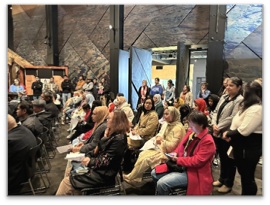
 Figures 26 & 27 - Newcomers at the
City Welcome session
Figures 26 & 27 - Newcomers at the
City Welcome session
Shijiazhuang short-term study programme
6.7 On
18 April 2024, Council hosted a delegation from Shijiazhuang, the capital city
of Hebei Province in China, to explore the potential of educational collaboration
between the two cities. In November 2024, while in China to attend the
International Friendship Cities Conference, the Mayor visited Shijiazhuang and
toured two middle schools. Following these successful reciprocal visits,
Shijiazhuang expressed interest in sending middle school students to Palmerston
North to further educational ties.
6.8 After
gauging interest from local schools, Council facilitated a connection between
Global Ocean Group Limited (an Auckland-based education agent for the Shijiazhuang
schools) and Queen Elizabeth College. As a result, Queen Elizabeth College
hosted 9 students and 2 staff members from No 48 Middle School and GaoXin
Foreign Language School from 2 to 15 February 2025. The school is also
considering hosting additional student groups later in the year.
6.9 This
initiative demonstrates how reciprocal visits can lead to tangible outcomes,
such as the short-term study programme at Queen Elizabeth College. This
programme not only strengthens educational ties between Palmerston North and
Shijiazhuang but also provides the school with additional income, a benefit
made possible through international collaboration. By fostering these
connections, the initiative contributes to the broader goal of enhancing global
partnerships and expanding educational opportunities for local schools.
Montana Academic World Quest Student to Student Global
Conversation
6.10 The
Montana World Affairs Council hosted the annual Academic World Quest conference
from 2 to 4 March 2025 in Missoula, Montana, with 500 high school students
attending from across the state. Palmerston North students (aged 14-18) were
invited to participate in the conference alongside students from 25 counties in
Montana, including three schools from Missoula, Palmerston North’s sister
city. A key feature of the event was the Student to Student Global
Conversation, a virtual exchange where students from Montana and Palmerston
North engaged in a moderated Zoom discussion.
6.11 The
Student to Student Global Conversation facilitated an enriching dialogue on
topics ranging from daily school life to global issues. Palmerston North
students - Tarshay Rawhiti-Fiti (Head Girl at Queen Elizabeth College), Azmain
Ifrit (Multicultural Prefect at Palmerston North Girls High School), and Lintang
Krohn (Cultural Captain at Awatapu College), participated and offered
thoughtful responses to challenging questions on cultural practices, political
matters, and international travel. Tarshay also shared insights into taonga,
bone carvings, and her tāmoko, providing a meaningful cultural exchange
that was well-received by Montana students.
6.12 This
initiative strengthened the sister city relationship between Missoula and
Palmerston North by providing students with a valuable international experience
through cultural exchange and global conversations. It aligned with our
strategic goals of promoting international relations, supporting youth
engagement, and fostering global partnerships.


Figures 28 & 29 - Lintang Krohn, Azmain Ifrit and
Tarshay Rawhiti-Fiti participating in the Student to Student Global
Conversation
NZIIA Event: ‘Unlocking Doors for Global
Experiences’
6.13 On 6 March
2025, over 60 students attended the ‘Unlocking Doors for Global
Experiences’ event, a collaboration between the Palmerston North branch
of the New Zealand Institute of International Affairs (NZIIA), Palmerston North
City Council, the New Zealand Centre for Global Studies, IPU New Zealand,
Massey Business School, Massey Global, and the Manawatū Young
Chamber.
6.14 The event
featured a panel discussion with the International Relations and Education
Advisor, Mayor Grant Smith (President of Global Cities New Zealand), and Chris
Gallavin (Director & Founder of Global Citizenship New Zealand), who shared
their insights on global citizenship and the value of cross-cultural
experiences. Libby Giles (Director of the New Zealand Centre for Global Studies)
delivered the keynote address. Several organisations, including Asia New
Zealand Foundation, Massey University, Volunteer Service Abroad, IPU New
Zealand, AFS, PNCC International Relations, and UCOL Manawatū showcased
their scholarships, grants, and international programmes.
6.15 The event
provided students with tangible opportunities to engage with international
organisations and learn about the global pathways available to them.
6.16 This
initiative successfully promoted global opportunities to students, enhanced
international relations, and supported youth engagement. By connecting students
to global networks and showcasing local success stories, like Abby Ives (a
Palmerston North Girls High School student studying at United World Colleges in
China), the event encouraged students to broaden their perspectives and pursue
international experiences. This aligns with our strategic goals of fostering
international relations, supporting youth engagement, and creating pathways for
students to develop personally and professionally.
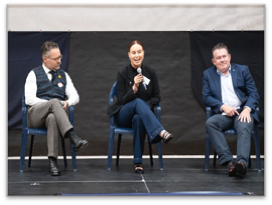

Figures 30 & 31 - Images from the ‘Unlocking Doors for Global
Experiences’ event
Waseda short-term study programme
6.17 Following
a successful proposal to Education New Zealand and the Waseda teacher
familiarisation visit in November 2022, Manawatū and Hawkes Bay were
selected as the two regions to host a short-term study programme for students
from Waseda University’s network of affiliated schools starting in 2023.
6.18 The
fifth cohort of 14 students from Waseda University’s network of
affiliated schools undertook a two-week programme in Palmerston North from 23
March to 5 April 2025. The participating schools were Awatapu College,
Palmerston North Boys High School, and Palmerston North Girls High School. The
students studied English, attended regular classes, participated in
extracurricular activities and lived with local homestay families.
6.19 During
the programme, the students were introduced to local tertiary education
institutions. They toured Massey University, met international staff,
participated in a campus ‘Amazing Race’ challenge, and attended a
session on New Zealand’s tertiary education system. The cohort also
visited UCOL, where they received a Mihi Whakatau, a comprehensive campus tour,
and a hands-on group activity with construction lecturers. These experiences
provided the students with a deeper understanding of education in New Zealand
and the study options available in the region.
6.20 A
sixth cohort of 15 students will undertake a three-week programme in Palmerston
North from 10 to 30 August 2025.
6.21 This
programme not only strengthens international educational ties but also supports
economic development by generating additional revenue for local schools. As a
result of the short-term programme, Palmerston North Boys High School has
enrolled Waseda students in long-term, fee-paying international programmes,
positioning Palmerston North as an attractive destination for international
students and supporting the city’s educational and economic goals.
Hiroshima Global Academy scholarship for Palmerston
North students
6.22 In
partnership with Hiroshima Global Academy (HiGA), Palmerston North city and Mihara
city signed a Memorandum of Understanding, offering Palmerston North students
the opportunity to study the International Baccalaureate (IB) programme at HiGA
for 2-3 years at no tuition cost, as a scholarship. To promote the programme,
two international webinars were held on 7 June and 5 July 2024, targeting
students, parents, and teachers. Additionally, two HiGA teachers visited
Palmerston North from 19-23 August 2024, presenting to students at local
schools and visiting Massey University, UCOL, IPU New Zealand and the English
Teaching College (ETC).
6.23 The
initiative commemorates the 5th anniversary of the sister city relationship
between Palmerston North and Mihara (2019-2024), while providing a unique
educational opportunity for secondary school students. It builds cultural
competence and fosters international connections, aligning with the
city’s goals of promoting youth engagement and global partnerships.
6.24 Ashlyn
Osborne, a student at Palmerston North Girls High School, was awarded the scholarship
and will commence her study at HiGA in April 2025. Mihara city will connect
Ashlyn with a local homestay family in Mihara, to support her during weekends
and holidays, and ensure her well-being and pastoral care throughout her time
in Japan. This scholarship provides a tangible global opportunity for
Palmerston North youth, strengthening the city’s ties with Mihara.
6.25 Furthermore,
HiGA is exploring future educational pathways, including English language study
and farm stay experiences at the English Teaching College (ETC) in Palmerston
North. Ongoing discussions are also taking place regarding a reciprocal
short-term student exchange between HiGA and Palmerston North secondary
schools, deepening the educational relationship between the cities.
Global Youth Summer Camp in Guiyang
6.26 To
strengthen global youth connections and build on the 32-year sister city
relationship between Palmerston North and Guiyang, the two city councils have
established an education abroad programme for youth from both cities.
6.27 Guiyang
Municipal Government has invited 14-18 year old students from Palmerston North
to participate in the Global Youth Summer Camp in Guiyang from 29 June to 10
July 2025. The programme will bring together up to 20 students from Palmerston
North and up to 20 students from Guiyang No. 6 High School, a prestigious
institution with a strong focus on international education initiatives. The
immersive programme includes cultural workshops, hands-on activities, and
discussions to promote mutual learning and a deeper understanding of Chinese
culture.
6.28 This
initiative offers Palmerston North students a unique opportunity to experience
Chinese culture, expand their global perspectives, and build valuable personal
and professional skills through connections with Guiyang peers. It strengthens
the sister city relationship, fosters cross-cultural exchanges, and supports
the strategic goals of enhancing international education, promoting global
citizenship, and encouraging youth engagement. Ultimately, the programme aims
to cultivate a long-term, mutually beneficial relationship between the two
cities.
6.29 At the
time of writing this report, the programme proposal and applications have been
circulated to local secondary schools, including Feilding High School and Nga
Tawa Diocesan School as part of the wider International Education Manawatū
network. Manawatū Multicultural Council is also promoting the opportunity
within their communities. A LinkedIn post has garnered over 1,300 impressions. Students
are invited to submit expressions of interest by 5pm, Friday 28 March 2025. The
programme cost is capped at $3,500 per participant (excluding personal spending
money).
Prime Minister’s Scholarships for Asia
6.30 The
International Relations team is assisting the PNCC Emergency Management team
and UCOL in submitting group applications for the Prime Minister’s
Scholarships for Asia. The Emergency Management team is seeking to establish a
partnership with Mihara, Japan, focusing on civil defence and emergency
preparedness, while UCOL is exploring internship opportunities for Early
Childhood Education students with Kunshan, China.
6.31 This
initiative leverages existing sister city relationships to create new
opportunities for local stakeholders, both internal and external, through
international collaboration. By supporting these applications, the
International Relations team is enabling Palmerston North organisations to
expand their global networks and engage in cross-cultural learning and
professional development.
7. Quantitatve
success measures
7.1 Council
passed the following resolution on 5 June 2024:
That the Chief Executive develop quantitative success
measures in addition to the qualitative measures proposed in the International
Relations and Education Annual Plan 2024/25.
7.2 This
6-month update has provided new quantitative data related to the work of the
International Relations and Education function. For example, national and
regional international student enrolments, valid international student visa
holders who are studying in Manawatū-Whanganui, and equivalent full-time
students for Palmerston North based tertiary institutions.
7.3 At
this stage there is limited quantitative data available that is directly linked
to the work of the International Relations and Education function. Officers are
aware of data regarding the number of international students studying or
visiting local schools and the corresponding revenue the schools receive, but
much of that data is sensitive and not appropriate to be reported in this
context. What we do know is that international students are an important
source of additional revenue for local schools and the relationship the City
has with the local schools and overseas partners is very important to
facilitating those outcomes.
7.4 While
there are social and cultural outcomes associated with the International
Relations and Education function, much of the work is linked to broader
economic development outcomes. One option to give effect to the Council
resolution is to monitor macro quantitative measures such as GDP, median
income, international card spend, jobs and/or jobs in particular sectors linked
to the work of the International Relations and Education function, e.g. jobs in
education, logistics, agri-food, research, science and innovation. The 6-month
report could then connect the work of the International Relations and Education
function to broad trends and outcomes in these areas. However, these macro
measures are already monitored elsewhere via quarterly economic reporting,
sector profiles and dashboards. These measures or indicators are also
influenced by a very broad range of drivers, many of which are outside the
direct control of Council, including the International Relations and Education
function.
7.5 An
alternative option to give effect to the Council resolution is to develop
quantitative success measures linked to the core activities of the
International Relations and Education function, e.g. host X number of overseas
delegations, facilitate X number of study groups, lead X number of overseas
delegations, host X number of ambassadors, support X number of cultural
activities, connect with X number of local schools. This option could be
undertaken on the basis that the Council acknowledges that these types of
activities contribute to broader outcomes and goals for the City.
7.6 Quantitative
measures do tend to work well for certain Council activities, e.g.
infrastructure standards, visits to facilities, consent numbers and land
supply. Determining appropriate quantitative measures for many Council
activities, including the International Relations and Education function, is a
real challenge. For example, CEDA’s performance framework previously
included macro economic measures such as job growth and median income. As noted
above, the reality is these types of measures are influenced by a very broad
range of drivers, many of which are outside the direct control of Council or
CEDA. The statement of service performance for CEDA now includes measures such
as; deliver 9 sector development initiatives to support the regions sectors of
strength; 400 engagements with businesses to support growth and talent
retention; and partner with key stakeholders to deliver 6 start-up and innovation
activities or initiatives.
7.7 It
is a very rare where a successful outcome for the City is linked to a single
activity or function of the Council. In most cases there will be multiple
factors at play that influence certain outcomes. For example, if the City was
successful in securing a new international freight and distribution activity at
Te Utanganui, it is likely that the activities of international relations,
CEDA, planning, building, infrastructure, economic analysis & reporting,
advocacy via the Mayor’s office, and policy settings regarding
development contributions and rates all factored into the outcome. Likewise, if
one of the local research or education institutions was able to secure
additional overseas funding, it is likely that the activities of international
relations, CEDA, FoodHQ (PNCC is a partner) and advocacy via the Mayor’s
office all played a role. Outcomes such as these are long term plays for
the City that require ongoing commitment to relationships and partnerships,
including with our overseas partners if we want to position the City for inward
investment.
7.8 Work
is continuing to give effect to the 5 June 2024 resolution, taking into account
the various challenges associated with developing quantitative measures for
this type of work. Subject to any further direction from elected members, it is
likely that the quantitative measures developed will be linked to the
activities of the International Relations and Education function, as opposed to
macro quantitative measures. Officers will continue to provide updates on the
quantitative data that is available and was provided within this 6 month
report.
8. 2024-2025
annual plan – SUMMARY UPDATE
|
Timeline
|
Activities
|
Status/Outcomes
|
|
June 2024
|
Successfully hosted the Kunshan delegation visit to
Palmerston North and facilitated the MOU signing between FoodHQ and ECS-CAAS
on 17 June 2024
|
Completed
Resulted in ongoing discussion on scalable export and
investment opportunities with Kunshan
|
|
July 2024
|
‘Pisco es Peru’ event
|
Due to strategic changes, our partner has opted not to proceed with
the event
|
|
August 2024
|
Successfully facilitated the 2nd intake of the Waseda
Study Group for the year from 4 – 24 August 2024
|
Completed
|
|
Successfully hosted visit from Hiroshima Global Academy teachers to
promote the Palmerston North – Mihara – HiGA scholarship
programme from 19 – 24 August 2024
|
Completed
Resulted in one Palmerston North Girls’ High School student
awarded the scholarship, commencing study in HiGA in April 2025.
Details are provided in section 6.22 – 6.25 of this report
|
|
Successfully hosted the Yantai delegation visit and
signed a Letter of Intent for educational collaboration on 29 August 2024
|
Completed
Resulted in support for Massey University’s
high-level visit to the China Agricultural University campus in Yantai and
the Yantai City Government in May 2025
|
|
September
2024
|
Supported City Welcome Session – Pōwhiri on 14 September
2024
|
Completed
|
|
Successfully collaborated with ASEAN Business Council and
NZIIA PN branch to host the ‘ASEAN – Open doors for
AgriTech’ event on 19 September 2024
|
Completed
Provided a market information session and networking
opportunity for local businesses interested in ASEAN – one of the key
strategic partners for New Zealand
|
|
October 2024
|
Supported the Te Utanganui Sydney Knowledge Acquisition Trip through
connections with the Australian High Commission, Penrith and Liverpool City
Council from 3-4 October 2024
|
Completed
Outcomes as reported by CEDA,
|
|
Supported the Hefei Delegation visit on 14 October 2024
|
Completed
Details are provided in section 6.1 - 6.3 of this report
|
|
Hosted the EU Delegation’s Ambassador visit with a focus on the
EU-NZ FTA and Horizon Europe Funding programme on 17 October 2024
|
Completed
Details are provided in section 4.5 - 4.9 of this report
|
|
Supported the Latin American and Spanish Film Festival
– showcasing Latin cultures
|
Completed
|
|
Hosted the Can Tho City’s Delegation visit to Palmerston North
on 22 October 2024.
|
Completed
Details are provided in section 4.10 - 4.12 of this report
|
|
1. November 2024
|
Supported Diwali Mela – Festival of Light on 2
November 2024
|
Completed
|
|
Attended the GCNZ North Island Forum on 8 November 2024
|
Completed
Details are provided in section 4.13 - 4.16 of this report
|
|
Supported City Welcome Session – Pōwhiri on 16
November 2024
|
Completed
Details are provided in section 6.4 – 6.6 of this
report
|
|
Supported Riddet Institute and Massey University with the 17th
International Hydrocolloids Conference
|
Completed
|
|
Facilitated the Dutch Innovation Delegation visit on 19
November 2024
|
Completed
Details are provided in section 4.17 - 4.21 of this
report
|
|
Hosted the Swiss Ambassador’s visit to Palmerston North on 28
November 2024
|
Completed
Details are provided in section 4.22 - 4.24 of this report
|
|
December 2024
|
Attended the Fuzhou International Friendship Cities
Tourism & Cultures Festival from 4 – 8 December 2024
|
Completed
Details are provided in section 4.25 - 4.29 of this
report
|
|
Supported The Factory with visit from the Grand Tag Group on 16
December 2024
|
Completed
Details are provided in section 4. 30 – 4.32 of this report
|
|
January 2025
|
Attended the Symposium on Strategic Subnational Diplomacy
on 15 – 17 January 2025
|
Completed
Details are provided in section 4.33 – 4.40 of this
report
|
|
Successfully co-hosted the Dunhuang Cultural Exhibition
|
Completed
Details are provided in section 4. 41 – 4.43 of this report
|
|
February 2025
|
Supported the Lunar New Year Celebration on 1 February
2025
|
Completed
|
|
Attended Guiyang’s “All Friends in a Shared Community
Network” Online Conference
|
Completed
Details are provided in section 4.44 – 4.46 of this report
|
|
Successfully hosted the 2-day programme for the
diplomatic delegation during the 2025 Festival of Cultures on 21-22 February
2025
|
Completed
Details are provided in section 4. 47 – 4.51 of
this report
|
|
March 2025
|
Supporting Holi – Festival of Light
|
Ongoing
|
|
Hosted the Indian Entrepreneurship Initiative delegation
with Asia New Zealand Foundation on 12 March 2025
|
Completed
Promoted Palmerston North as an AgriTech and Food
Innovation Hub to Indian market
|
|
|
Successfully facilitated the 1st intake of the Waseda Study Group for
the year from 23 March - April 2025
|
Completed
Details are provided in section 6.17 – 6.21 of this report
|
|
|
Supported and attended the NZIIA Event –
‘Unlocking Doors for Global Experiences’ on 6 March 2025
|
Completed
Details are provided in section 6.13 - 6.16 of this
report
|
|
April 2025
|
Facilitating the virtual introductory meeting for key stakeholders in
the AgriTech and Food Innovation sectors in Palmerston North and Nancy,
France
|
Ongoing
|
|
May
2025
|
Attending the 3rd China – New Zealand
Mayoral Forum in Chengdu from 19 – 22 May 2025
|
Ongoing
|
|
June 2025
|
Presenting the 2025-2026 Annual Plan to Council
|
Ongoing
|
9. Compliance
and administration
|
Does the Committee have
delegated authority to decide?
|
Yes
|
|
Are the decisions significant?
|
No
|
|
If they are significant do they
affect land or a body of water?
|
No
|
|
Can this decision only be made
through a 10 Year Plan?
|
No
|
|
Does this decision require
consultation through the Special Consultative procedure?
|
No
|
|
Is there funding in the current
Annual Plan for these objectives?
|
Yes
|
|
Are the recommendations
inconsistent with any of Council’s policies or plans?
|
No
|
|
The recommendations
contribute to: Whāinga 1: He tāone auaha, he tāone
tiputipu
Goal 1: An innovative
and growing city
|
|
The recommendations contribute to this
plan:
2.
Mahere whakawhanake ohaoha
2. Economic Development
Plan
The objective is:
- Support
international education and promote Palmerston North’s interests to global
partners
- Promote
Palmerston North’s interests to global city partners
- Facilitate
international economic and education partnerships with city institutions
- Manage
official delegations and relationships with the diplomatic corps
- Participate
in international forums and events
|
|
Contribution to strategic
direction and to social, economic, environmental and cultural well-being
|
The 6-monthly report on
International Relations and Education Activities outlines the progress of
actions in the International Relations Chapter, which contributes to the
Economic Development Plan and Innovative and Growing City Strategy.
|
|
|
|
Attachments
Nil
Committee Work Schedule
TO: Economic
Growth Committee
MEETING DATE: 9
April 2025
TITLE: Committee
Work Schedule - April 2025
RECOMMENDATION TO Economic Growth Committee:
1. That
the Economic Growth Committee receive its Work Schedule dated April 2025.
Committee
Work Schedule – April 2025
|
|
Estimated Report
Date
|
Subject
|
Officer Responsible
|
Current Position
|
Date of Instruction
&
Clause no.
|
|
1
|
9 April 2025
|
Draft Parking Framework – Approval for Public
Consultation
|
General Manager Strategic Planning
|
Laid on table from November 2024
|
|
|
2
|
9 Apr 2025
|
Streets for People Update (6 monthly)
|
General Manager Infrastructure
|
|
Terms of Reference
28 February 2024
Clause 18-24
|
|
3
|
9 Apr 2025
|
Featherston Street
– concept design options – shared walkway/ non-separated cycleway
|
General Manager
Infrastructure
|
Due to NZTA funding cutbacks, and no further Council
funding allocated to the project, this paper is no longer required
|
Council
5 June 2024
Clause 98-24
|
|
4
|
9 Apr 2025 11 June 2025
|
City Central Indicative
Business Case (CCIBC) Update
|
General Manager
Strategic Planning
|
Report not ready due to date availability and the complexity of the
different plans
|
19
June 2024 Clause 42-24
|
|
5
|
9 Apr 2025 27 Aug 2025
|
Economic
Profile: Logistics and distribution (3-yearly)
|
General
Manager Strategic Planning
|
Delayed due to late release of data and NZIER CBA
|
30
August 2023 Clause 35-23 Schedule
|
|
6
|
9 Apr 2025
|
Road Maintenance Contract (six-monthly report on work
programme and performance)
|
General Manager Infrastructure
|
|
16 March 2022 Clause 4-22
|
|
7
|
9 Apr 2025 11 June 2025
|
Tamakuku Terrace Update
(6 Monthly)
|
General Manager Infrastructure
|
Move to June to align with 6 monthly update, as last update was
presented Nov/Dec 24
|
Terms of Reference
|
|
8
|
9 Apr 2025
|
Featherston Street – report back on functionality of
road
|
General Manager Infrastructure
|
|
Council
5 June 2024
Clause 98-24
|
|
9
|
9 Apr 2025
|
Vogel Street Safety
Improvements Update
|
General Manager
Infrastructure
|
Due to NZTA funding cutbacks, and the decision at
November 6 Council Meeting, safety work is not progressing.
|
12
April 2023 Clause 14-23
|
|
10
|
9 Apr 2025
11 June 2025
|
City Economic Structure
Report (annually)
|
General Manager
Strategic Planning
|
Data delayed.
|
Rec
1c of the Community Grants & Events Funding Review – May 2021
|
|
11
|
11 June 2025
|
Manawatū Regional Economic
Structure Report (2 yearly)
|
General Manager
Strategic Planning
|
Data delayed.
|
Rec 1c of the Community Grants & Events Funding Review –
May 2021
|
|
12
|
9 Apr 2025
|
PN Airport – Six Month Report and draft SOI
|
General Manager Corporate Services
|
|
Terms of Reference
|
|
13
|
9 Apr 2025
|
Quarter 2 Economic Report October-December 2024
|
General Manager Strategic Planning
|
|
Terms of Reference
|
|
14
|
9 Apr 2025
|
CEDA – Six Month Report and draft SOI 2025-28
|
General Manager Strategic Planning
|
|
Terms of Reference
|
|
15
|
9 Apr 2025
|
International Relations and Education Activities – 6
months update
|
General Manager Strategic Planning
|
|
Terms of reference Council Clause 203-23
|
|
16
|
11 June 2025
|
PNAL – Final
Statement of Intent for 2025/26 to 2027-28
|
General Manager
Corporate Services
|
|
Terms
of Reference
|
|
17
|
11 June 2025
|
CEDA – Final
Statement of Intent for 2025/26
|
General Manager
Strategic Planning
|
|
Terms
of Reference
|
|
18
|
11 June 2025
|
2025-2026 Annual Plan
– International Relations Activity to include quantitative and
qualitative measures
|
General Manager
Strategic Planning
|
|
Council
5 June 2024 Clause 102-24
|
|
19
|
11 June 2025
|
Kākātangiata Development Progress Report
|
General Manager Strategic Planning
|
Moved from Council
|
Terms of reference
|
|
20
|
1 December 2026
|
CEDA – Statement
of Expectations 2027-2030
|
General Manaer Strategic
Planning
|
|
30
August 2023 Clause 37-23
|
|
21
|
2024/25
|
Economic Profile:
Agri-food (3 yearly)
|
General Manager
Strategic Planning
|
|
30
August 2023 Clause 35-23
|
|
22
|
2025/26
|
Economic Profile:
Tourism (3 yearly)
|
General Manager
Strategic Planning
|
|
30
August 2023 Clause 35-23
|
|
23
|
Early 2025
|
New Zealand Food Awards
– Annual Report
|
General Manager
Customer & Community
|
|
31
May 2023 Clause 88.12-23
|
|
24
|
Early 2025
|
Annual Snapshot of
Economic indicators for the city
|
General Manager
Strategic Planning
|
|
30
August 2023 Clause 35-23
|
|
25
|
TBC
|
Annual Presentation:
The Factory
|
|
|
|
|
26
|
TBC 2026
|
Economic Profile: For
Purpose organisations (5-yearly)
|
General Manager
Strategic Planning
|
|
30
August 2023 Clause 35-23
|

































